Allison Collection Photos
September, 1944
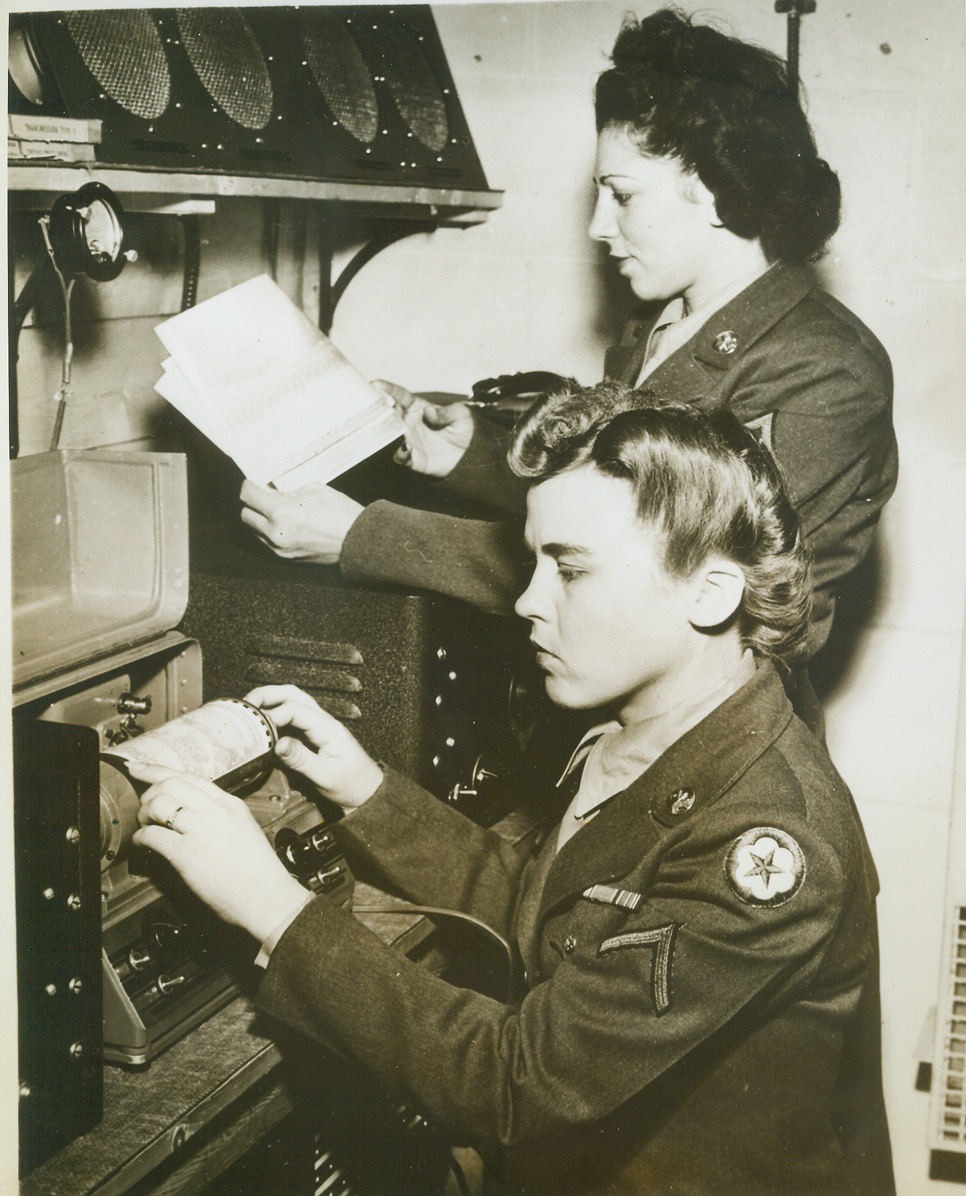
WACS Operate Radiotelephoto Machine, 9/6/1944. England – Pfc. Vondel Judkins, San Salva, Texas, and Cpl. Anita Katen, New York City, operate a Signal Corps Radio-telephoto Transmitter station somewhere in England, sending news pictures rapidly to the States from the European theater. Editors – Please note that the Radio-Telephoto machine was constructed by the technical staff of ACME Telephoto Credit (Signal Corps Photo from ACME);
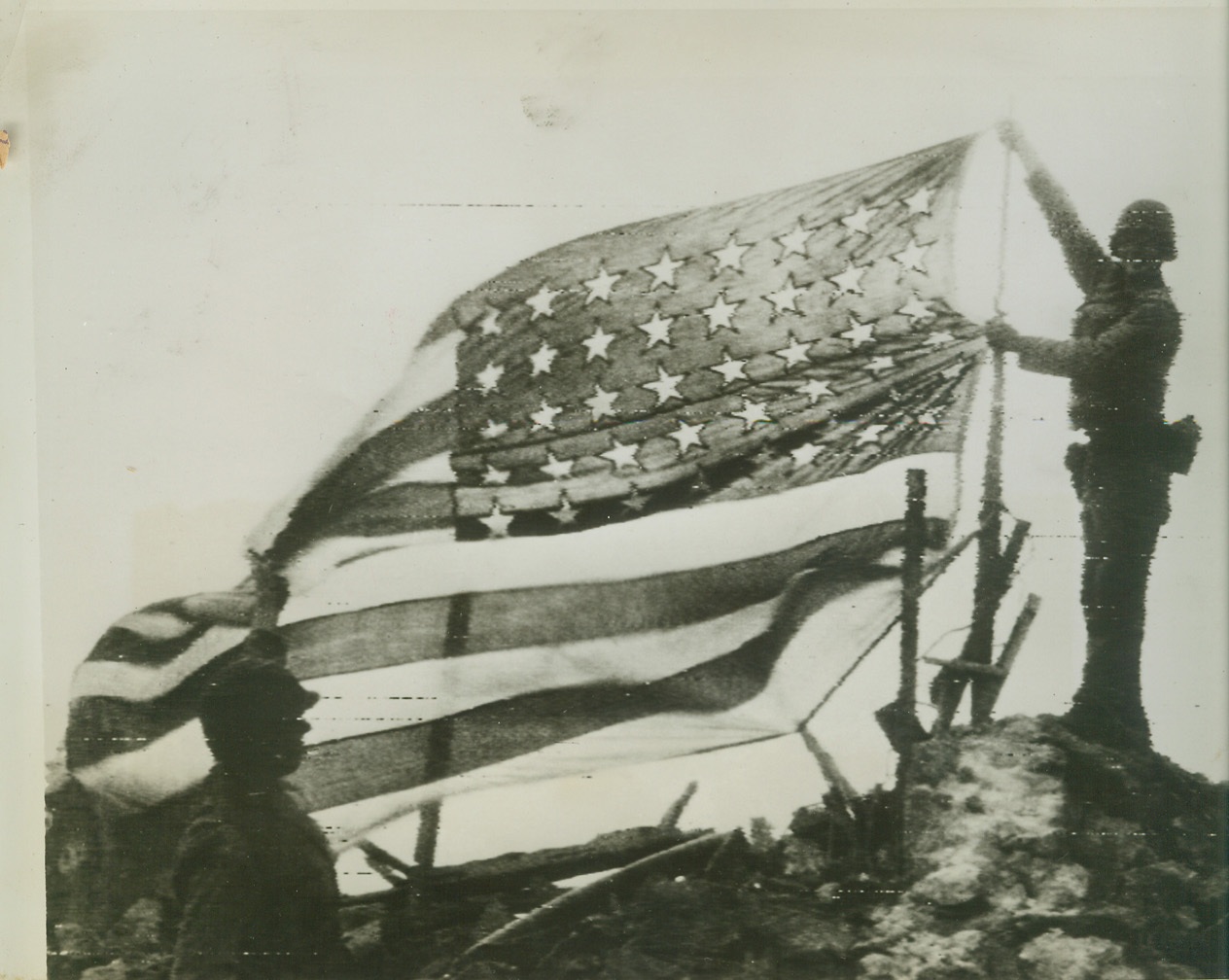
“Old Glory” raised over Cezembre, 9/5/1944. France – The Stars and Stripes are raised over the small French island of Cezembre after German forces had surrendered. Pfc. Richard T. Franz (right), Oswego, N.Y., raises the flag as Pfc. David Snyder of Wilkes Barre, Pa., looks on. The War Department places Cezembre just west of St. Malo off the north coast of Brittany. Credit (Army Radiotelephoto from ACME);

“Uncle!”, 9/10/1944. Maubeuge, France – Wounded in the fight for Maubeuge, on the Franco-Belgian border, this superman threw up his hands and cried “Uncle” in no uncertain terms. Looks like the little man has had a rough day. Photo by Andy Lopez, ACME Photographer for the War Picture Pool. Credit: –WP – (ACME);

Battleship Dunkerque Blasted, 9/15/1944. France – Twisted steel and wreckage are all that remain of the battleship Dunkerque after being blasted by B-17 Flying Forts during a recent raid on the French harbor at Toulon. Credit (USAAF Photo from ACME);
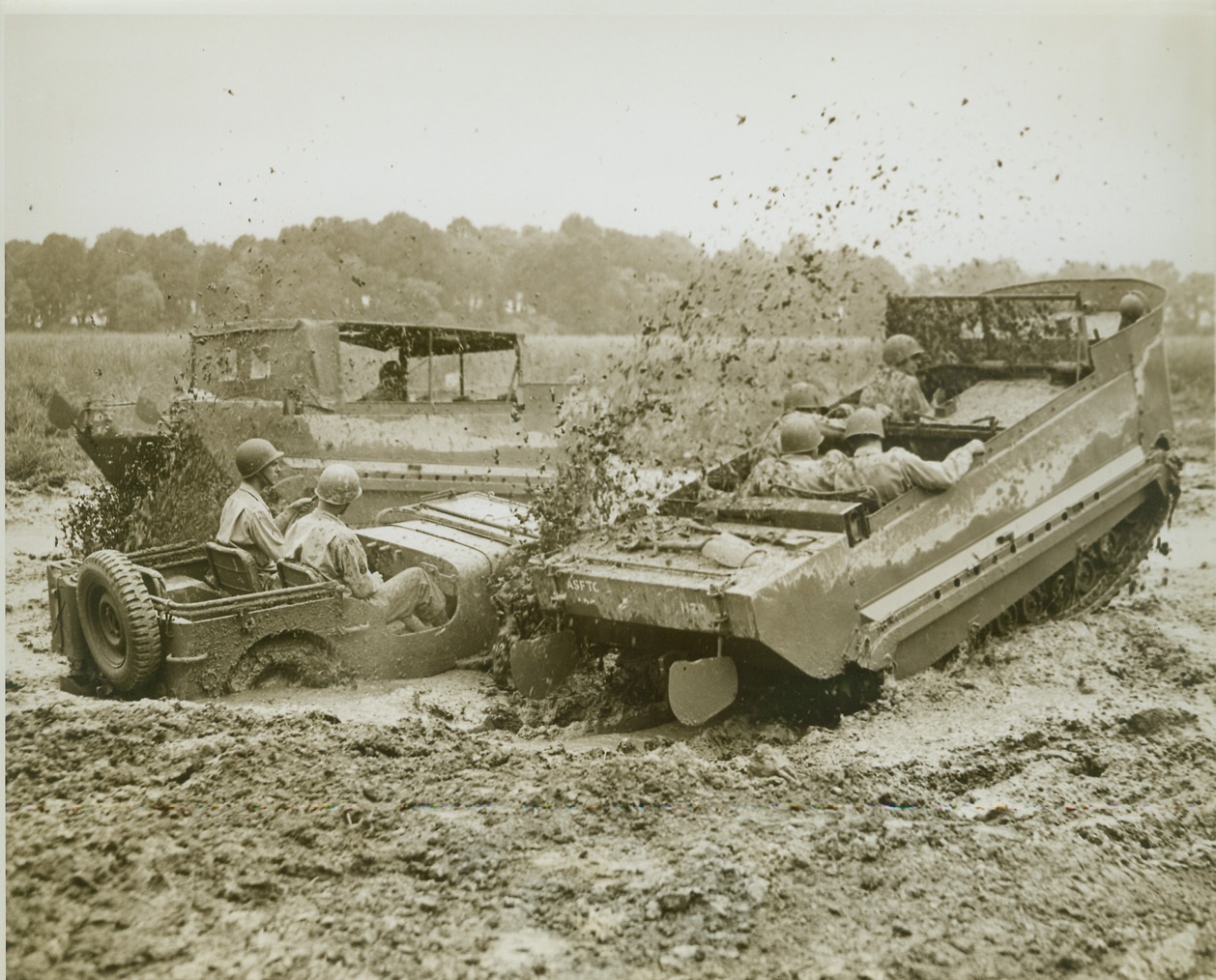
THE M-29, ALL PURPOSE CARGO CARRIER, 9/1/1944. ABERDEEN, MD. – The “Weasel”, M-29 Light Cargo Carrier, sloughs through the mud as it bypasses a stranded jeep on the proving grounds at Aberdeen, MD. The M-29, which is used on amphibious and swamp operations, has a full tack and rudders, and is capable of amazingly high speeds on the ground. Credit: OWI Radiophoto from ACME;
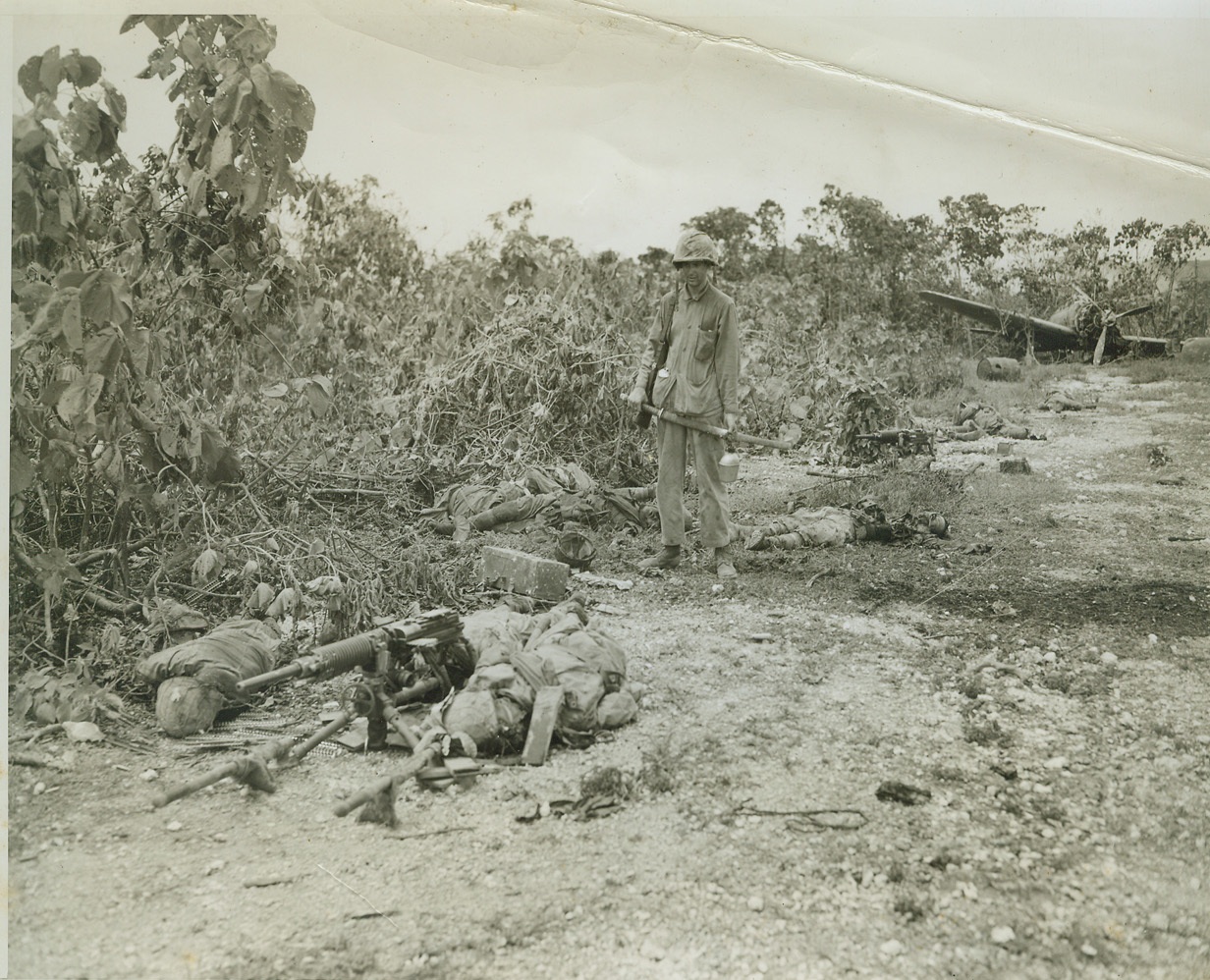
DEATH WAS THEIR SOUVENIR, 9/22/1944. PELELIU ISLAND, PALAU – Holding a Jap sword, his pockets bulging with other souvenirs of the battle for Peleliu Island, a Yank leatherneck looks at the bodies of Japs whose only souvenir was death. Two enemy machine gunners, slain in the first moments of the invasion, lie in the foreground. The Jap behind the Marine committed suicide by holding a grenade to his chest. Note wrecked plane in background. Photo by Stanley Troutman, ACME photographer for the War Picture Pool. Credit: ACME;
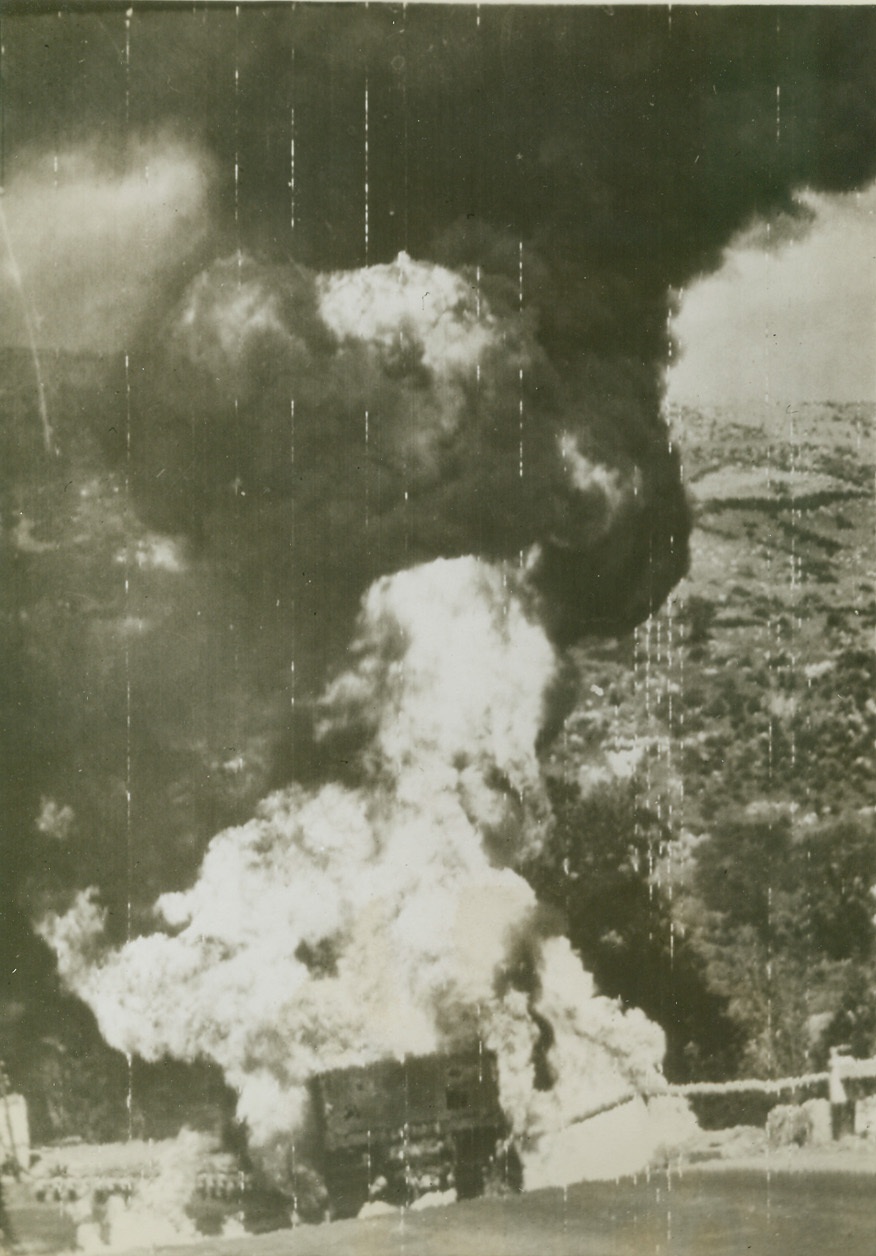
DIRECT HIT BY GERMAN ARTILLERY, 9/27/1944. A huge sheet of flame envelops a British truck hit by German artillery near Futa Pass on the Nazi gothic line in Italy. Credit: ACME photo via Army radiotelephoto;

OFF TO THE RACES, 9/23/1944. PARIS – As Paris again takes up the threads of a normal life, the only difference at the Racing Club in the Bois du Boulogne is the parking lot. Once jammed with swank cars, the area is filled to capacity once more, but with bicycles. Paris is still gas-less and car-less, so the sole means of transportation is bicycles, and practically ever Parisian owns one. Credit: ACME;
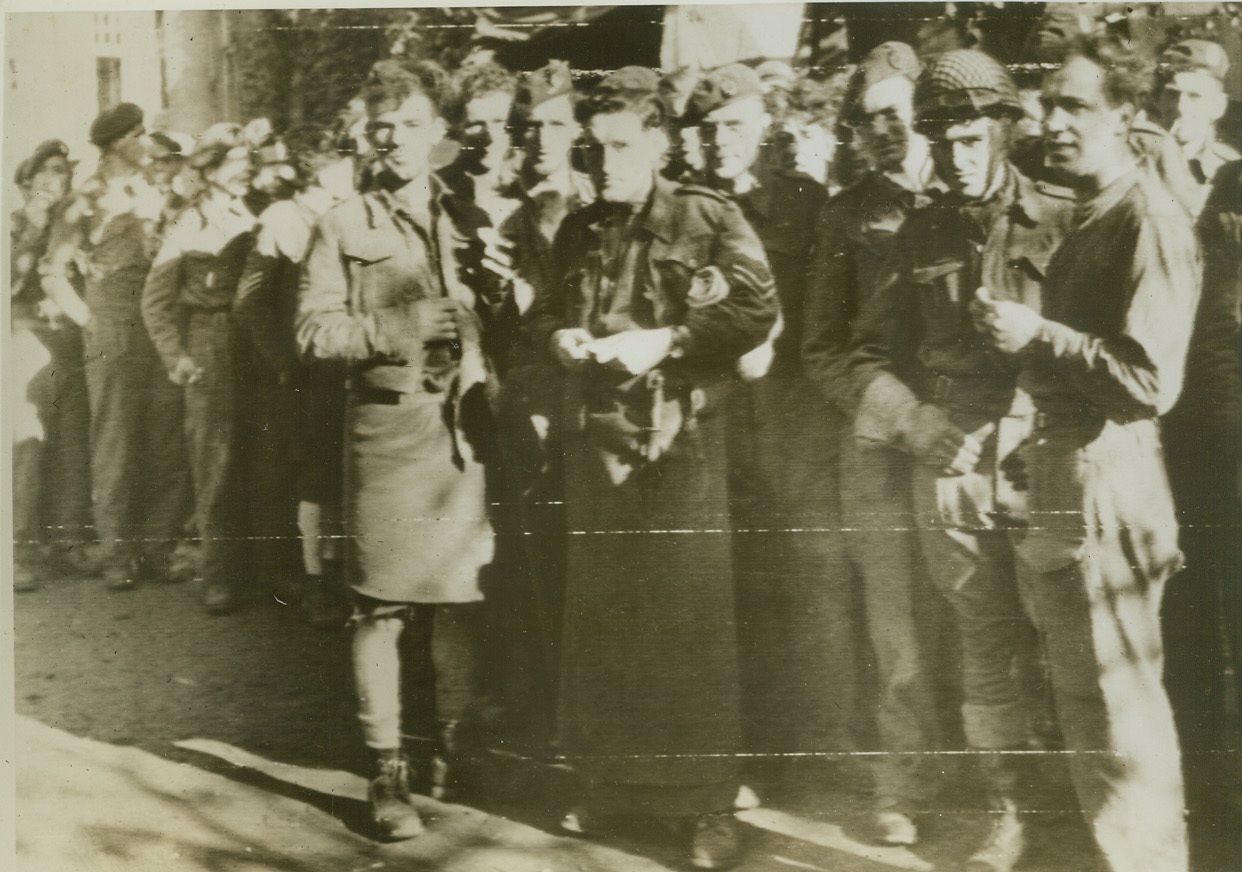
THE LUCKY ONES, 9/29/1944. HOLLAND – Luckier than a great many of their comrades, these British troops of the First Allied Airborne Army were fortunate enough to be evacuated from Arnhem after their gallant battle. Credit: British official photo via Army radiotelephoto from ACME;
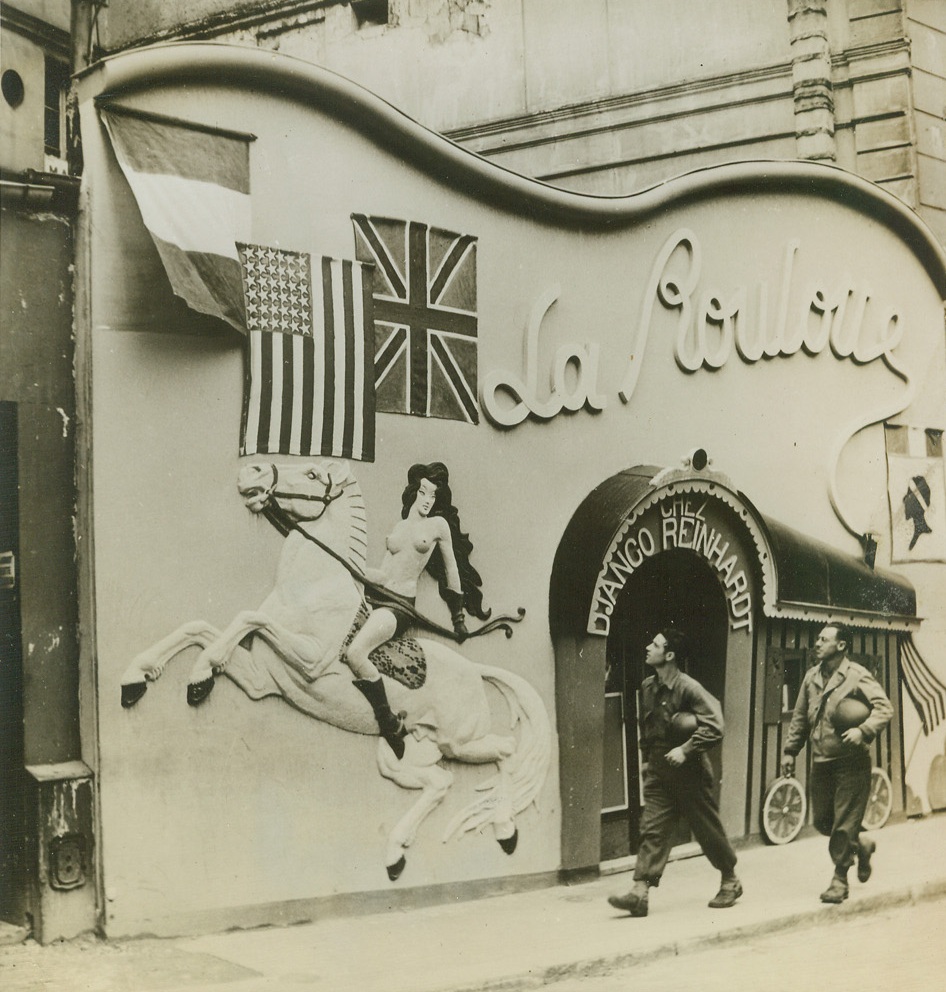
THIS IS GAY PAREE, 9/23/1944. PARIS – Unique and gaily bohemian, as only a Paris nightclub can be, the plaster front of La Roulotte is decorated with the French, American and British flags. Two GI’s strolling by observe the modern version of Lady Godiva which prances across the front. Credit: ACME;
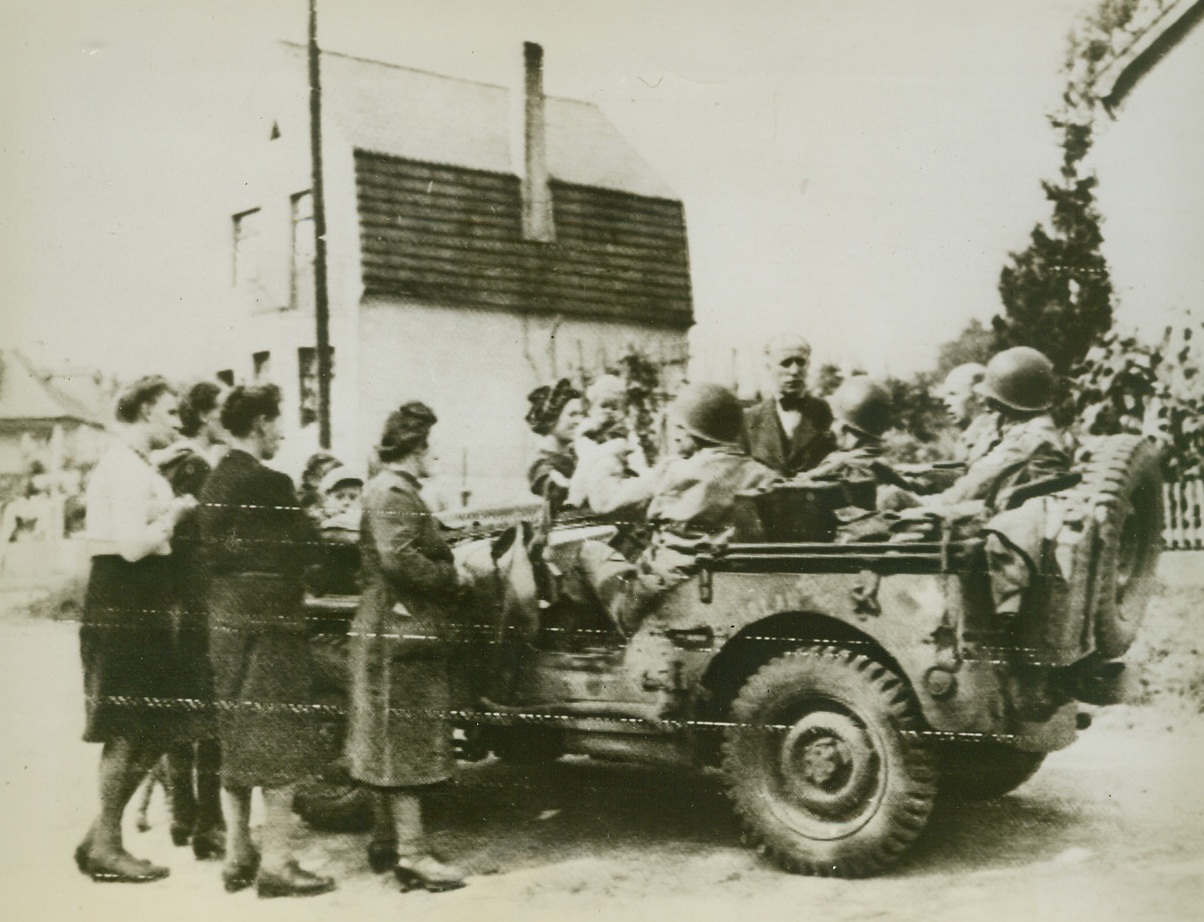
Germans Greet Yanks Near Aachen, 9/16/1944. GERMANY – A large German family residing near the key city of Aachen, Gathers around an American jeep which was part of the first column to enter Germany. Civilians seem rather pleased to greet these soldiers of General Bradley’s First Army.Credit: Andrew Lopez for War Picture Pool (Army Radiotelephoto from ACME);
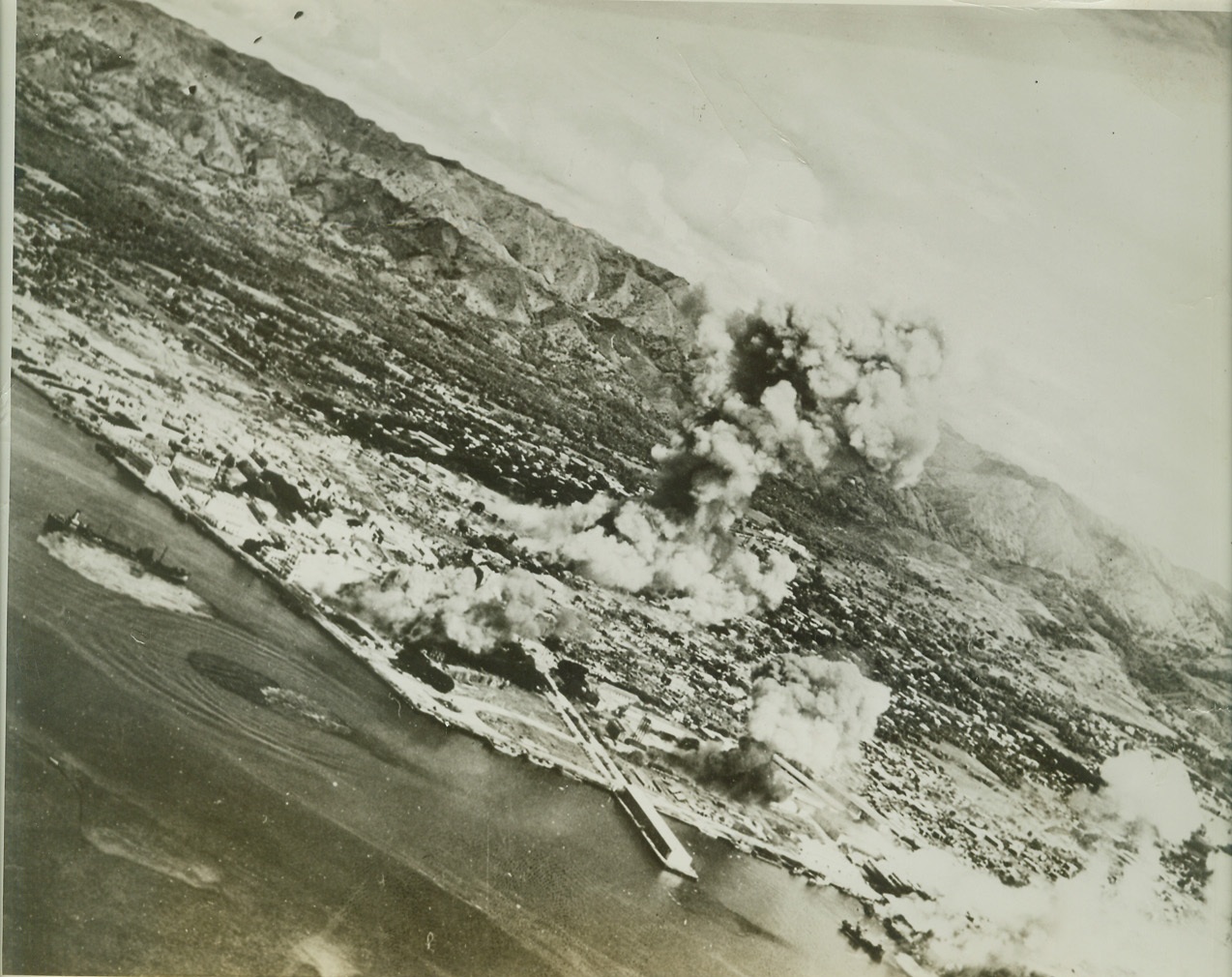
Yank Planes Return to Philippines, 9/24/1944. Cebu, Philippine Islands – Carrier planes from Admiral Halsey’s Third Fleet leave vast damage to enemy installations and shipping after weep over Cebu, vital Philippine harbor. In this action, 50 Jap planes were shot down in the air, 150 destroyed on the ground. Note near miss on ship at left. U.S. Navy Photo. Credit: (ACME);
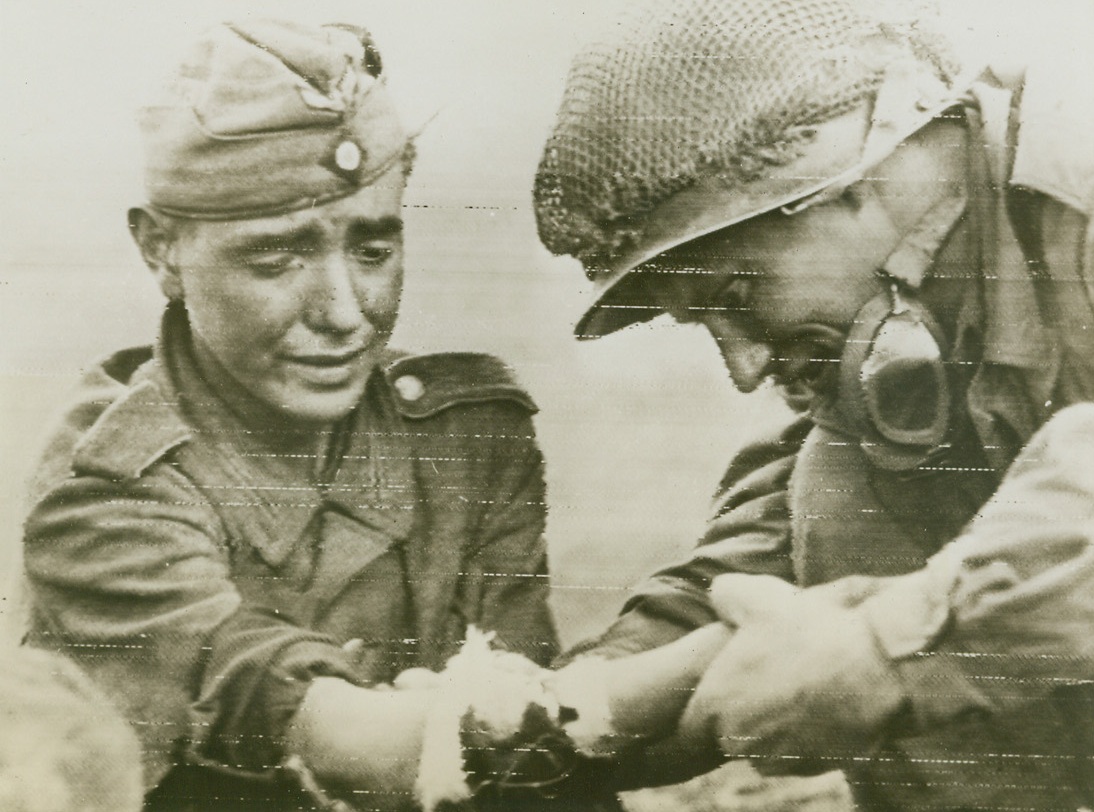
HEAL THE “CONQUERING HERO”, 9/10/1944. FRANCE—Hardly looking the part of a “conquering hero”, this youthful Nazi captive seems close to tears as a Yank examines his arm wound. The American renders first aid while awaiting the arrival of a medic.Credit: Signal corps radiotelephoto from Acme;
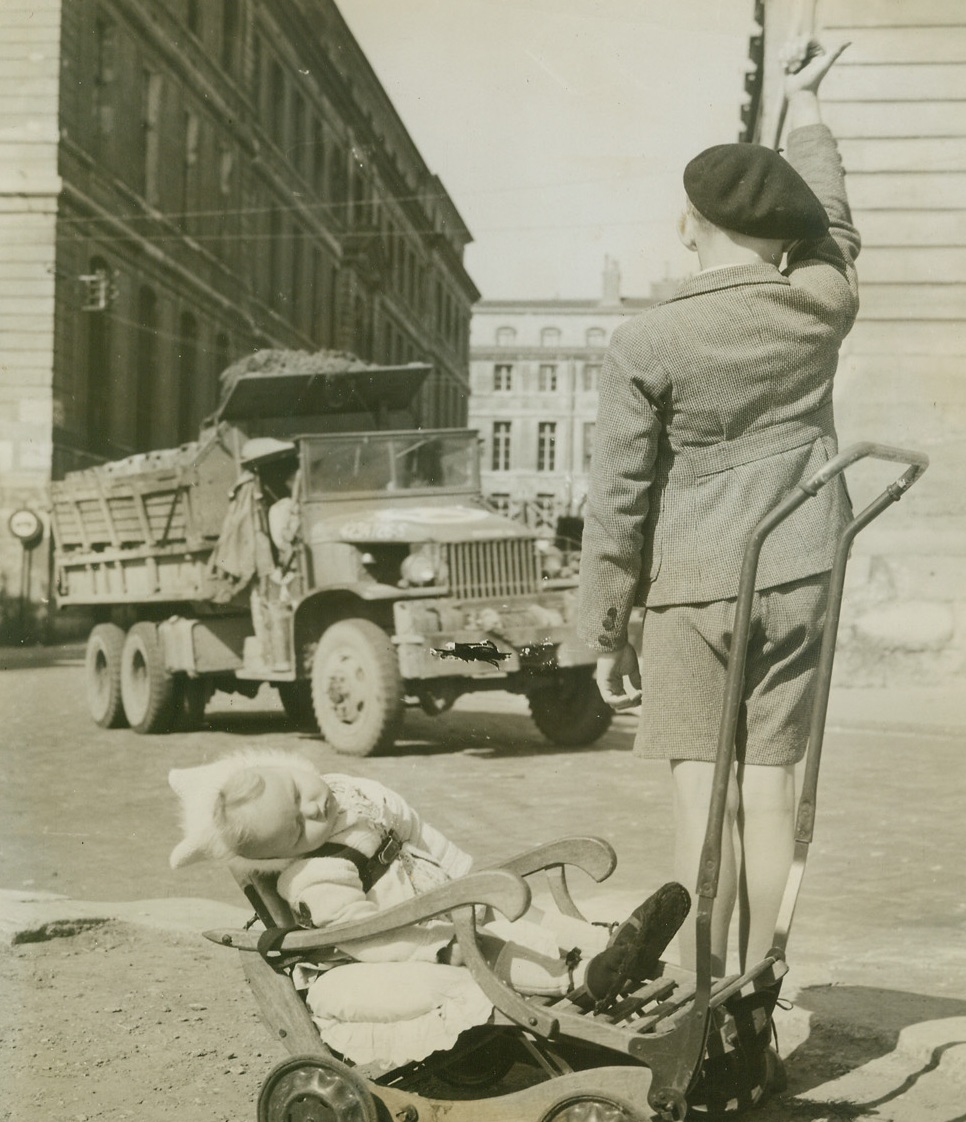
GOING BYE-BYE?, 9/24/1944. PARIS—Catching on quick to the customs of “Les Yanks”, this young Parisian hoists an optimistic thumb into the air as an Army truck lumbers by. Knowing that American soldiers are “softies” with kids, he’s hoping for a lift back home for himself and his sleeping baby sister. Photo by Charles Haacker, Acme photographer for the War Picture Pool.Credit: Acme;
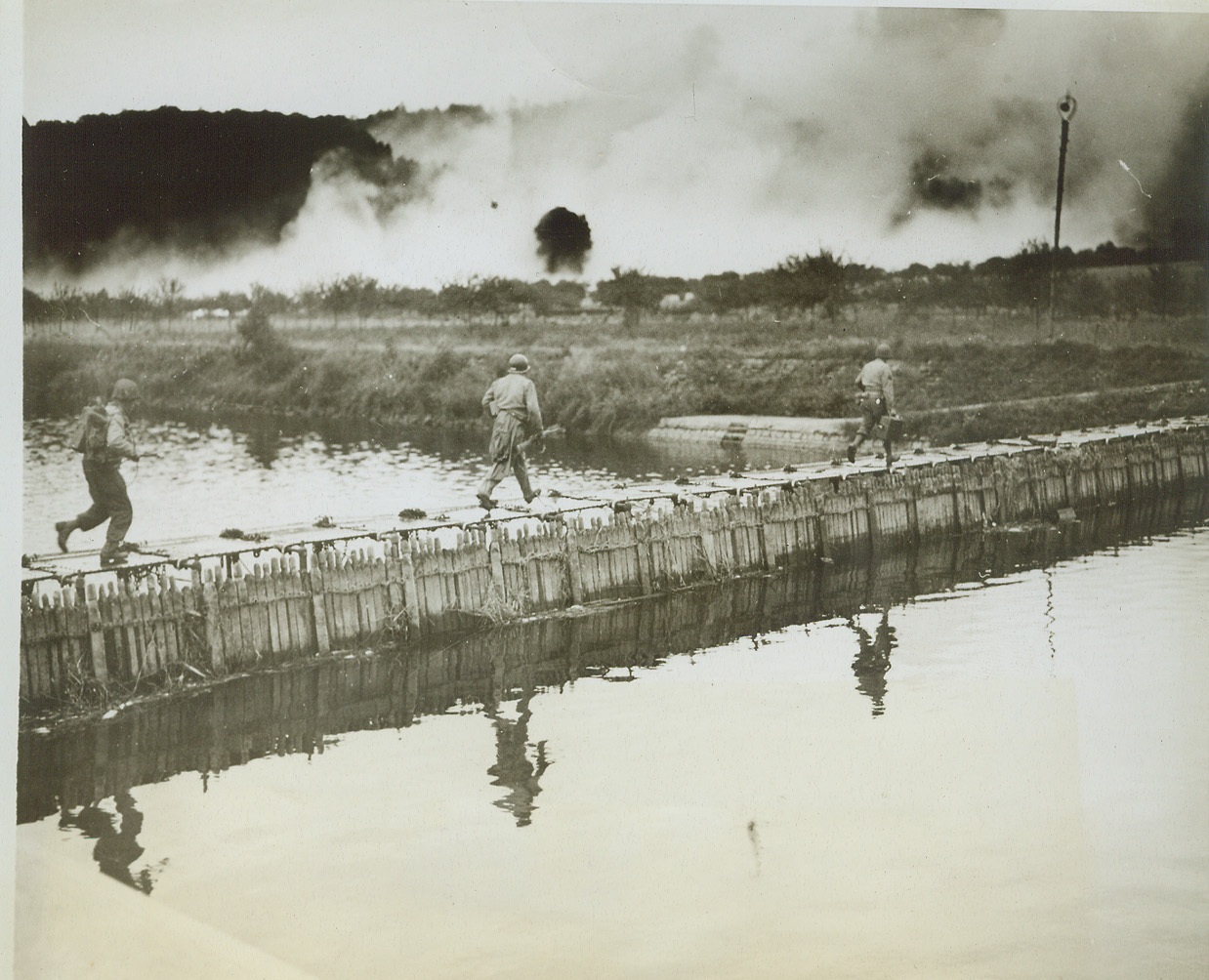
Advance in Face of Enemy Fire, 9/12/1944. Belgium – American soldiers dash across the steel plating of a bridge spanning the Meuse River in Belgium near the town of Houx as enemy shells burst around them. Nazi artillery fire falls wide of the footbridge as Yanks race across to safety. Credit (Signal Corps Photo from ACME);

Flowers for the Liberators, 9/4/1944. FORGE PHILLIPPE, BELGIUM—Women and children of Forge Phillippe carry bouquets of flowers to throw in the path of the American Liberators of their town. They crowd about two Yanks in a jeep as the little vehicle rolls through the village. Credit: ACME PHOTO VIA ARMY RADIOTELEPHOTO.;
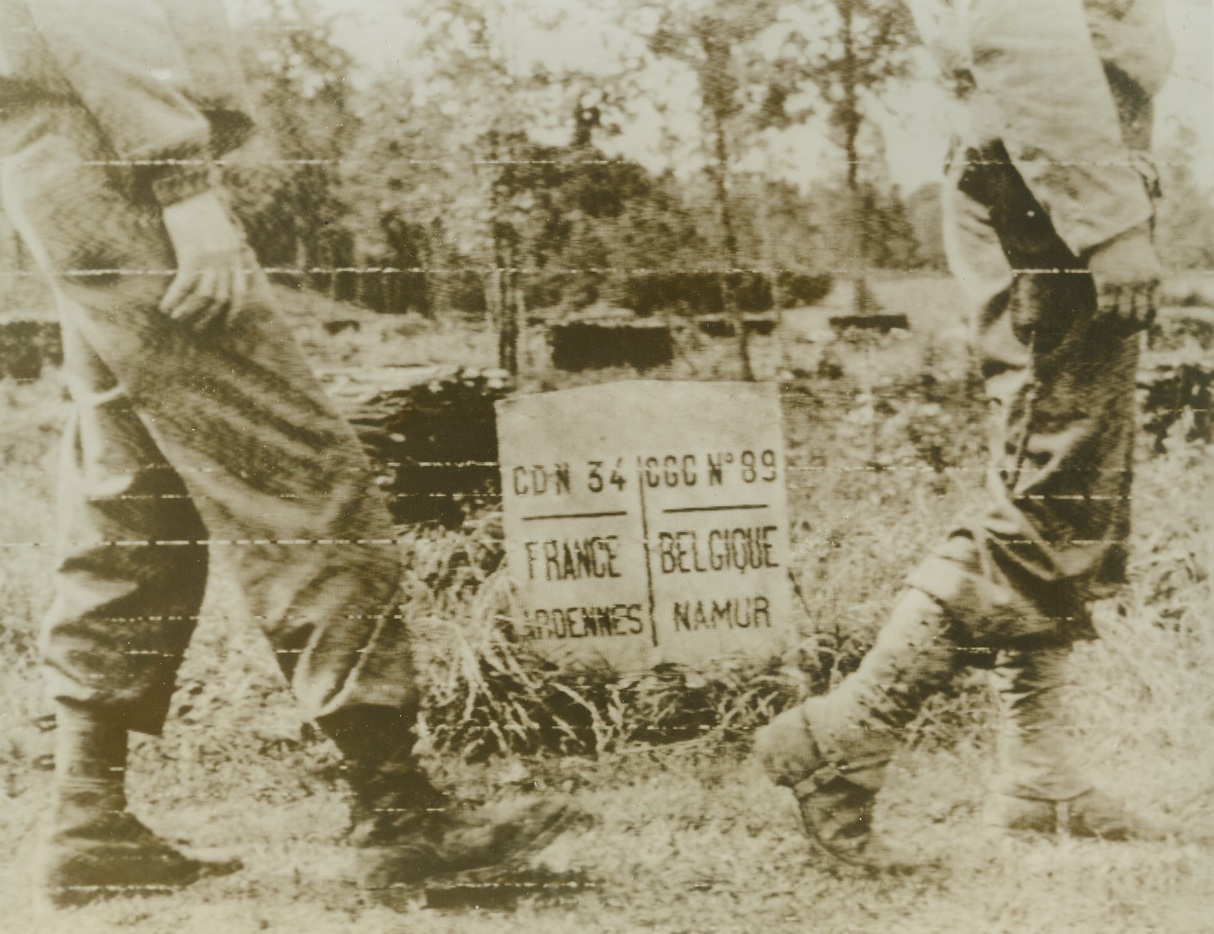
Over the Border, 9/3/1944. The feet of American soldiers tramp across the French-Belgian border, passing a tiny boundary marker. American units have now advanced forty miles inside Belgium. Credit: SIGNAL CORPS RADIOTELEPHOTO FROM ACME.;
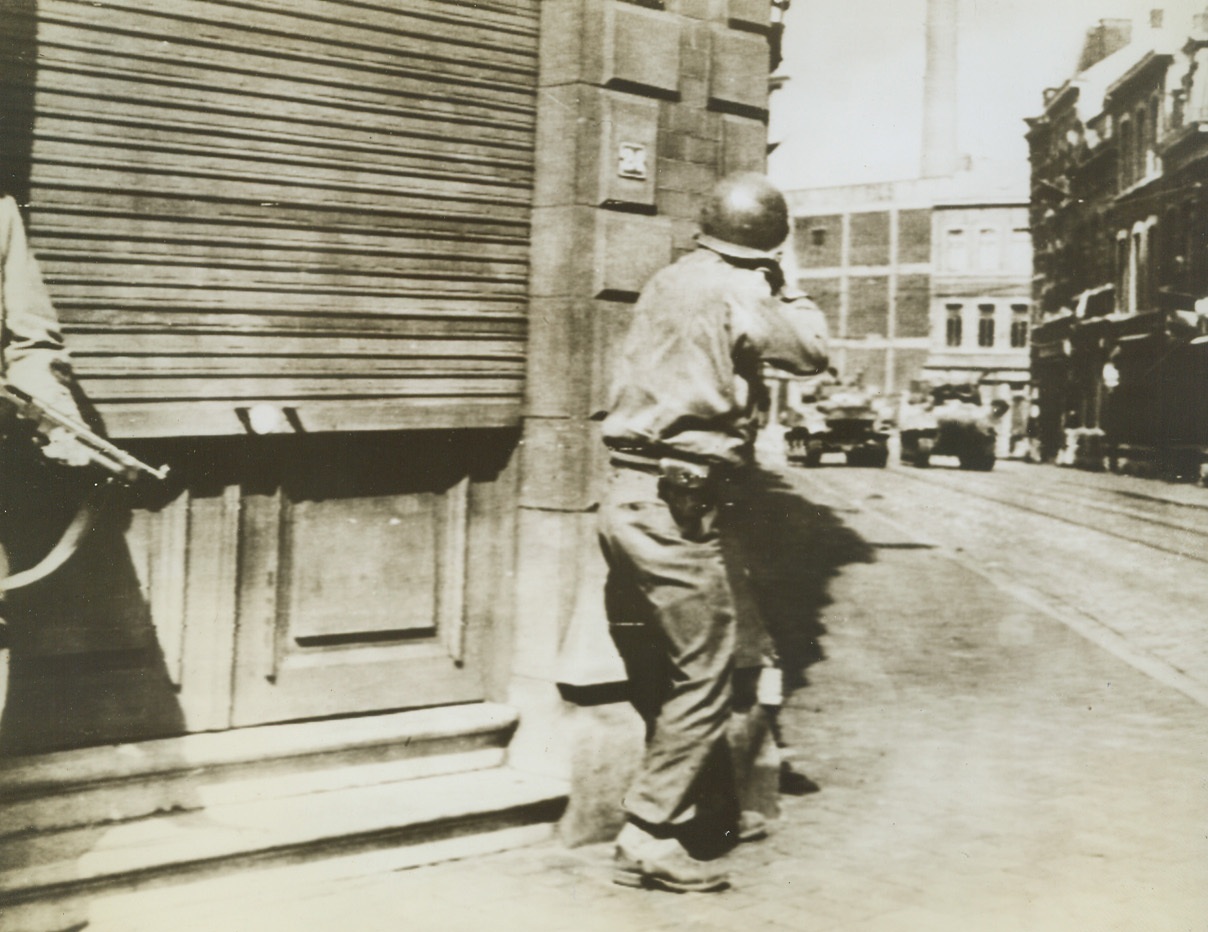
German Sniper His Target, 9/13/1944. BELGIUM—A Yank infantryman pokes the muzzle of his rifle around a street corner in Liege, Belgium, to take a shot at a German sniper hidden in a building at the end of the street. Allied armored vehicles rumble up the road. Credit: ARMY RADIOTELEPHOTO FROM ACME.;

Interview in Germany, 9/15/1944. GERMANY—Along the highway to Aachen, T.R. Henry (right), war correspondent for the Washington, D.C. Star, interviews T/5 Leon Roseman of Weehawken, N.J., Was Department Signal Corps Photographer. Roadside interview took place in the German city of Roetgen. Credit: ARMY RADIOTELEPHOTO FROM ACME;
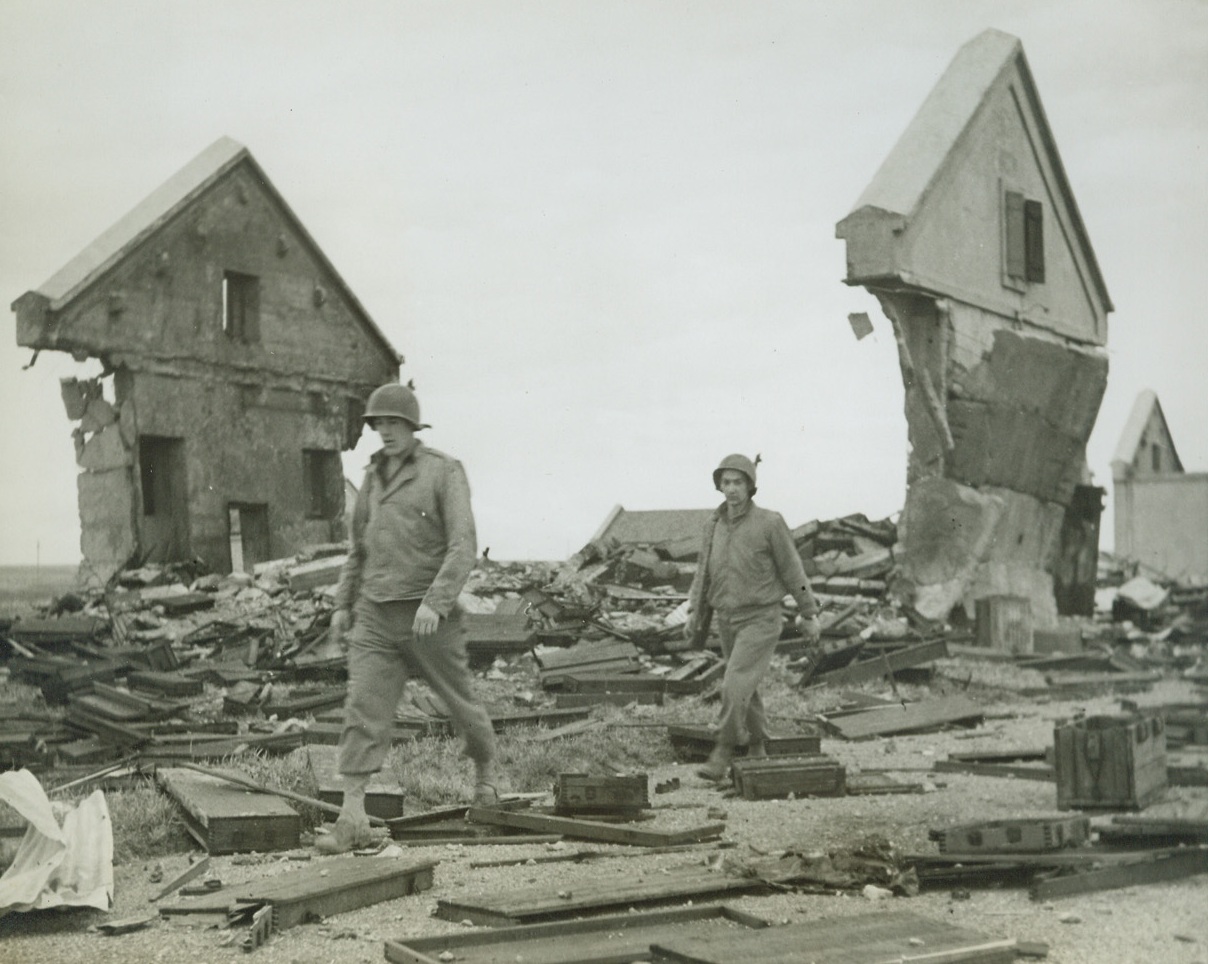
Destroyed German Ammunition Dump, 9/16/1944. American soldiers walk through the wreckage of packing cases and masonry which are all that is left of a German ammunition dump near Metz, destroyed by the enemy as he retreated into Germany. Credit: ACME PHOTO BY BERT BRANDT FOR THE WAR PICTURE POOL.;
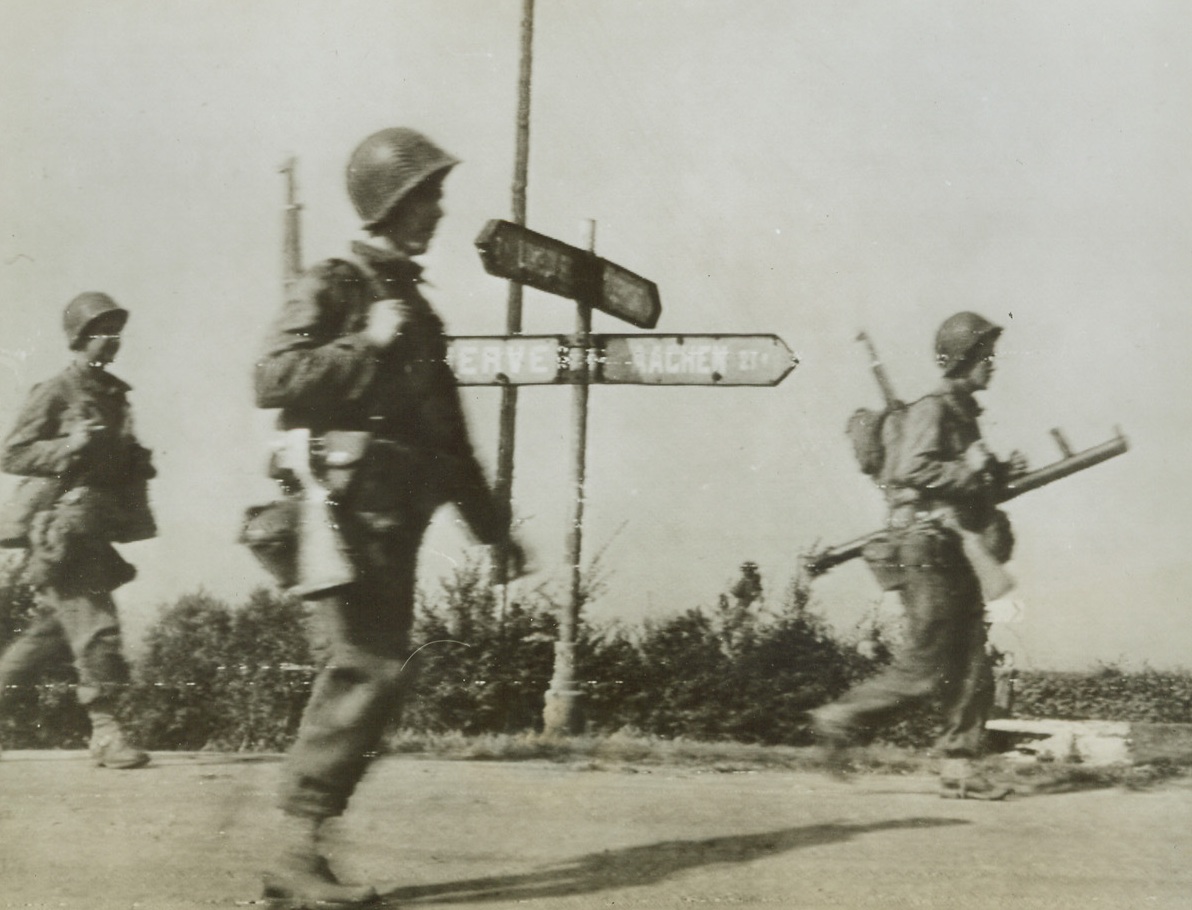
Heading for Aachen, 9/16/1944. GERMANY—Three American soldiers, one toting a bazooka, march briskly along a highway toward the key German city of Aachen. German civilians in the Aachen area have been ordered by Nazi leaders to evacuate their homes and meet the advance of American troops with “fanatical resistance.” Credit: ARMY RADIOTELEPHOTO FROM ACME.;
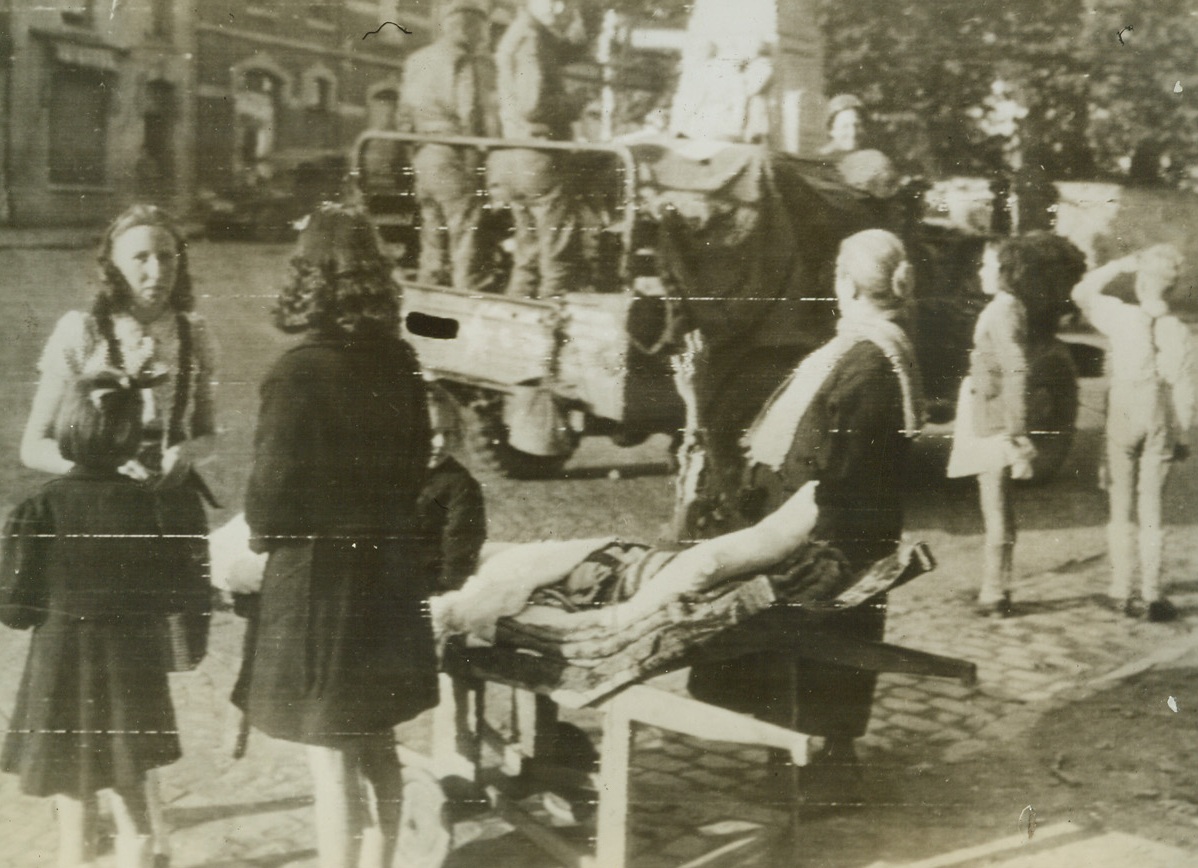
Belgian Children Recognize Yanks as Liberators, 9/14/1944. BASTOGNE, BELGIUM—Wheeled out onto the street on her rolling cot, a little invalided Belgian girl waves to American soldiers as the Yanks enter Bastogne in the wake of retreating Germans. To the right, a little boy snaps to attention and gives a smart salute—American style. Credit: SIGNAL CORPS RADIOTELEPHOTO FROM ACME;
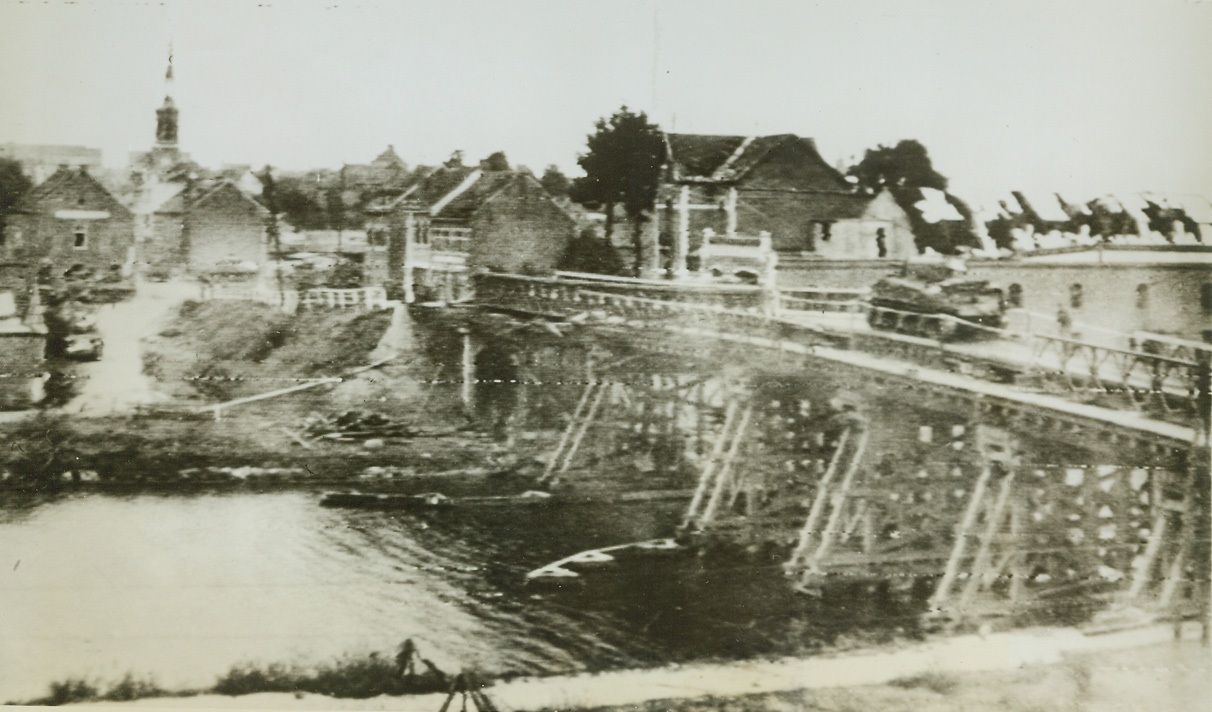
Allies Advance in Belgium, 9/13/1944. BELGIUM—British armored vehicles roll across the Albert Canal at Beeringen in Belgium. Original bridge was destroyed by Nazi demolition squads but was rebuilt by Allied engineers to allow troops to advance. Credit: ARMY RADIOTELEPHOTO FROM ACME.;
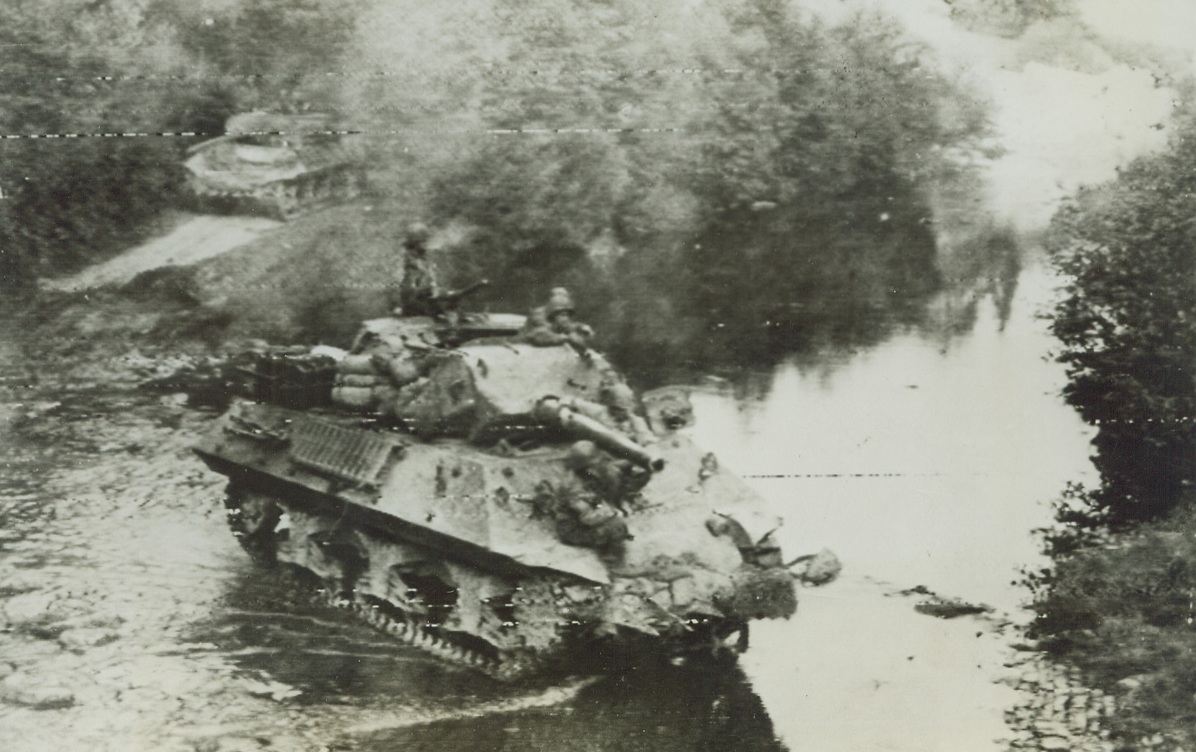
Tank Destroyer Going into Germany, 9/15/1944. An American Tank destroyer crossing a stream marking the German border. In the background to the right is a destroyed German railroad. Credit: SIGNAL CORPS PHOTO VIA RADIOTELEPHOTO.;
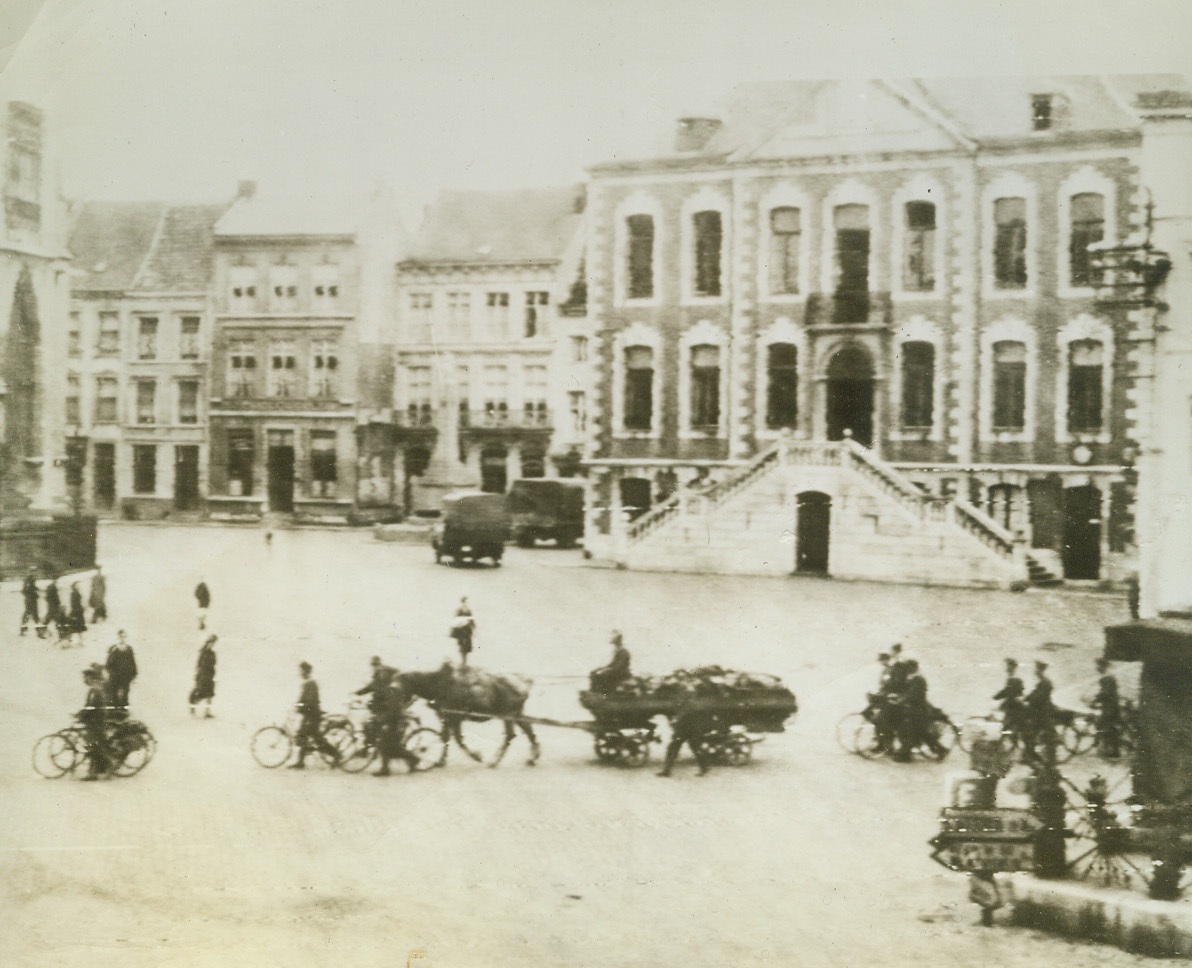
Sneaking Out, 9/15/1944. BELGIUM—Moving in horse drawn carts and pushing their bicycles, the Nazis evacuate Belgium in a far different manner from that in which they entered so triumphantly several years ago. This photo was taken secretly by a Belgian Civilian before the Allies arrived. Credit: SIGNAL CORPS RADIOTELEPHOTO FROM ACME.;
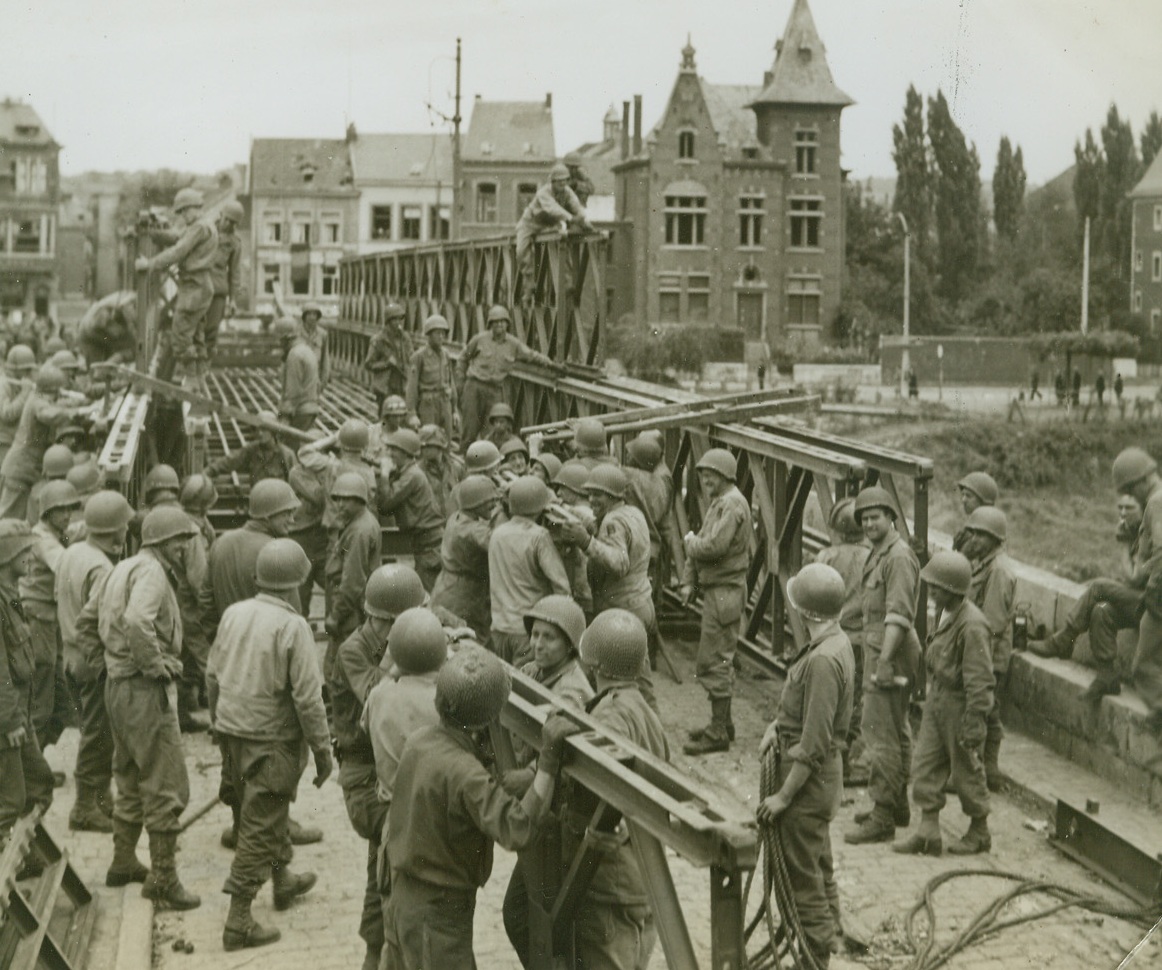
Yanks Span the Meuse, 9/12/1944. BELGIUM—American engineers and advance elements work hard to complete a bridge spanning the River Meuse in Namur, Belgium, in preparation for the crossing of armored columns. Photo by Andrew Lopez, ACME photographer for the War Picture Pool. Credit: ACME.;
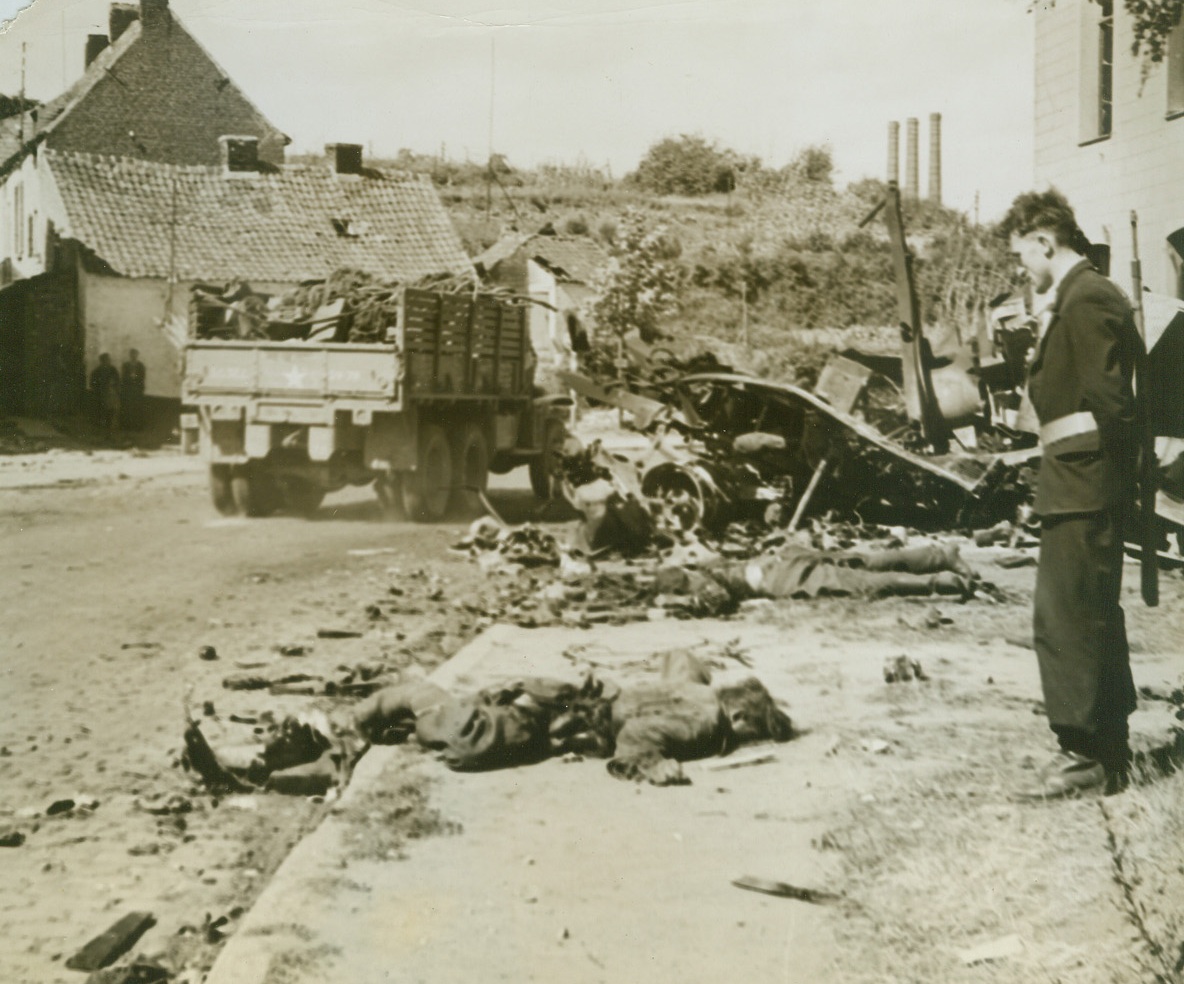
German Dead in Belgium, 9/9/1944. BELGIUM—Face to the pavement, German soldiers lie dead on a street in Gognes Chauvee, Belgium, after being blasted from their vehicles when Allied Aircraft attacked a convoy speeding toward new positions in the face of relentlessly advancing liberating forces. Photo by Andrew Lopez, ACME photographer for the War Picture Pool. Credit: ACME.;
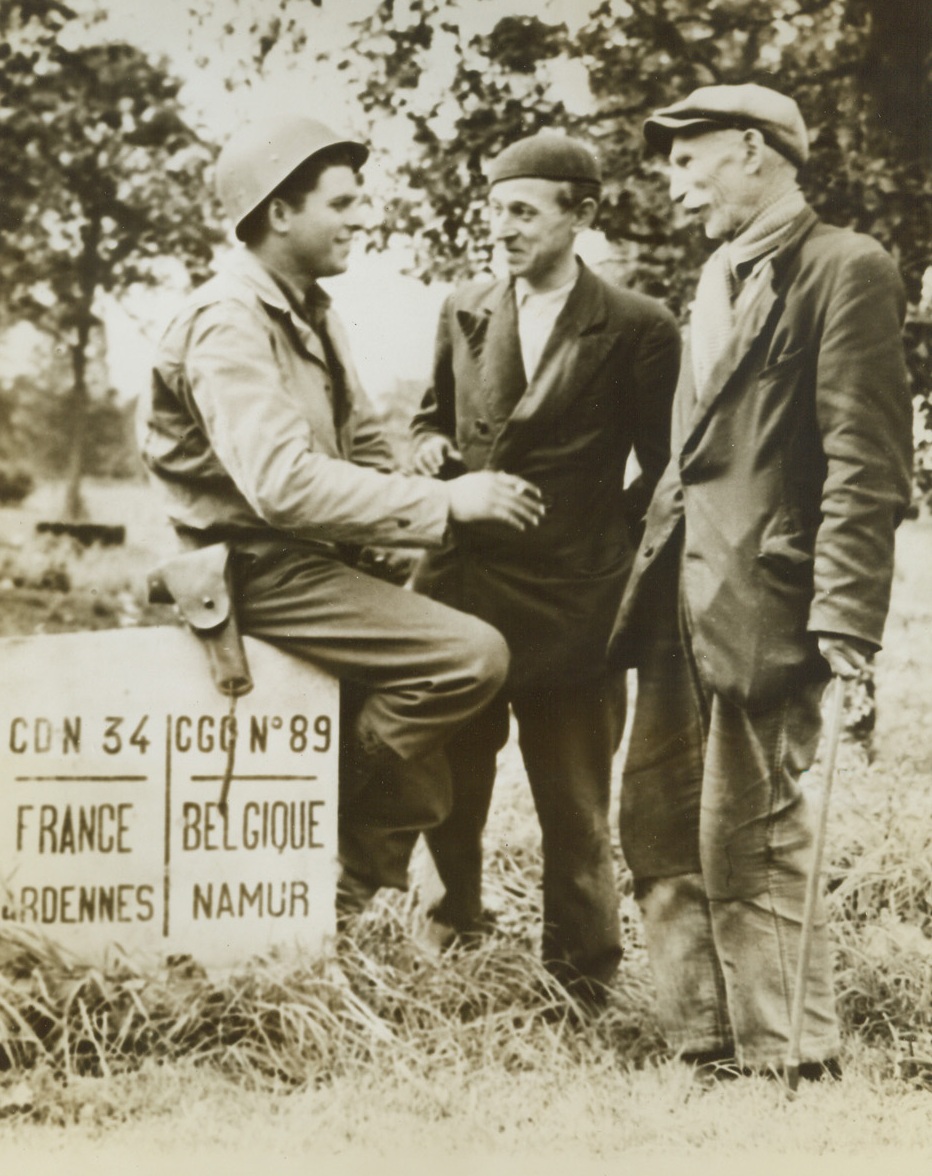
Liberation of Belgium at Hand, 9/6/1944. BELGIUM—Pvt. Gordon Conrey (left), of Milford, Vt., sits on the French-Belgium border marker and chats with two residents of Seloignes in Belgium. Swift advance across the border by Allied troops marks the beginning of the end for the Nazis in Belgium and the low countries. Credit: ACME.;
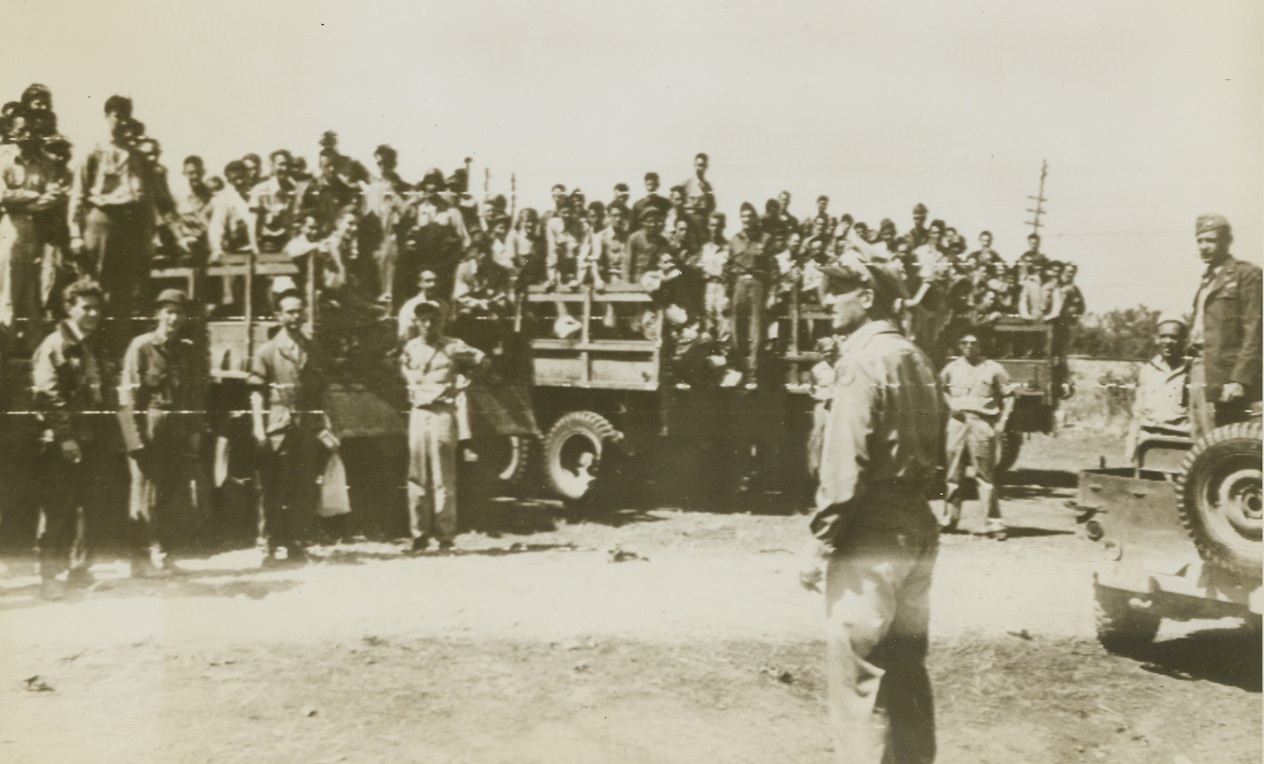
YANKS RETURNED FROM ROMANIA, 9/2/1944. ITALY—General Nathan F. Twining, Commanding General of the 15 Air Force, addresses a group of men who had just landed in Italy after being flown from Romania where they were interned as prisoners of war. The Yanks, all fliers, had been shot down during raids on the Ploesti oil fields.Credit: Army Radiotelephoto from Acme;
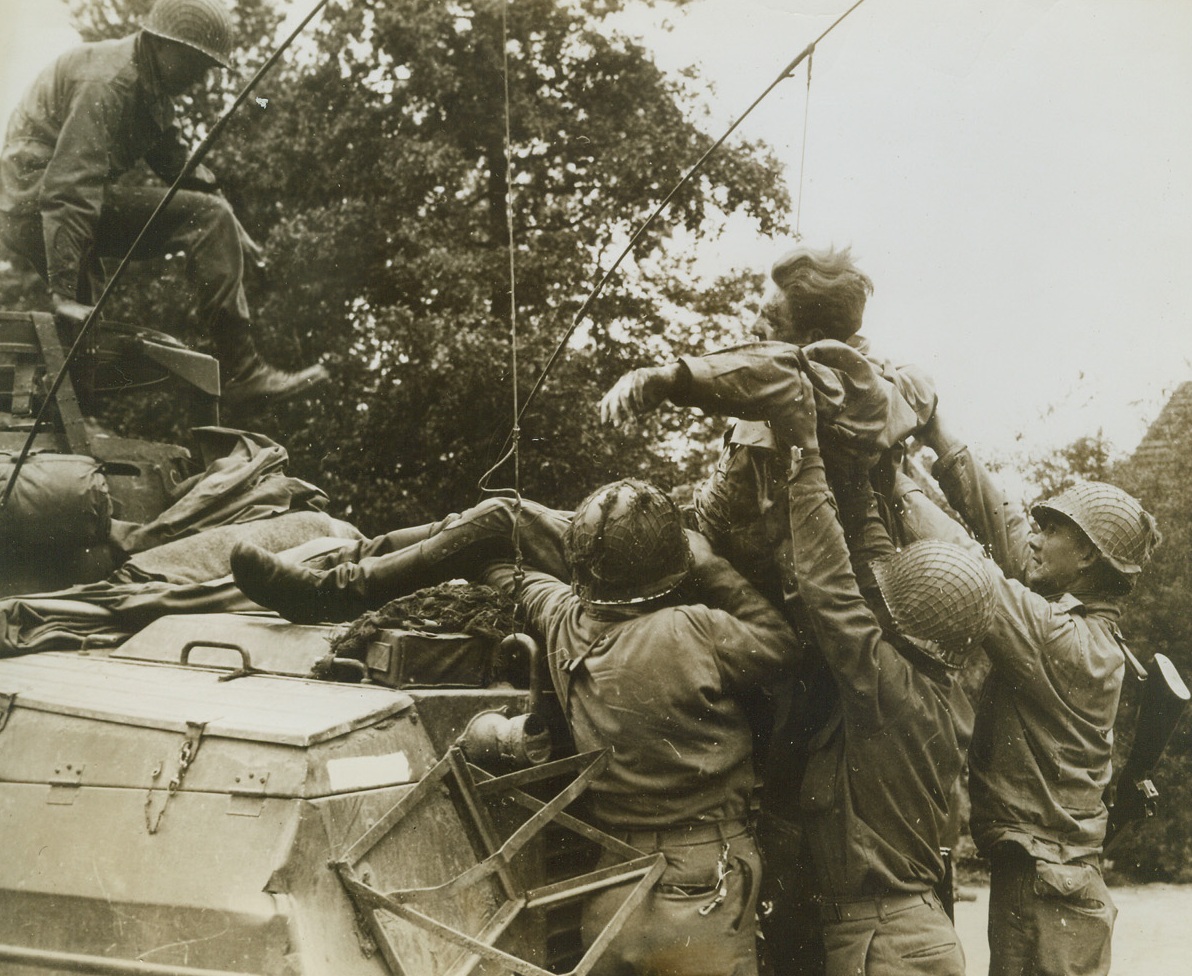
WOUNDED NAZI GETS A LIFT, 9/12/1944. BELGIUM—A wounded German prisoner is hoisted to an American armored car by a group of GI’s. He will be taken to a field hospital for treatment. Nazi was wounded during fighting in Belgium.Credit: Signal Corps photo from Acme;
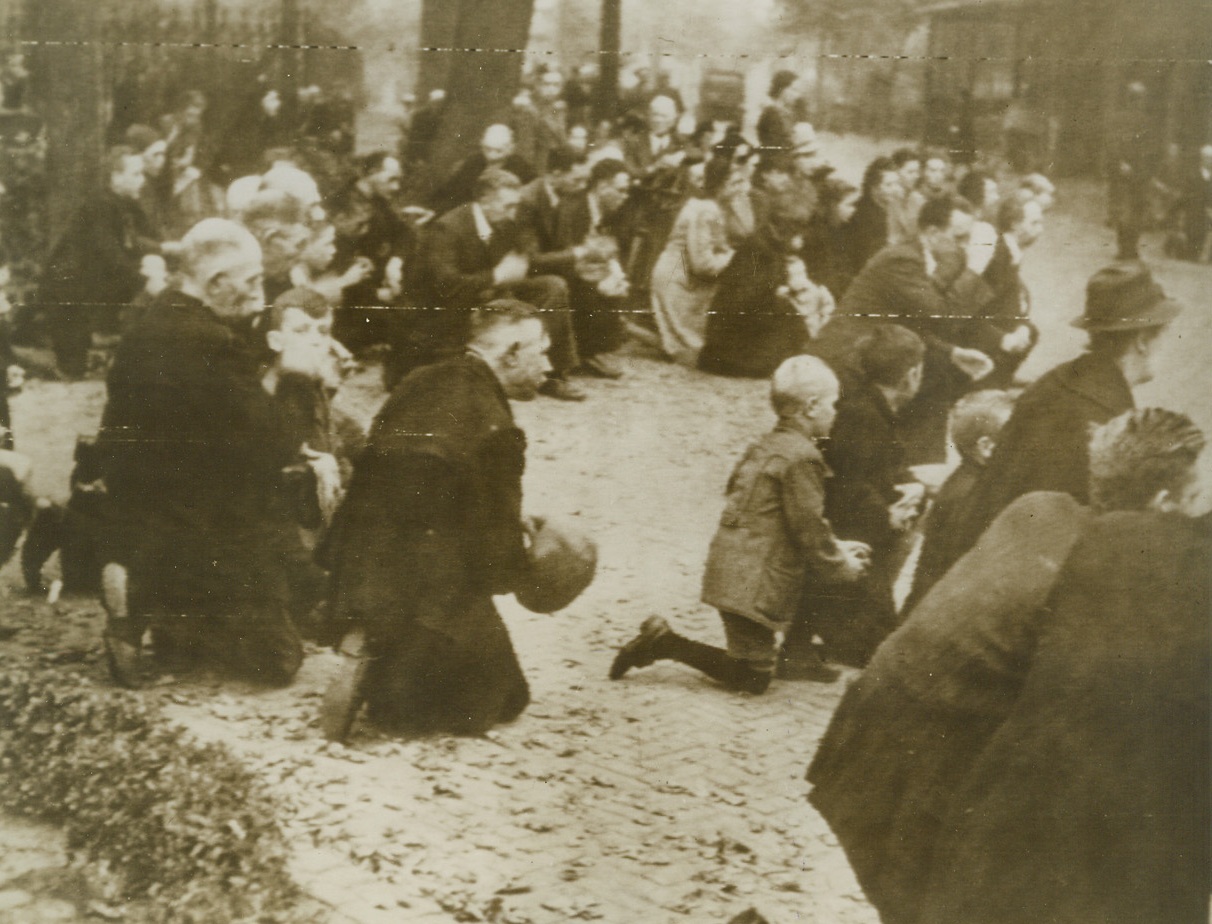
HOLLANDERS PRAY FOR NAZI VICTIMS, 9/26/1944. Bareheaded villagers of Leende, Holland, kneel in prayer in the streets of the city, in tribute to the memory of four of their number killed by the Nazis as the latter retreated from Leende. Credit: British official photo via U.S. Army radiotelephoto from Acme;

GERMAN PRISONERS IN HOLLAND, 9/26/1944. These Nazis were captured by Allied forces in the area of Nijmegen, Holland. Most of them were caught by parachutists. Here, they lie around on the ground, resting, as they await transportation to prisoner of war camps. Credit: British official photo via U.S. Army radiotelephoto from Acme;
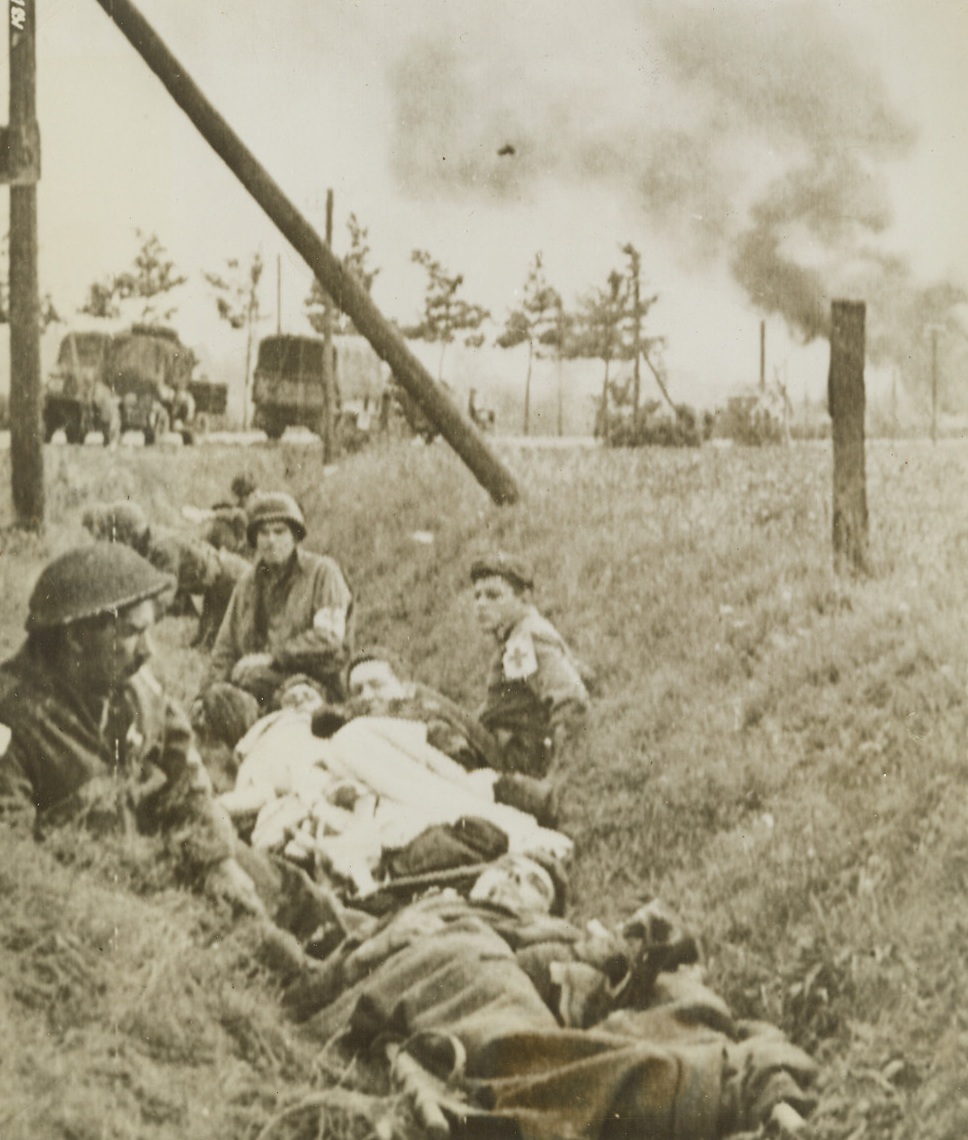
BRITISH WOUNDED TAKE COVER IN HOLLAND, 9/25/1944. HOLLAND—When their convoy, enroute from Eindhoven to Nijmegan was attacked by the Germans, these wounded British soldiers take cover in a slope in the ground. Tanks and typhoons soon drove off the attackers, and the convoy proceeded on its way. Credit: Signal Corps radiotelephoto from Acme;
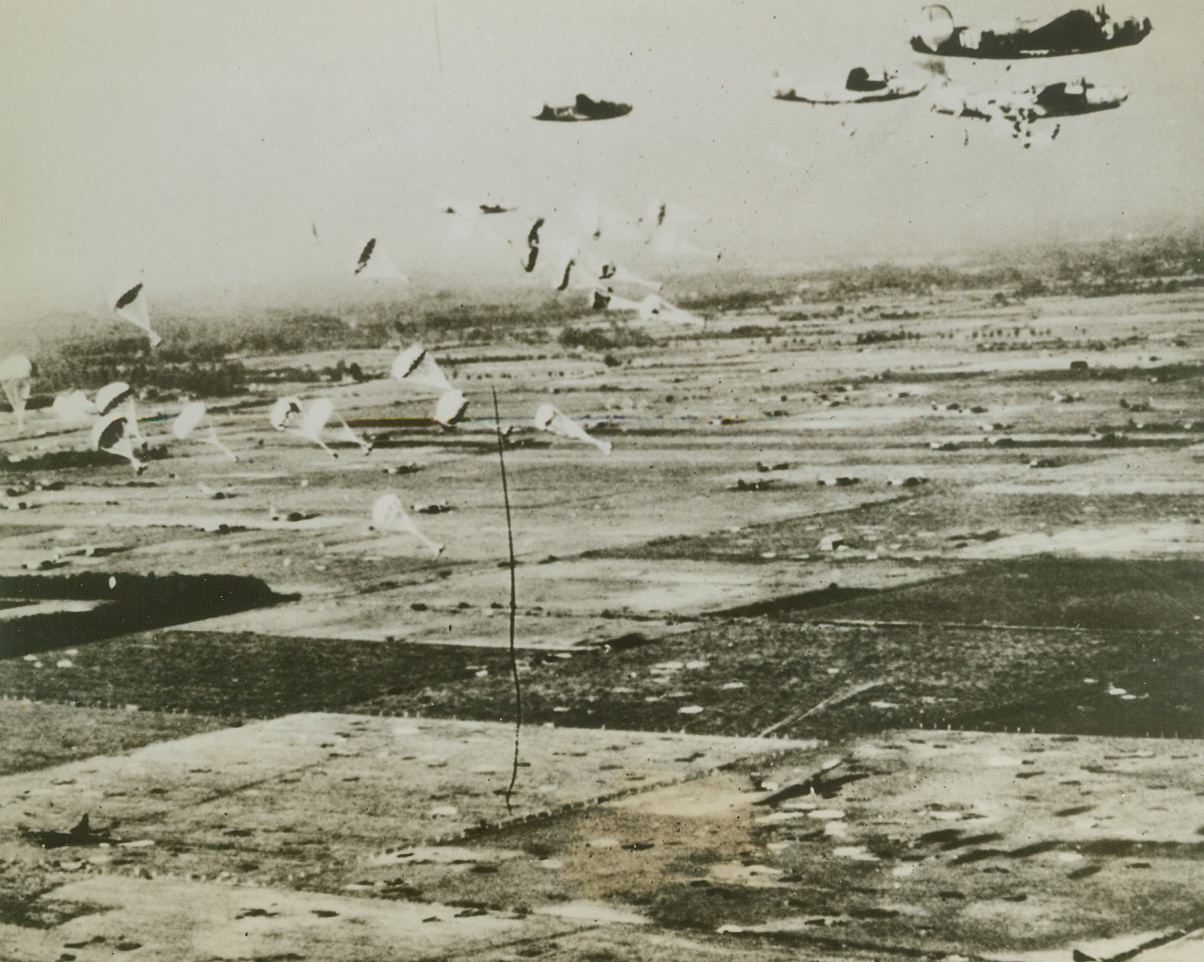
SUPPLIES FOR POCKETED AIR TROOPERS, 9/25/1944.HOLLAND—Liberators of the US 8th Air Force zoom over Holland, dropping parachutes loaded with supplies for paratroopers previously landed in Holland. The countryside is dotted with gliders and collapsed chutes from the initial landings. It has been announced that British 2nd Army troops have crossed the Neder Rhine at Arnhem, establishing contact with the airborne troops who have been pocketed in this area, under steady enemy fire, for a week. Credit: Acme;
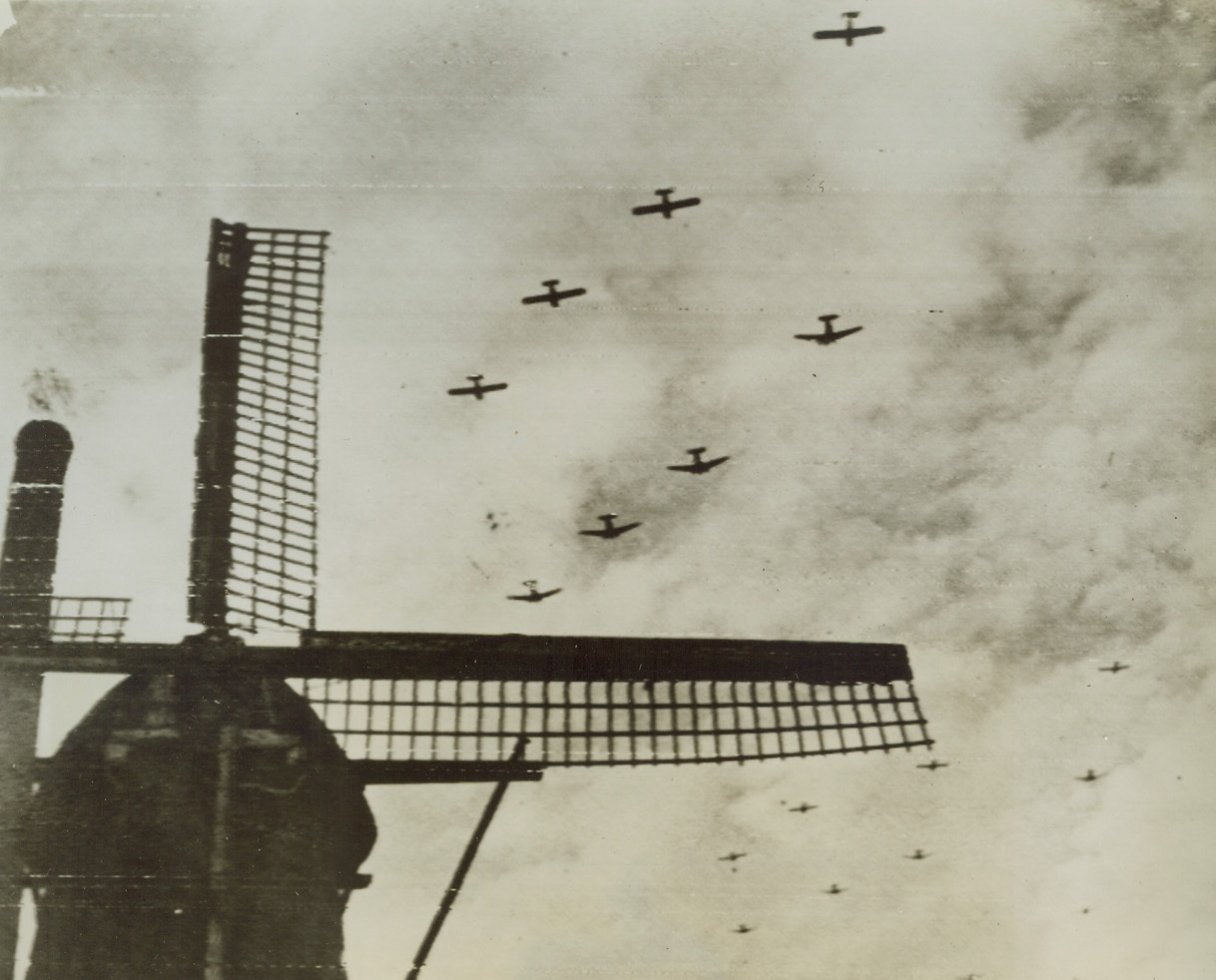
SUPPORT FOR TRAPPED TROOPS, 9/25/1944. American two planes with their gliders, pass over a windmill at Valkenswaad, near Eindhoven, Holland, on their way with reinforcements for airborne troops trapped at Arnhem. Credit: British official photo via U.S. Army radiotelephoto from Acme;
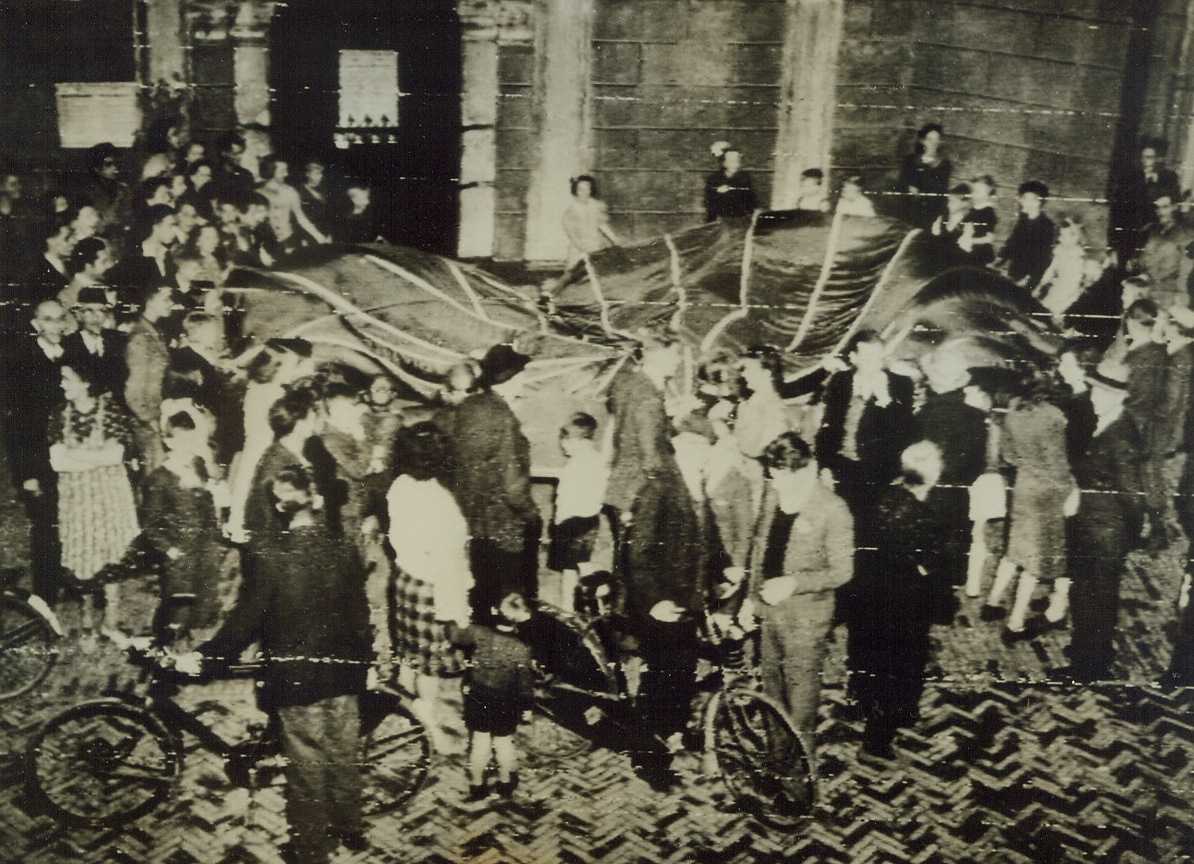
PARACHUTE DANCE, 9/24/1944. GRAVES, HOLLAND—A variation of the traditional maypole dance—heralding a far more joyous occasion than the mere advent of spring—marked the Graves celebration of its liberation by American paratroopers. Dutch women and children of the town gathered about an Allied parachute, jubilantly singing and dancing in a circle. Credit: Army radiotelephoto from Acme;

RIMINI MOPUP, 9/29/1944. RIMINI—Stepping over piles of debris in captured Rimini, Greek infantrymen “mop up” the Adriatic port. Credit: British official photo via Army radiotelephoto from Acme;
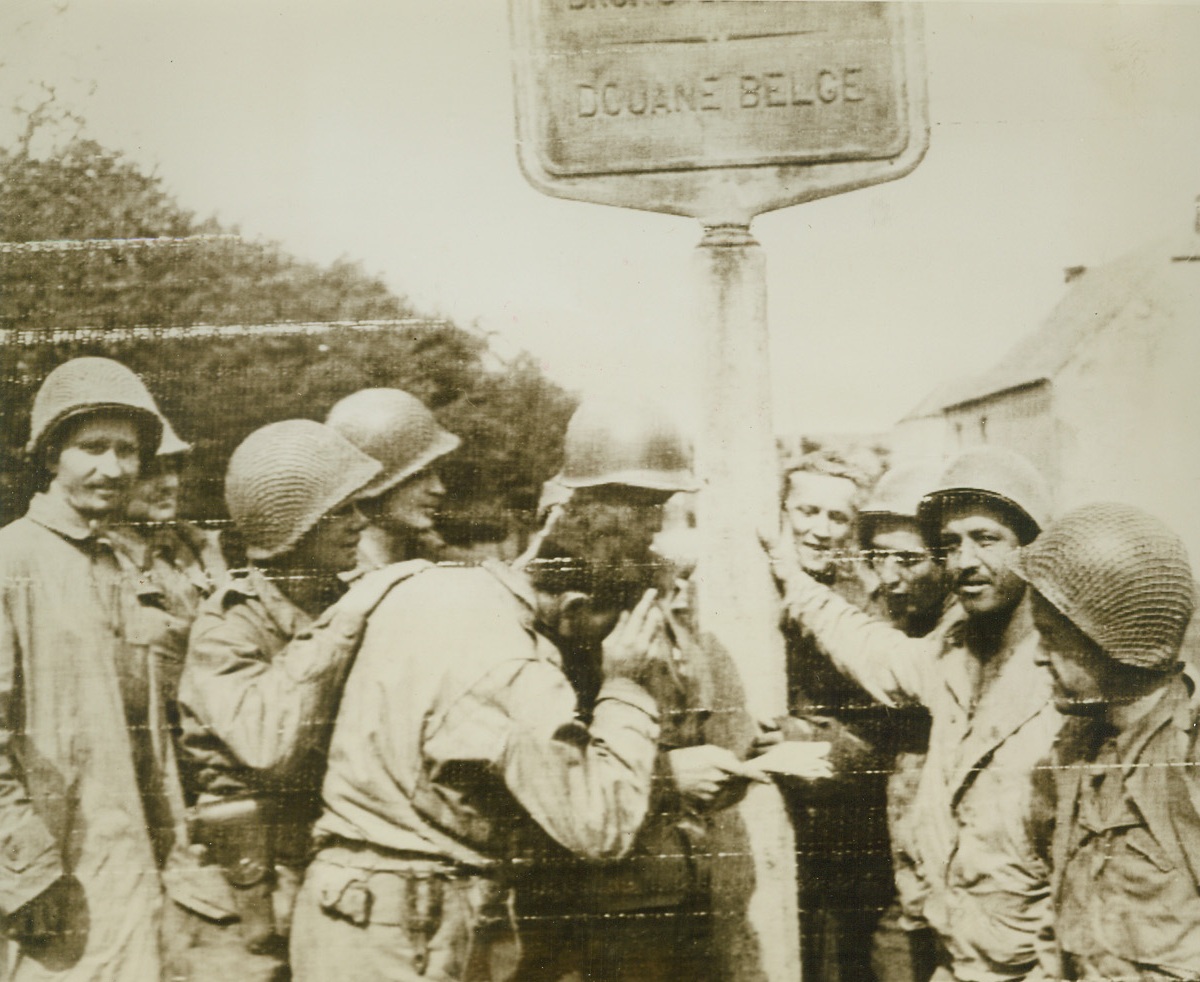
THIS IS THE WAY TO BERLIN, BOYS, 9/7/1944. BELGIUM—Hitting out in a powerful drive toward Berlin, a group of Yank soldiers pause at the Belgian border to study a map and see if they are on the right track. The sign says Belgian Customs. Credit: Signal Corps radiotelephoto from Acme;
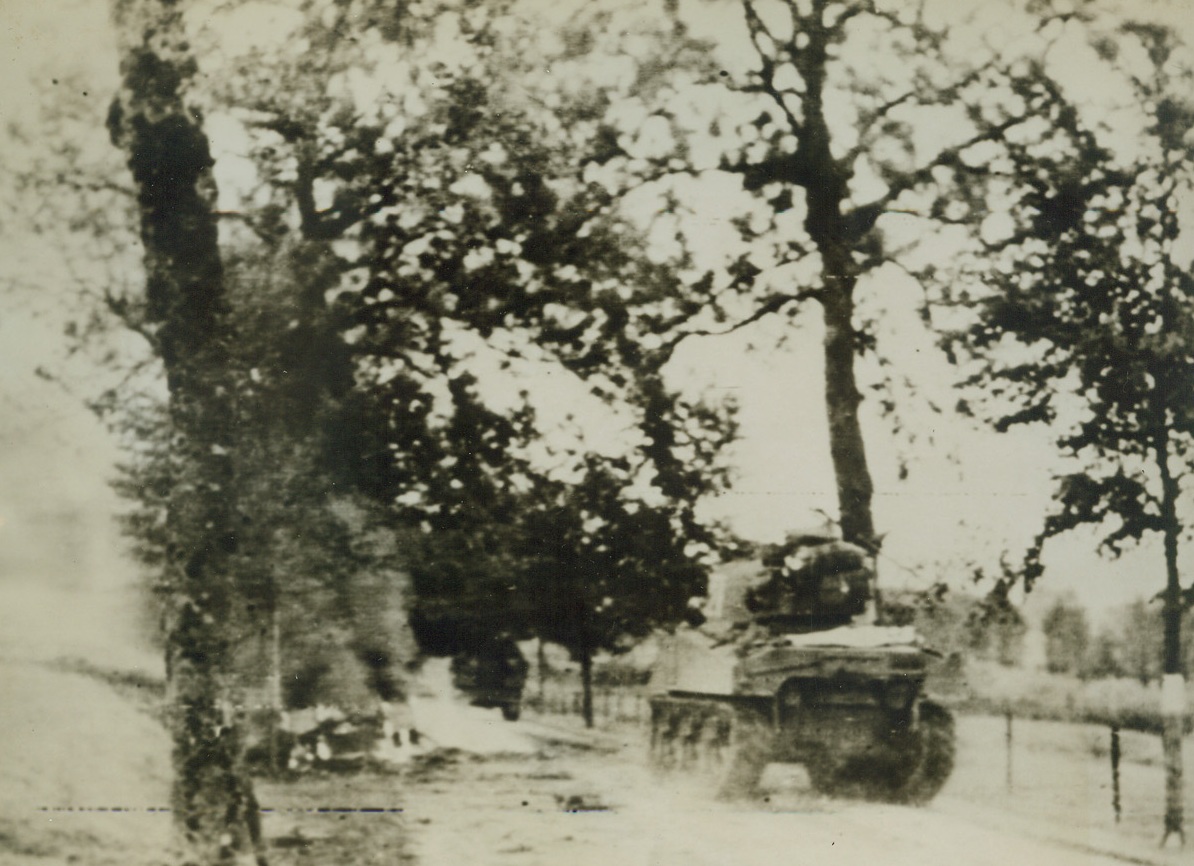
TANKS ADVANCE IN LUXEMBOURG, 9/13/1944. LUXEMBOURG—A United States Sherman tank rolls onward past a destroyed and still burning German vehicle after an encounter just inside the Luxembourg border. Credit: Army radiotelephoto from Acme;
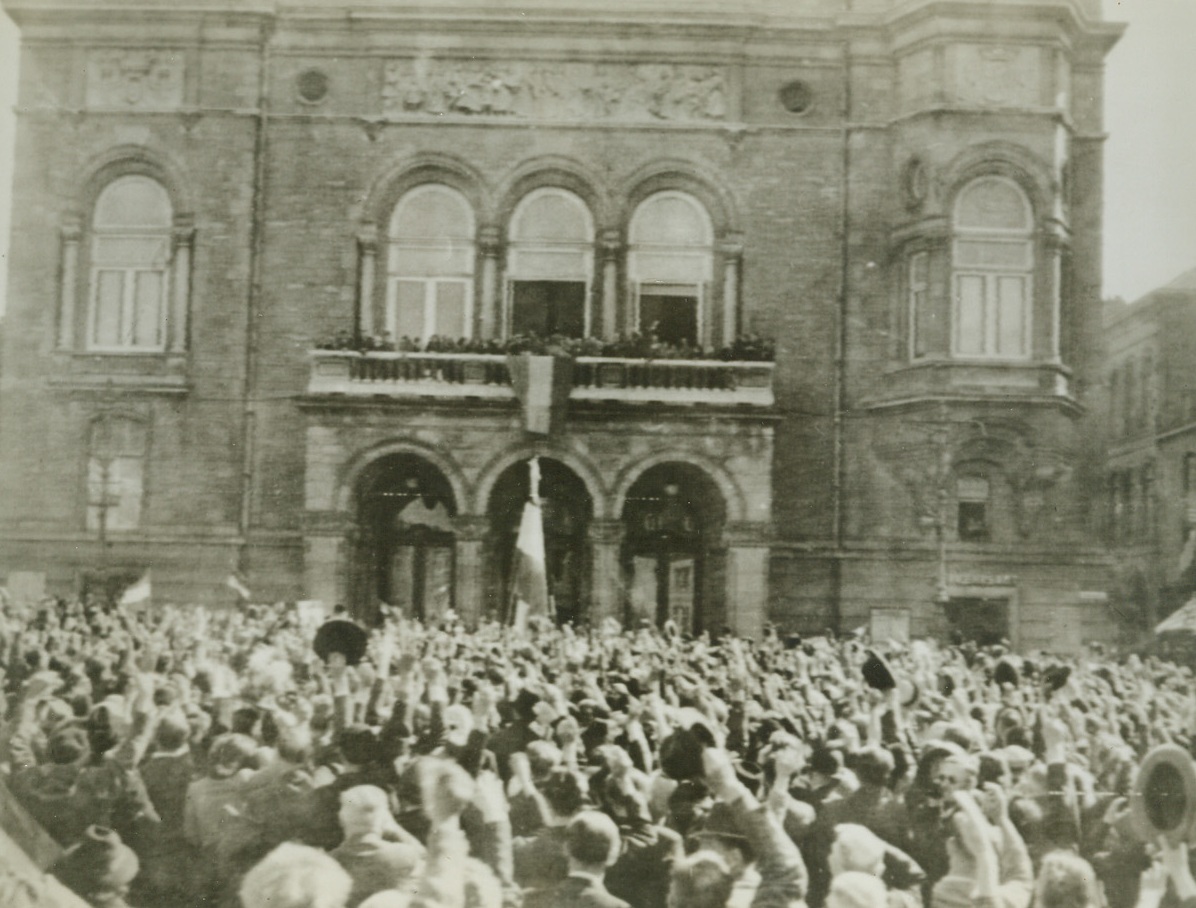
CHEER LIBERATION OF LUXEMBOURG, 9/13/1944. Wildly cheering citizens crowd before the City Hall as Prince Felix of the Duchy of Luxembourg stands on the balcony to greet them after liberation by the Allies. Credit: Army radiotelephoto from Acme;
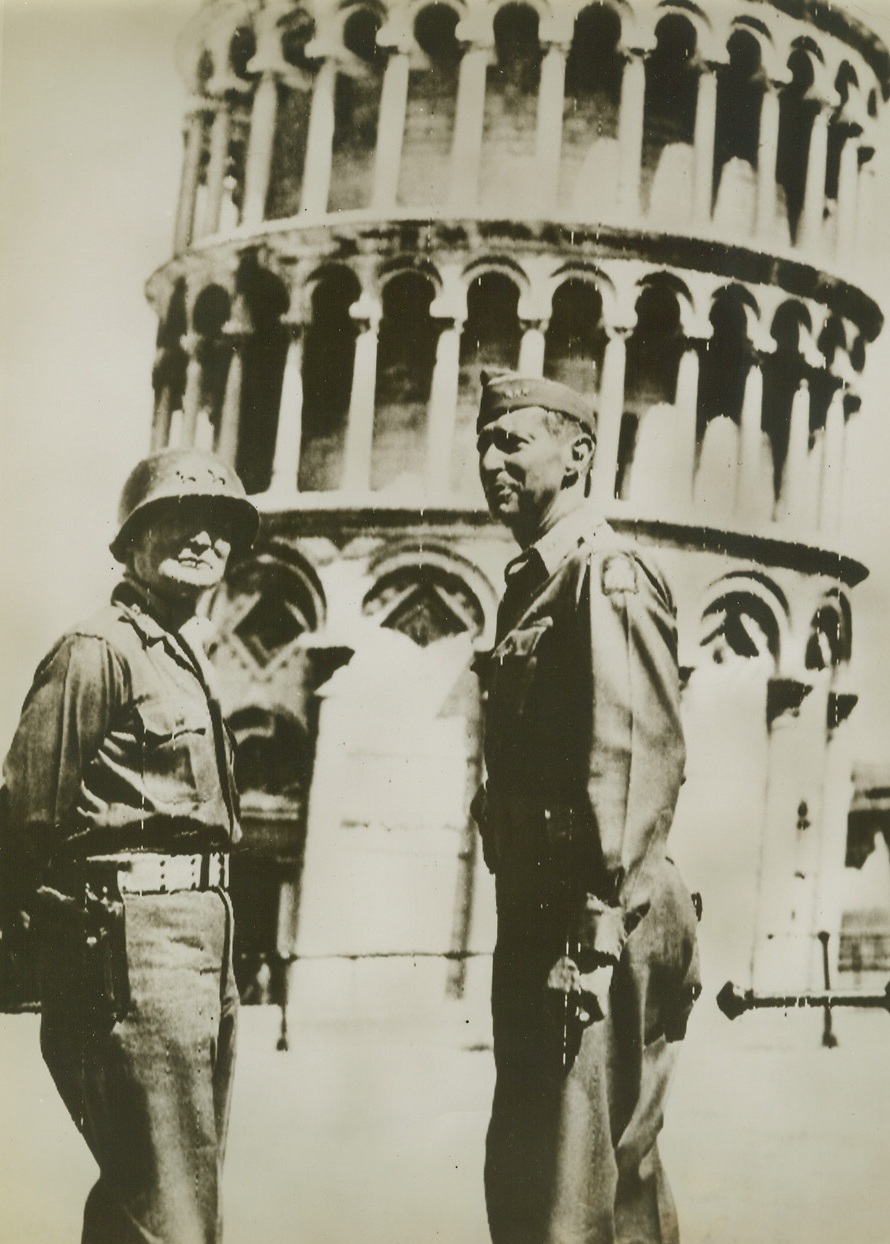
GENERAL CLARK VISITS PISA, 9/6/1944. ITALY—Undamaged by the Fifth Army in its successful fight for the city of Pisa, Italy, the famous Leaning Tower is visited by Maj. Gen. Willis D. Crittenberger (left), of the Fifth Army, and Lt. Gen. Mark W. Clark, Fifth Army’s Commanding General. Credit: Acme photo via Army radiotelephoto;
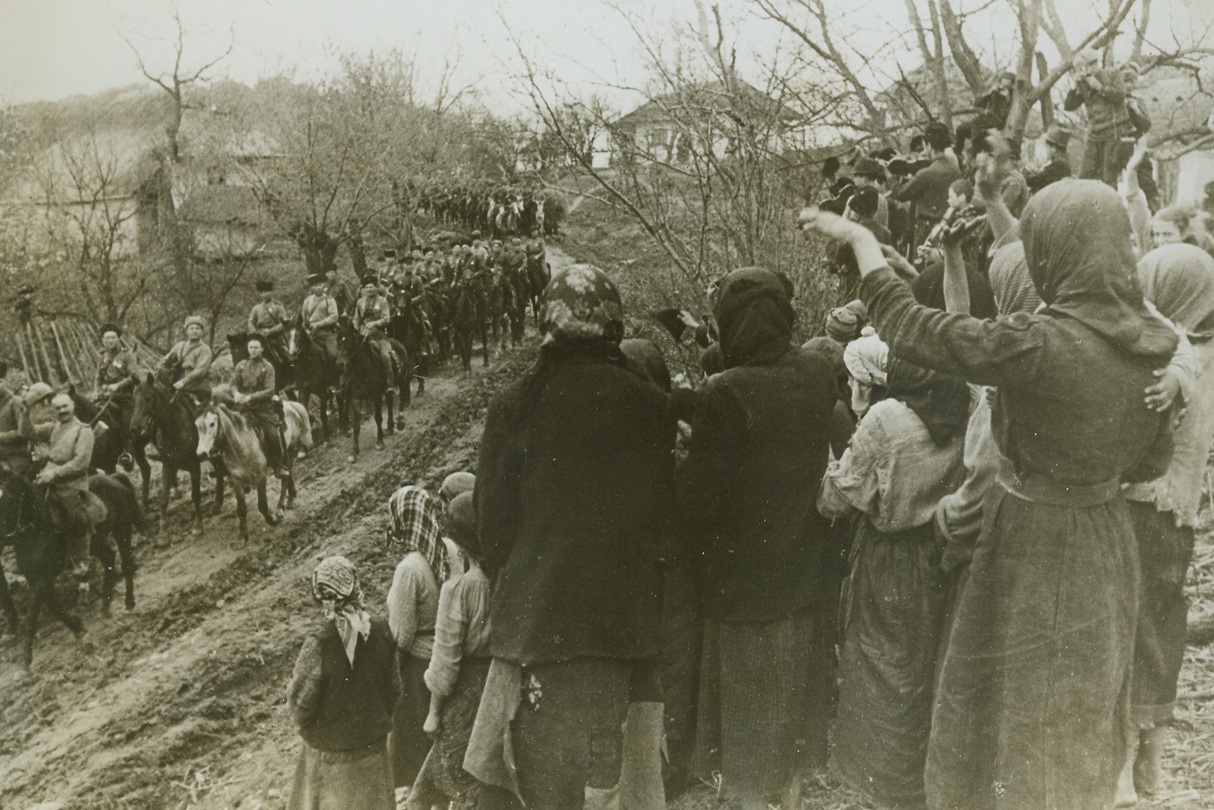
COSSACKS IN ROMANIA, 9/6/1944. ROMANIA—Residents of a tiny Romanian village, their heads covered with shawls, line a roadway to greet Don Cossack Guardsmen as they pass by. One gallant horseman (at lower right) raises his cap to the ladies. Credit: Acme;
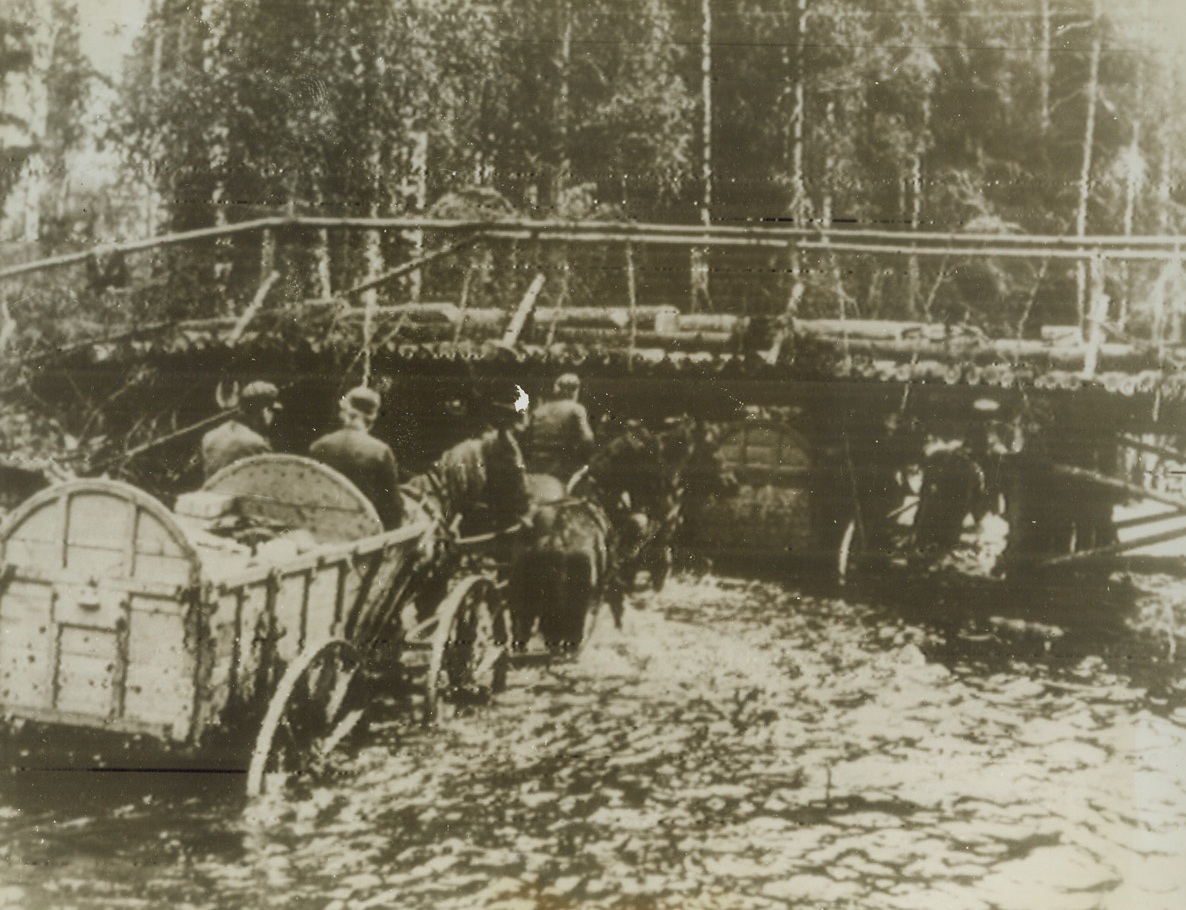
SPEEDY RETREAT, 9/5/1944. Using horses, a German supply column retreats on the east front, using the “river as a road.” According to the German caption accompanying the photo, this means is “faster and easier than other ways of transportation.” Credit: Acme radiophoto;
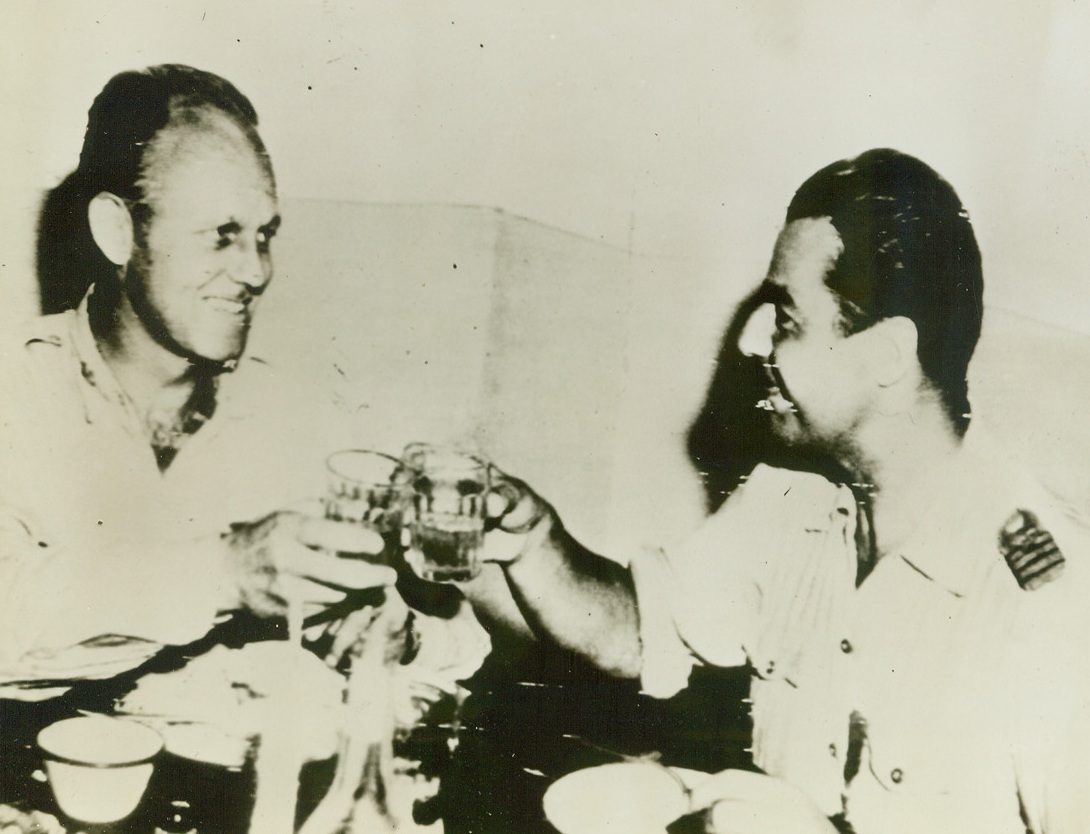
TOAST TO THE HOAX, 9/3/1944. ITALY—Lt. Col. James A. Gunn, San Antonio, Tex., (left) drinks a toast with Capt. Bazu Cantaguzino at a 15th AAF base in Italy. The Romanian pilot flew Col. Gunn back to Italy in a stolen ME-109 to arrange for the mass evacuation of over 1,000 former air forces combat crew members from Romanian prison camps. Credit: Signal Corps radiotelephoto from Acme;
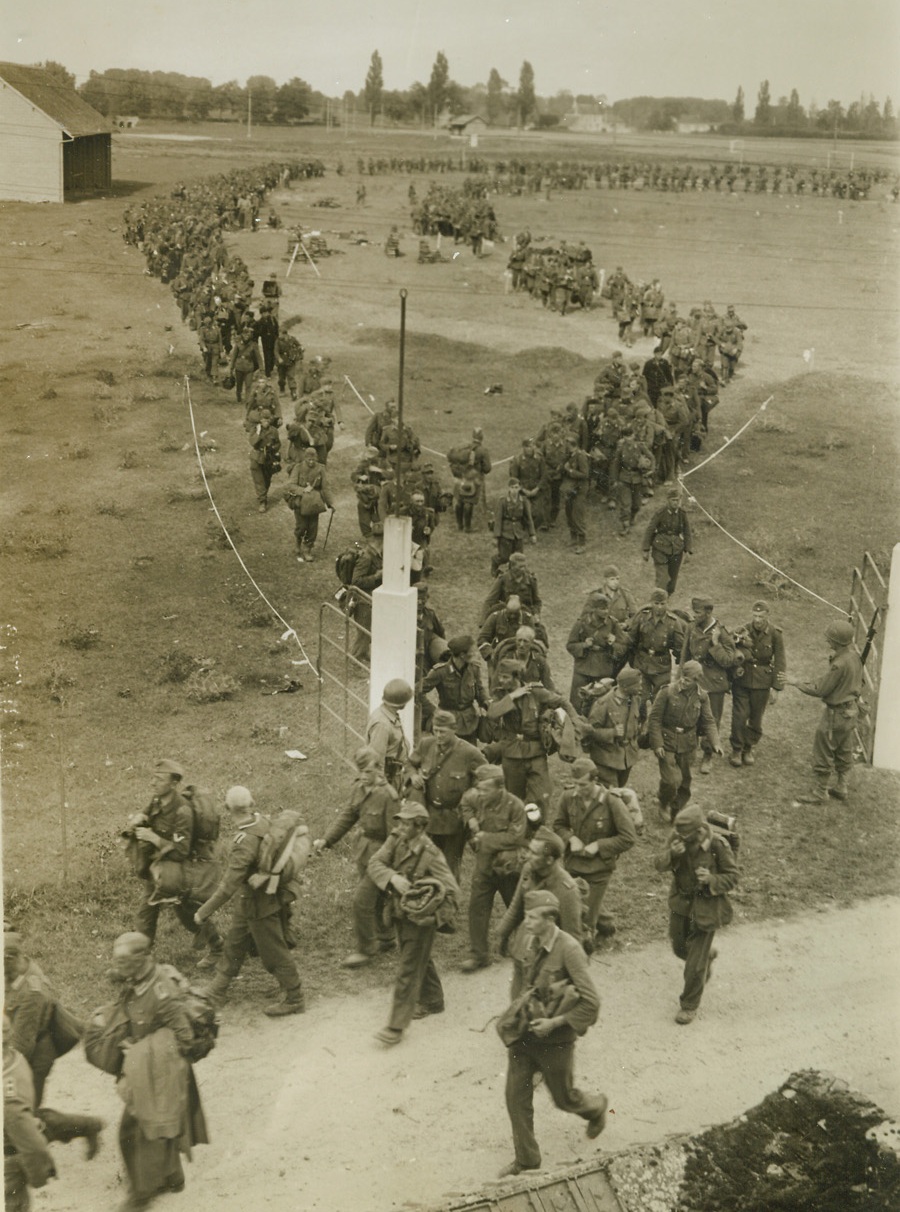
Nazis Surrender 20,000 Strong, 9/22/1944. BEAUGENCY, FRANCE – Arms and equipment handed in, twin endless lines of Germans, part of a huge army of 20,000, are marched through taped areas to prisoner of war cages after their surrender to the United States Ninth Army. Nazis in the armies of occupation from the Loire south to the Pyrenees gave up their weapons to end a bloodless campaign which insured one of the greatest military bargains in modern history. Photo by Charles Haacker, Acme photographer for the War Picture Pool. Credit – WP- (ACME);
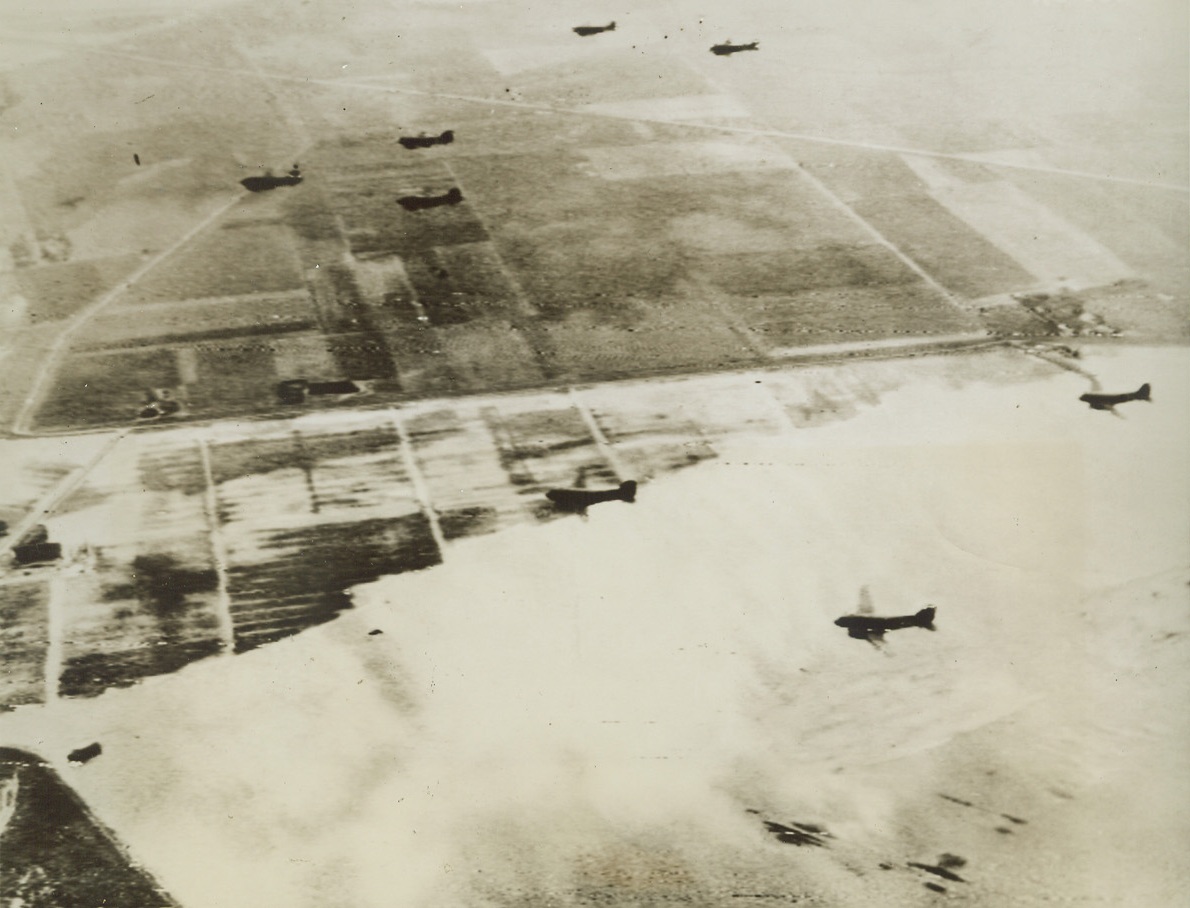
Invaders Soar Over Flooded Lowlands, 9/18/1944. HOLLAND – With flood waters lapping across the Holland countryside below, a train of C-47 transports carries a paratroop cargo to its invasion destination. A giant armada of warrior-carrying planes participated in the sky-borne invasion, landing, according to German reports, at Nijmegen, Tilburg and Eindhoven. Credit (Signal Corps Radiotelephoto from ACME);
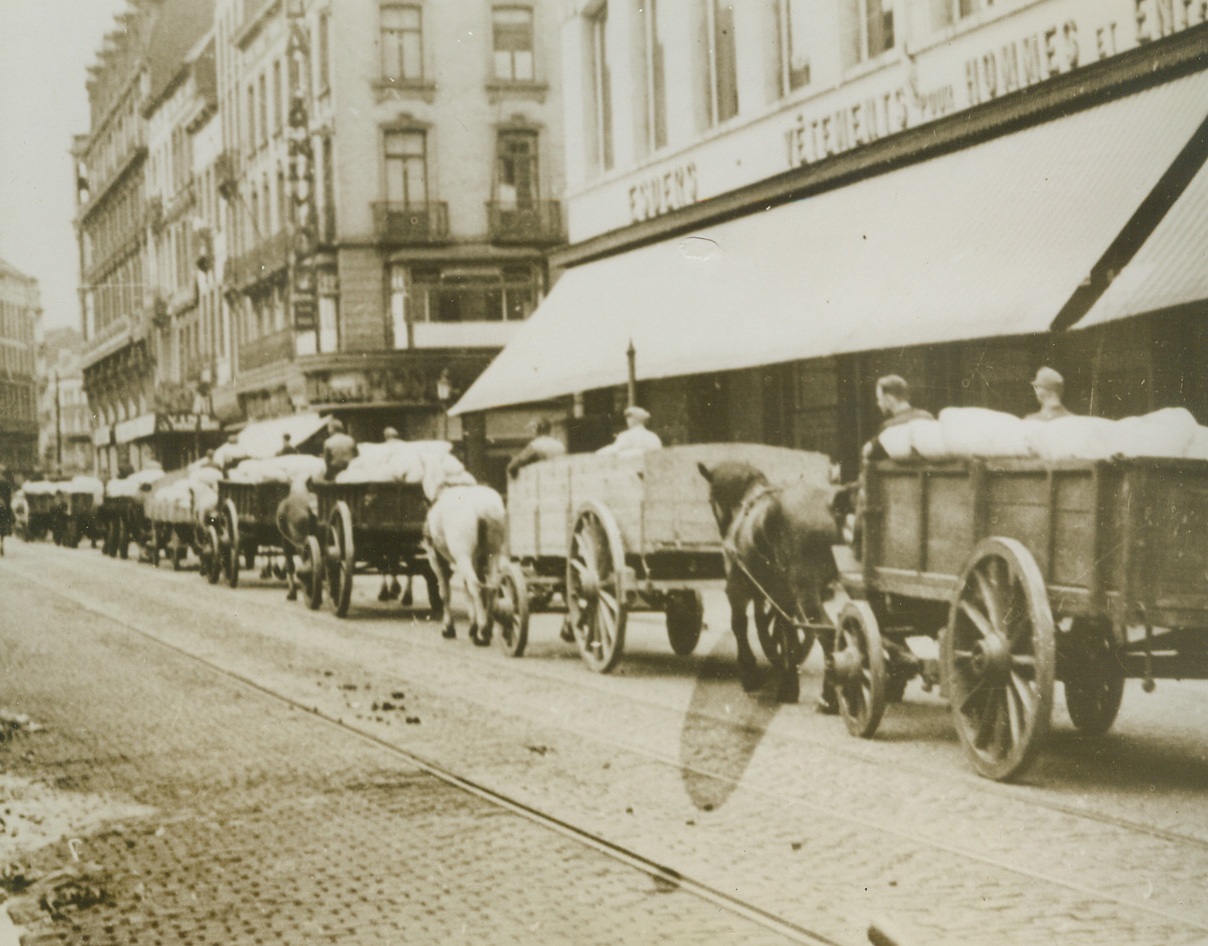
Jerry Beats It – With the Goods, 9/22/1944. BRUSSELS, BELGIUM – Leisurely moving out of Brussels, well ahead of advancing Allied troops, Nazi soldiers take carts full of stolen Belgian flour with them. This photo was made secretly by Van Osta, a Belgian cameraman, who risked his life to record the Nazi flight. Credit Line (ACME);
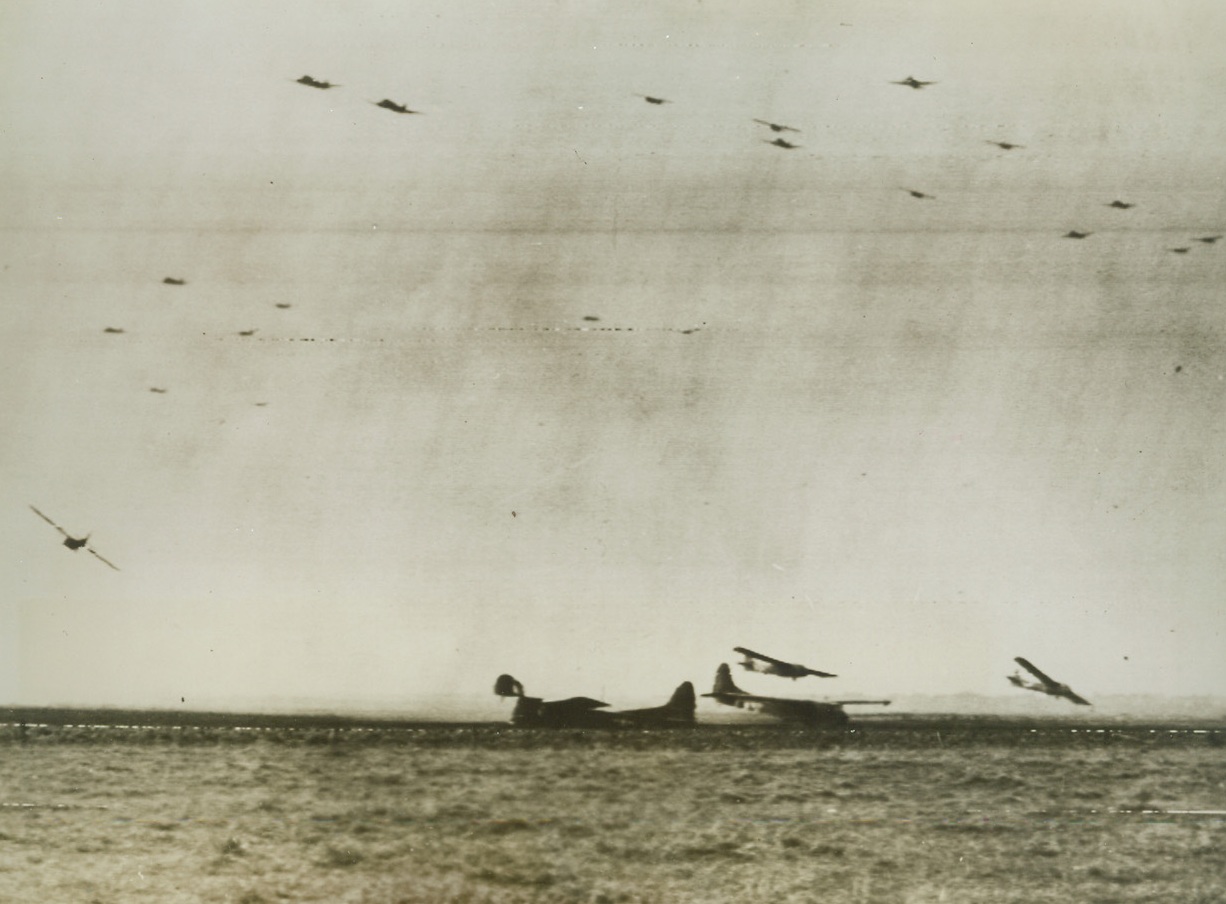
Allied Gliders Land in Holland, 9/21/1944. Loaded with American troops and equipment, gliders swoop down to a landing behind the German lines in Holland. Other craft with their tow planes soar overhead. Credit Line (Army Radiotelephoto from ACME);
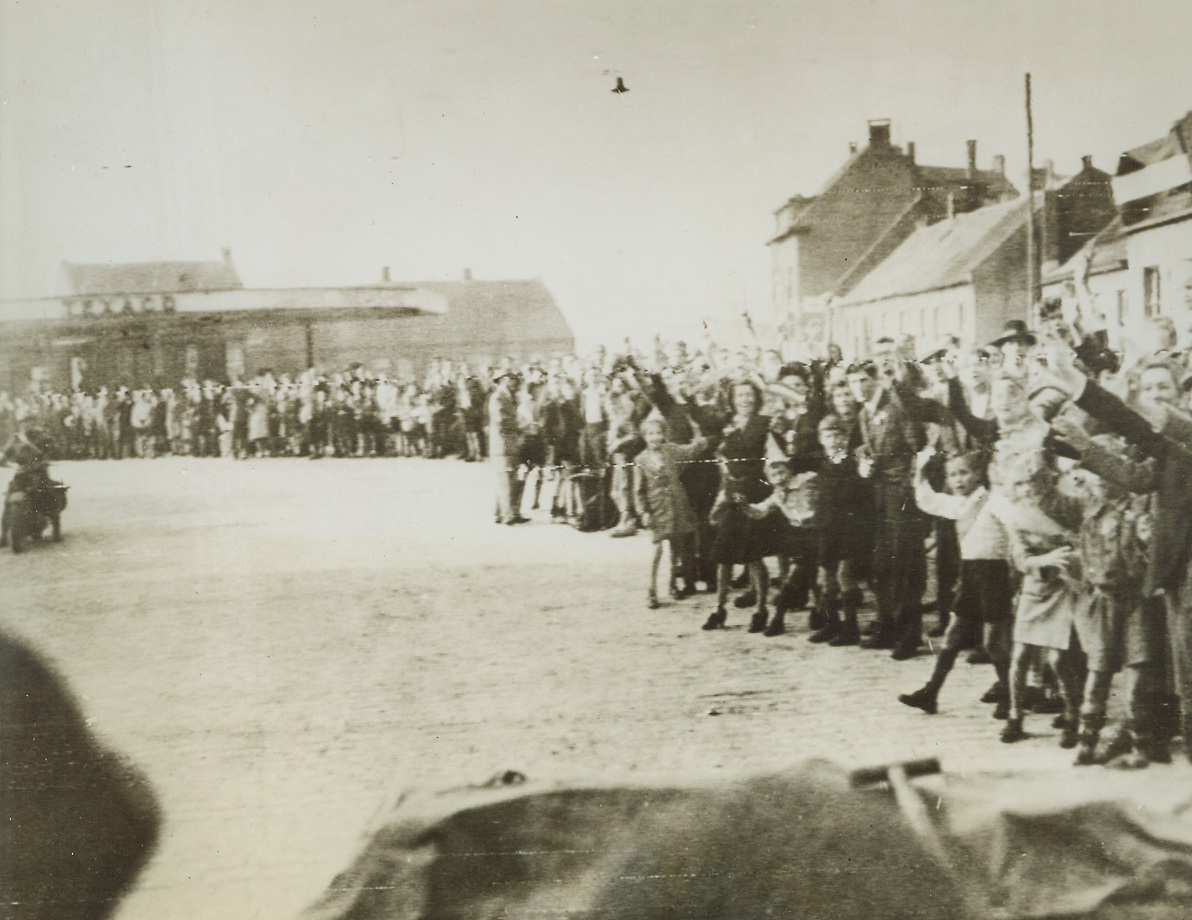
Dutch Welcome, 9/22/1944. HOLLAND – Waving and cheering, Dutch civilians give American Airborne troops a hearty welcome after our boys landed behind German lines and advanced to take the town of Lindhoven. Credit Line (Army Radiotelephoto from ACME);
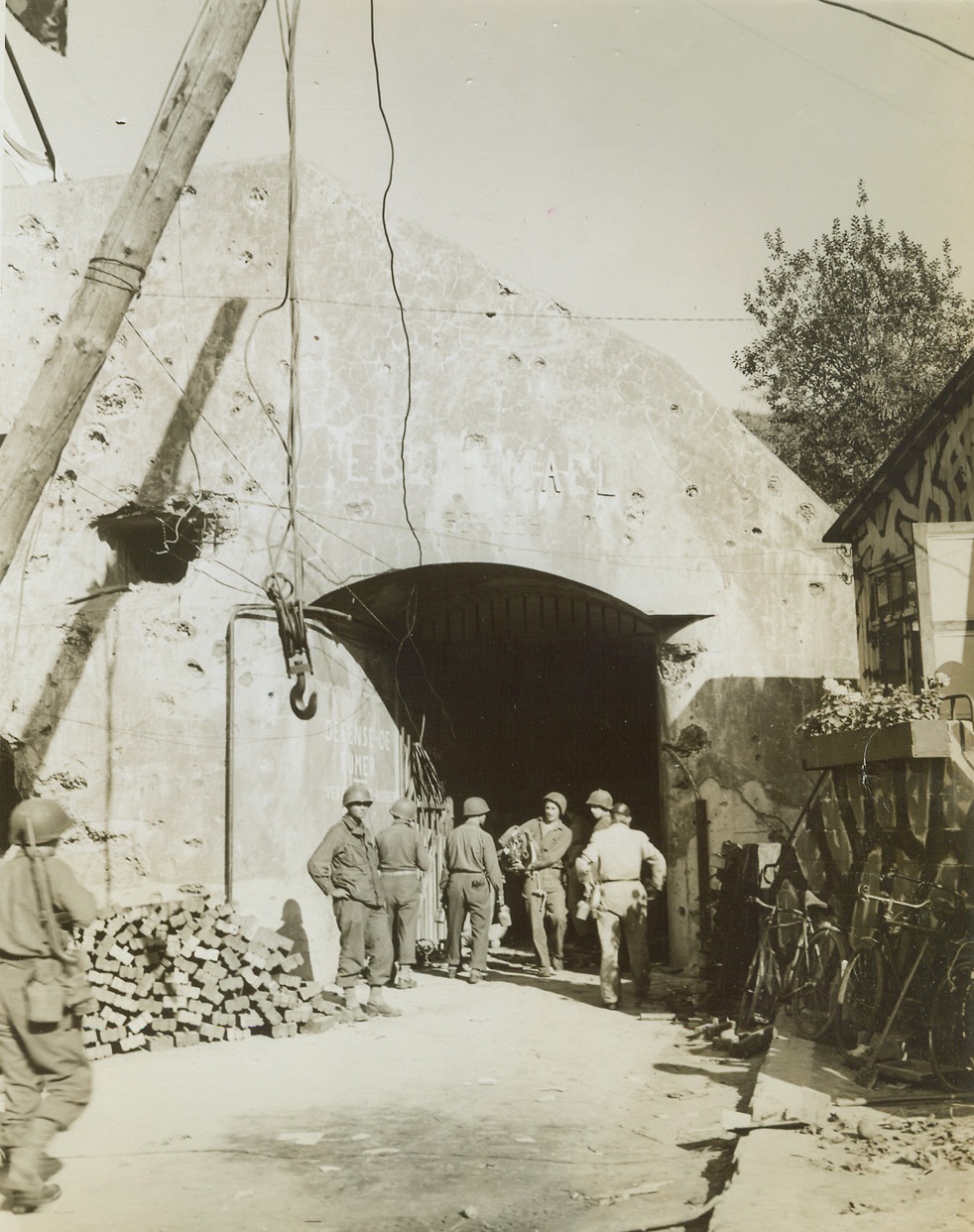
Historic Fort Captured by Yanks, 9/21/1944. BELGIUM – At one time called the strongest fort in Belgium, and one of the most impregnable in the world, Eben Emael has recently been taken from the Nazis by American troops. The Germans took the fort when they overran the Low Countries in 1940. Here, Yanks stand at one of the fort’s entrances. Credit Line (ACME Photo by Andrew Lopez for the War Picture Pool);
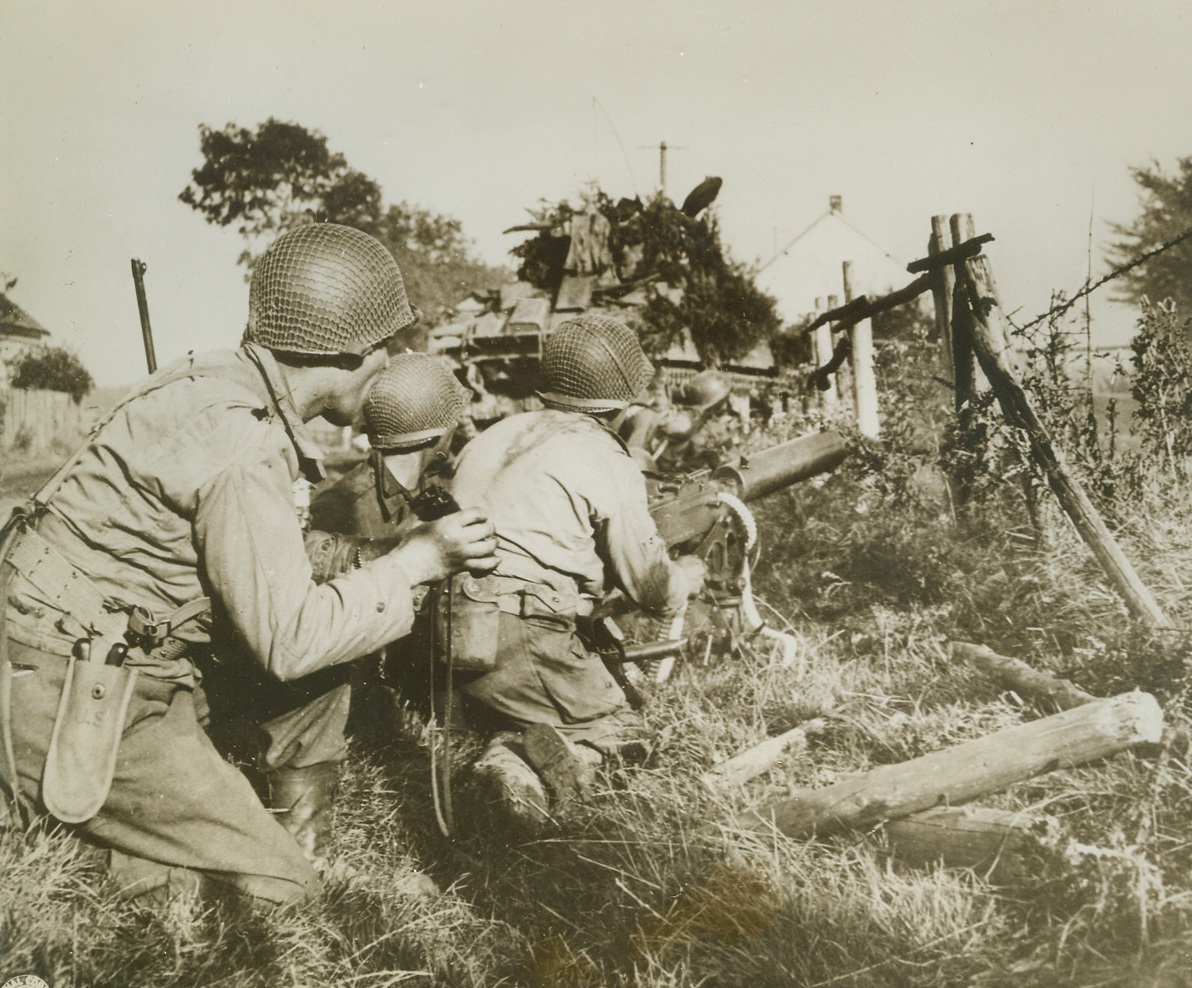
Blast Away at Enemy Positions, 9/22/1944. ROTH, GERMANY -- American machine gun crew crouches tensely by a roadside in Roth, Germany, as a camouflaged tank opens up on Nazi positions. Credit (Signal Corps Photo from ACME);
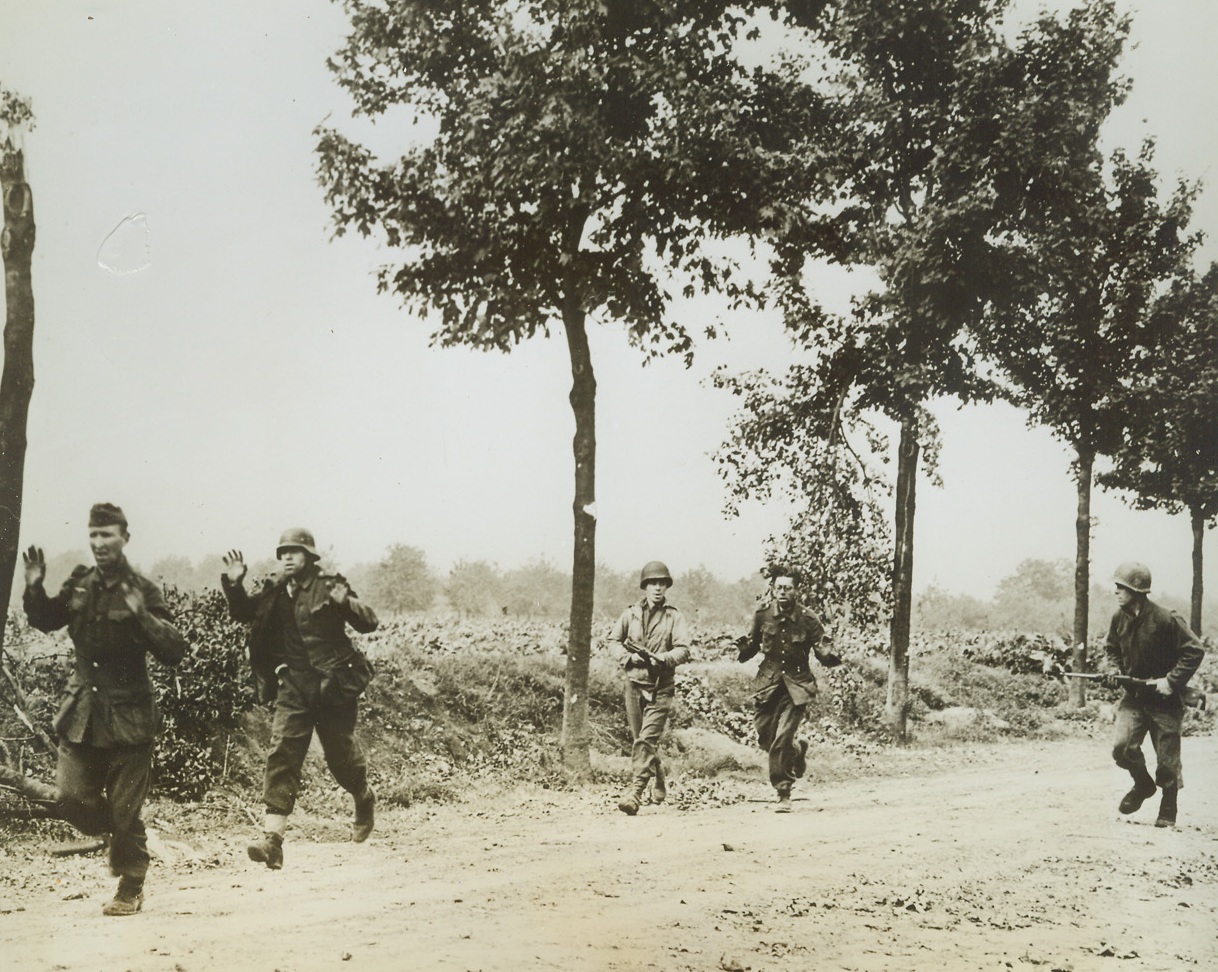
The Hun on the Run, 9/21/1944. HOLLAND -- Frightened and confused, German prisoners, rounded up by Yanks after a battle near Maarland, Holland, are double-timed to headquarters by their captors. Credit (Signal Corps Photo from ACME);
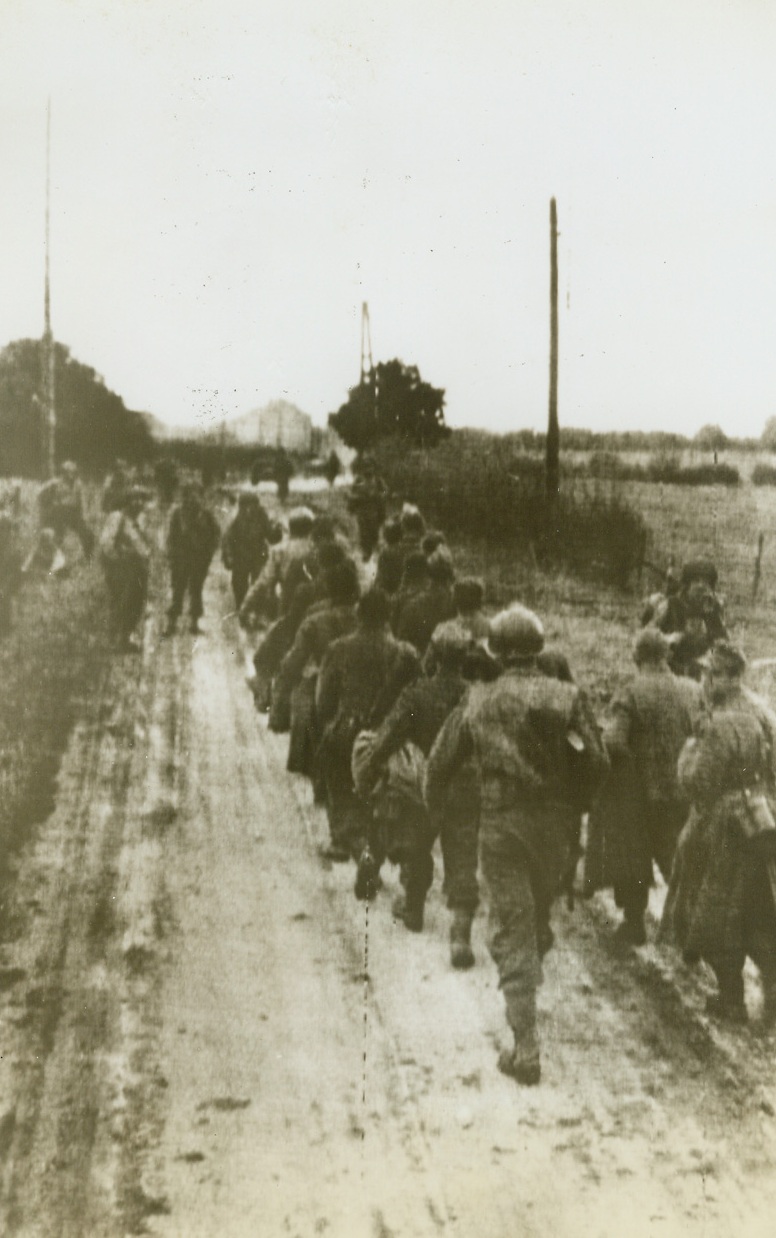
Prisoners in Their Homeland, 9/17/1944. AACHEN SECTOR, GERMANY – Charged to defend the mighty Siegfried Line at any cost, these German soldiers were taken prisoner in the Aachen sector. As they are marched toward the rear, they pass American infantrymen on their way to the front. This photo was made by Andrew Lopez, Acme photographer, for the War Picture Pool. Credit: (ACME) Photo via Army Radiotelephoto;
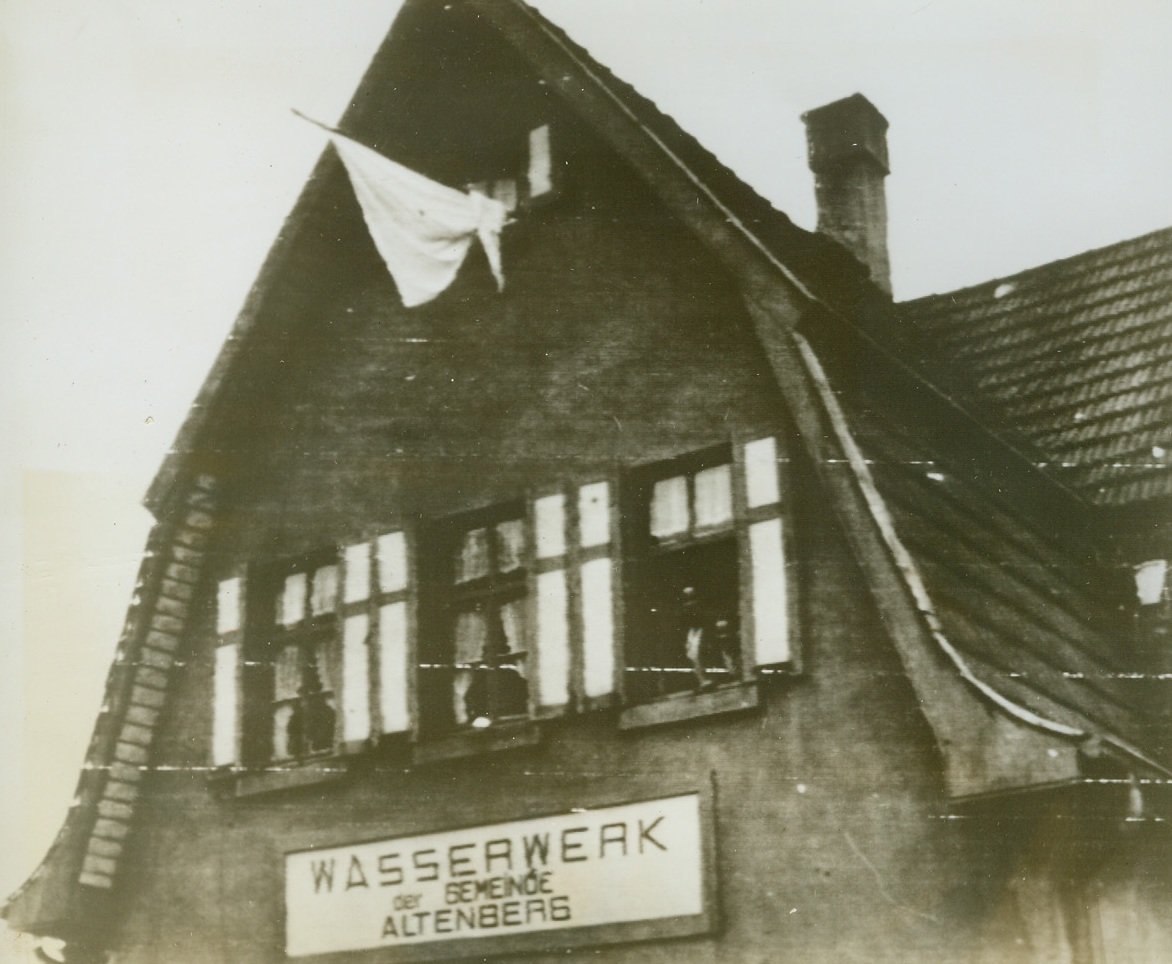
Symbols of Surrender Greet Yanks in Germany, 9/17/1944. AACHEN, GERMANY – The white flag of surrender flies from a gable window in this house near Aachen, Germany. Yanks nearing Aachen were greeted by frequent sights like this. Reports indicated that the Germans’ initial cold attitude toward the Americans has warmed somewhat when they discovered that the invaders weren’t the terrors the Nazi officials would have them be. Credit (Signal Corps Radiotelephoto from ACME);

Temporary Quarters, 9/17/1944. GERMANY – Yank infantrymen stand in the doorway of an abandoned pillbox inside the German border. Reaching the post shortly after the Nazis fled, American troops established temporary headquarters here. Credit (Signal Corps Radiotelephoto from ACME);
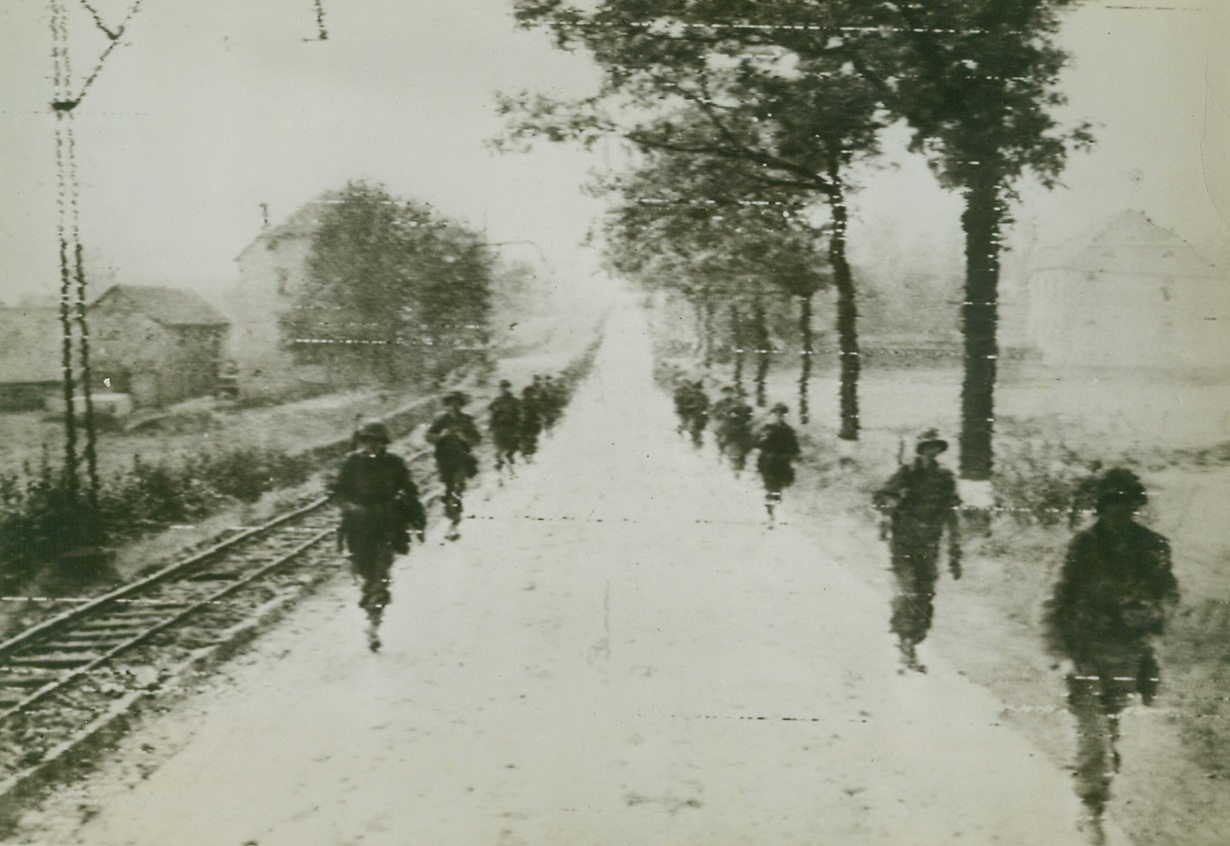
American Troops March in Germany, 9/15/1944. GERMANY – Troops of Gen. Hodges’ 1st Army march along both sides of a road in an endless single file as they advance to the key German city of Aachen. These troops, among the first to enter Germany, made history by bringing war to the Fatherland. Credit – WP –(ACME Photo by Andrew Lopez, War Pool Correspondent via Army Radiotelephoto);
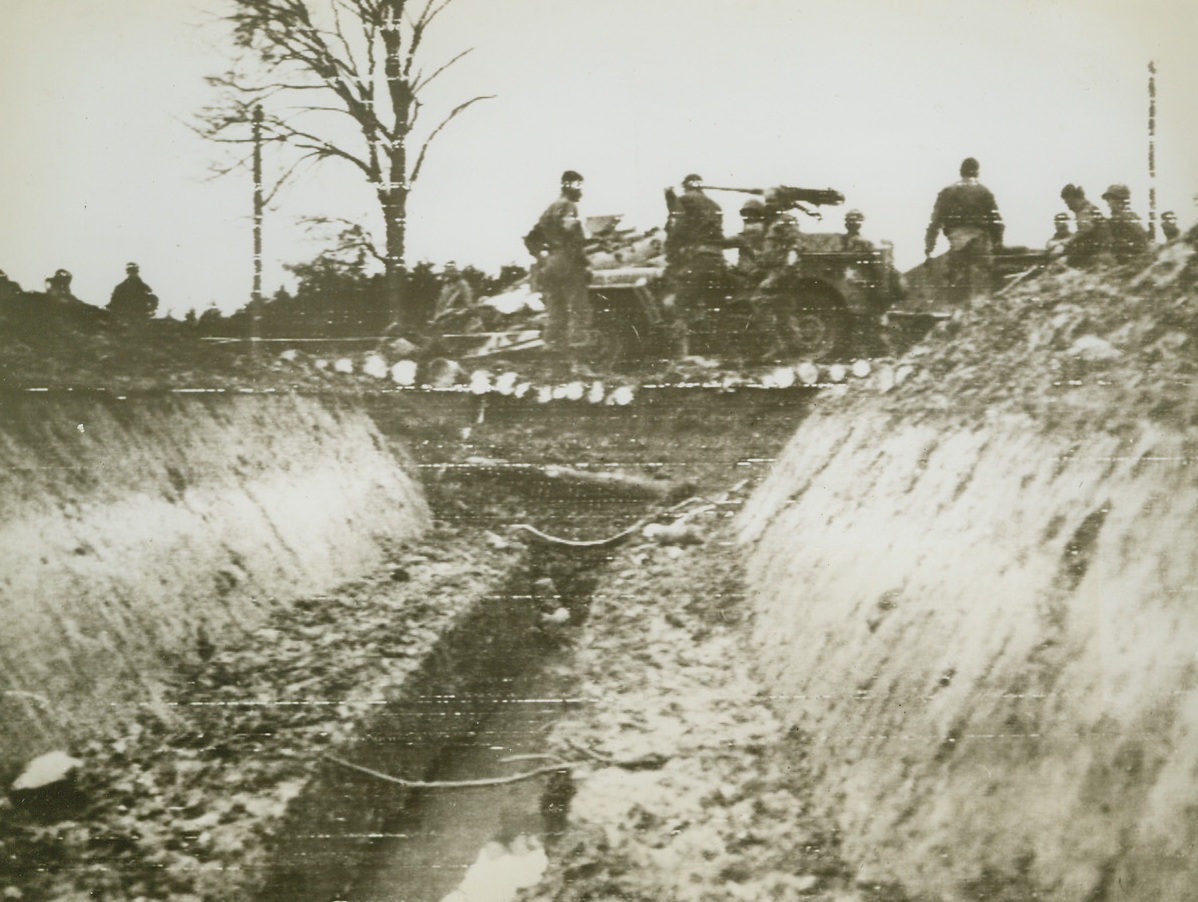
Tank Trap no Obstacle for Yank Jeep, 9/16/1944. GERMANY – Over an improvised bridge, rigged up by Yank engineers as soon as the area was cleared of Nazis, an American Jeep crosses a 15-foot tank trap which was part of the vaunted Siegfried Line. Credit – WP –(Army Radiotelephoto from ACME);
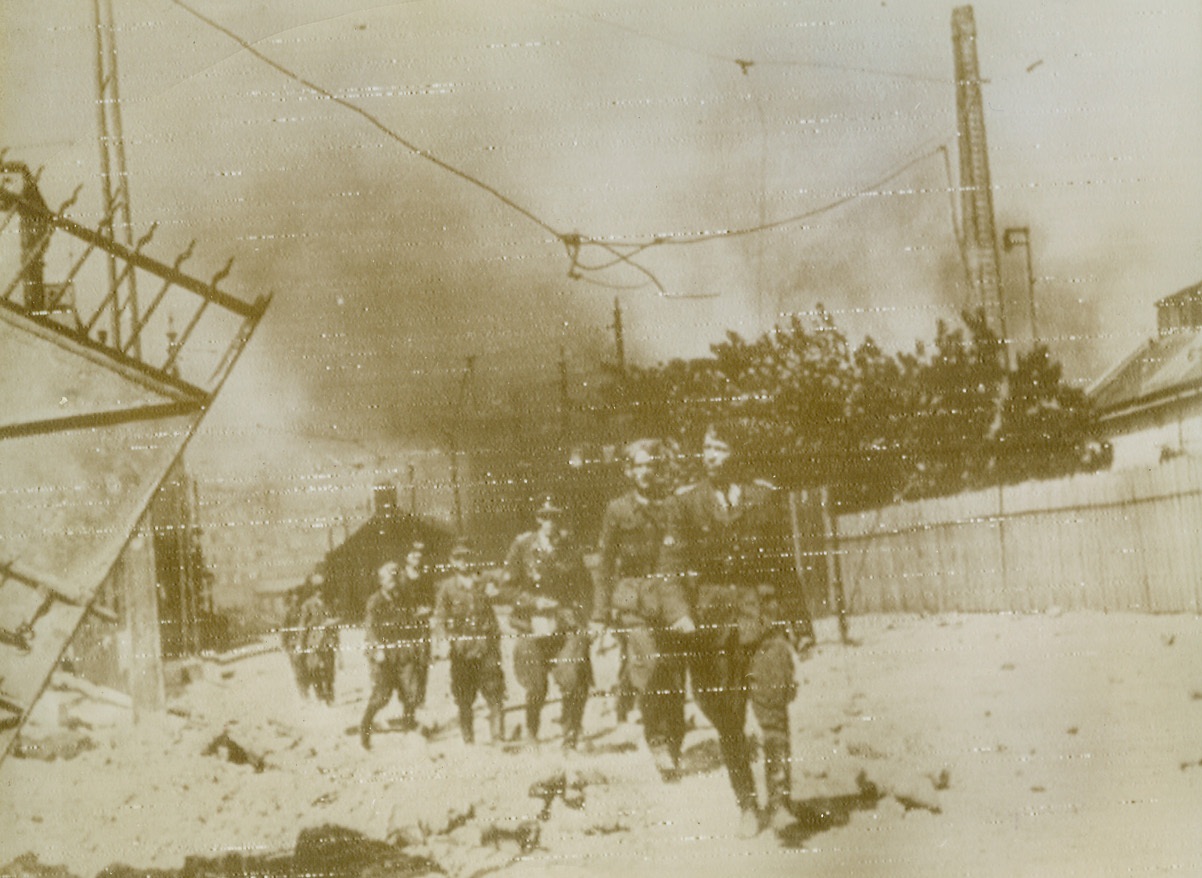
Germans Aim to Suppress Warsaw Revolt, 9/2/1944. The German regimental commander advances through a street in war-torn Warsaw with his men as they head toward the center of the street fighting to stop the revolt of Polish patriots. Dispatches from Warsaw state that the German Army threatens to burn the entire city in an effort to stop the uprising. Credit (ACME Radiophoto);
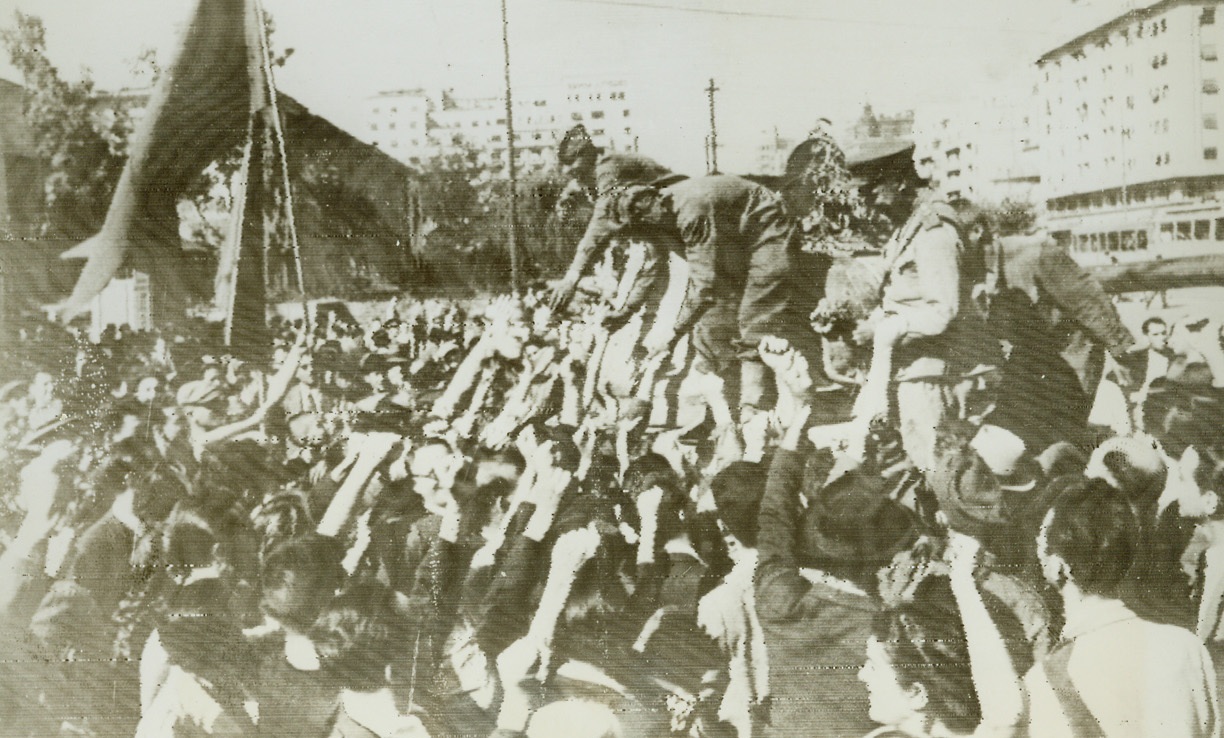
Bucharest Welcomes Red Forces, 9/2/1944. BUCHAREST, ROMANIA – As the Red Army enters the Romanian capital of Bucharest, people crowd the streets and reach out eager hands to grasp those of their liberators. Russian forces, fresh from the capture of Bucharest, are driving on the Bulgarian border on the Danube, and have captured Giurgiu, headquarters of commerce between Romania and Bulgaria. Credit (ACME Radiophoto);
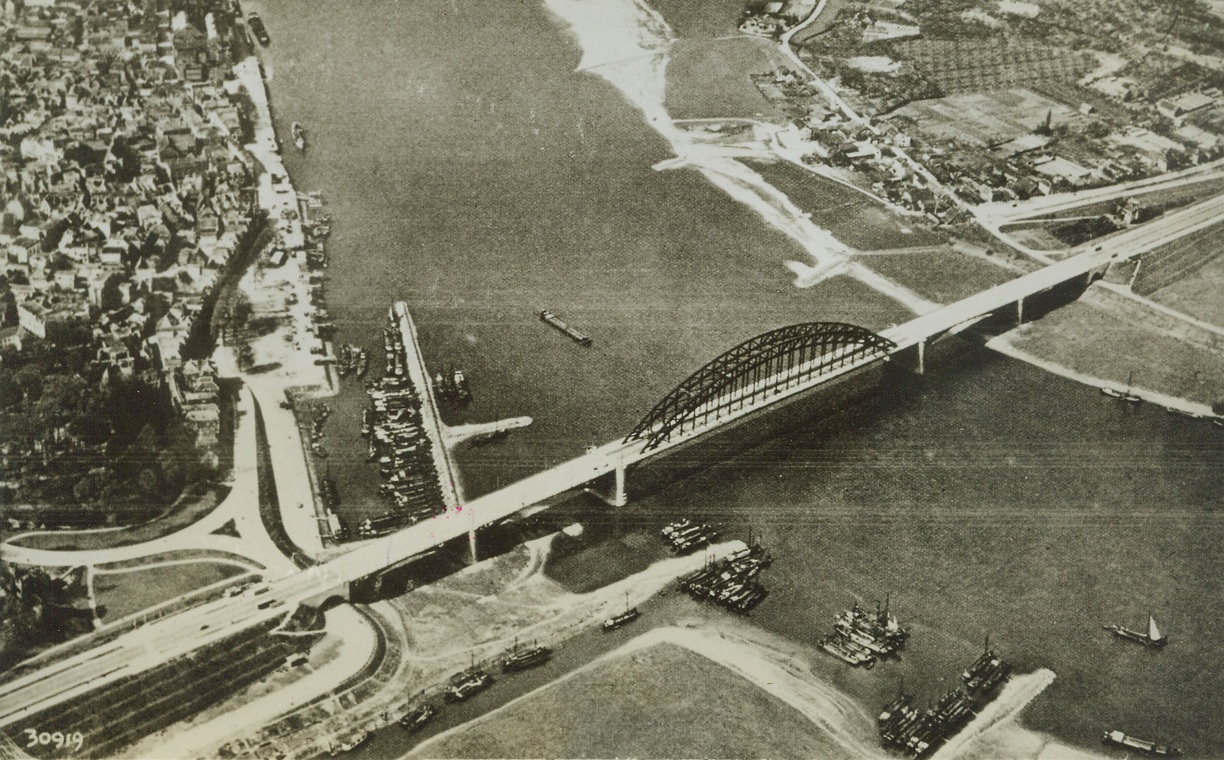
Span Over Rhine Taken by British Troops, 9/21/1944. HOLLAND – A path of relief for a large pocket of Air-borne troops locked in a fight for life near Arnheim, eight miles to the north, was blasted open today when British tanks and Allied Air-borne troops captured intact the mile-and-a-half-long Nijmegen bridge. Fierce battle for the span over the Rhine lasted twenty-four hours. This is a pre-war view of the bridge in Holland.Credit (Netherlands Official Photo from ACME);

To Help Free France, 9/9/1944. FRANCE -- Desolation marks the once beautiful Rhone River at Tarascon in Southern France. Wrecked bridges, effectively bombed by the Allies to hinder the German retreat, are a grim reminder of the destruction that accompanies war. Pock marks in the islets between bridges show where Allied bombs missed their target. At left is a castle-like building one of many that dot the countryside in Southern France. Photo by Charles Seawood, ACME Photographer for the War Picture Pool. Credit - WP- (ACME);
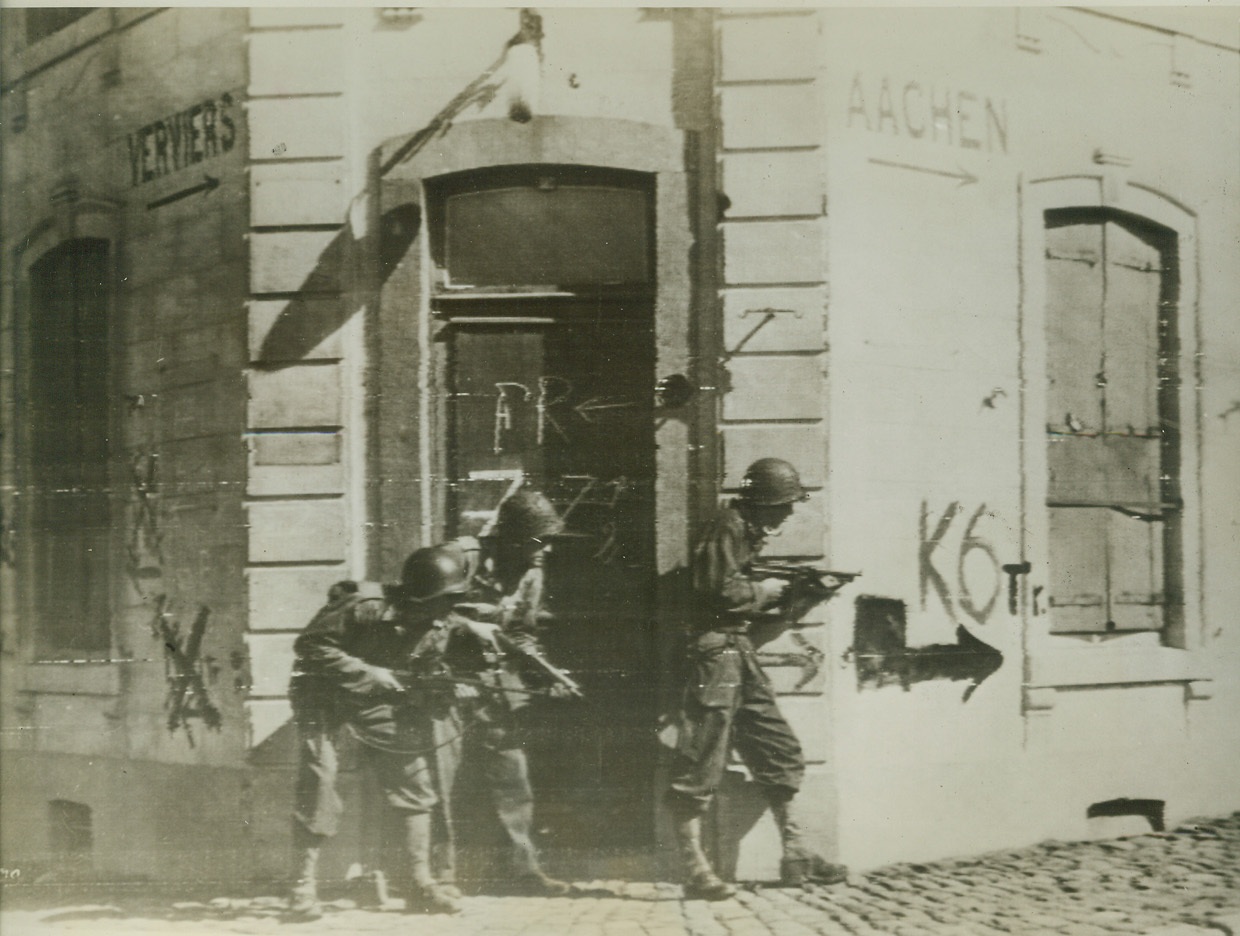
Caution Makes for Success, 9/14/1944. THIMISTER, BELGIUM -- Peering cautiously around the corner of this building, a three-man combat patrol scouts out the little town of Thimister. They are moving in advance of the main forces. Note the sign on the building which points to Aachen. Credit (Signal Corps Radiotelephoto from ACME);
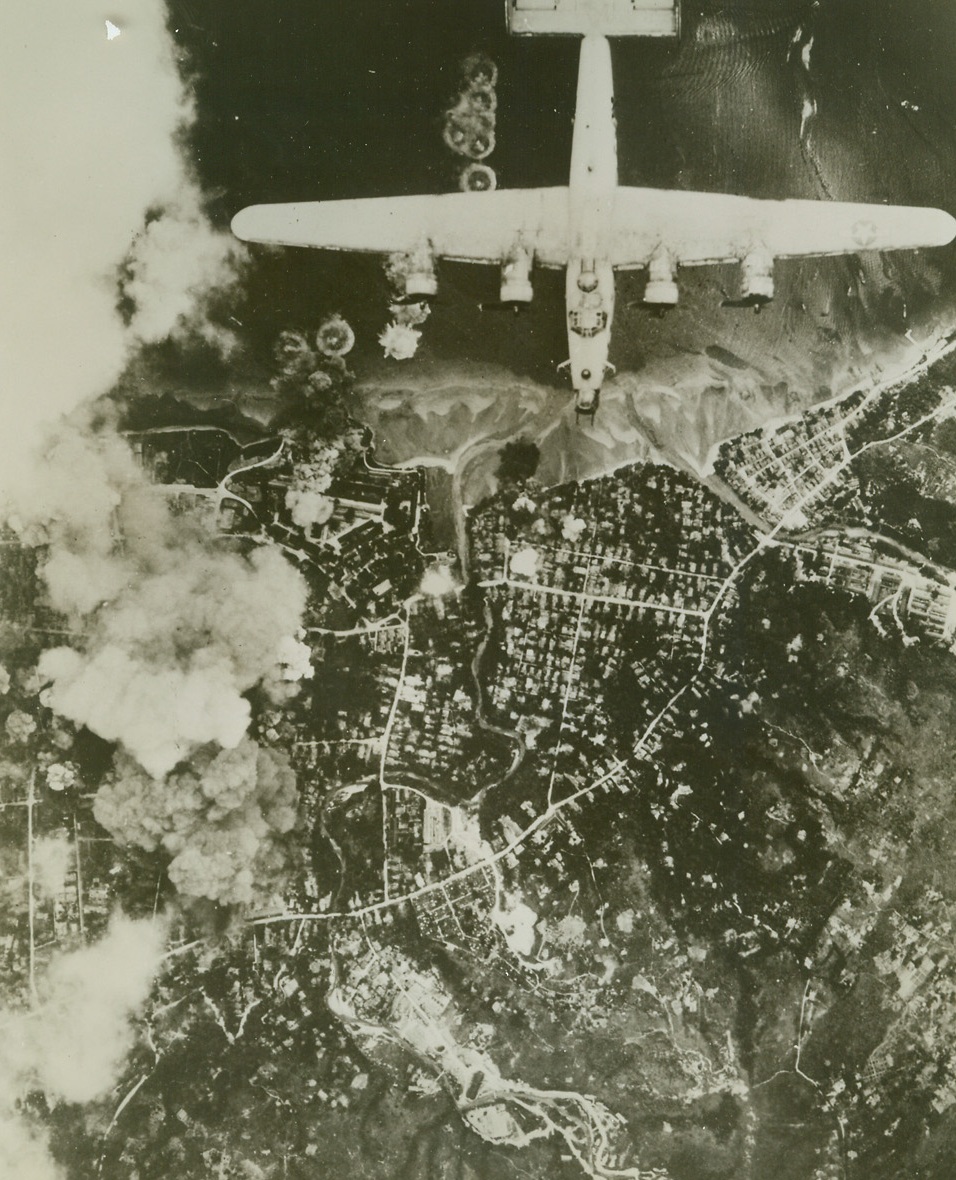
Liberators Blast at Ambon Installations, 9/16/1944. AMBON, CORAN, NETHERLANDS INDIES – As smoke rises from bombed Jap installations, a Far Eastern Air Force Liberator wings its way over the enemy-held town of Ambon on the island of Ceram in the Netherlands Indies. Shipping in the harbor as well as fortifications on the mainland suffered during the large scale bombing attack. As the raiders headed back for their home base, smoke from the hits was rising to a height of 10,000 feet.Official USAAF Photo from ACME;
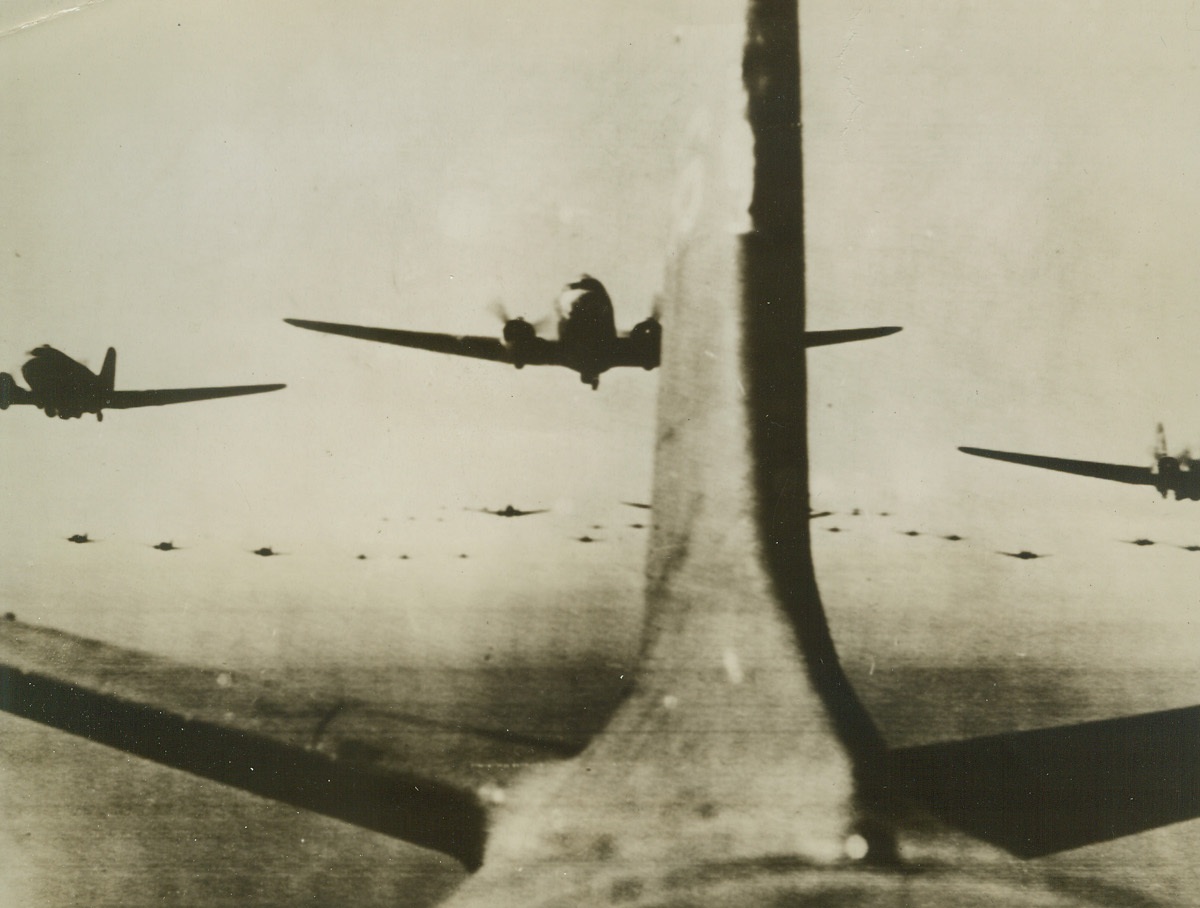
They’re on Their Way!, 9/18/1944. EN ROUTE TO HOLLAND – Roaring toward Holland for the surprise airborne invasion that made supermen quake, troop-carrying planes stretch across the European sky, as far as the eye can see. This was just part of the giant sky train that brought thousands of liberators to Dutch soil.Credit (Army Radiotelephoto from ACME;
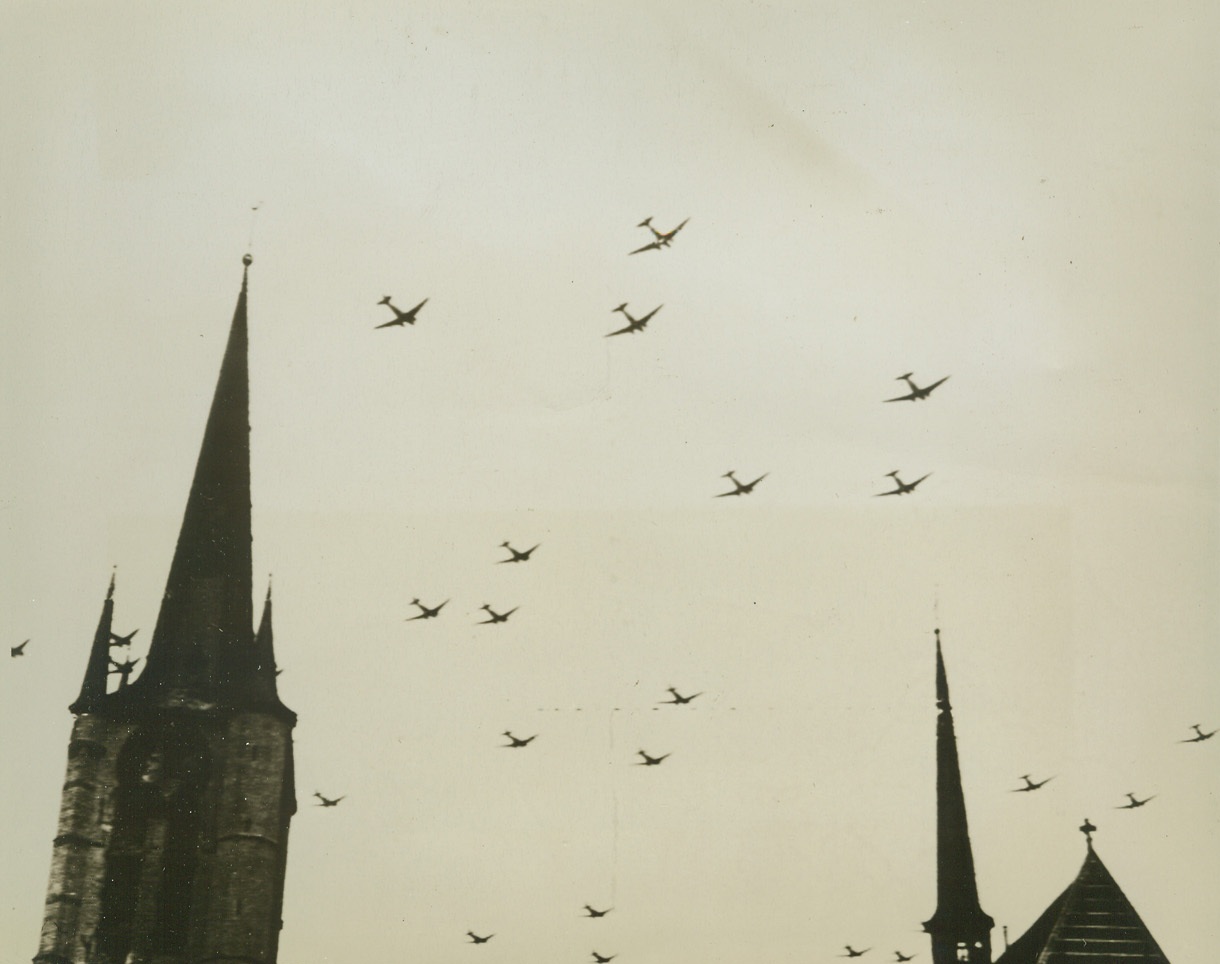
Sky Troops Over Belgium, 9/18/1944. GHEEL, BELGIUM – Like a fleet of black birds, Allied troop carriers roar over the spires of Gheel, en route to the “drop” area in Holland. Staging the surprise airborne invasion of September 17th, these warbirds were only a small part of the vast armada that sent thousands of Allied warriors into the lowlands. Credit (British Official Photo Via U.S. Signal Corps Radiotelephoto from Acme);
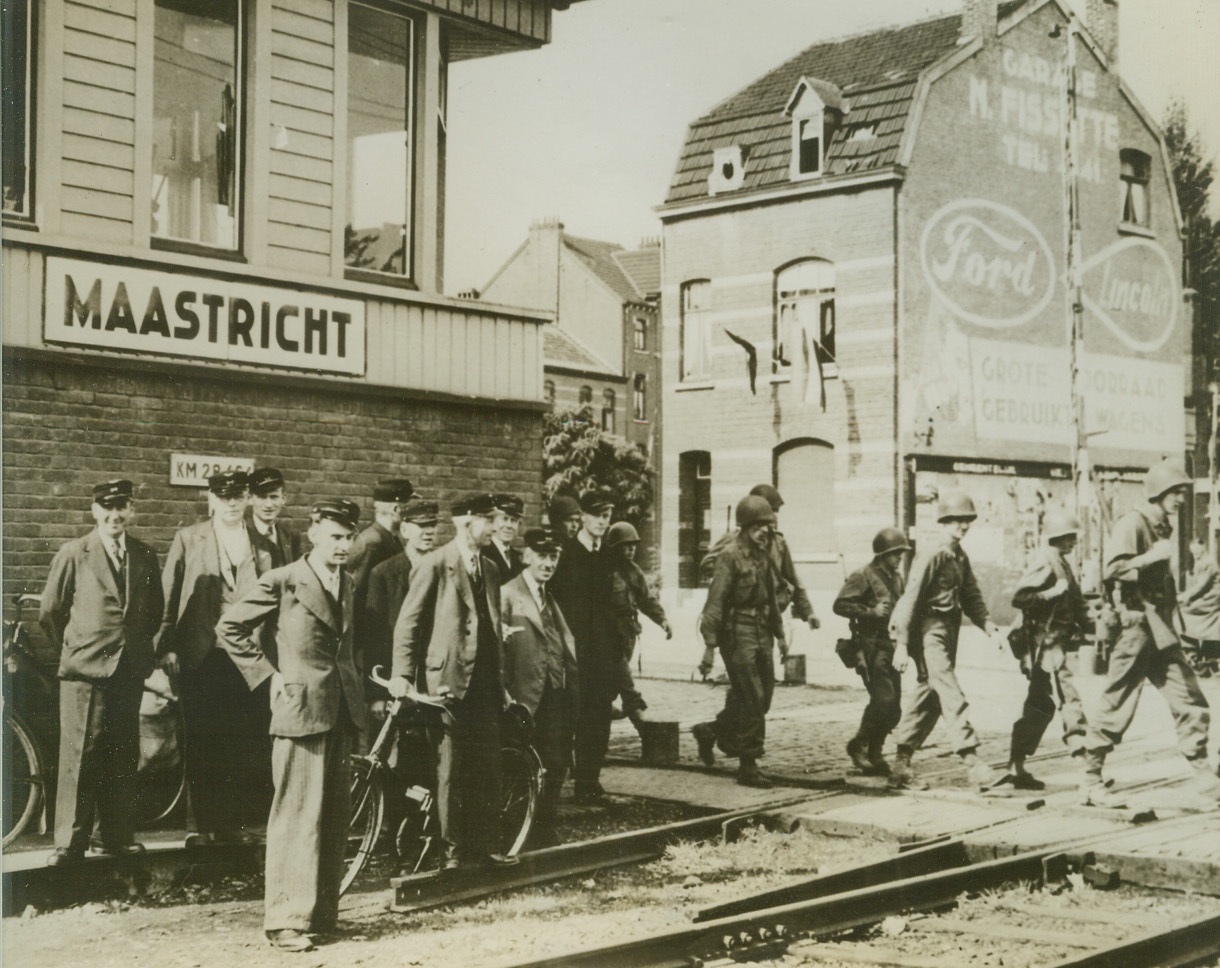
Yanks Tramp Thru First Free Dutch City, 9/22/1944. MAASTRICHT, HOLLAND – Smiling citizens of the ancient Dutch city of Maastrict, the first of Holland’s cities to be liberated by the Allies, watch American soldiers tramping across the local railroad tracks. First Army units, under the command of General Hodges, entered the city on September 14th.Credit Line – WP – (Acme);
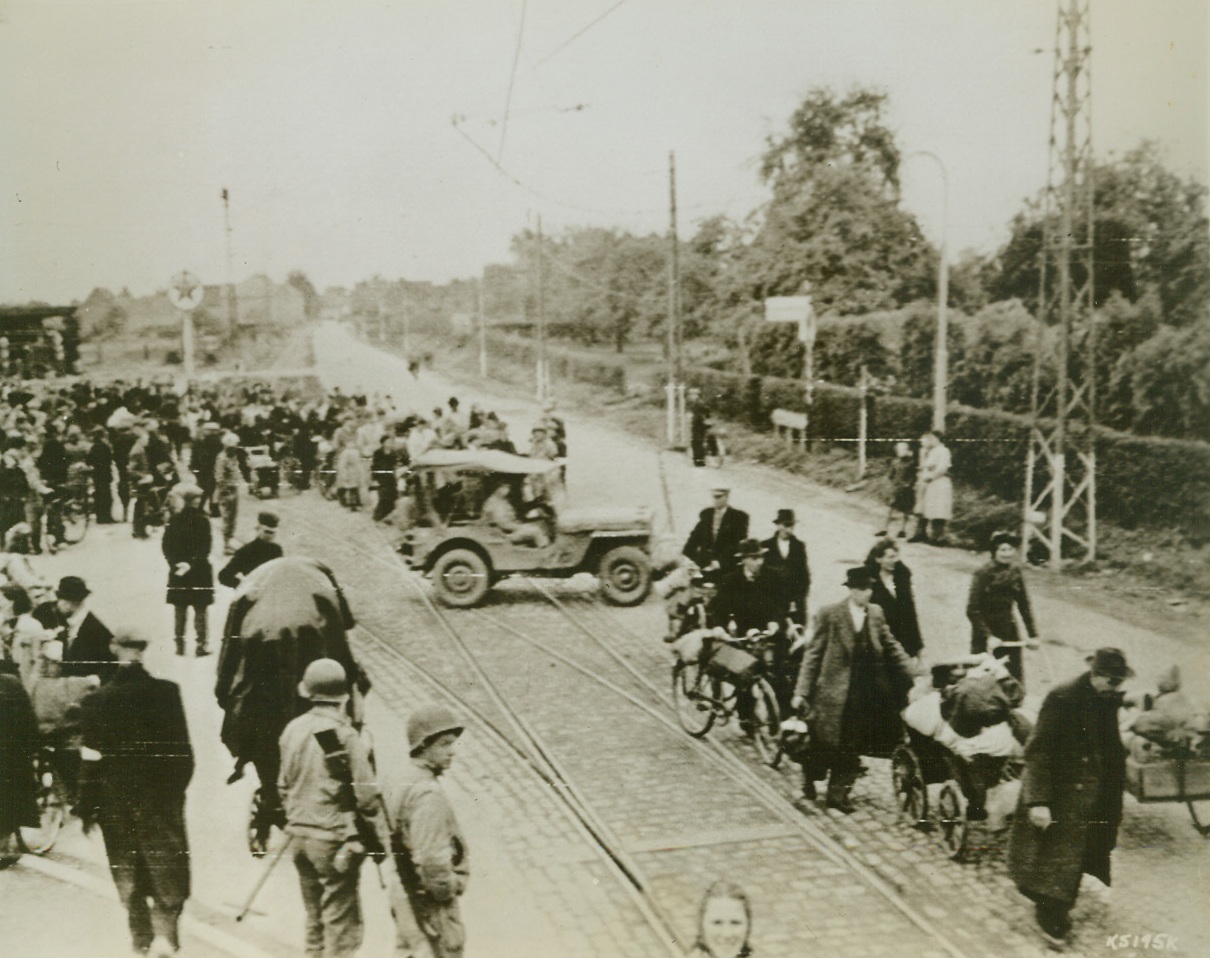
Hollanders Flee Homes, 9/7/1944. Carrying all of the belongings possible, civilians flee the town of Kerkrade, Holland, to escape the flame of battle.Credit Line (Army Radiotelephoto from Acme);
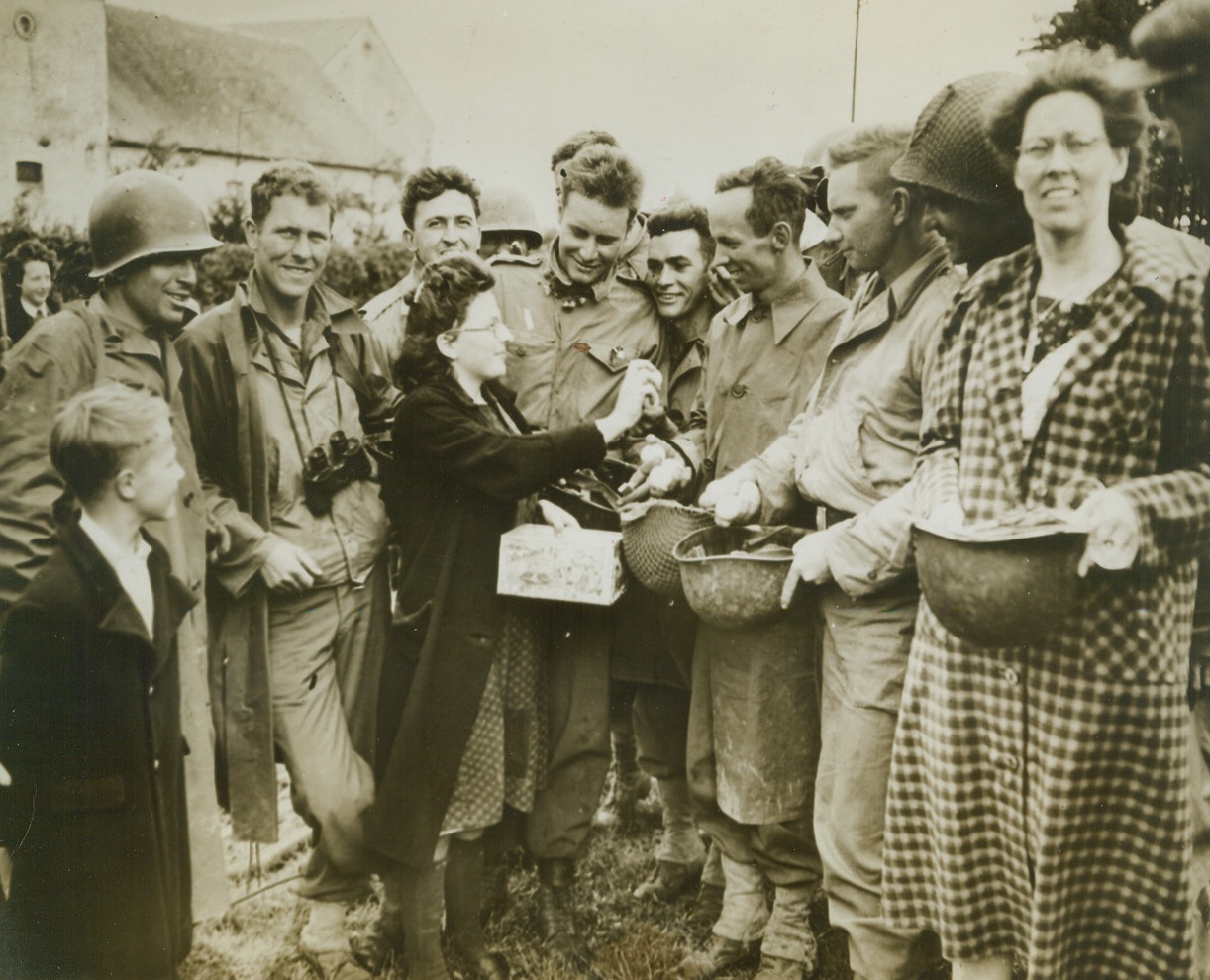
Yanks in Belgium Get Eggs – Whole, 9/6/1944. BELGIUM – Happy villagers of Forge Philippe in Belgium shower American forces with gifts of eggs, chocolate and flowers after their swift advance had carried them across the Belgian border from France. Nazis retreat with ever-increasing speed before our relentlessly advancing forces.Credit – WP – (Acme);
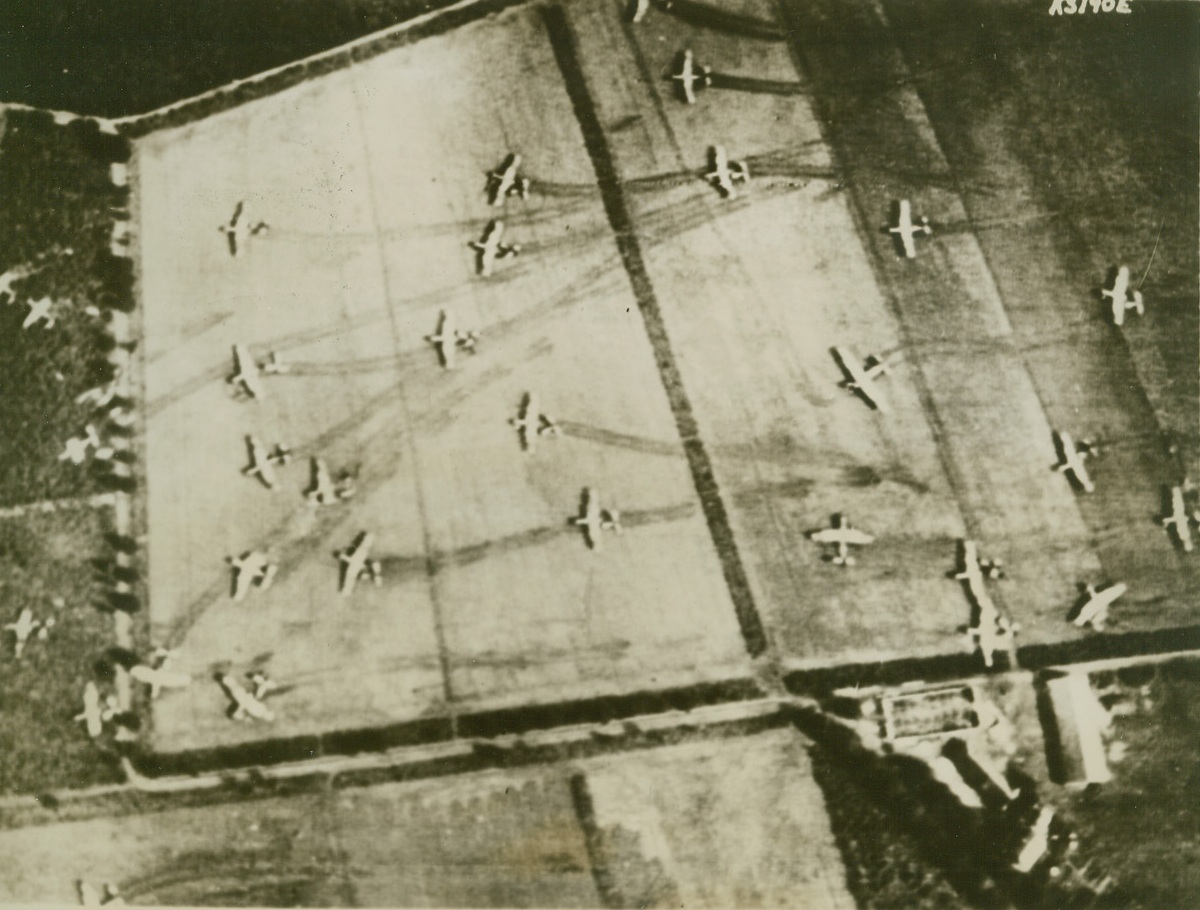
Gliders Land Invaders in Holland, 9/19/1944. HOLLAND – These gliders rest on a field in Holland after successfully performing their mission of landing Allied troops in the air-borne invasion that began on Sept. 17. Credit (British Official Photo via Army Radiotelephoto from Acme);
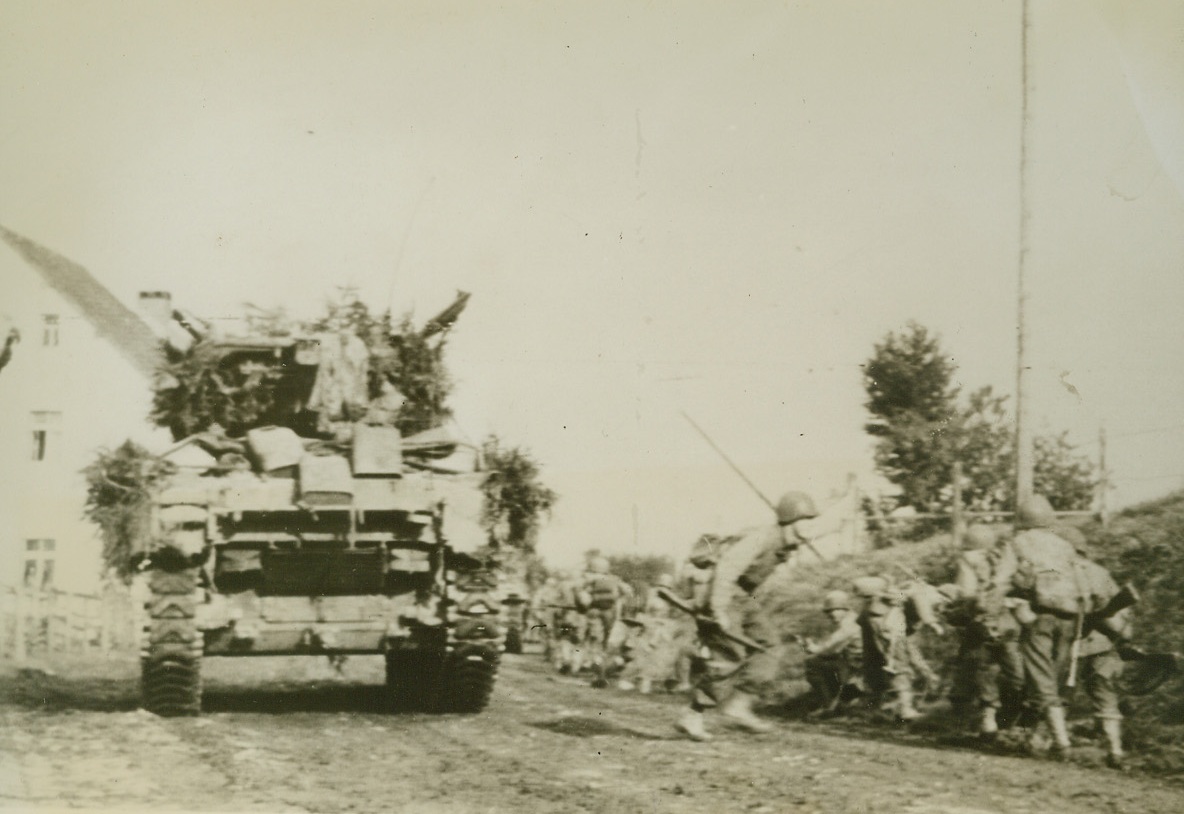
Safety is Where you Find It. 9/19/1944. GERMANY – Yank infantrymen run from behind a tank under a hail of Nazi bullets seeking cover of embankment. Troops were part of huge force now fighting inside Germany. Credit (Army Radiotelephoto from Acme);
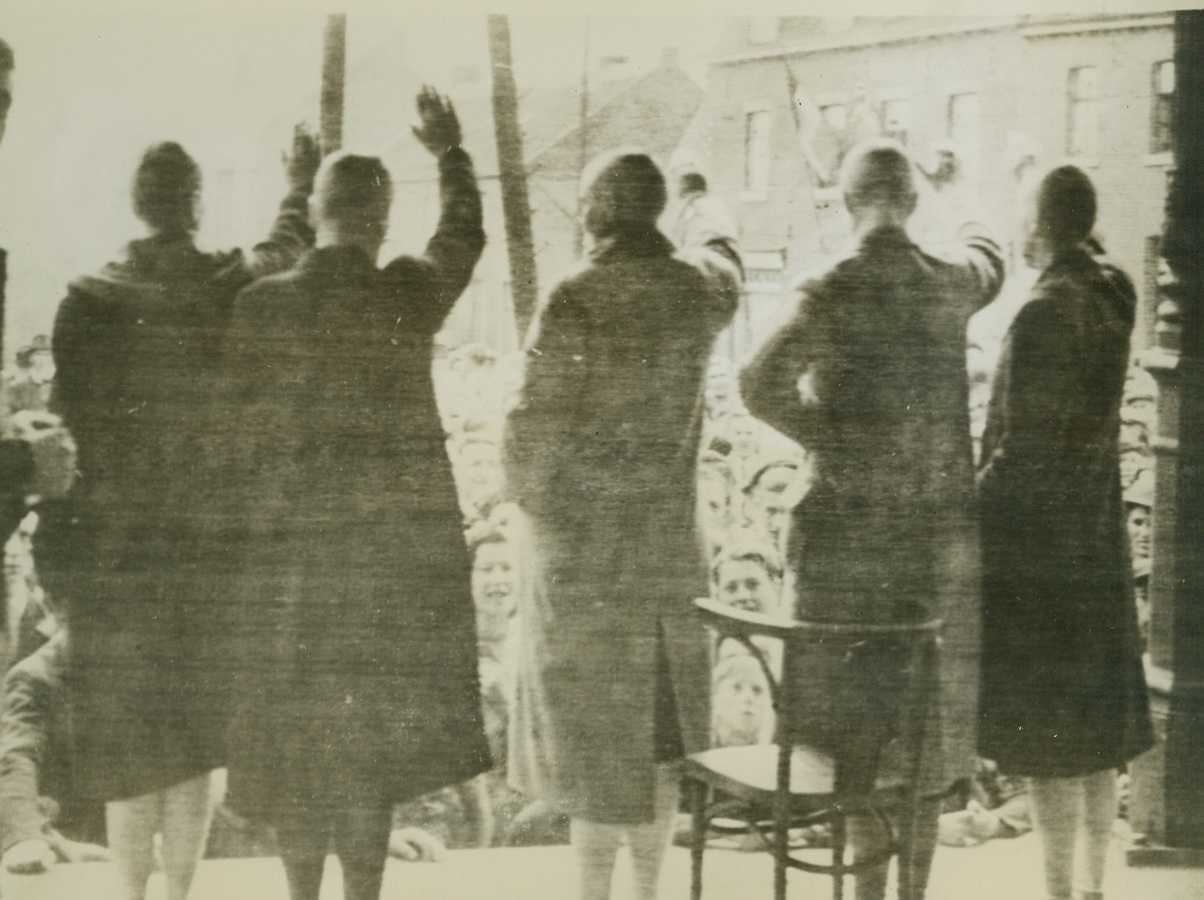
The Price of Collaboration, 9/19/1944. BELGIUM – Belgian women, their heads shaved bare, paid the price of their collaboration with the Germans during their Occupation of Lanaken. For good measure they are forced to give the hated Nazi salute before crowds of jeering countrymen.Credit (Army Radiotelephoto from Acme);
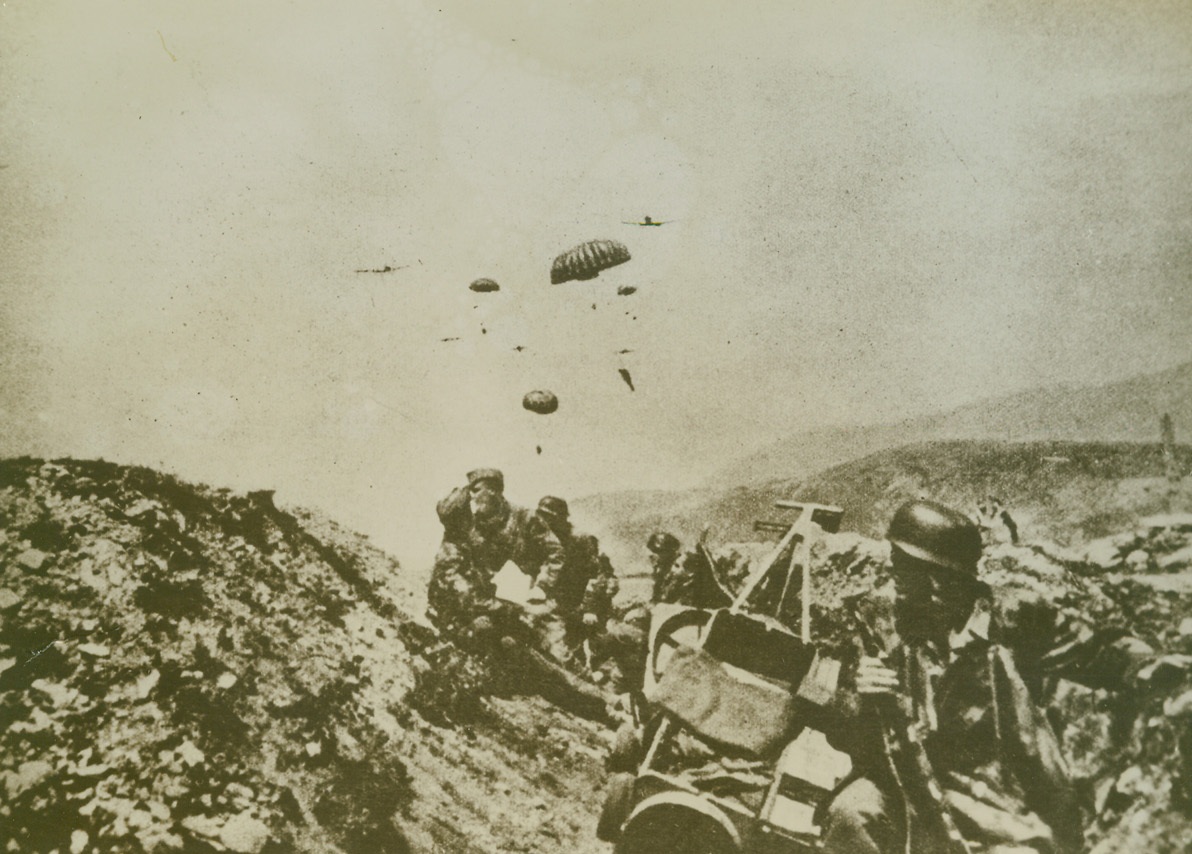
Nazis Attack Tito’s Headquarters, 9/20/1944. YUGOSLAVIA – A second group of German airborne troops bales out to reinforce the force already in action against Marshal Tito’s headquarters during the spectacular but vain effort made to capture the Yogoslav Partisan leader. The coup failed though several of the Marshal’s staff and two visiting Allied war correspondents were taken. This first picture of the German raid was received through a neutral source.Credit Line (Acme);

Sunday Bus in Holland has Horsepower (Alive), 9/20/1944. According to the German caption accompanying this photo received from a neutral source, Amsterdam bus service on Sundays is provided by these two-horsepower coaches. With the enemy’s acute fuel shortage at the front the horse-drawn buses are probably the only public transport service in HollandCredit Line (Acme);
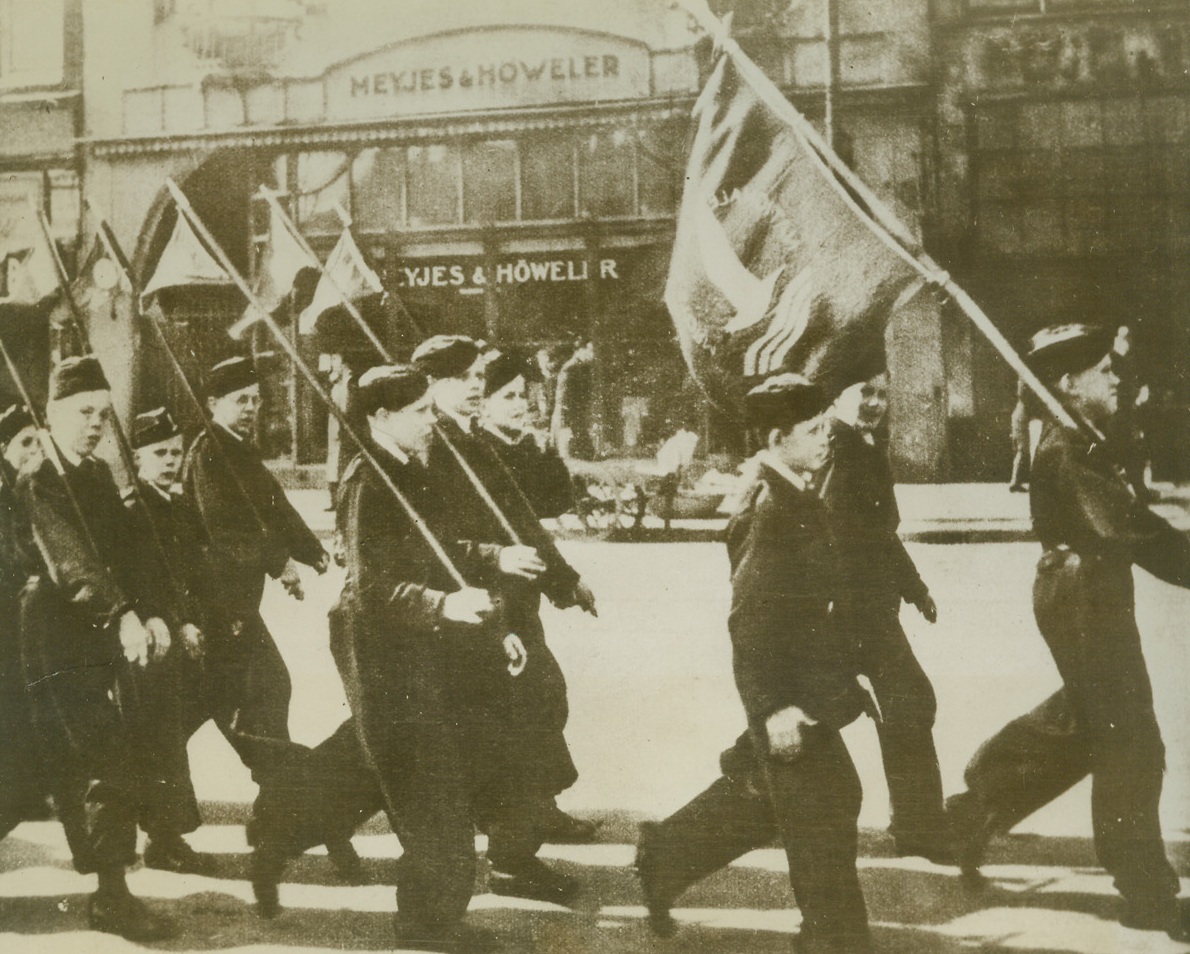
Dutch Youth Trained in Nazi Style, 9/20/1944. According to the German caption which accompanied this photo received through a neutral source the parading boys are members of the Dutch “Jeugdstorm.” They are marching with banners flying through the streets of Amsterdam.Credit Line (Acme);
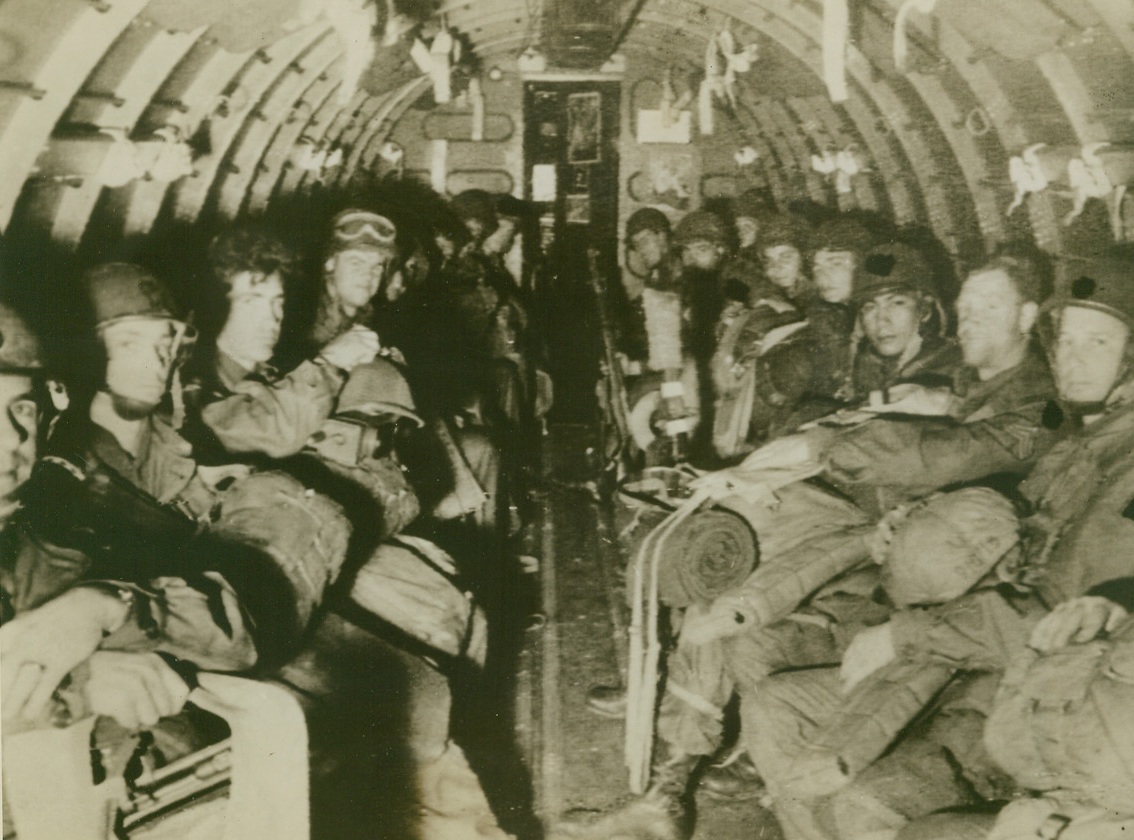
They’re Off!, 9/18/1944. EN ROUTE TO HOLLAND – Looking tough enough to star in a Nazi nightmare, each man heavily laden with equipment, officers and men line the sides of a C-47 and wait to reach their destination. All members of the First Allied Airborne Army, the fighters dropped to Dutch soil to confuse and trap thousands of German soldiers.Credit (Signal Corps Radiotelephoto from Acme);
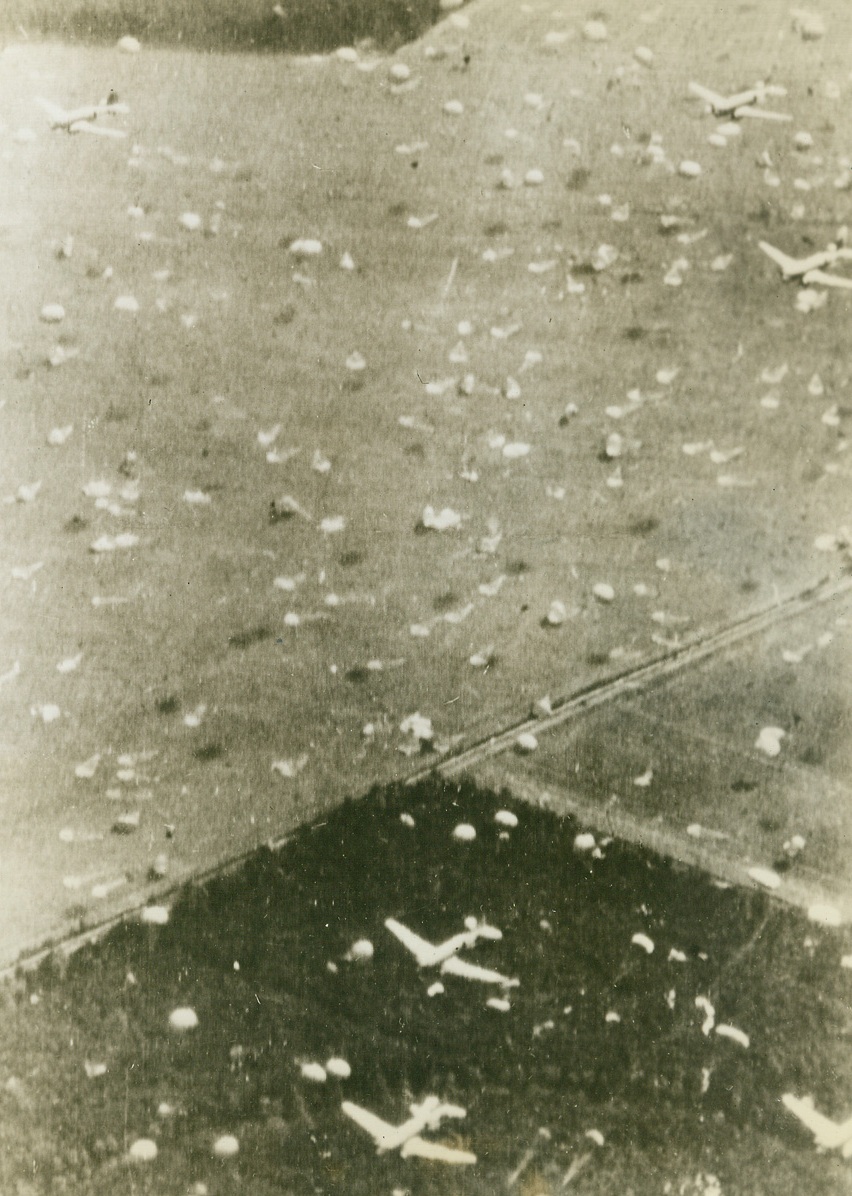
Invaders ‘Chute Down in Holland, 9/19/1944. HOLLAND – Parachutes fill the air as Allied aircraft drop more troops and supplies over Holland. The ground is still sprinkled with parachutes and gliders from the first day’s operations.Credit (British Official Photo via Army Radiotelephoto from Acme);
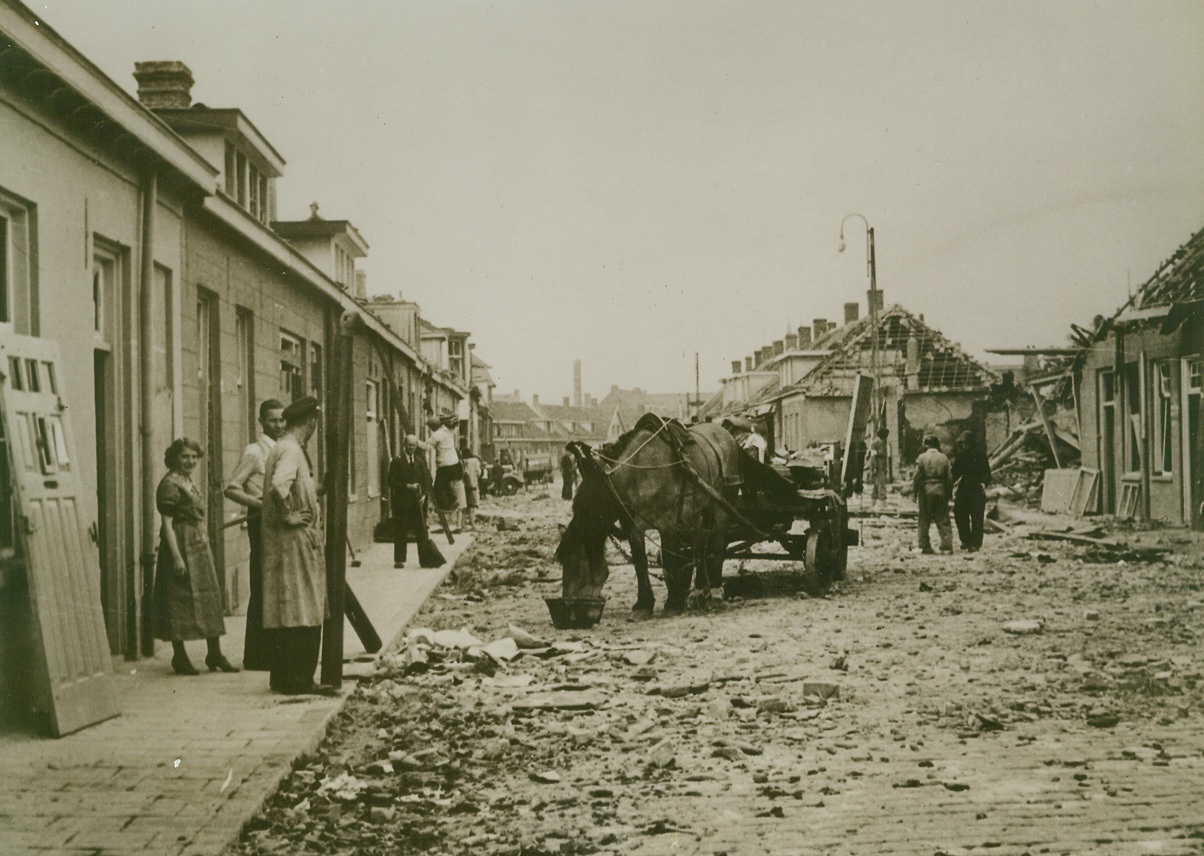
After Nazi Air Raid, 9/28/1944. HOLLAND – Debris from smashed houses litter the streets of Eindhoven, after the Luftwaffe raided the city Sept. 19, in a futile attempt to block further progress by Allied forces passing through in pursuit of the Nazis. Credit Line (British Official Photo from Acme);
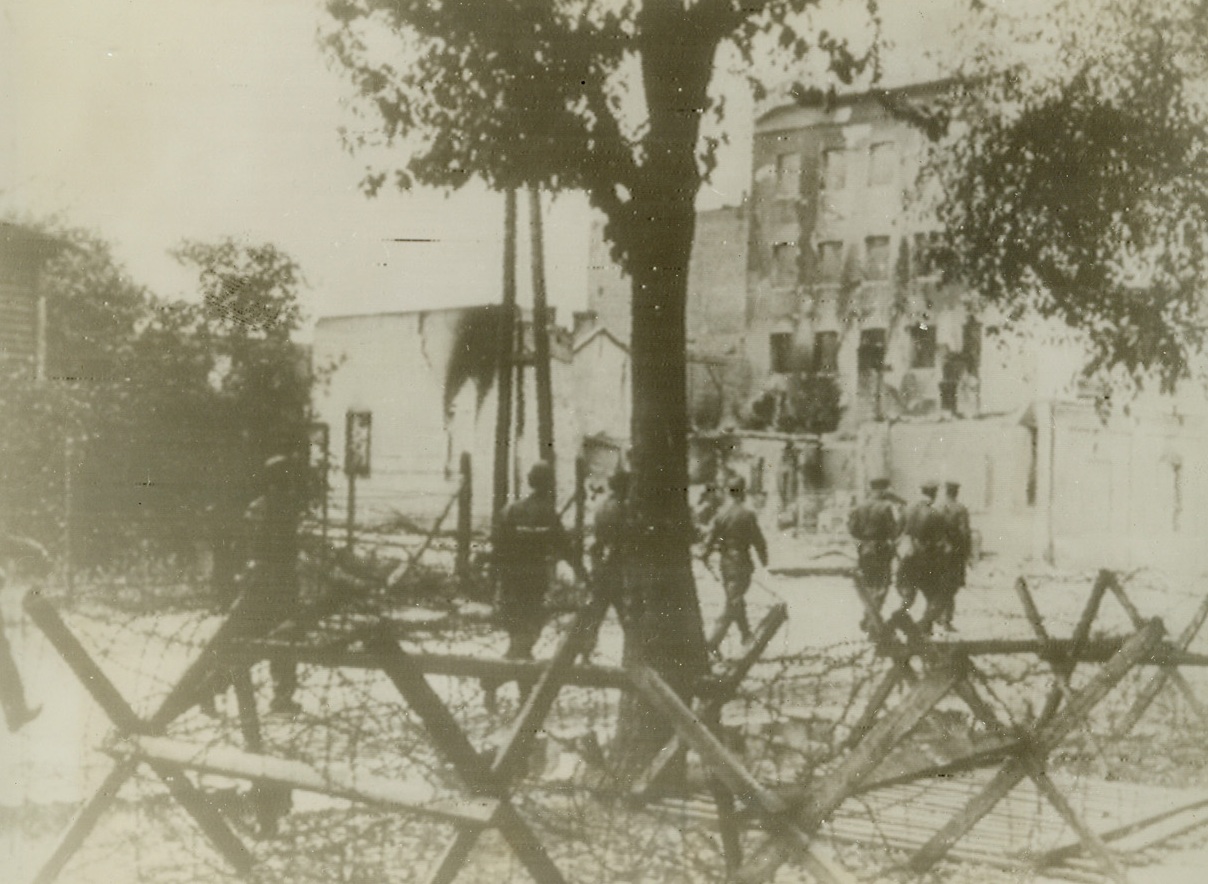
Polish Patriots Revolt in Warsaw, 9/2/1944. According to the German caption on this photo, radioed today (September 2) from Stockholm, German soldiers march past barbed wire barricades as they seek Polish patriots who are participating in the revolt within Poland’s capital. As the fighting continues, the Polish government appeals to the Allies for aid in wrestling the capital from the Nazis.Credit (Acme Radiophoto);
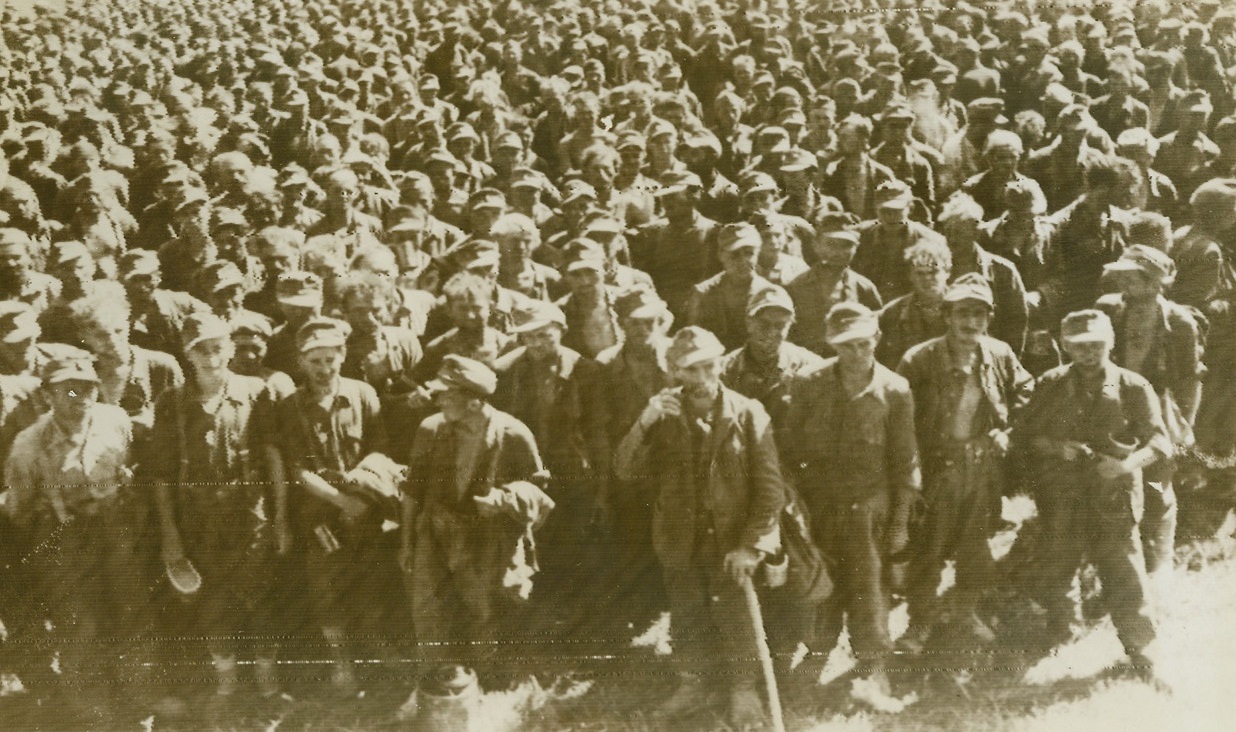
Round-up in Romania, 9/10/1944. ROMANIA—A horde of German prisoners, part of the thousands captured as the Russian Balkan drive engulfed Romania, stand with mess kits in hand waiting for chow at an unidentified locale in Romania.Credit (Acme Radiophoto);
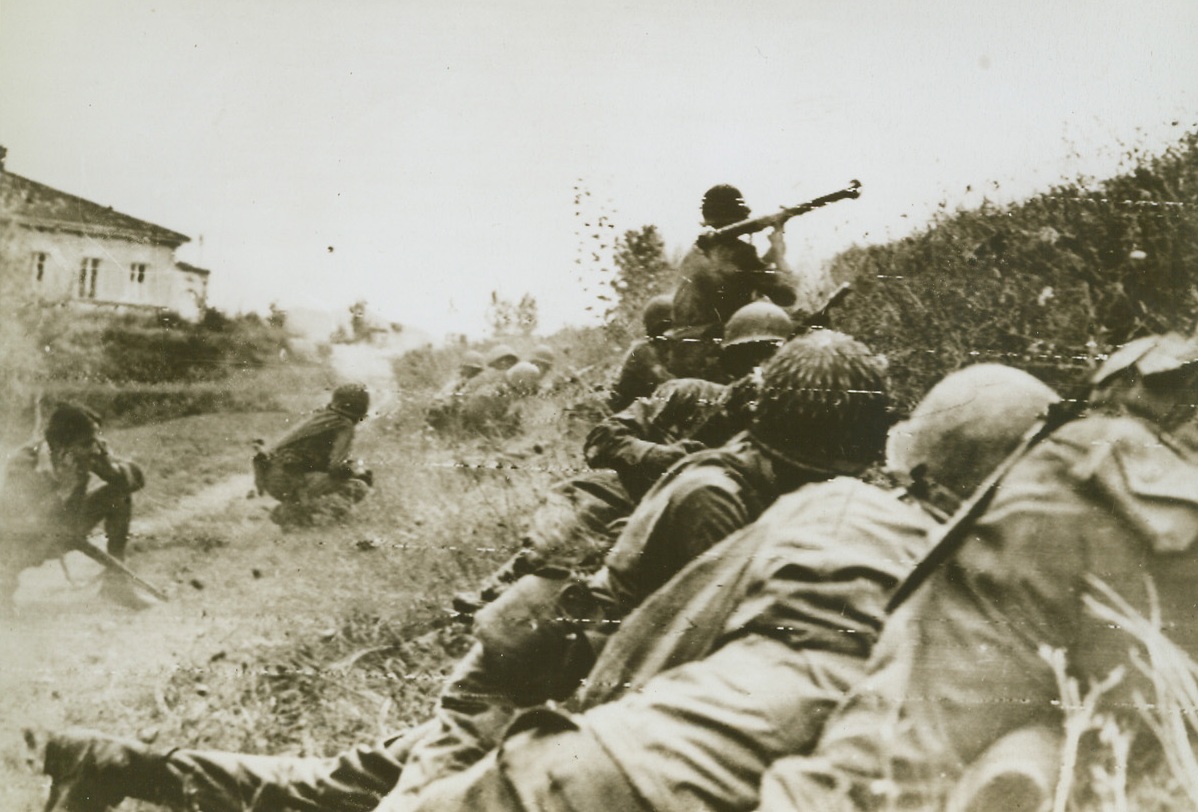
Ninety-Second Lets ‘Em Have It, 9/10/1944. ITALY – Fighting in the most distant position yet reached by Yank troops in Italy, a combat patrol of the all-Negro 92nd Division strikes at an enemy machine gun nest. An Italian partisan (extreme left) crouches and holds his ears as a bazooka shell screams toward the enemy position.Credit (Signal Corps Radiotelephoto from Acme);
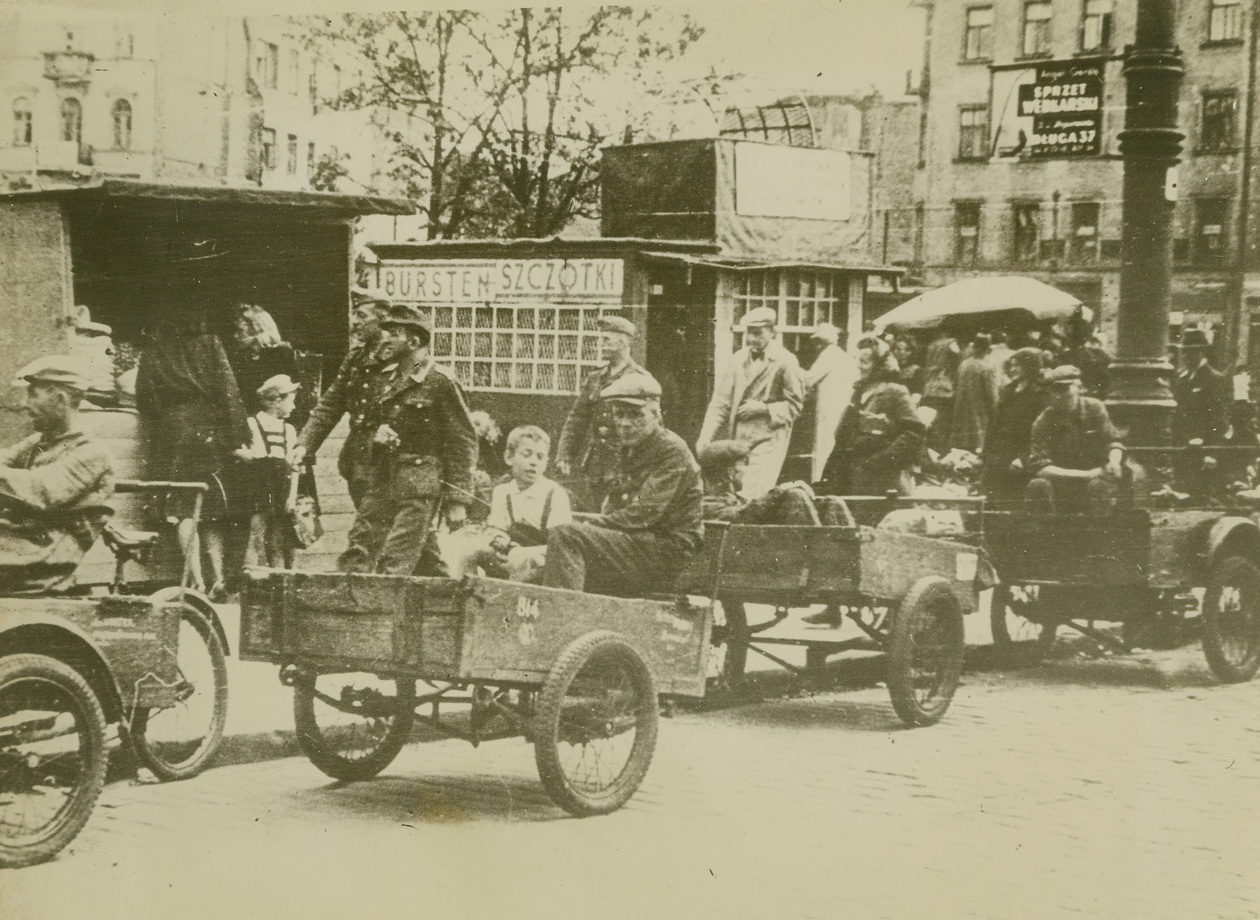
Warsaw Taxis Foot Propelled, 9/20/1944. German soldiers strut down a street in Warsaw while humble bicycle-taxi drivers await hails from Poles who have goods to transport from one part of the city to another. At left two women examine the meager produce in a sidewalk store. This photo, received from Warsaw through secret channels, has just been released by censors for publication. Credit Line (Acme);
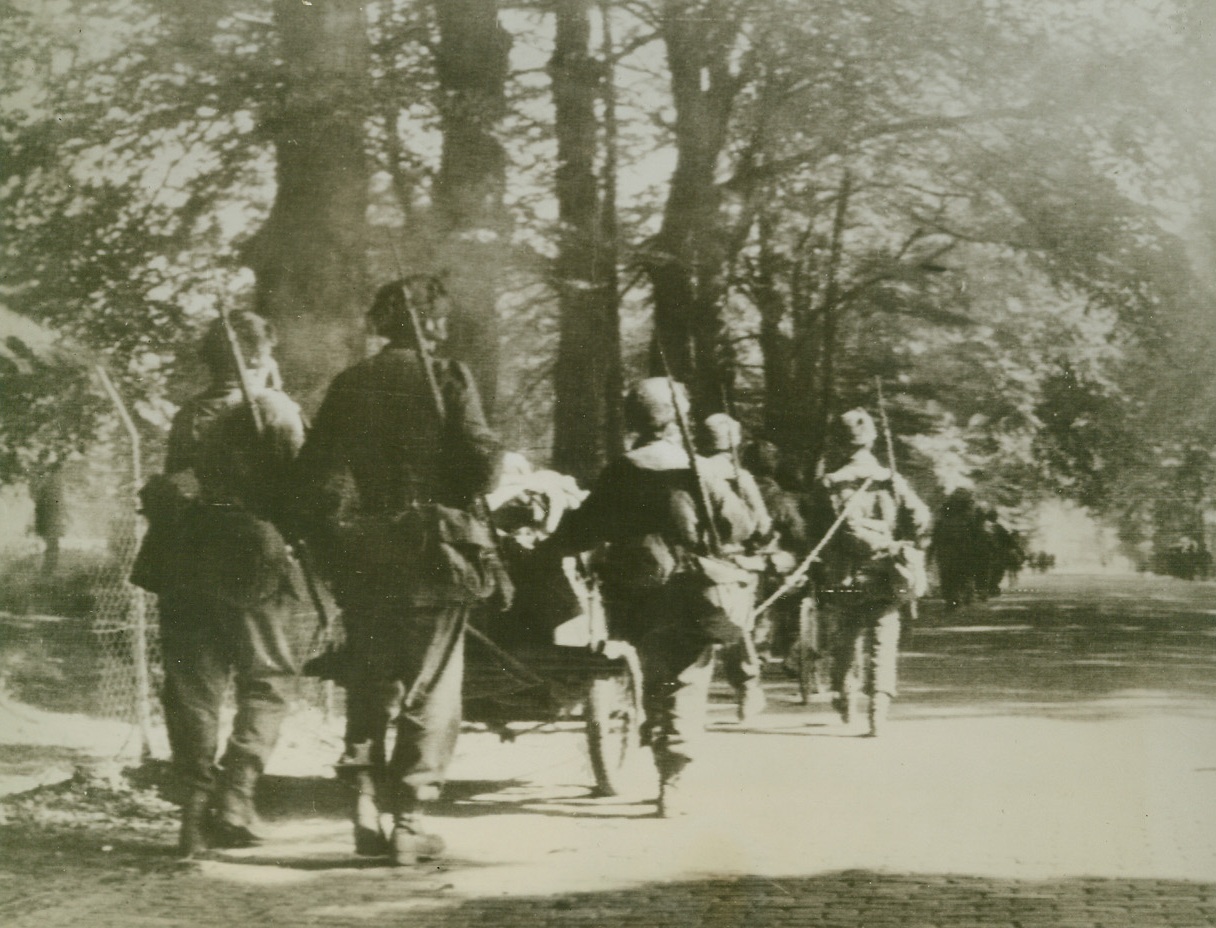
Reinforcements Bound for Arnhem, 9/29/1944. HOLLAND – British paratroopers, who participated in the second landing of the first Allied Airborne Army, advance toward Arnhem. The fighters trundle their armor along in small carts. Credit (British Official Photo from Acme);
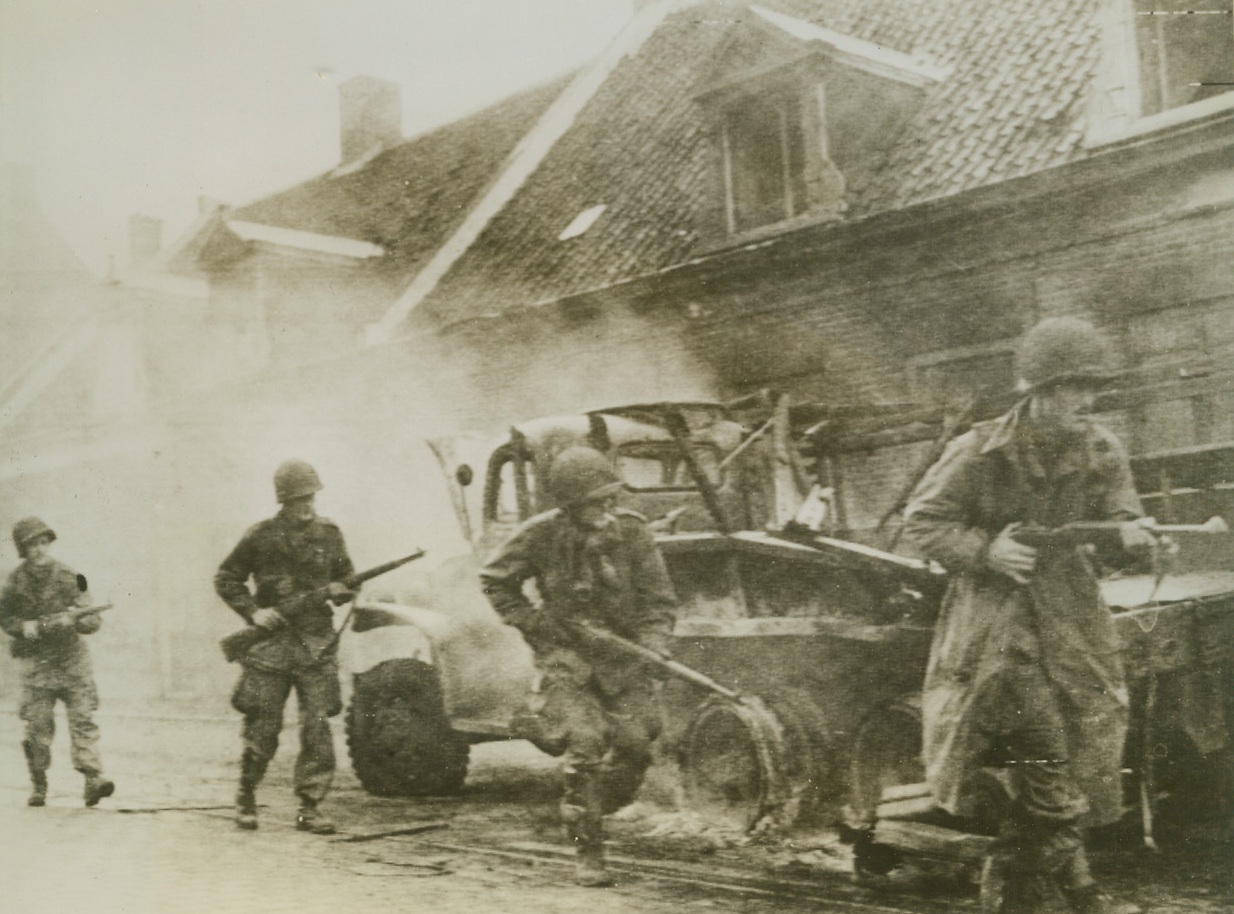
Airborne Infantry Advances in Holland, 9/29/1944. HOLLAND – With guns ready, US Airborne infantry advance cautiously along a street in Holland, moving though a haze of rifle fire, as they pass a burning truck while routing out snipers still lurking in the town.Credit ( Signal Corps Radiotelephoto from Acme);
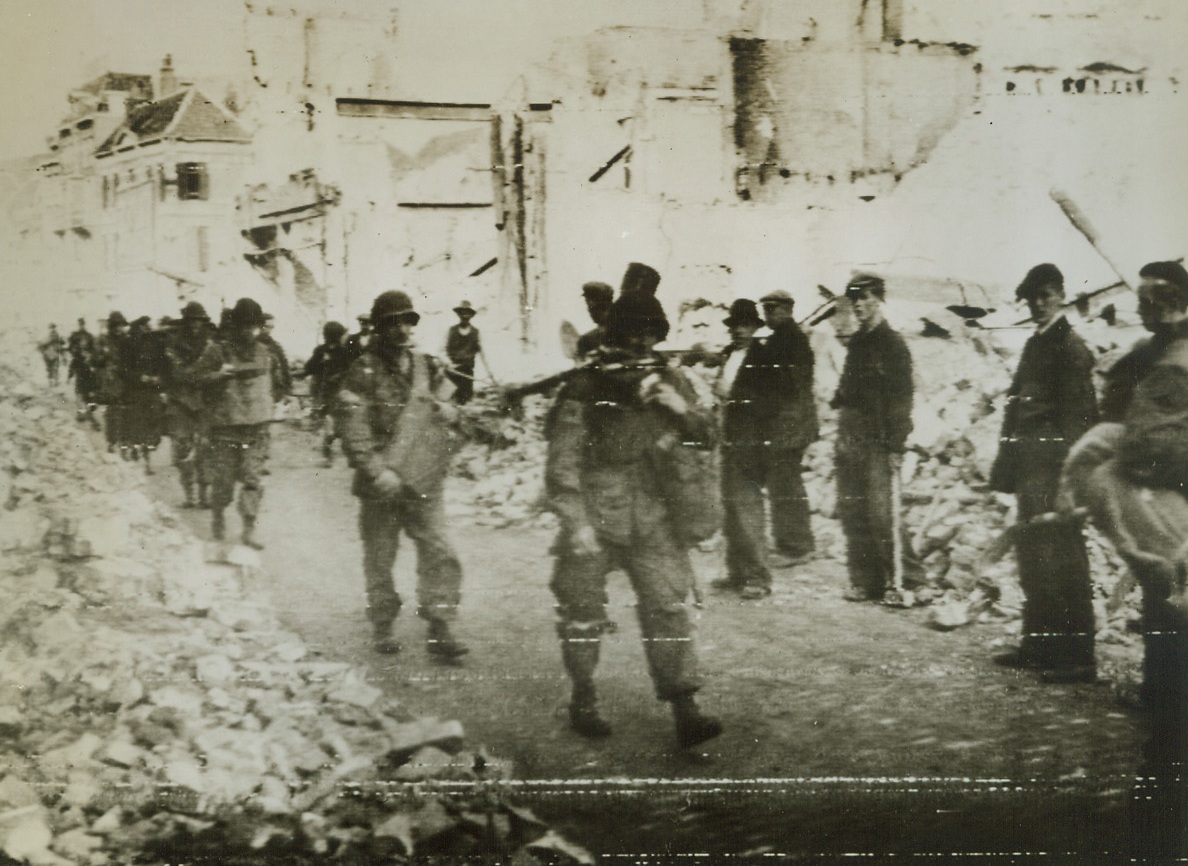
Yank Sky Warriors Return, 9/30/1944. NIJMEGEN, HOLLAND – Civilians stand aside as American paratroopers, returning from the front lines, march through the ruins lining this road in liberated Nijmegen.Credit (Army Radiotelephoto from Acme);
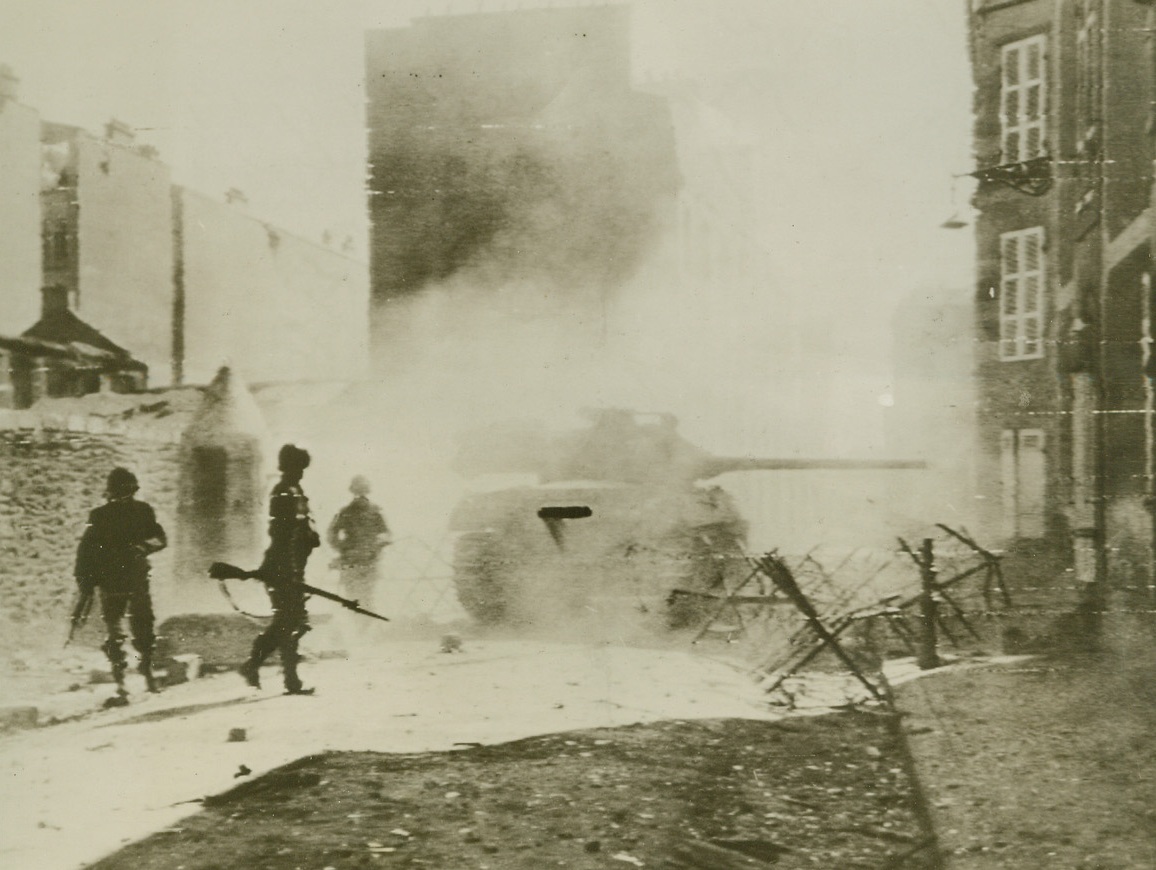
Point Blank Persuasion, 9/18/1944. Brest, France – With neither time nor patience for gentle persuasion, this Yank M-10 tank wins an argument with a Nazi pillbox emplacement in the streets of Brest, with its 76mm gun doing all the talking at point blank range. Behind the smoke-hung vehicle, infantrymen await the signal to advance. Credit (Signal Corps Radiotelephoto from Acme);
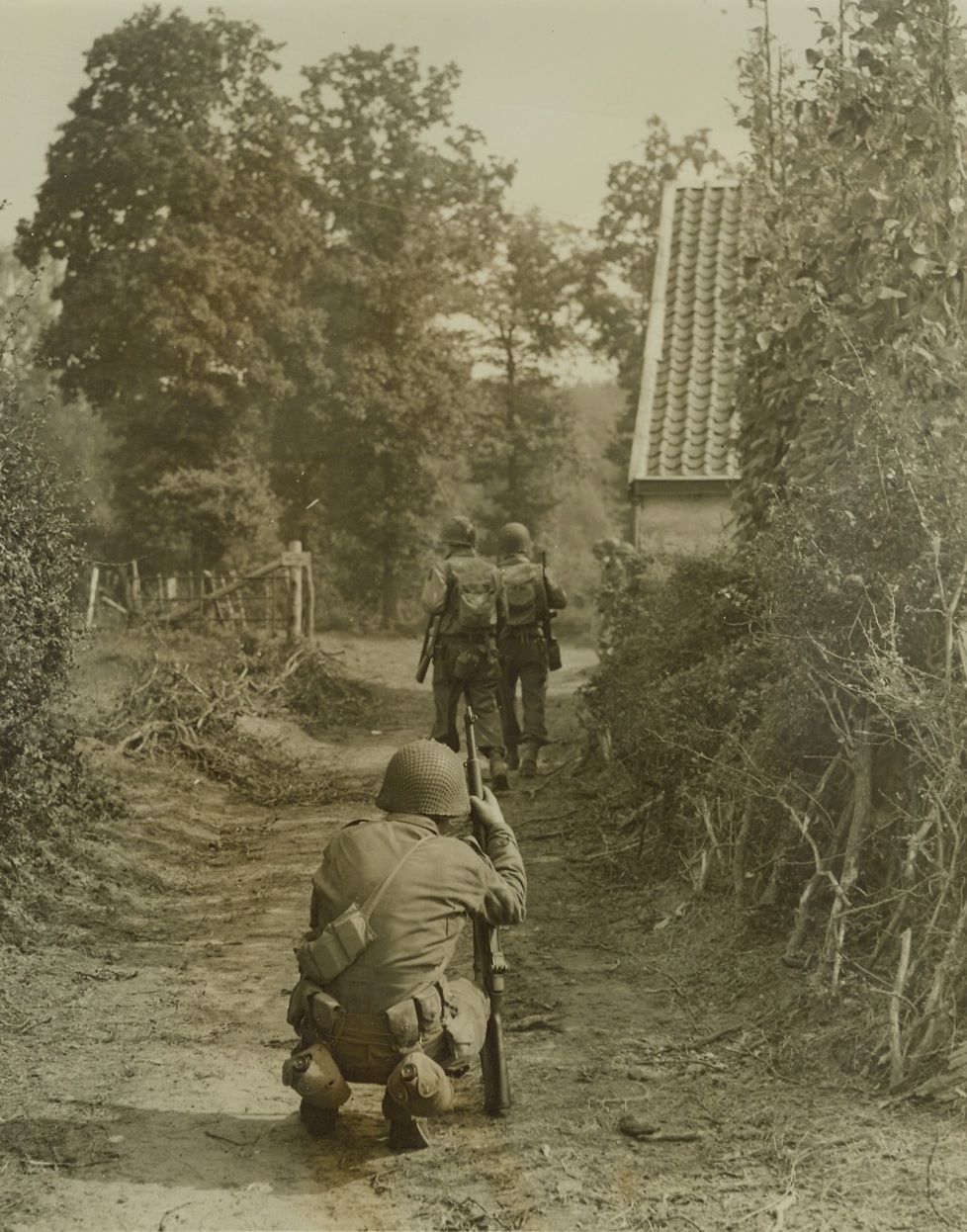
Over the Border, 9/18/1944. GERMANY -- There's no difference in soil, dust, on foliage from one end of this country lane to the other, but the steps that carried the Yanks in background down the path took them into Germany. Squatting behind them, a buddy watches the boys cross the border near Aachen. "Boy, this is what I walked across France and Belgium to see," he said. Credit: - WP- (Photo by Bert Brandt of ACME, for the War Picture Pool);
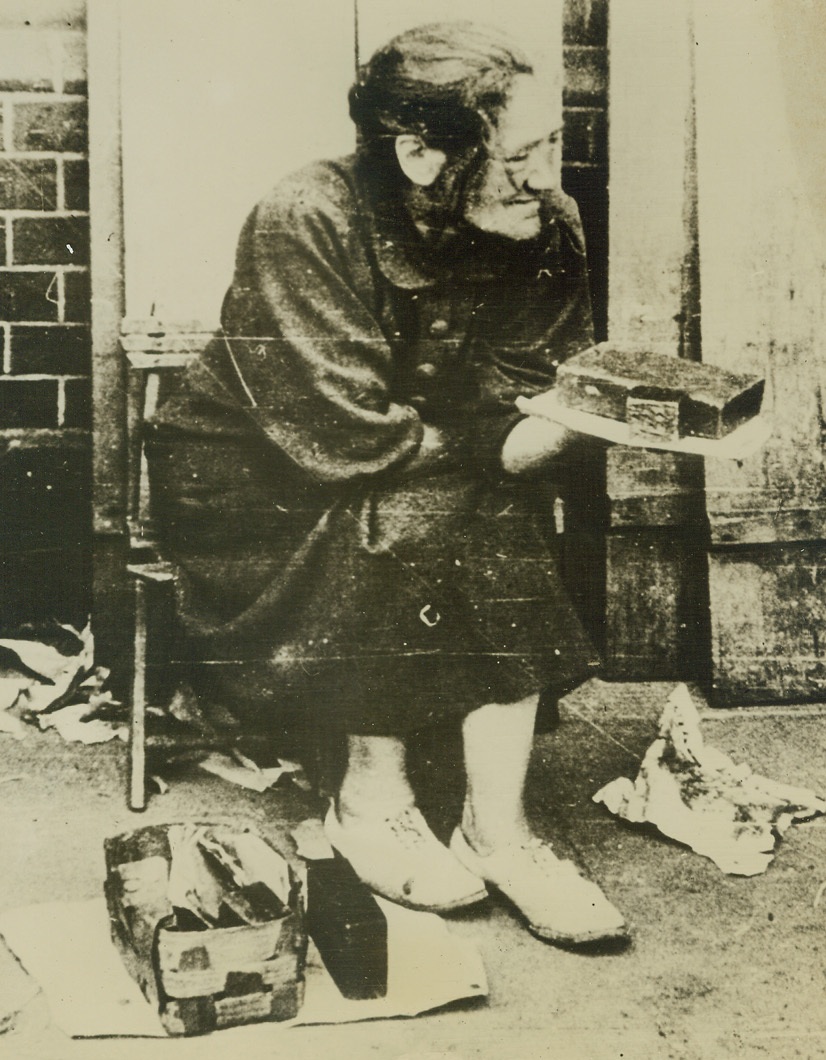
SOAP IS PRODUCT OF WARSAW’S BLACK MARKET, 9/20/1944. An old woman, haggard and worn through self-denial and because of restrictions imposed on the Polish since the Nazi occupation, sits on a wooden chair in an alley to peddle a square of hard, black soap—a product which commands a high price in Warsaw’s extensive black market. This photograph, received from Warsaw through secret channels, has just been released for publication. Credit: Acme;

Marine Landings Heralded by Rockets, 9/26/1944. PELELIU IS. -- In the first pictures released of the new rocket weapons, landing craft of the Pacific Fleet direct rocket barrages against the beaches at Peleliu before invading 1st Division Marines landed on the island. The beach can be seen in the background, engulfed with smoke from rocket hits. Credit (Official US Navy Photo from ACME);
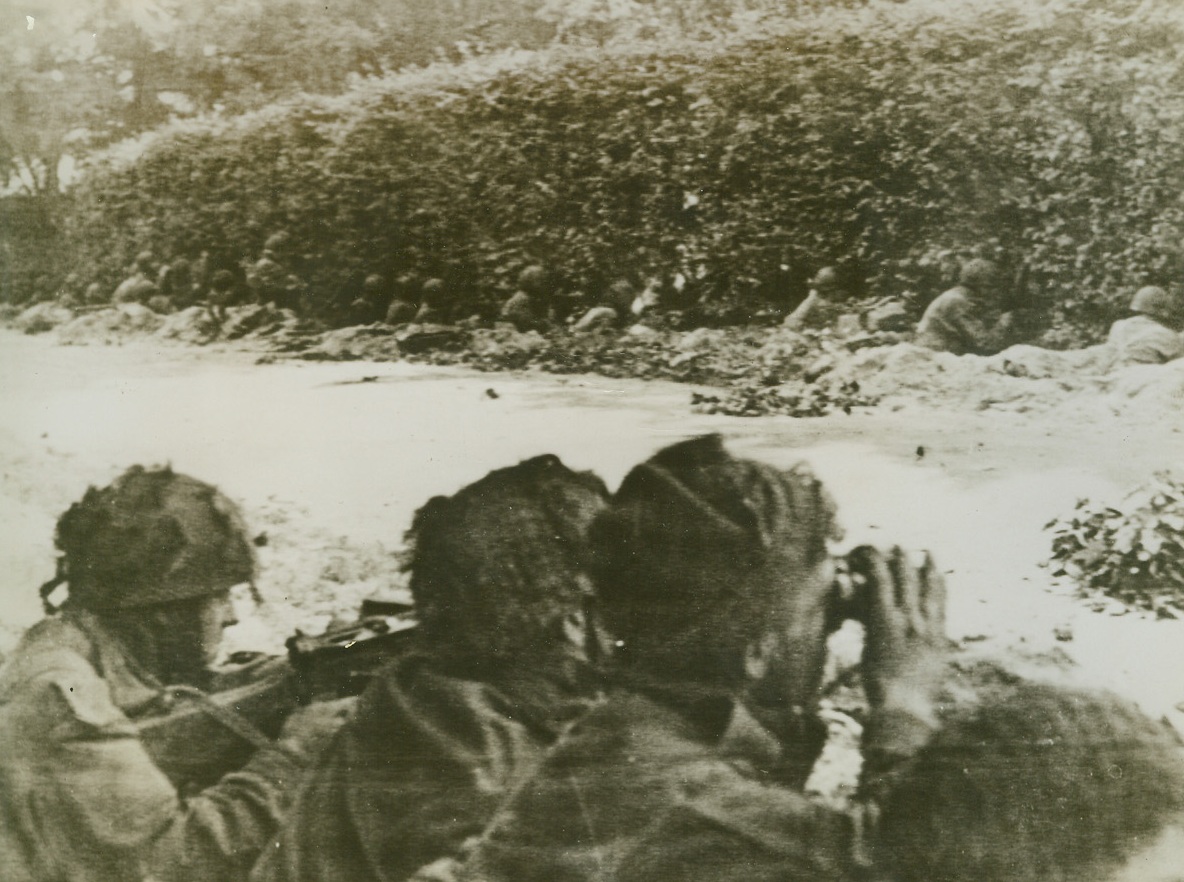
AWAITING NAZI ATTACK, 9/28/1944. British paratroopers of a border regiment wait under the cover of a hedge in Holland to repulse German forces attacking only 100 yards away. Credit: British War Office photo from Acme;
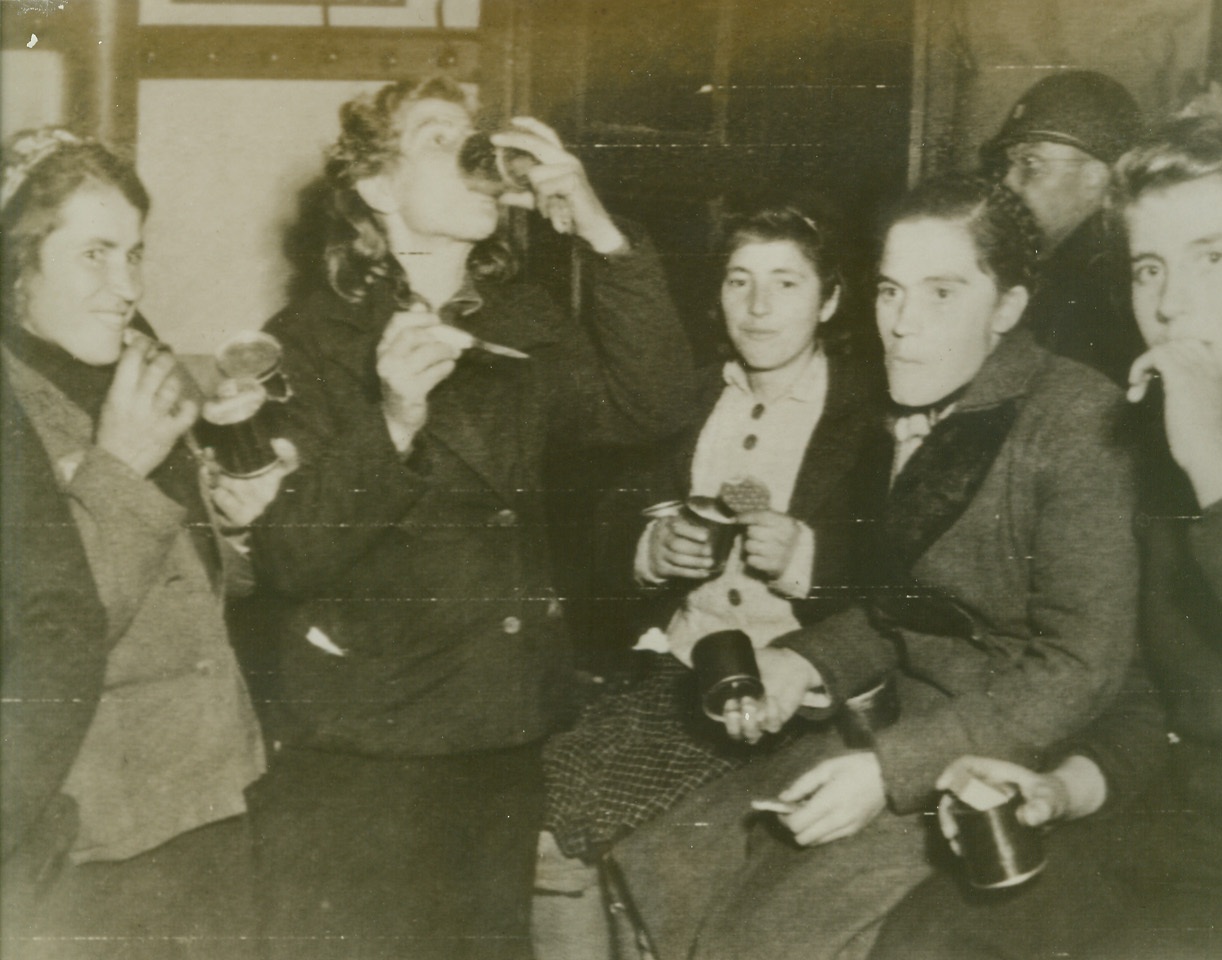
ARMY CHOW FOR GERMAN REFUGEES, 9/28/1944. Refugees from inside Nazi-dominated sectors, sample U.S. Army rations at a depot set up for them by the Allied Military Government. Credit: Army radiotelephoto from Acme;

BRITISH PARATROOPERS CAPTURED AT ARNHEM, 9/28/1944. ARNHEM, HOLLAND—After nine days of holding out against superior German forces in the Arnhem pocket, these British paratroopers, members of the famed “Red Devil” squadron, were finally captured by the enemy.. Their faces clearly reveal the strain of the lengthy battle, when they fought with their small arms against the heavy guns of the Germans. Yesterday, the remaining paratroopers, 2000 of the approximate 8,000 who landed, were released from the trap by British 2nd Army forces. Almost 1,200 wounded were left behind and Germans say 6,400 were captured. Credit: Acme radiophoto;
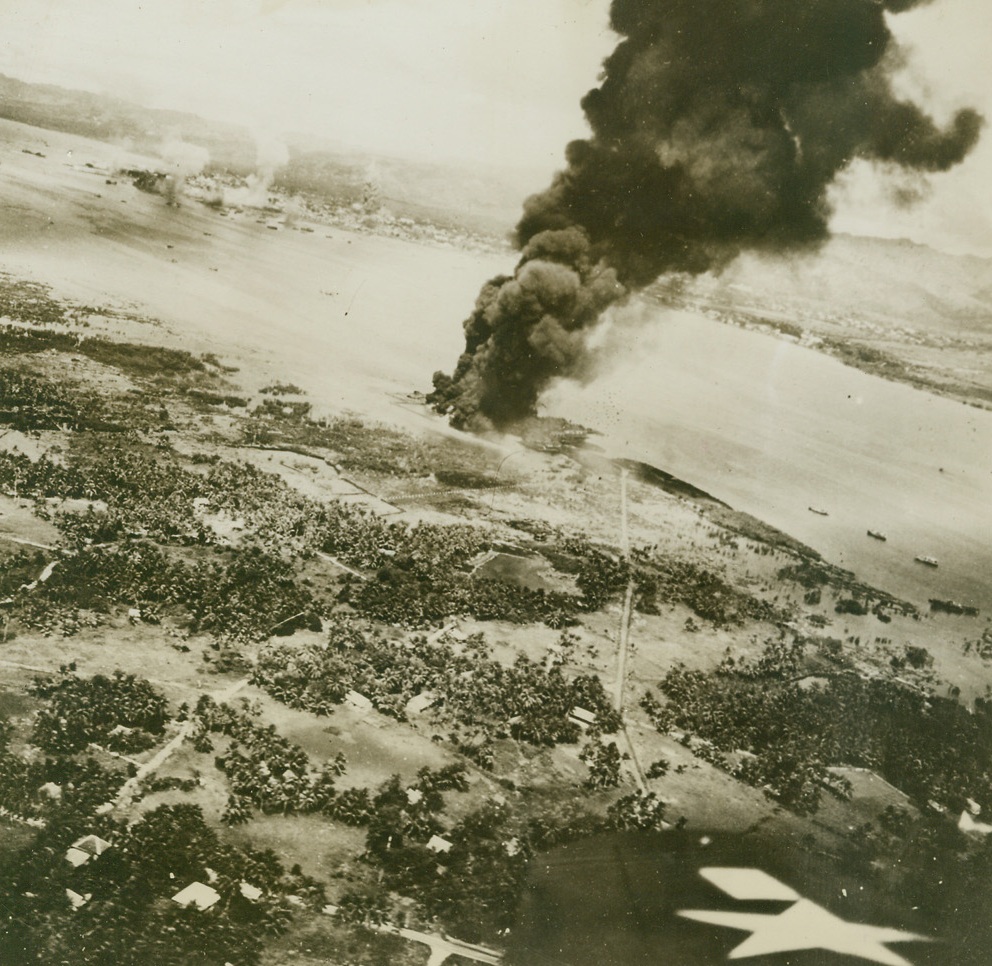
YANKS RETURN TO PHILIPPINES, 9/26/1944. CEBU, PHILIPPPINES—The wing of a Navy plane (right foreground) signifies the return of avenging Yanks to the Philippines, as an oil storage dump at Cebu burns fiercely after carrier planes from Adm. Halsey’s Third Fleet struck at the islands, in the first step of the American drive to recapture the island doors to Japan. Credit (Official US Navy Photo from ACME;
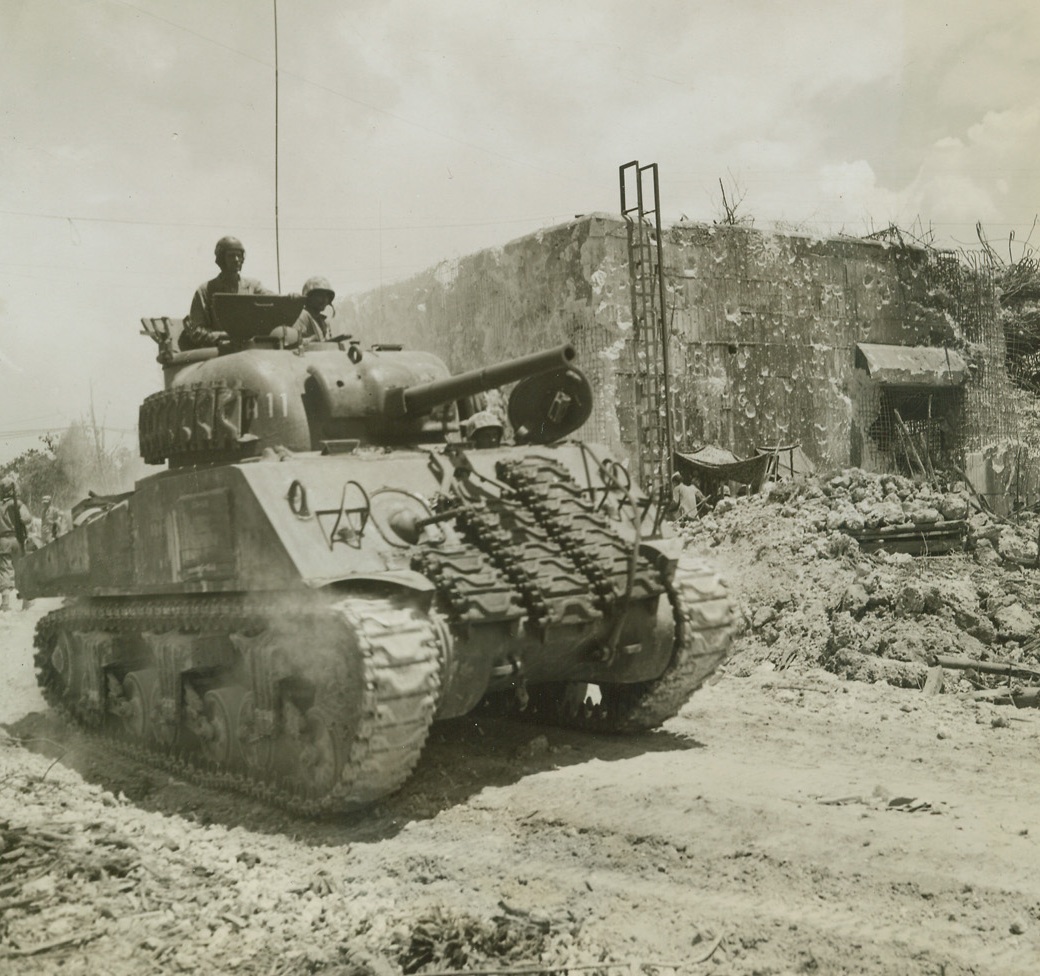
MARINES TAKE OVER JAP BLOCK HOUSE, 9/26/1944. PELELIU IS.—An American Sherman tank rumbles past this Jap blockhouse, filled with gaping shell holes – proof of the number of hits necessary to put defending Japs out of action. This blockhouse is now being used as a First Aid Station by 1st Division Marines on Peleliu. After 12 days of fierce fighting, Marines on the island see complete victory in sight. Credit (ACME Photo by Stanley Troutman, War Pool Correspondent);
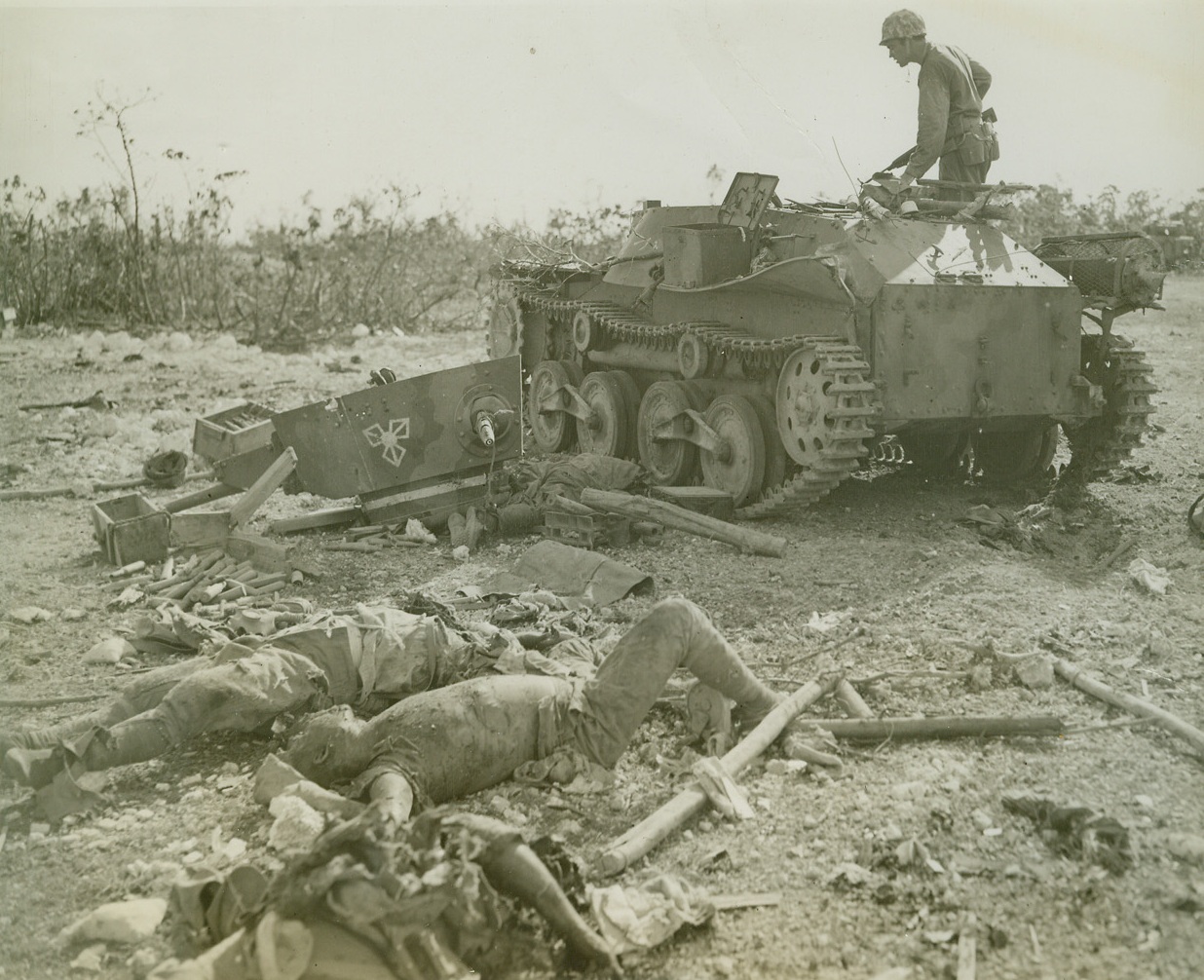
JAP TANKMEN SLAIN IN BLOODY ARMOR BATTLE, 9/24/1944. PELELIU ISLAND—These dead Japs sprawl before their tank, knocked out of the war forever by accurate shooting of Marine tankmen near Peleliu airport. Eight out of 12 enemy tanks were blasted to bits by one Leatherneck turret gunner, Corp. Edward Brooks of Washington, D.C. Here an alert Marine peers into inside of tank to make sure no survivors are hiding. Photo by Stanley Troutman, Acme Newspictures staff photographer for War Picture Pool. Credit Line (ACME);
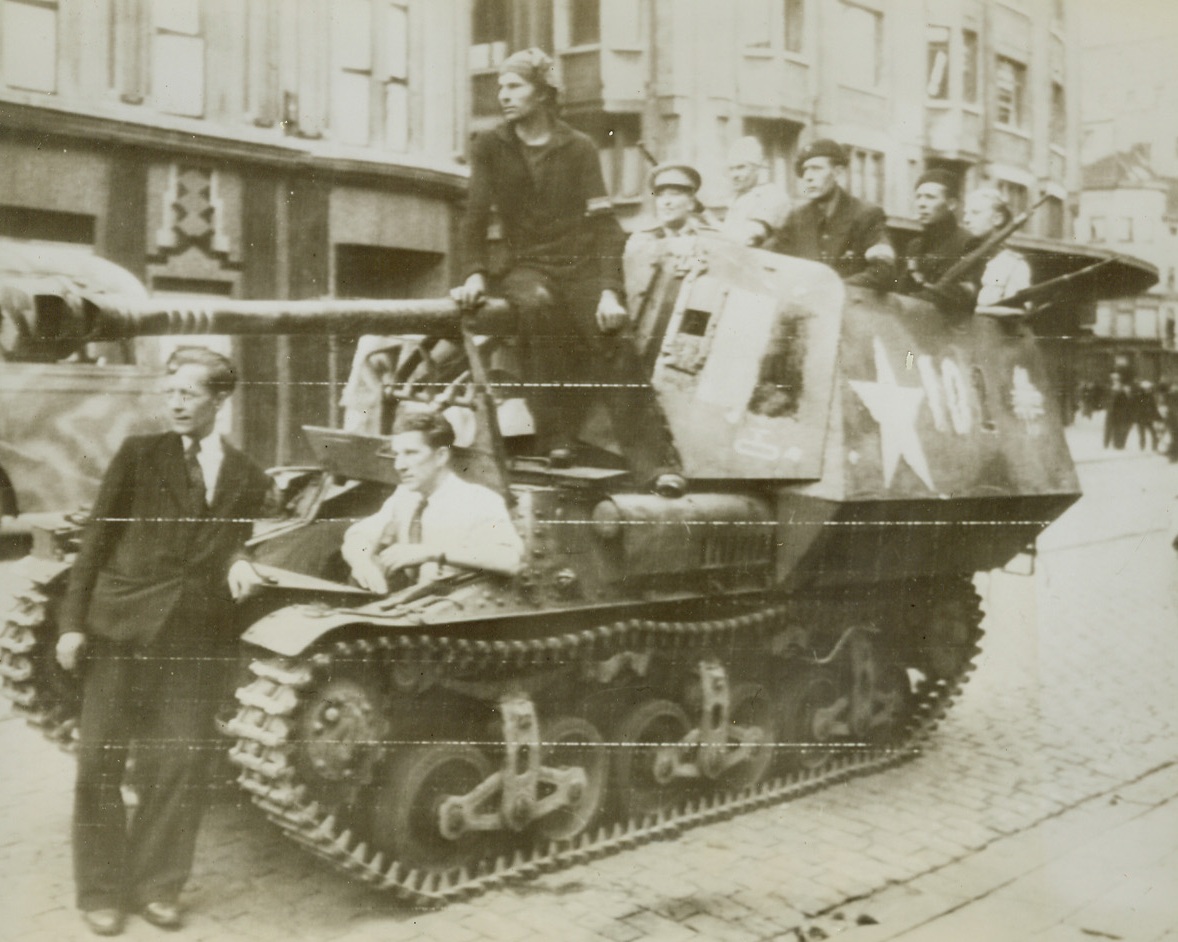
BELGIAN “WHITE BRIGADE” ON MARCH, 9/8/1943. BELGIUM—Riding in captured German vehicles, members of the “White Brigade,” Belgian resistance movement, are shown in the city of Antwerp as they headed for other towns to clear out the German snipers and stragglers. Credit-WP-(ACME Photo via Army Radiotelephoto);

BRITAIN REPORTS TO NEWS-STARVED PEOPLE, 9/9/1944. BRUSSELS, BELGIUM—The Place de la Bource in Brussels is alive with people as a British loudspeaker broadcasts the latest news reports to citizens of the town who have heard no news, save propaganda, since the German occupation. Credit (ACME) (WP);
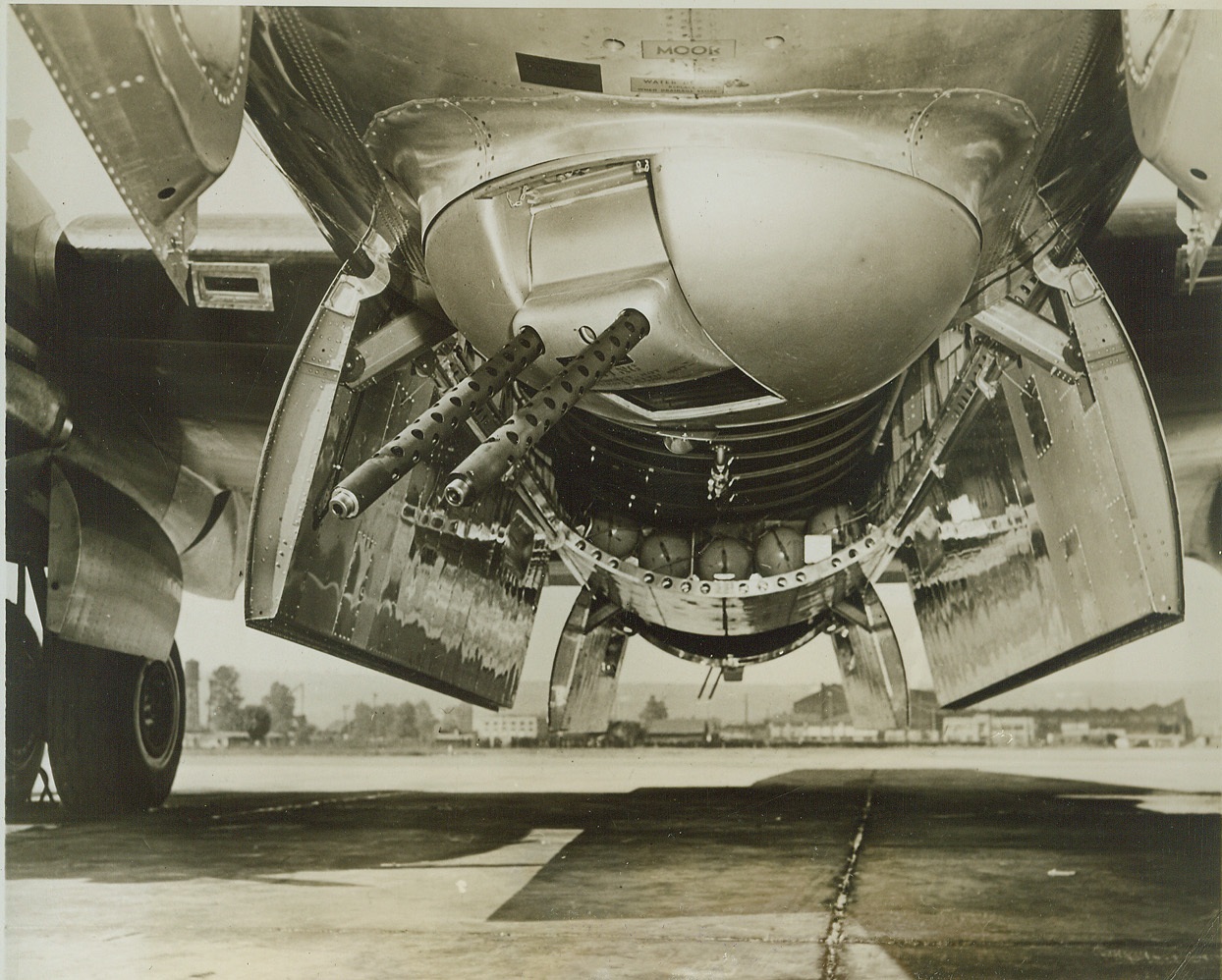
Superfortress Carries Five Gun Turrets, 9/8/1944. For the first time, the gun positions on the Boeing Superfortress are revealed. Five turrets, each with two .50 caliber guns, are placed at strategic positions on the bomber. Here the forward lower turret can be seen, with the two guns, on the under side of the fuselage beneath the pilot's cabin. The bomb bay doors are open. In addition to these guns, the tail turret also mounts a 20mm cannon. All turrets are remotely controlled which makes possible the operation of all guns by gunners in different parts of the bomber. Credit (ACME);
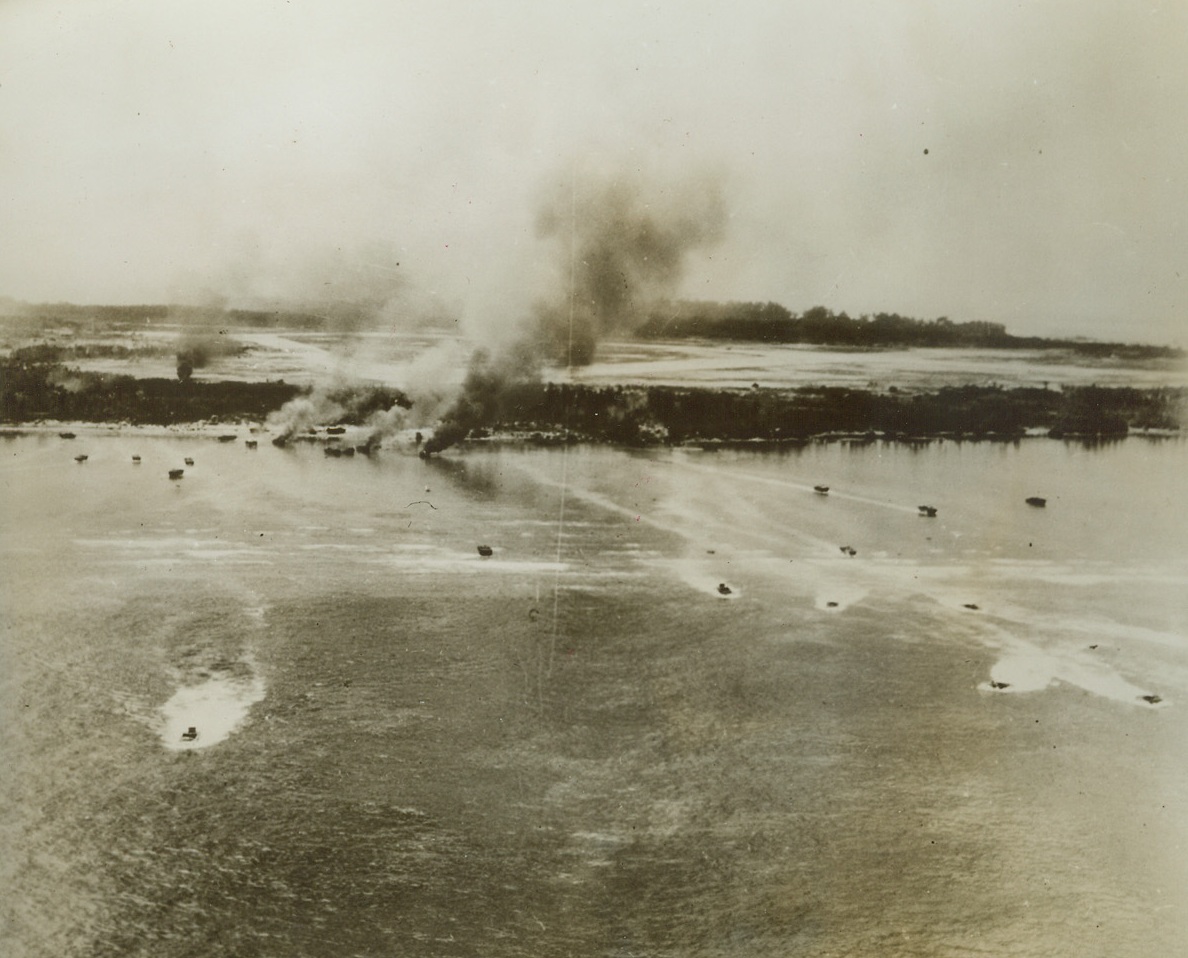
Fight for Peleliu, 9/22/1944. Peleliu Island, Palau – Looking like water bugs, Marine “Amtracks” dart through the shore waters of Peleliu Island as a Naval Barrage is laid down to cover the invasion. Several of the amphibious tractors, targets of Jap mortars, burn near the beach. The Jap airfield, prime objective on the island, can be seen beyond the fringe of trees. Credit: Official U.S. Navy photo from ACME;

Rocket Fire Heralds Invasion of Morotai, 9/19/1944. Morotai, Halmahera Is. – As smoke forms a screen for its maneuvers this assault landing craft of the US Fleet pours a stream of rocket fire up on the beach at Morotai, as American Forces land their first wave of invaders. Mopping up operations are now in progress on Morotai, stepping stone to the Philippines. Credit: Signal Corps Radiotelephoto from ACME;
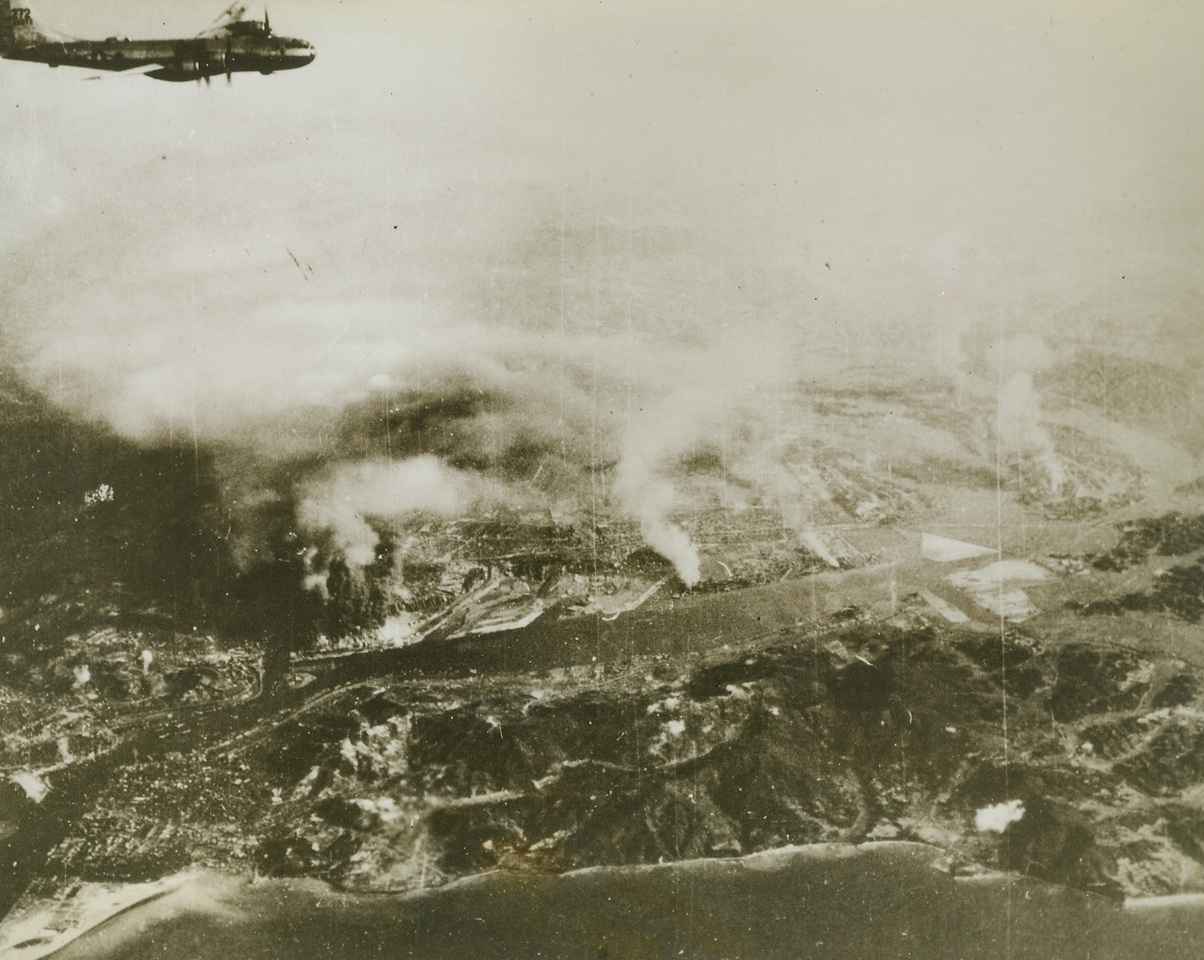
Yawata Blasted by B-29’s Again, 9/8/1944. Japan – Yawata, the “Pittsburgh of Japan,” burns and smokes under the third attack by B-29 superfortresses during their mission of August 20. This was the first daylight bombing attack of the Jap mainland since Gen. Doolittle’s historic flight. Note one of the huge planes in upper leftCredit (USAAF photo from ACME);
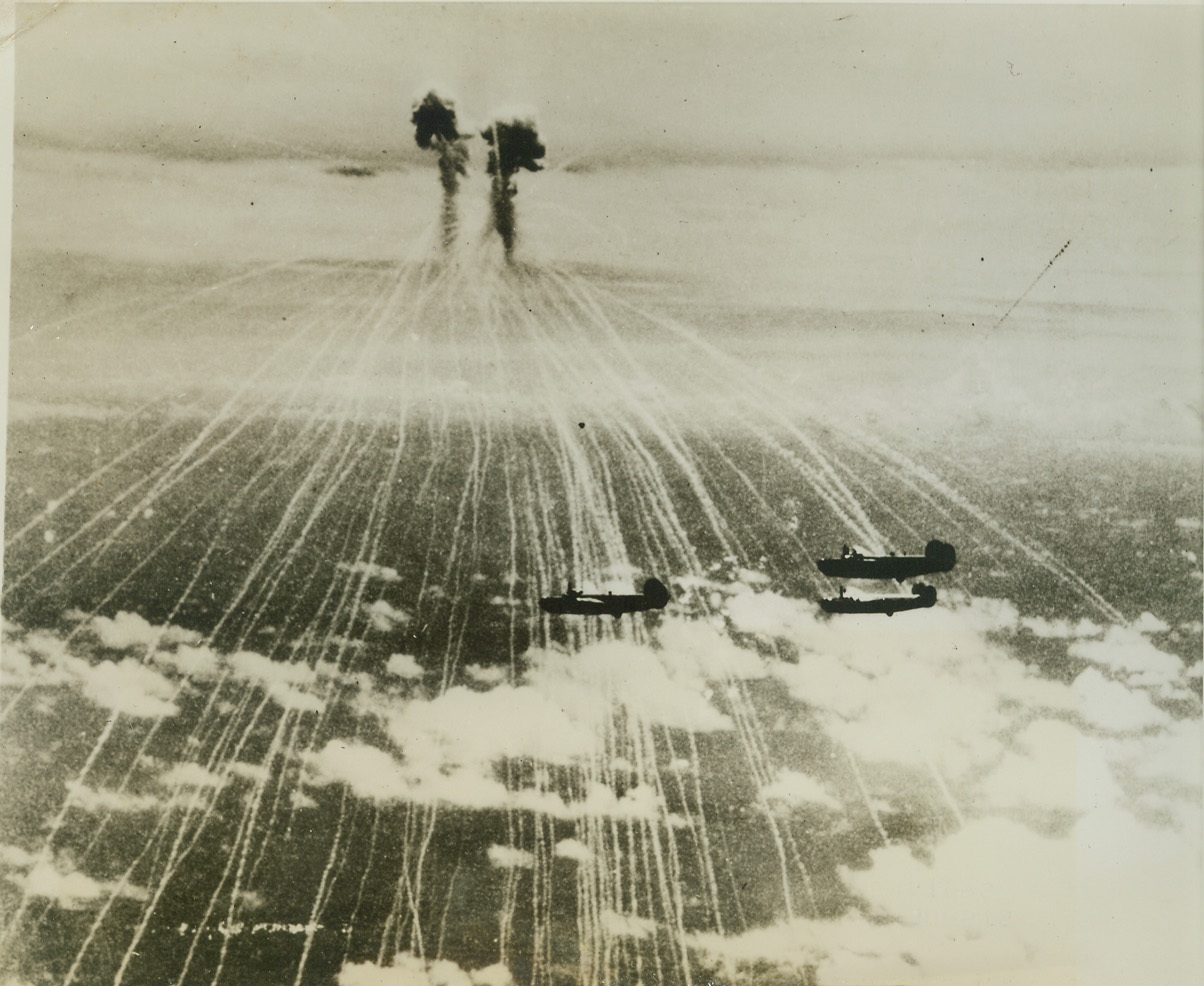
Jap Bombs Miss Liberators, 9/29/1944. A brace of Japanese phosphorus bombs burst over a formation of 7th Air Force Liberators winging over the Kazan Islands. The big American planes had just dropped their bombs on Iwo Jima, 650 miles from Tokyo, when Zeke fighters unloaded the phosphorus bombs and began a series of unsuccessful passes at the bombers. Credit: (U.S.A.A.F. Photo from ACME);
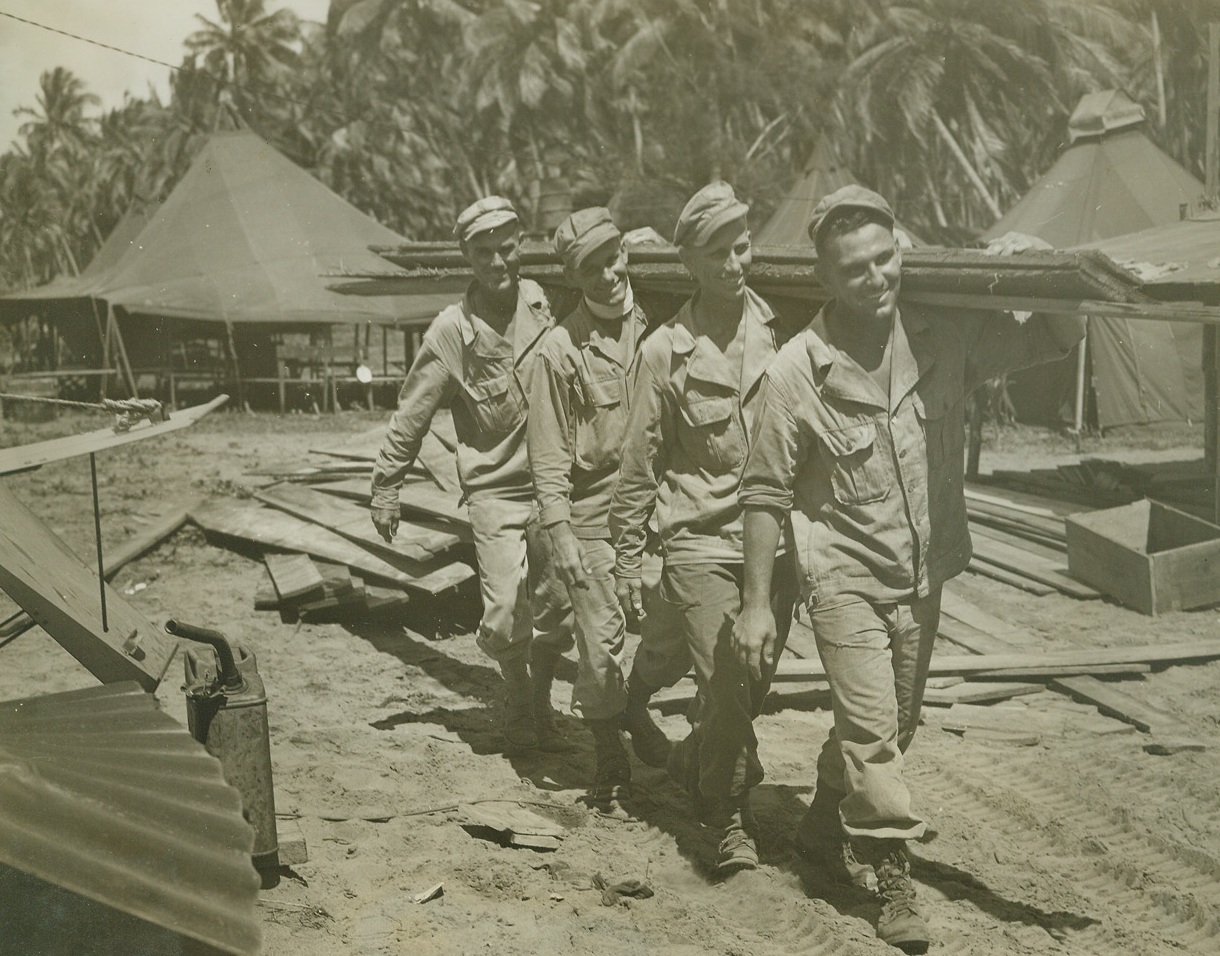
A Fighting Family with the U.S. Army, 9/1/1944. AITAPE, NEW GUINEA – The Vanskike family, father and three sons, enlisted in the army at the same time back in 1942 at Galveston, Texas. Since that time they have been together through basic training and are now all with the 32nd Division headquarters carpenter shop on Aitape in New Guinea. The father, whose nickname is “Pop,” served in the last war as a sergeant in the field artillery for 26 months. Here they are, left to right: Pvt. Archie, Pvt. Lewis, Pvt. Clarence, and S/Sgt. “Pop,” hauling lumber for new quarters. Credit: ACME photo by Tom Shafer, War Pool Correspondent;
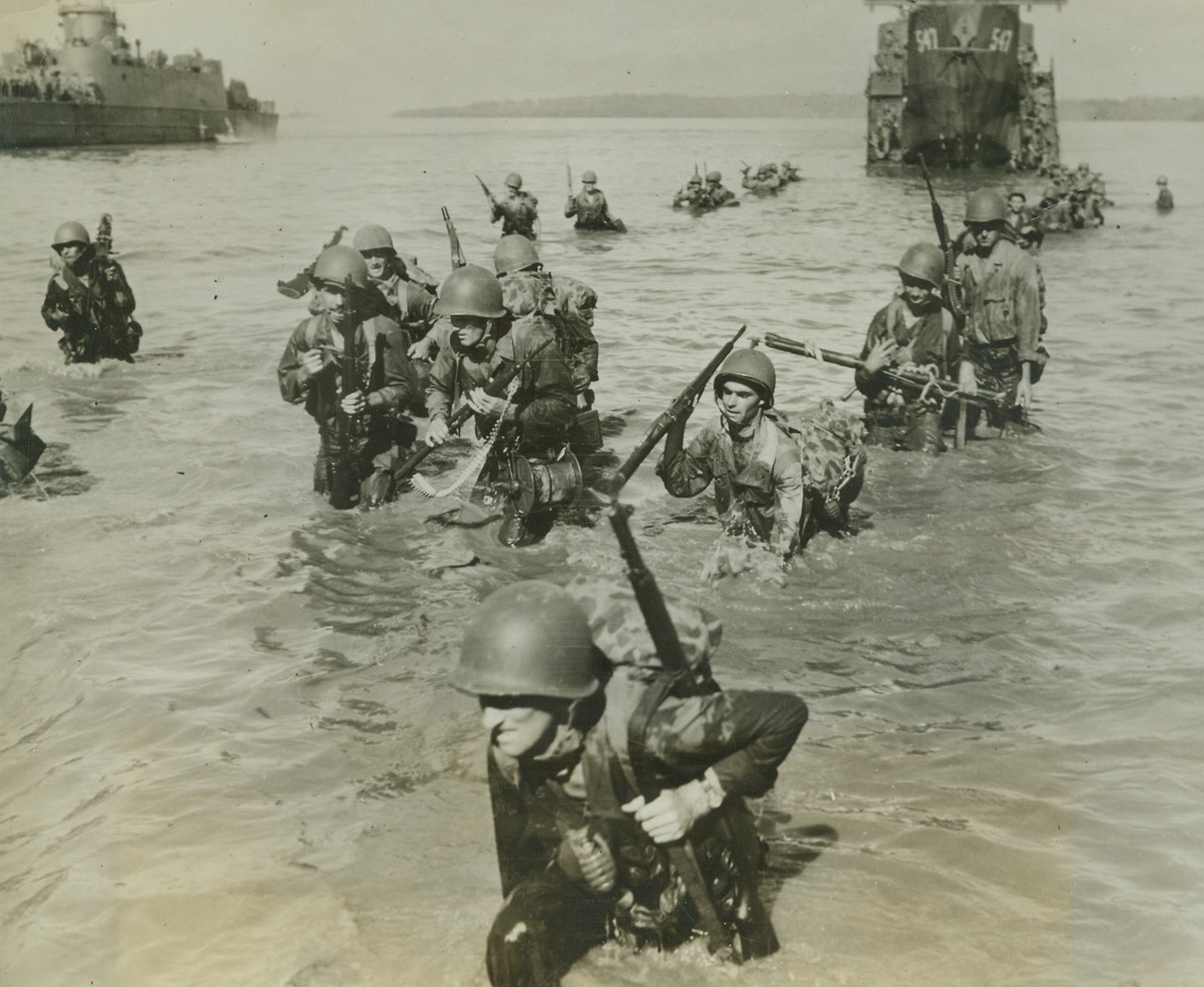
Yank Infantry Invades Morotai Island, 9/20/1944. Morotai Island – With “necklaces” of hand grenades and rifles, these Yank infantrymen swarm ashore in neck-deep water from their LCI’s to Morotai Island Beach, just South of the Philippines. Credit line (ACME);
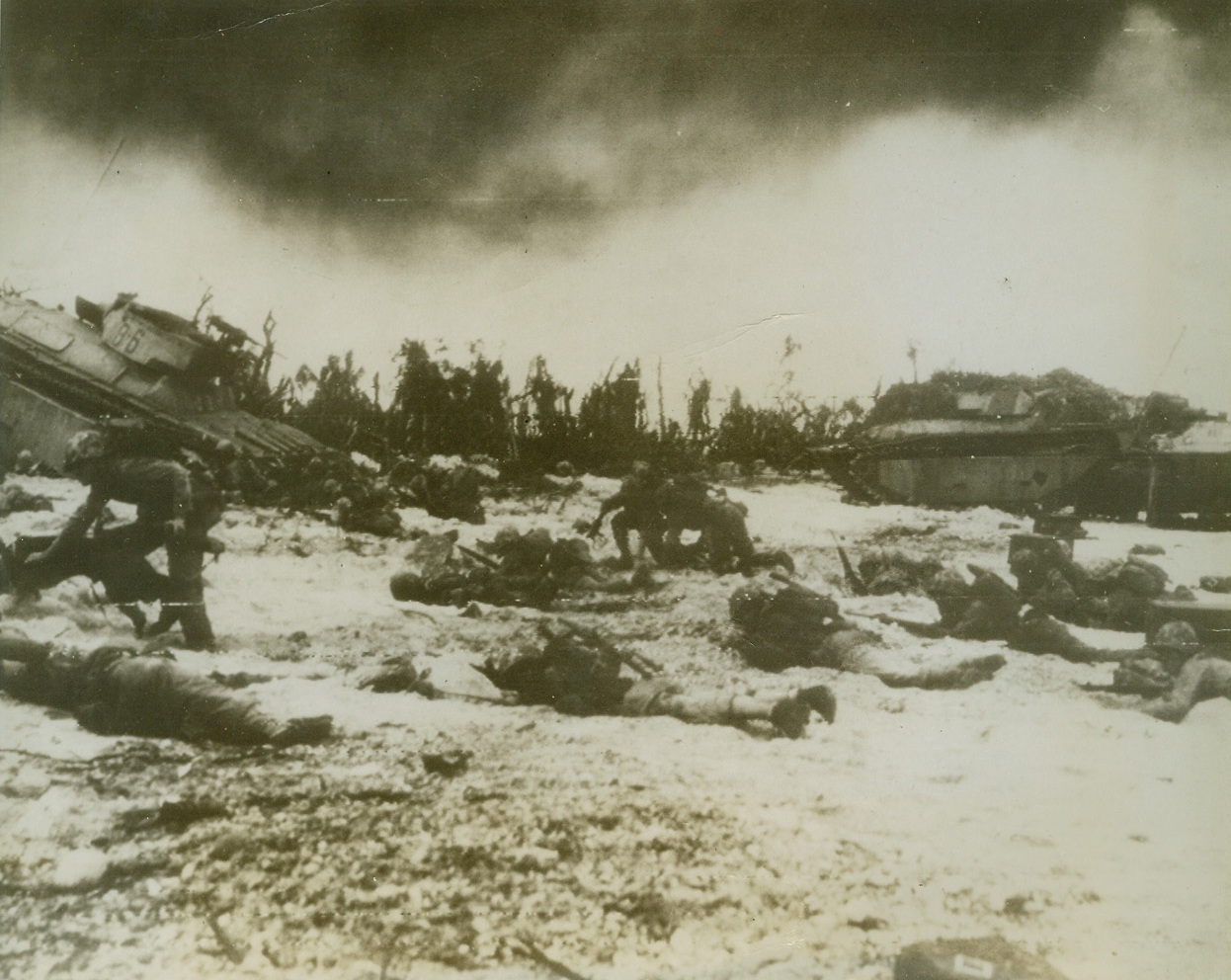
Marines Swarm Ashore on Peleliu Island, 9/20/1944. Peleliu Island – Assault troops of First Marine division hit Peleliu island beach – some never to rise again – as the established beachhead in Paulaus in toughest fighting of three invasions flanking Philippines. Jap defenders fought grimly in retreat under pressure from ceaseless land, sea and air attack. Photo radioed from Honolulu to San Francisco. Credit line (ACME);

Invasion Toll, 9/10/1944. Peleliu Island – The price of conquest is never cheap. These two Leathernecks of First Marine division lie where they fell in beach of Peleliu island in Palaus where they landed with first wave of assault troops storming the strategic island carrier to the Philippines. Photo radioed from Honolulu to San Francisco. Credit line (ACME);
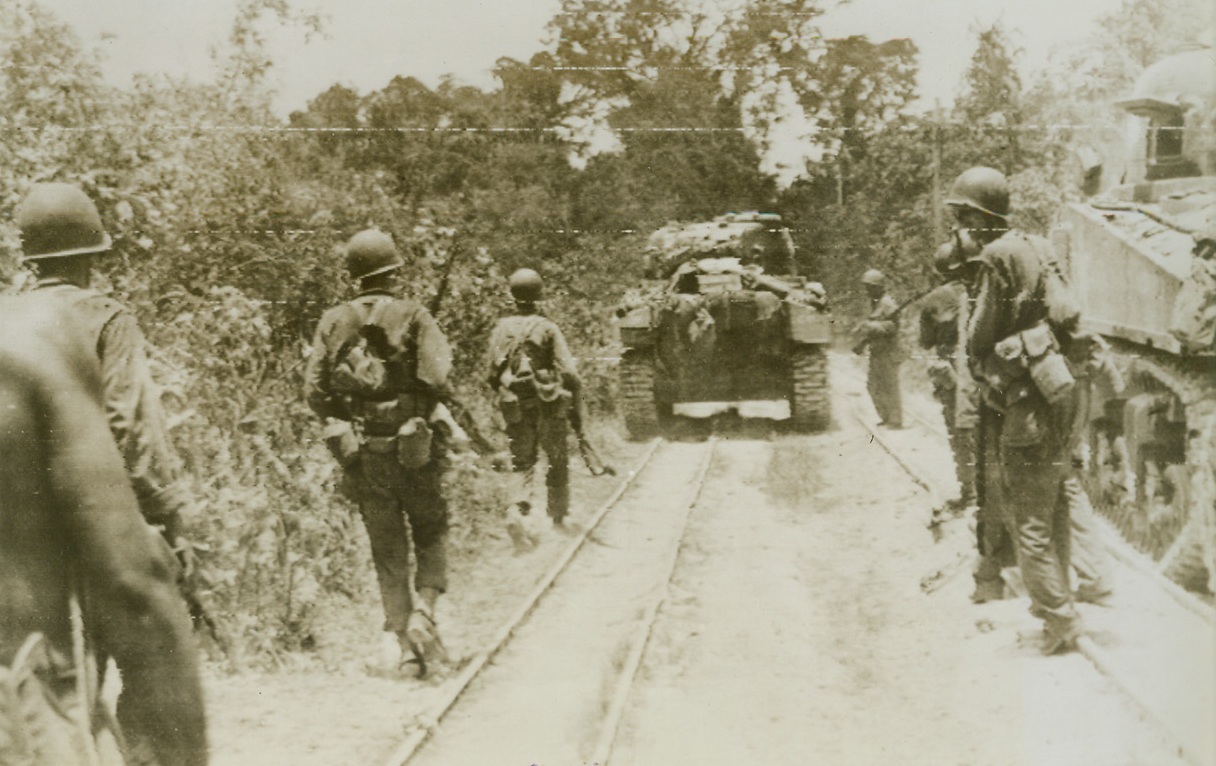
Japs – 50 Yards Ahead, 9/28/1944. Palau Islands – Slowly, gut steadily troops and tanks of the U.S. Army’s 31st division move up along a double narrow gauge railroad to blast a Jap strongpoint only 50 yards from the point where this photo was taken. Scene is An gaur Island. Credit line (Army radio telephoto from ACME);

Two-Way Traffic, 9/30/1944. Peleliu Island, Palau – Churning the waters off Peleliu, many types of invasion craft pass each other as they chug toward and away from the besieged Palau island. Enemy installations, targets of combined air and sea bombardment, go up in smoke along the beach as the full weight of the Sept 15th attack is felt. Credit line (U.S. Navy photo from ACME);

Prelude to Palau Landings, 9/15/1944. In a smashing prelude to the landings which took place yesterday, Navy planes from Adm. William F. Halsey’s third fleet struck Jap-held Palau repeatedly on July 26-27. Smoke rises from the blasted installations during the continued aerial hammering. Credit (U.S. Navy photo from ACME);
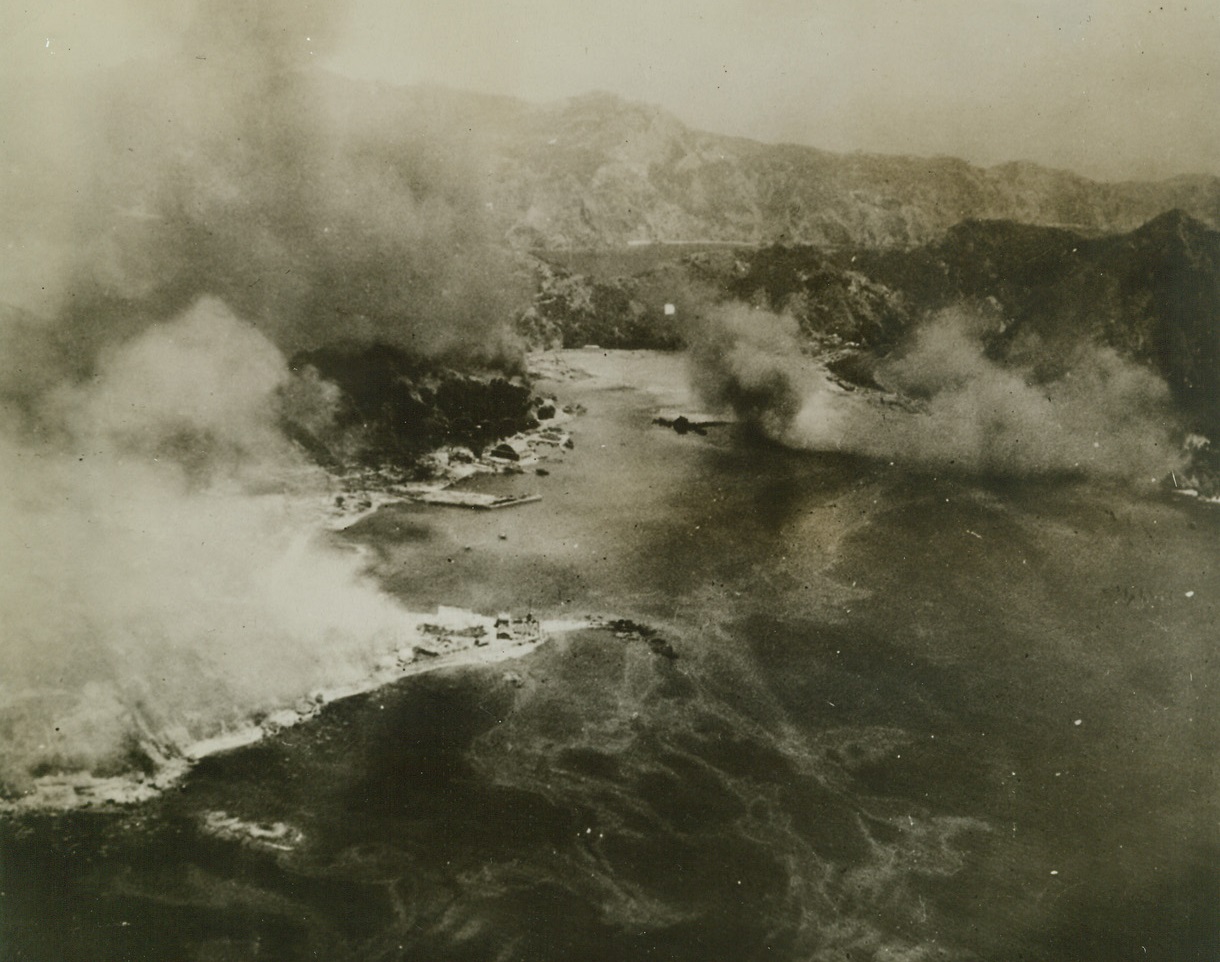
Chichi Jima Blasted by Navy Planes, 9/15/1944. Chichi Jima – A pall of smoke of hides the town area and seaplane base of Chichi Jima in the Bonin islands after Navy carrier-based blasted enemy aircraft, sank shipping, and destroyed military installations in a recent raid. Islands are only 600 miles from to Tokyo. Credit (U.S. Navy photo from ACME);
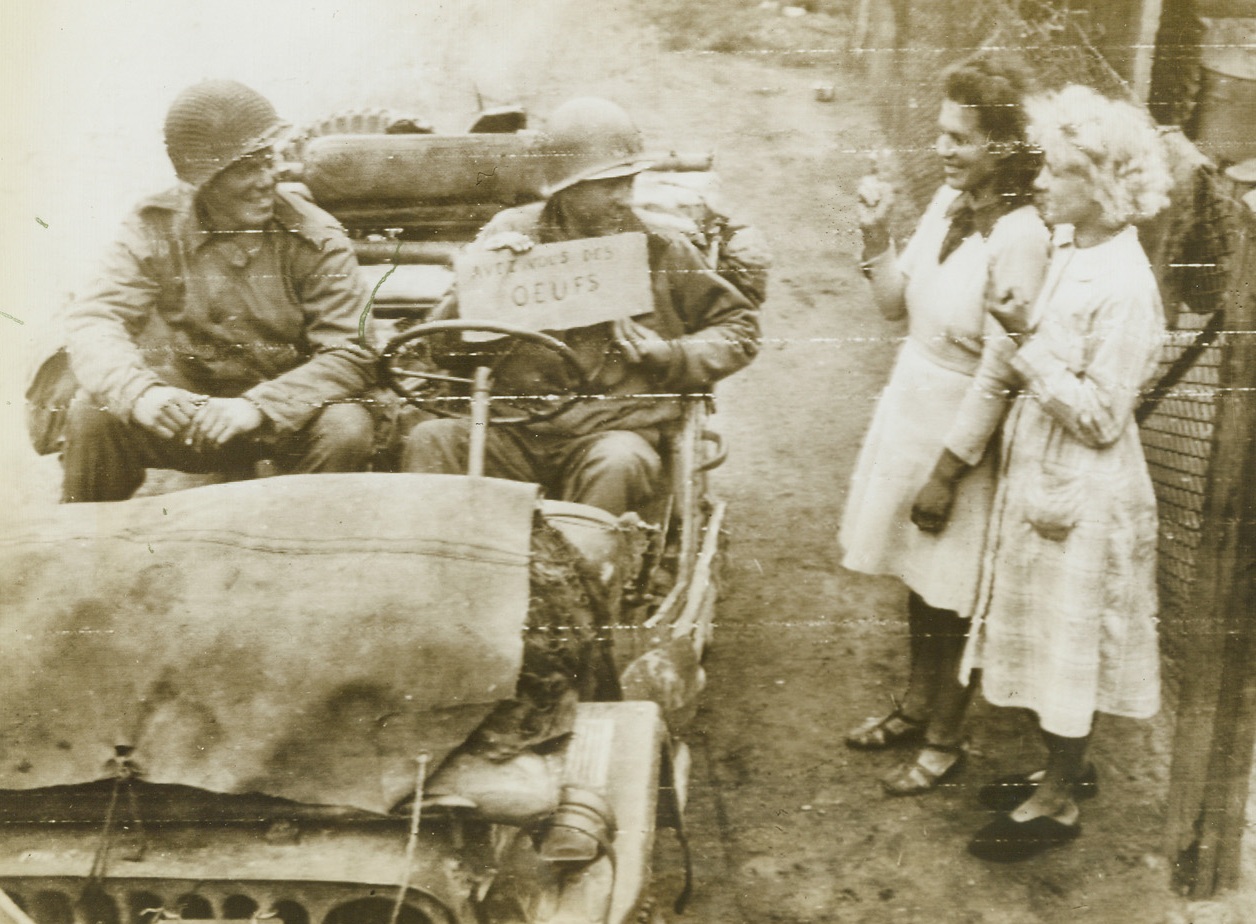
Yanks Hunt Eggs (CQ) in France, 9/8/1944. France—Holding a lettered board written in French and meaning “have you any eggs?” two Yanks ride in a Jeep and hope for a positive answer from French girls in the city of Rumegies, France. Driver and sign holder is Pvt. Maury Sanders of Corinth, Miss. The other Yank, Pvt. Albert Frank, Burlington, VA., looks on. Credit: Army radiotelephoto from ACME.;
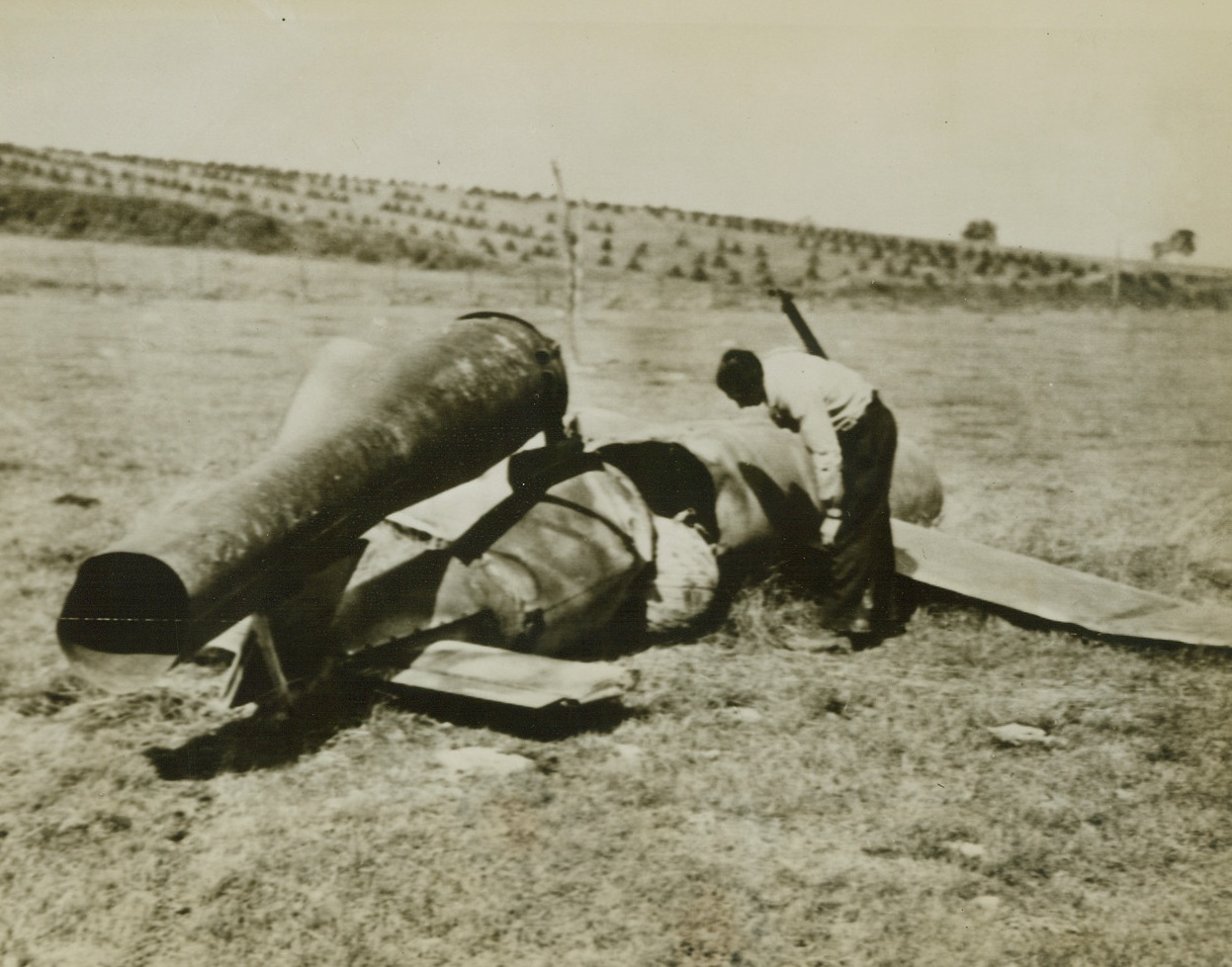
Robomb Misses Target-Misses City, 9/8/1944. France—Almost intact, this flying bomb intended for England missed fire and traveled only a short distance from its launching site to the French city of Foucarmont where it was discovered by Allied forces. Credit: Army radiotelephoto from ACME.;
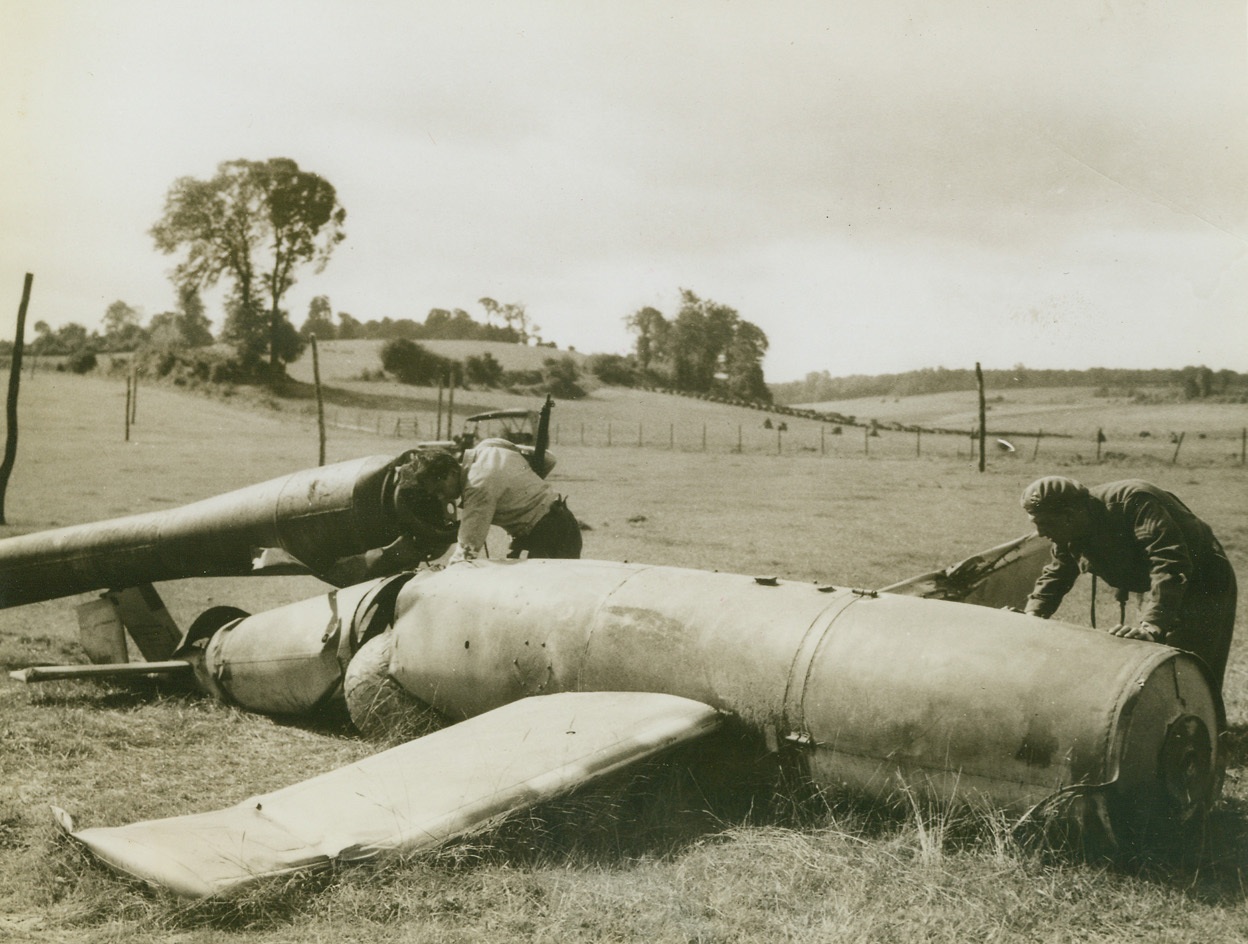
Robomb Misses Target by Long Sight, 9/8/1944. France—A flying bomb intended for England missed fire and traveled only a short distance from its launching site to land in a field in France. Somewhere in the Pas de Calais area, “Raymond” (left), of the French Resistance Movement, and Sgt. H.A. Barnet, Montreal, Canada, examine the V-I weapon which is almost intact. Credit: ACME.;
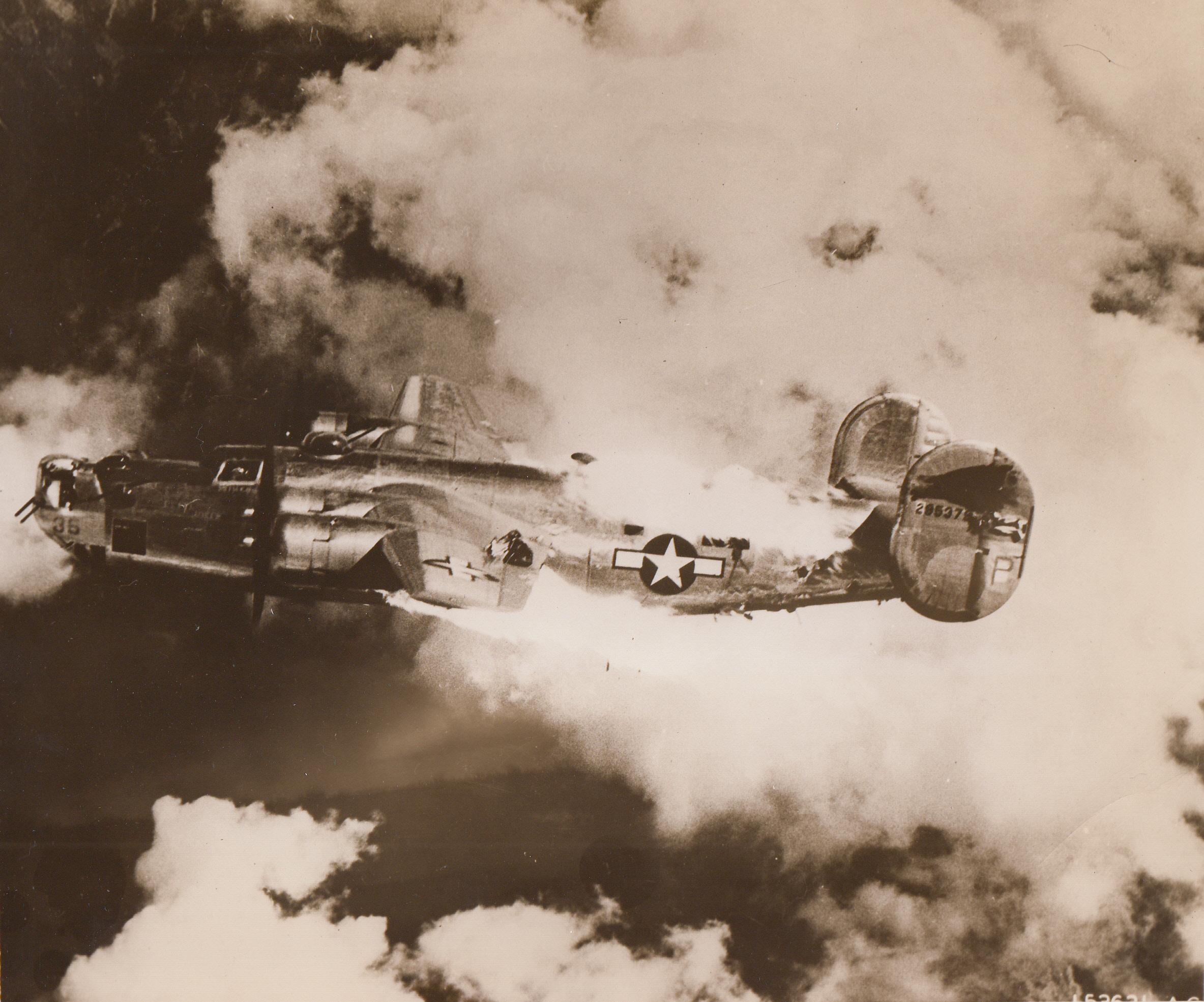
A Liberator on its Last Mission, 9/8/1944. Flames roar from the fuselage of a mortally wounded Liberator from Austria. Seconds later the big ship plummeted to earth. Photographer said the pilot was still in the cockpit, gunner in the tail.;
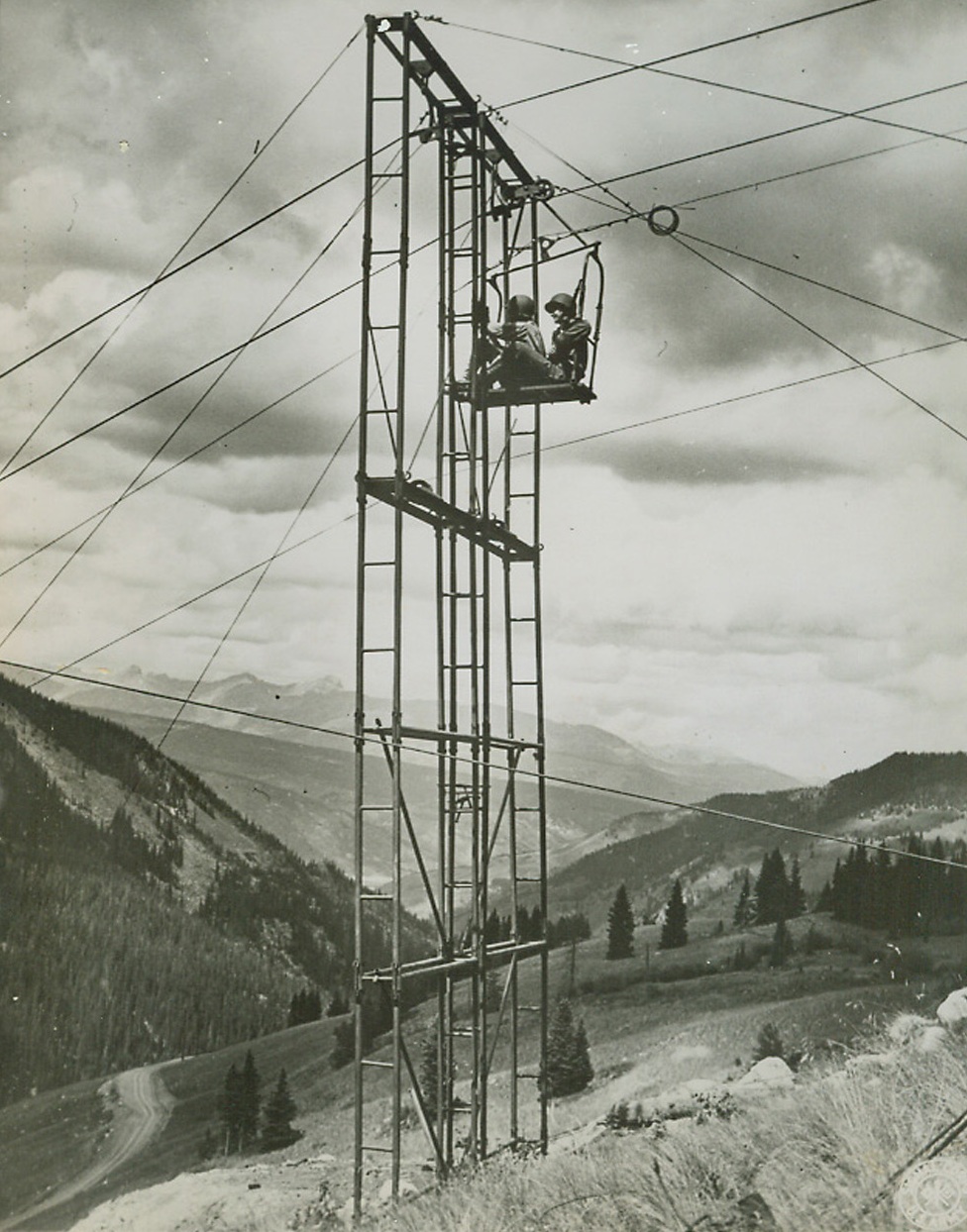
Light Aerial Tramway M-2, 9/21/1944. CAMP HALE, COLO. - The transportation of ammunition, food, and water, the evacuation of wounded personnel, and the moving forward of artillery for mountain troops in terrain too rough for pack animals or men has long been a serious problem for mountain fighters. The Army recently offered to the public its solution of this problem here when the Camp Hale Test Branch of the Mountain and Winter Warfare section of the Army's Engineer Board gave a demonstration of the recently perfected Light Aerial Tramway M-2. A closeup view of the twin tower construction, showing a car passing through. The towers are so built as to be quickly disassembled and moved to a new location.;
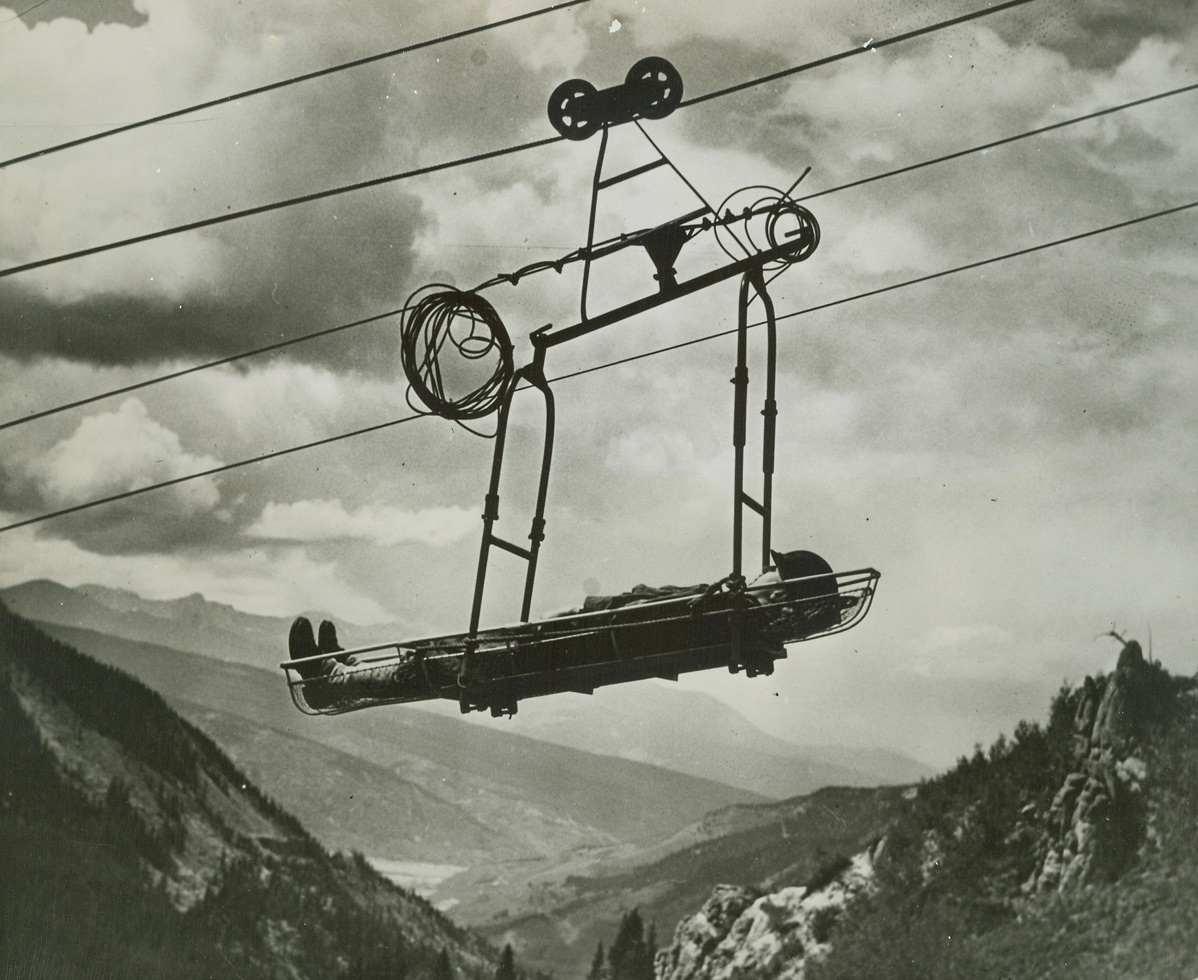
Light Aerial Tramway M-2 (3), 9/21/1944. Camp Hale, Colo.—The transportation of ammunition, food and water, and evacuation of wounded personnel, and the moving forward of artillery for mountain troops in terrain too rough for pack animals or men has long been a serious problem for mountain fighters. The army recently offered to the public its solution of this problem here when the Camp Hale test branch of the Mountain and Winter Welfare section of the Army’s Engineer Board gave a demonstration of the recently perfected Light Aerial Tramway M-2. The M-2 provides an ideal method for quickly evacuating wounded from high mountains. Shown here is a Stokes Litter, tied to the tram car and being lowered to the base terminal. Signal corps photo from ACME.;
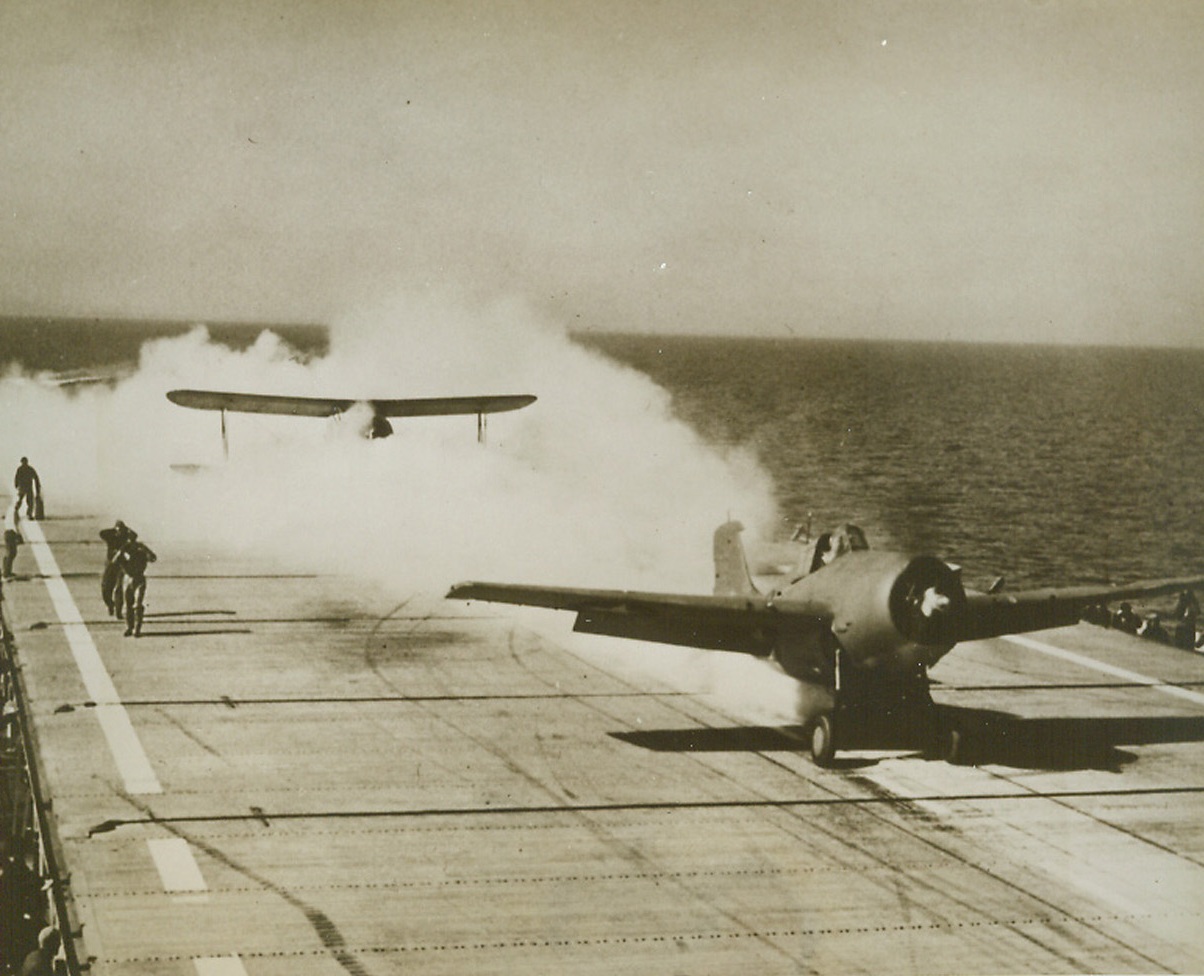
Jet Units and Navy Planes in Take-Offs, 9/8/1944. The Navy announced today that it has developed for immediate use jet propulsion units to assist carrier planes and flying boats to take off with heavier loads, in shorter spaces and at greater speed. The jet units, known as Jato in the Navy, resemble bombs except that they are affixed to the fuselace of a plane rather than under the wings or enclosed in the bays. They contain solid propellent, which includes oxygen, and are ignited by electronically-controlled spark plugs. Escaping steam gives the plane its “thrust.” First carrier takeoff using jet units involved in the same Grumman Wildcat as that used by Capt. Gore in original tests on March 1-4, 1943. This time Commander Leroy G. Simpler, USN, of Lowes, Del., was at the controls as the jet-assisted plane roared into the air on March 18, 1943—with an amazing saving of takeoff space.Credit: U.S. Navy Photo from ACME.;
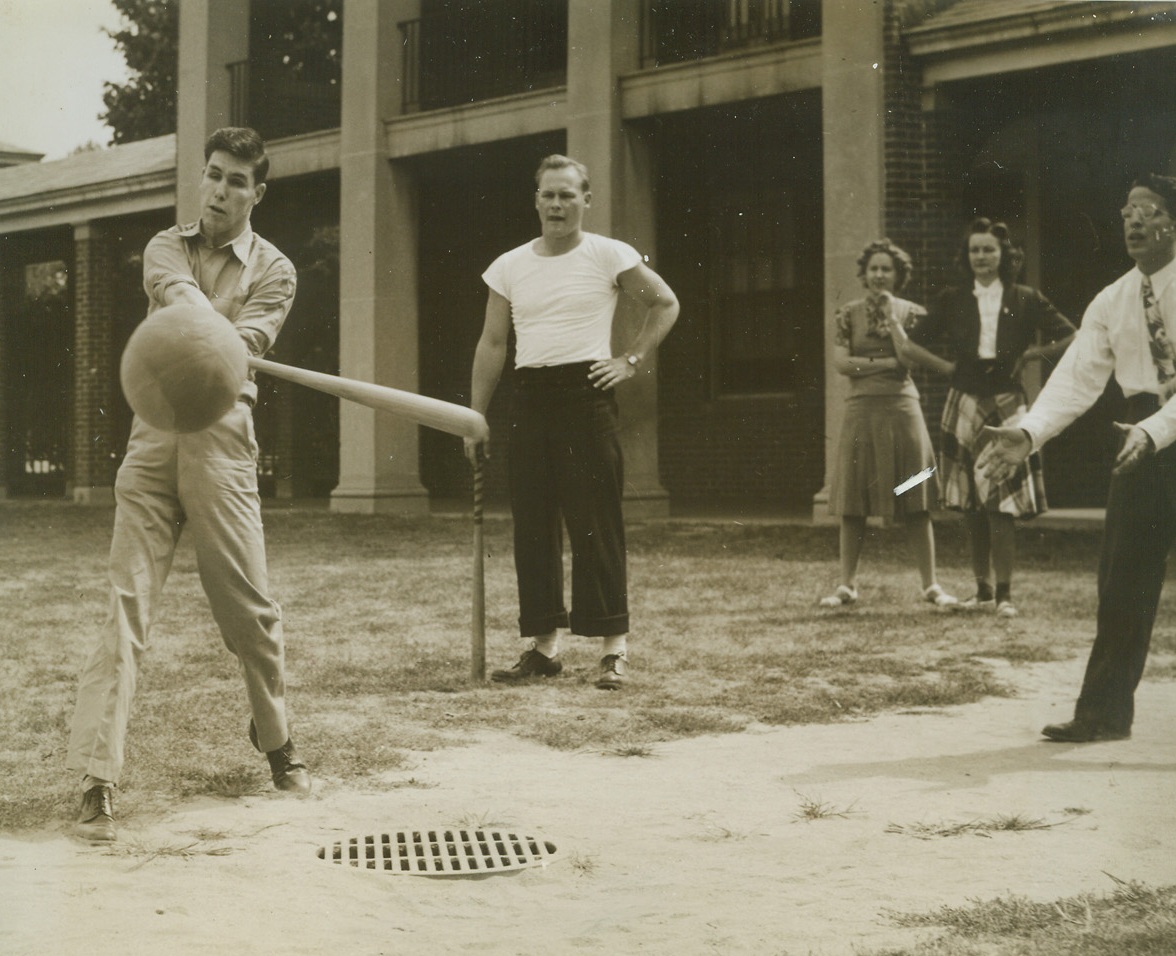
Sightless Marines Play Baseball With Blind, 9/8/1944. New York—Pfc. John G. Corrie, who lost his sight landing with the first parachute battalion of Marines behind the Jap lines at Bougainville, hits the ball in game yesterday at the New York Institute for the Education of the Blind, 999 Pelham Parkway, the Bronx. Another blind student prepares to catch the ball in case Corrie misses. Standing by is Henry R. Linville, pharmacist’s mate 3/o, who is in charge of the six Marines at the school.Credit: ACME.;
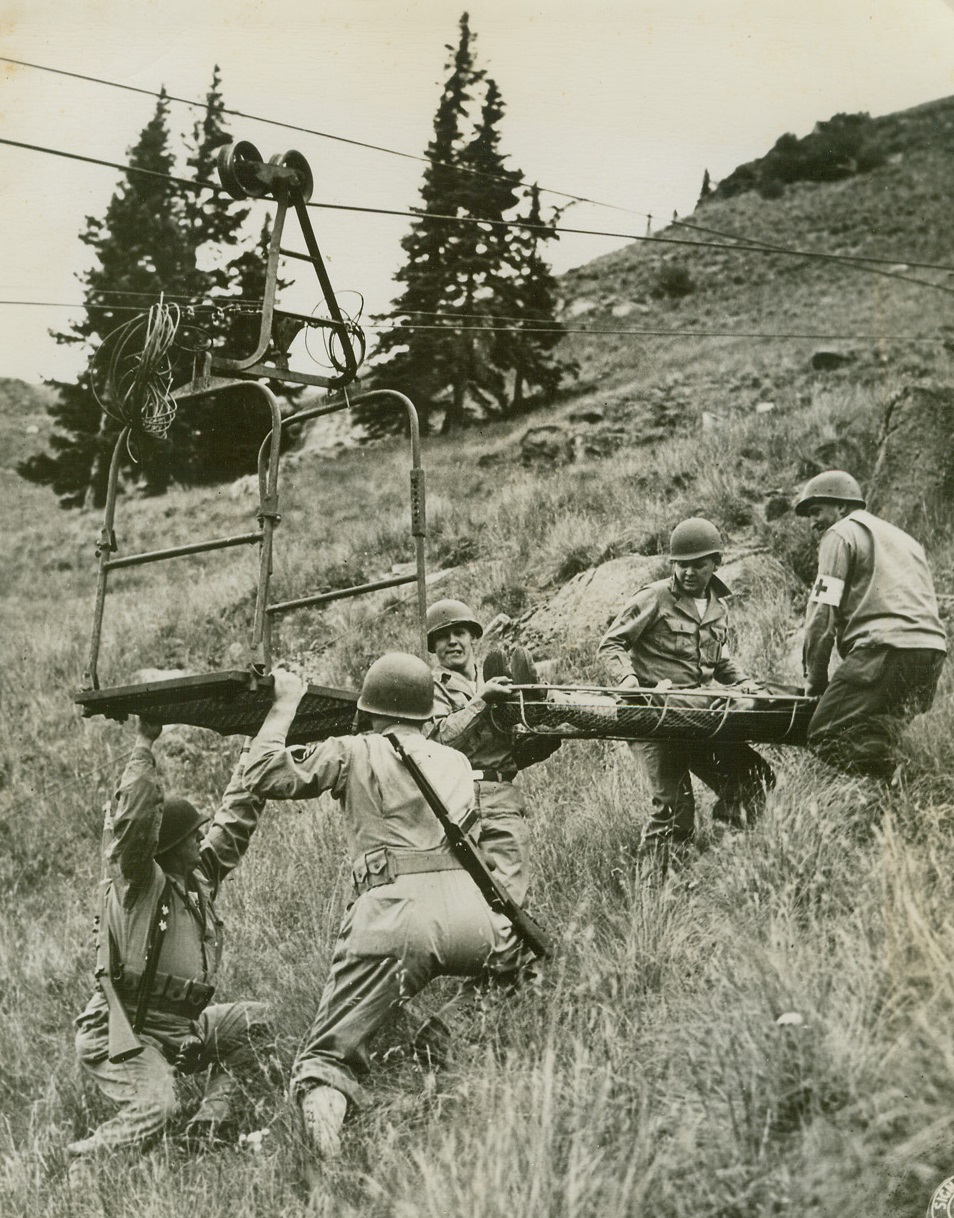
Light Aerial Tramway M-2 (1), 9/21/1944. Camp Hale, Col. – The transportation of ammunition, food, and water, the evacuation of wounded personnel, and the moving forward of artillery for mountain troops in terrain too rough for pack animals or men has long been a serious problem for mountain fighters. The Army recently offered to the public its solution of this problem here when the Camp Hale test branch of the Mountain and Winter Warfare section of the Army’s Engineer Board gave a demonstration of the recently perfected Light Aerial Tramway M-2. Near the upper Terminal of the M-2, Medical Corpsmen are shown loading a Stokes litter and simulated casualty on to the cable car. Three thousand feet below, the ambulance waits to rush the “wounded” man to a base hospital 9/21/44 Credit Line (Signal Corps Photo From ACME);
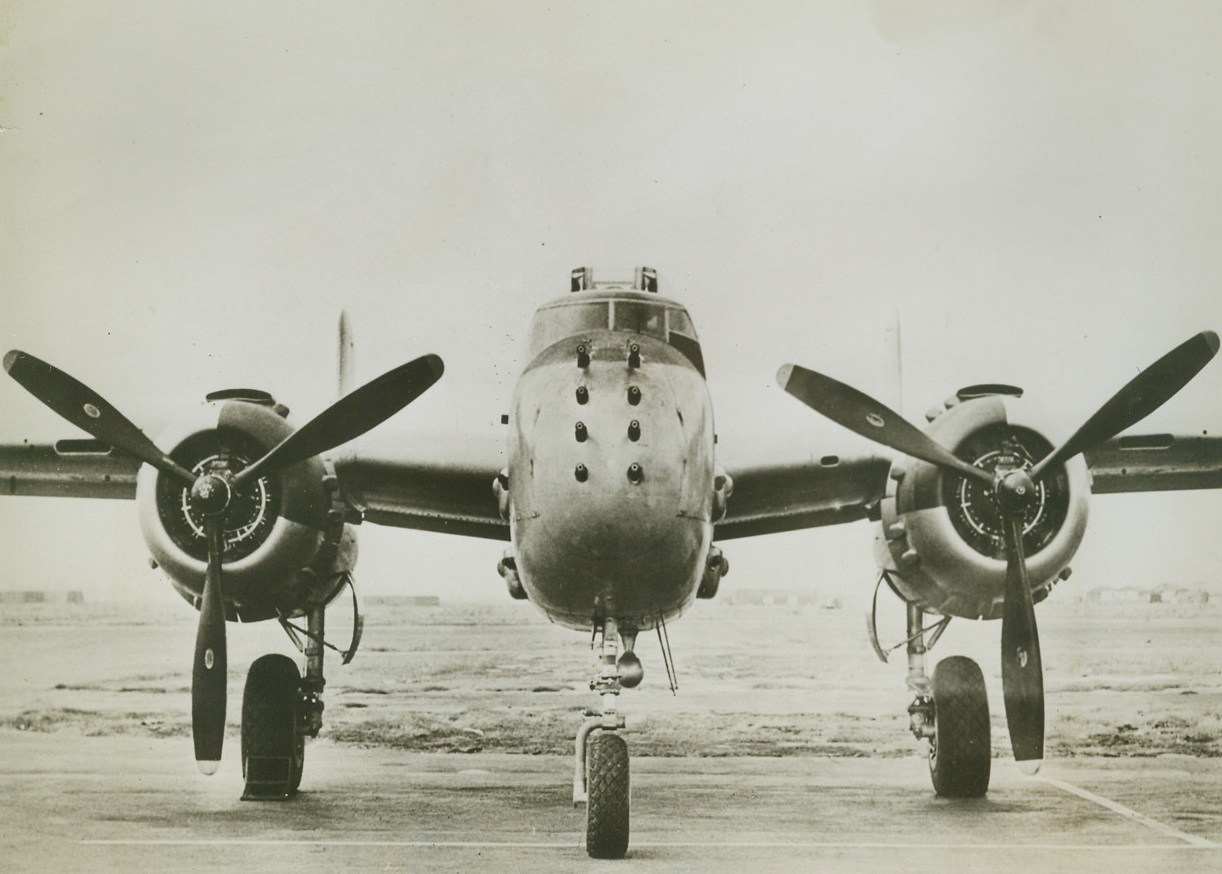
Flying Gun Nest, 9/9/1944. Inglewood, California – The nose of this new North American B-52 Medium Bomber bristles with eight .50 caliber machine guns, ready to splatter death on all enemies who cross their path. Besides these, six other guns are distributed in various parts of the plane, which make the B-52 the world’s most heavily-armed plane. Credit: ACME;

Cheer from a Dutch Nurse, 9/27/1944. Two American paratroopers, casualties in the recent airborne assault on the German lines in Holland, are cheered up by a pretty, blonde Dutch nurse in a civilian hospital at Nijmegen. Credit: Signal Corps photo from ACME;
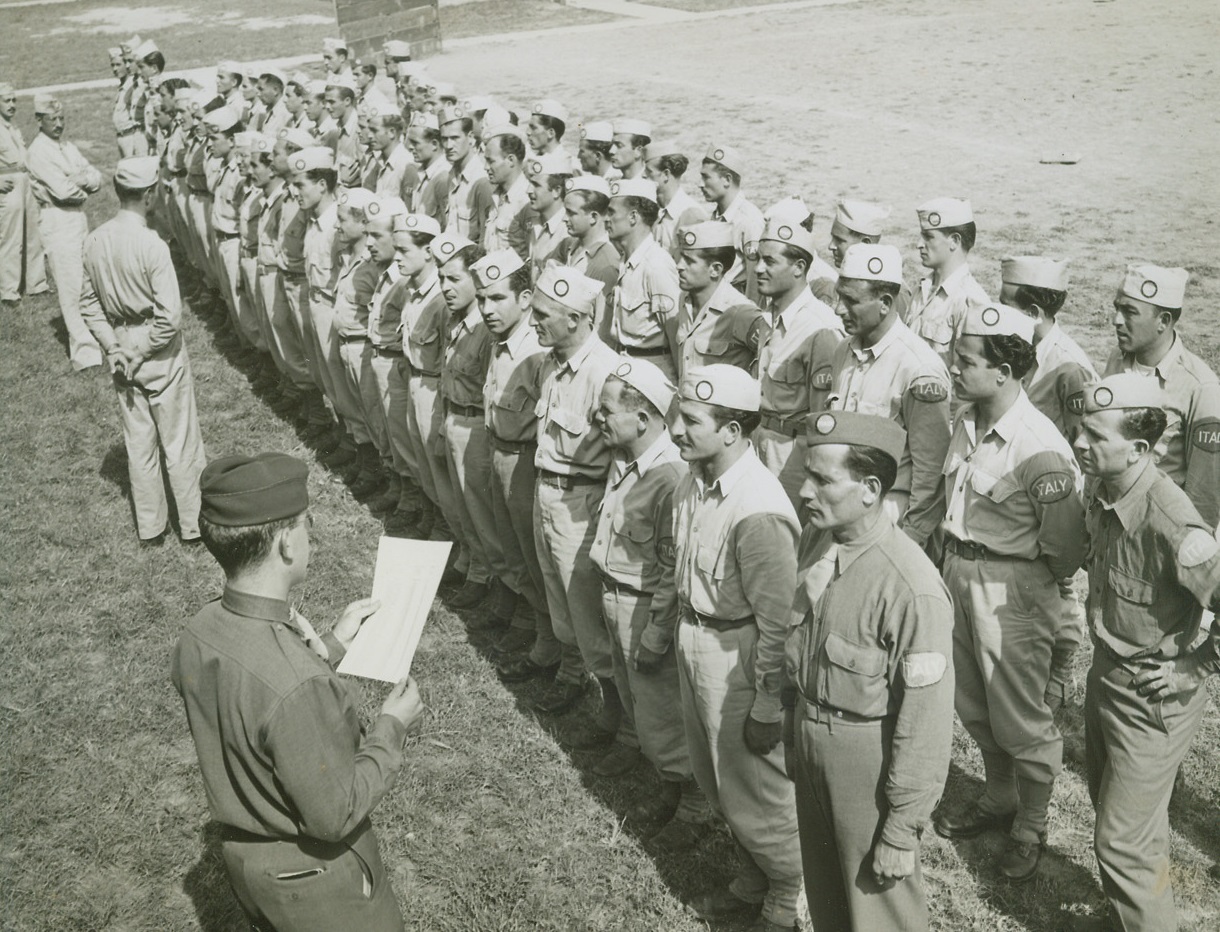
Prisoners to Work at Hospital, 9/27/1944. Chicago – Capt. Alexander Wood calls roll of Italian Service Unit, composed of Italian prisoners of war who are carefully selected on the basis of not having Fascist sympathies, as they check in at Vaughan Hospital in Hines, Illinois, to perform service duties. Credit: ACME;
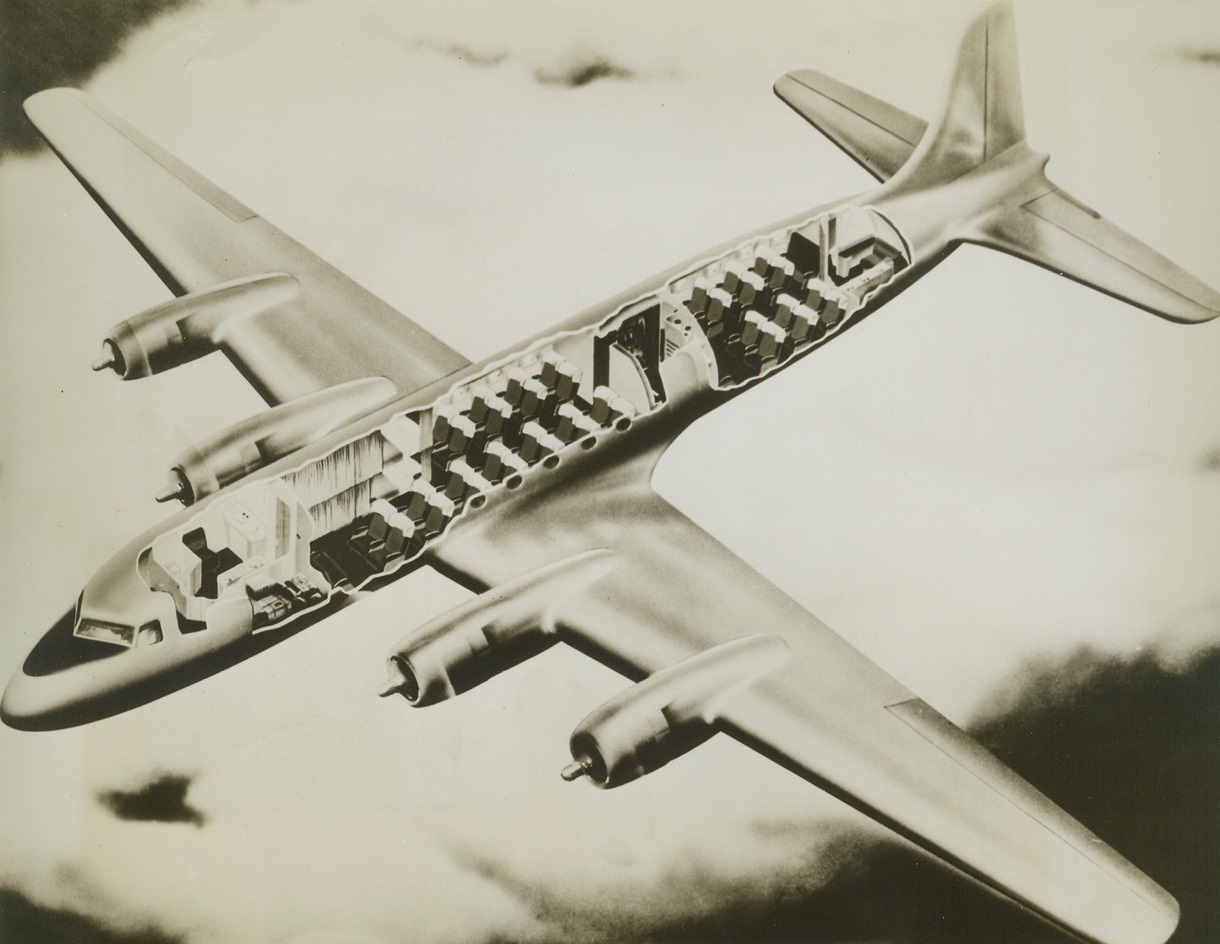
Postwar Super-Liner, 9/12/1944. This is an artist’s conception of the Douglas DC-6, showing seating arrangements for fifty passengers. Douglas signed contracts with three major airlines – American, Pan American-Grace, and United – for postwar production of these planes which are called “the fastest transports available either in this country or abroad for the immediate postwar period.” It is estimated that the ship will fly from coast to coast in eight and one-half hours. Credit: ACME;
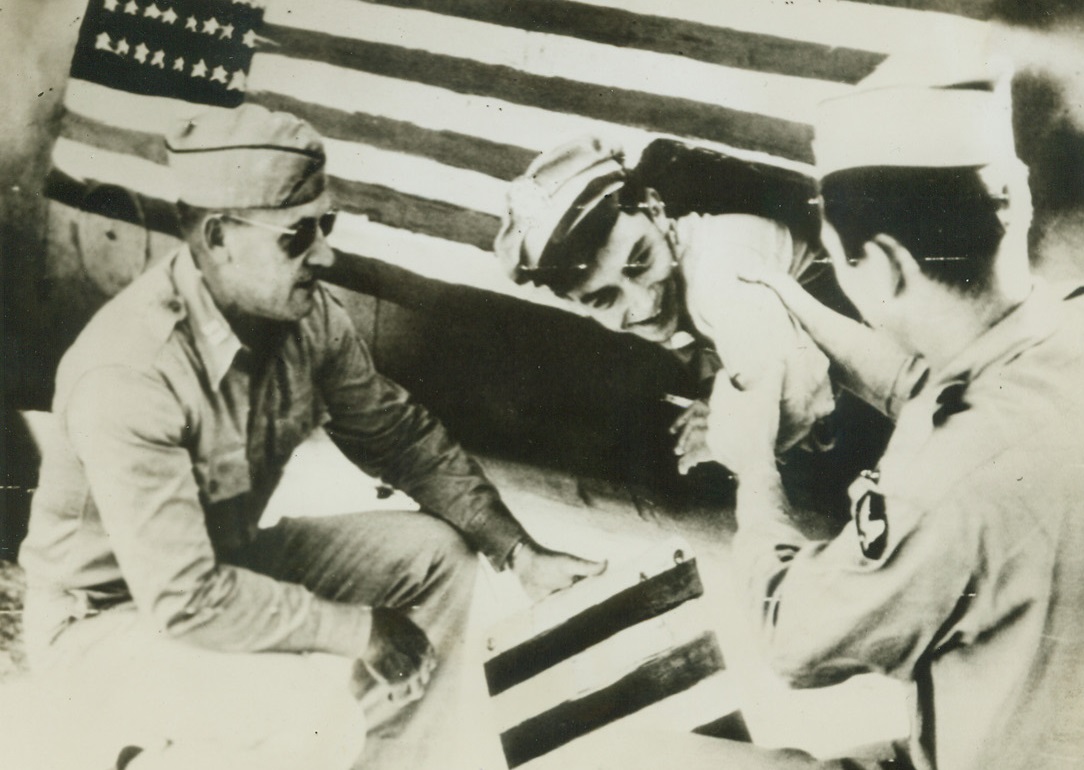
Stunt That Liberated 1000 Americans, 9/3/1944. Leaning out of the flag-covered fuselage of his plane, Lt. Gerald W. Marshall, Los Angeles, Calif., (center) demonstrates to two fellow officers of a B-24 Liberator Bomb Group of the 15th Army Air Force how Lt. Col. James A. Gunn, San Antonia, Tex., flew back from Romania to arrange for mass evacuation of over 1000 former Air Force men from a Romanian prison camp. Credit: Signal Corps Radiotelephoto from ACME;
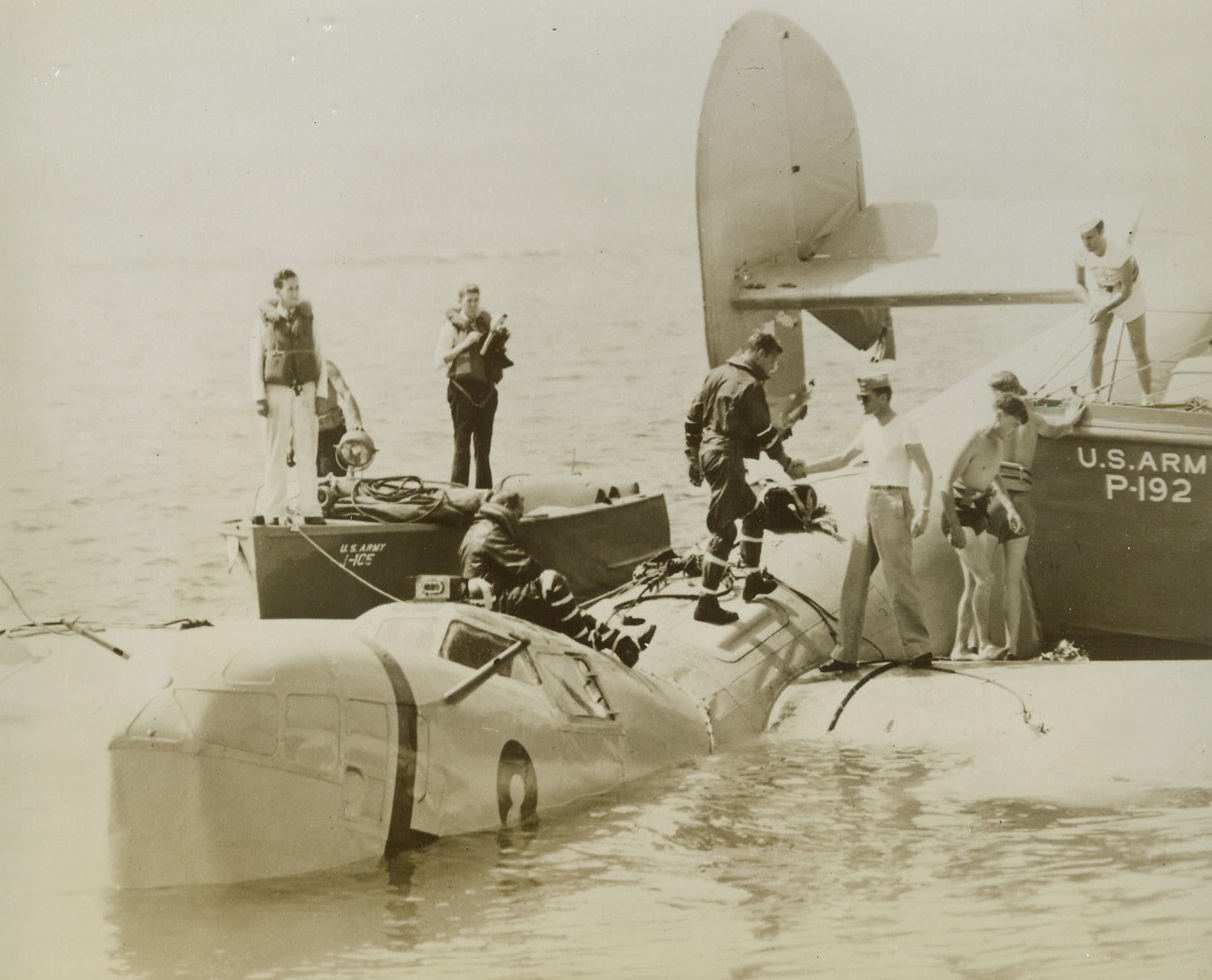
Escape Death in B-24 Experiment, 9/22/1944. Newport News, Va.—Two United States Army Air Forces Airmen almost lost their lives while landing a B-24 Liberator bomber on the James River during an experiment designed to provide improved safety devices for flyers in emergency water landings by land-based aircraft. The plane broke in two but the flyers escaped injury. Maj. Julian A. Harvey (standing, in flying clothes) is congratulated by a fellow officer after the landing. The other member of the crew, Col. Carl F. Greene, can be seen climbing through the escape hatch in the roof of the plane. Credit: ACME.;
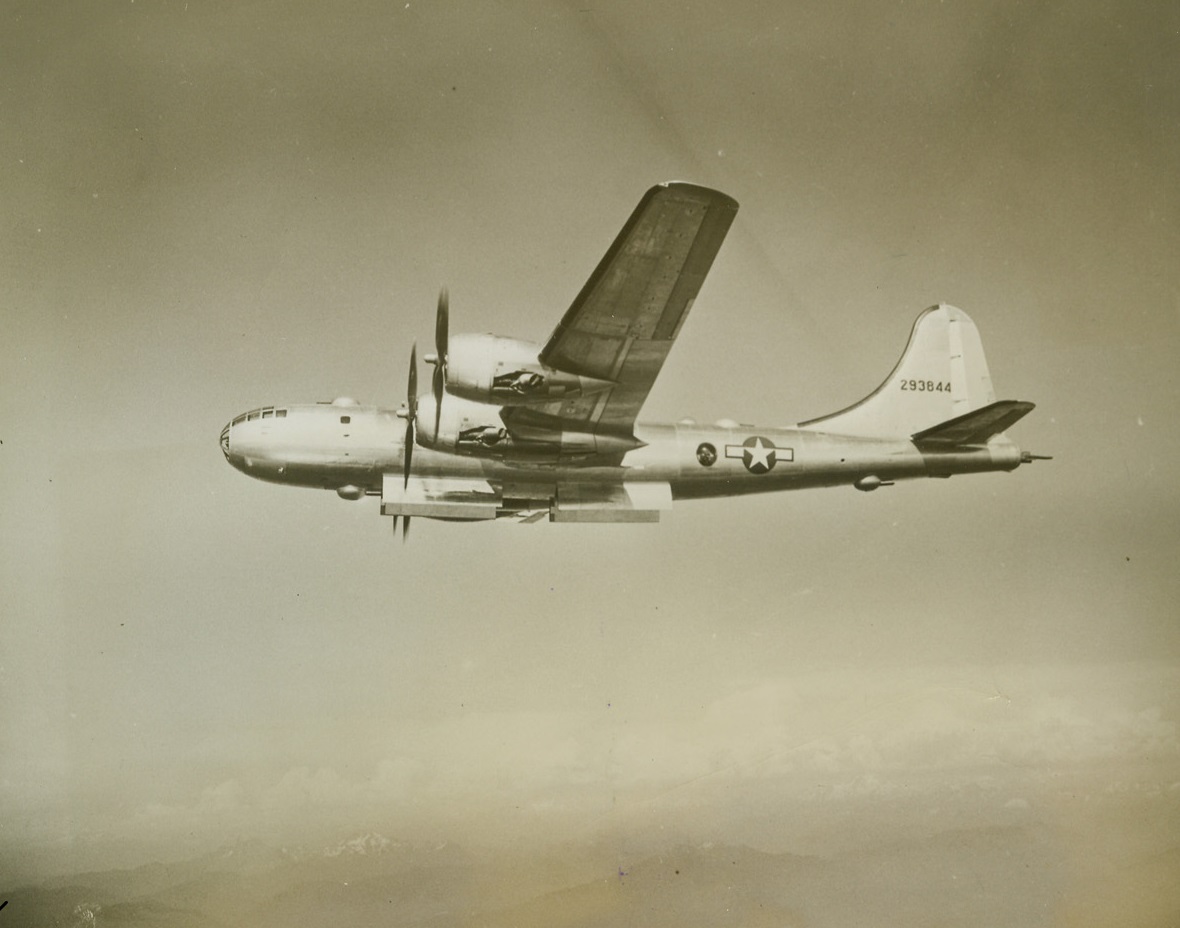
Superfortress Carries Five Gun Turrets, 9/8/1944. For the first time the gun positions on the Boeing Superfortress are shown. Five turrets, each with two .50 caliber guns, are placed at strategic positions on the bomber: upper-forward turret, lower-forward turret, upper-rear turret, lower-rear turret, and the tail-mount, which is also armed with a 20-mm. cannon. The fire-control system makes possible the operation of all guns by gunners in different parts of the bomber, with an electrical control that makes for instantaneous and heavy concentration of fire on any target. Credit: ACME;
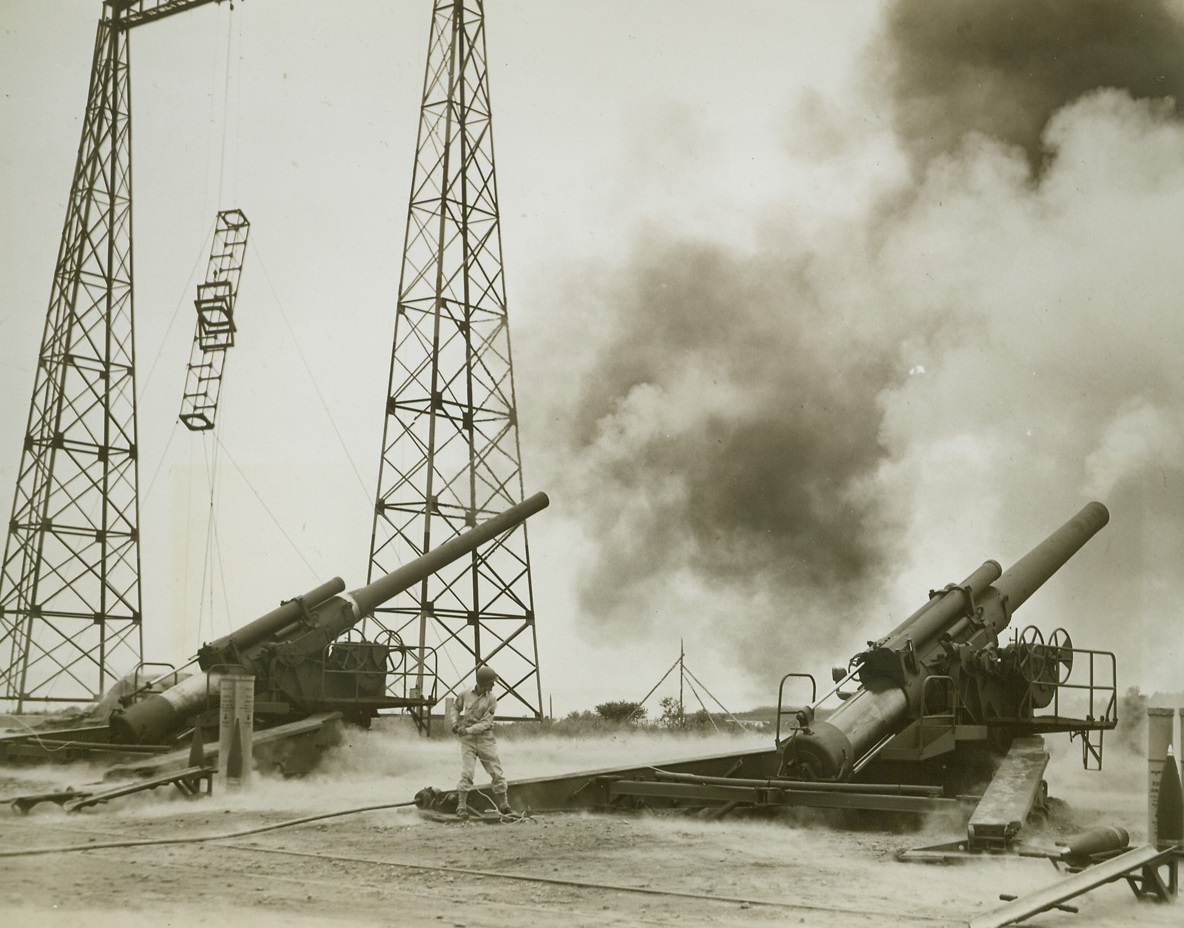
Weapons Tested at Aberdeen Proving Grounds, 9/1/1944.Aberdeen, Maryland -- In a test demonstration at Aberdeen Proving Ground, a 240mm Howitzer (right) and an 8-inch gun fire away amid a dense cloud of smoke from their shells. The test, held on August 29, 1944, demonstrated new weapons that have been developed at the Proving Ground for use by our Armed Forces. Credit: ACME;

LE BOURGET AIRPORT BATTERED, 9/3/1944. PARIS – Le Bourget airfield, world-famous Paris flying field, battered as the allies advanced to liberate it from the Germans, lies a mass of wrecked hangars and buildings. The field itself is rutted in places where shells landed. On the right the tail of a wrecked Messerschmitt 110 just out. Credit: Acme;
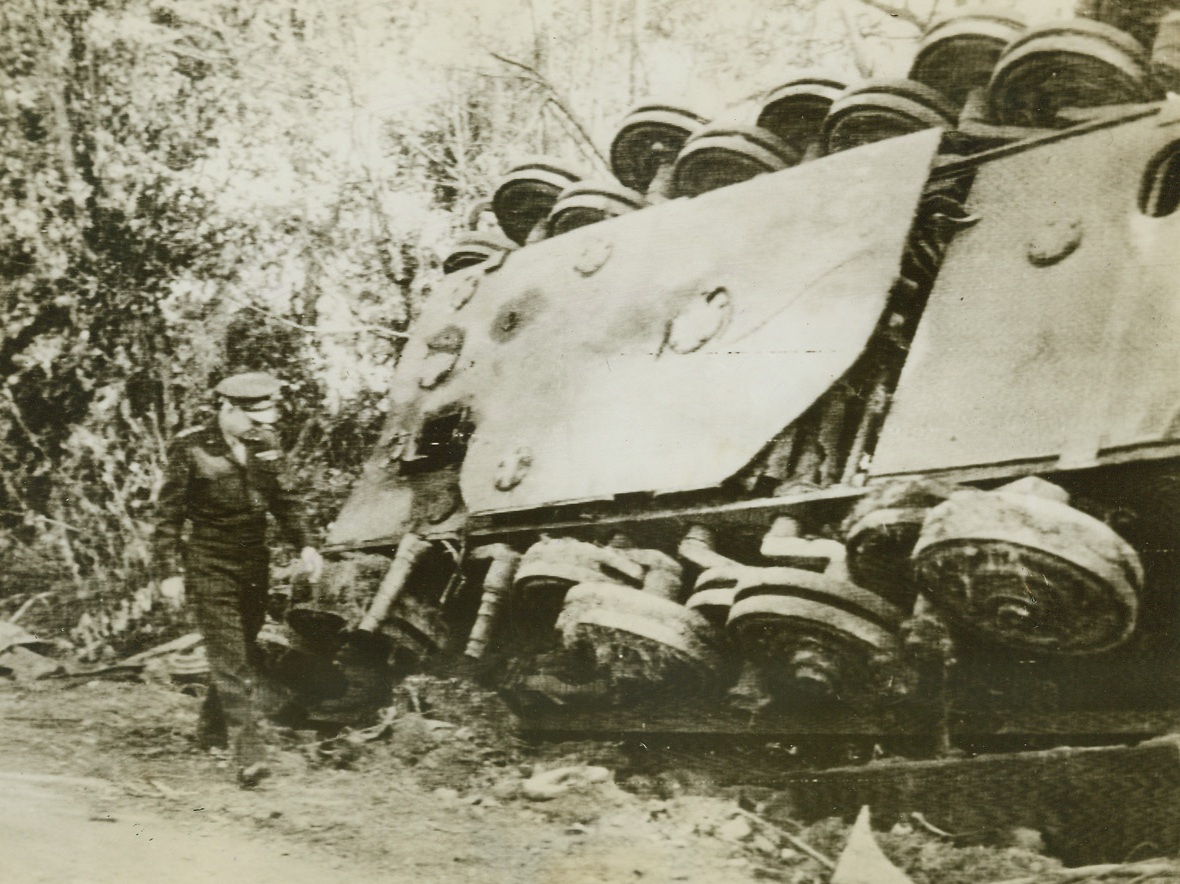
“IKE” INSPECTS THE WORK OF HIS MEN, 9/3/1944. FRANCE – Gen. Dwight D. Eisenhower, supreme commander of the Allied expeditionary forces, inspects an overturned German tank left by a roadside in France by the retreating enemy.Credit: Acme;
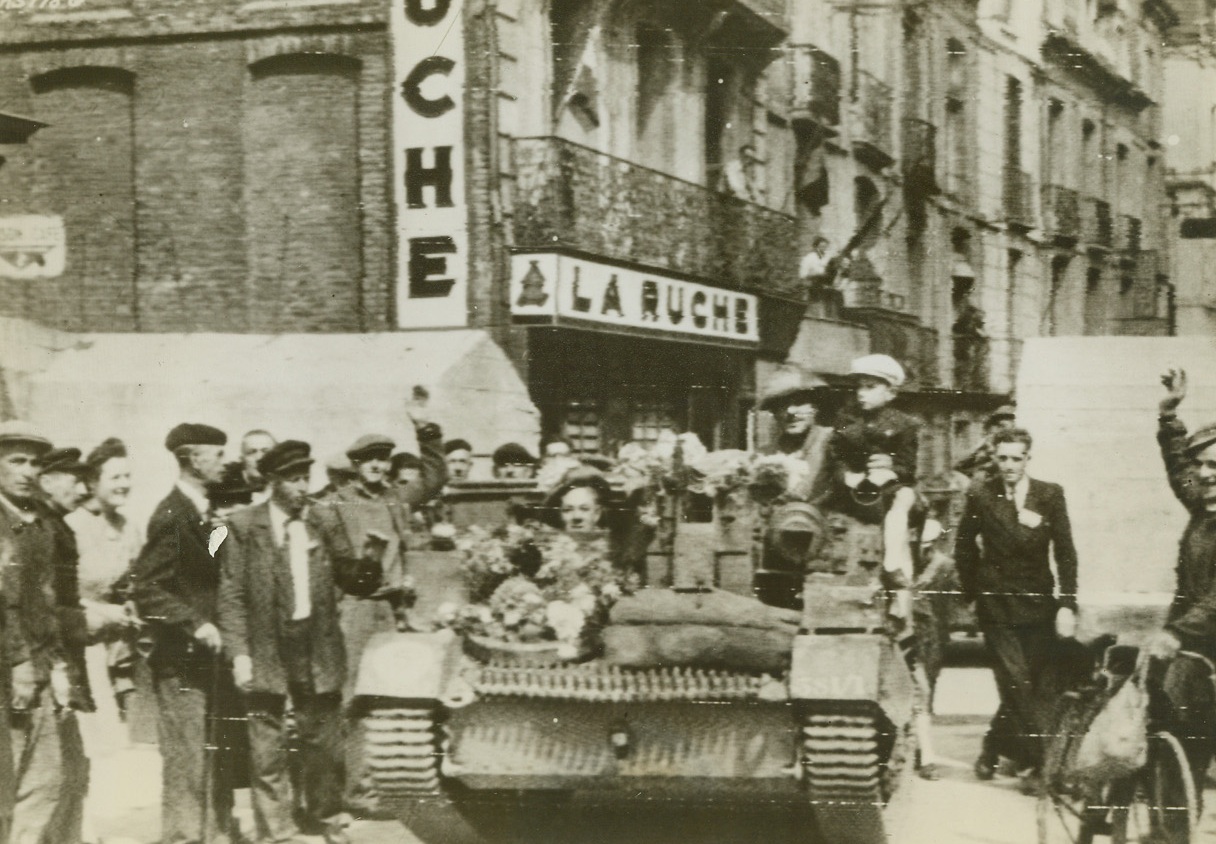
NO PAUSE FOR ONRUSHING CANADIANS, 9/5/1944. DIEPPE, FRANCE – A Canadian carrier, with flowers decorating its front, passes through a road block in Rue De La Barre, Dieppe. Inhabitants cheer the soldiers, who, without so much as a halt, swept on to Le Treport and Abbeville.Credit: Acme;
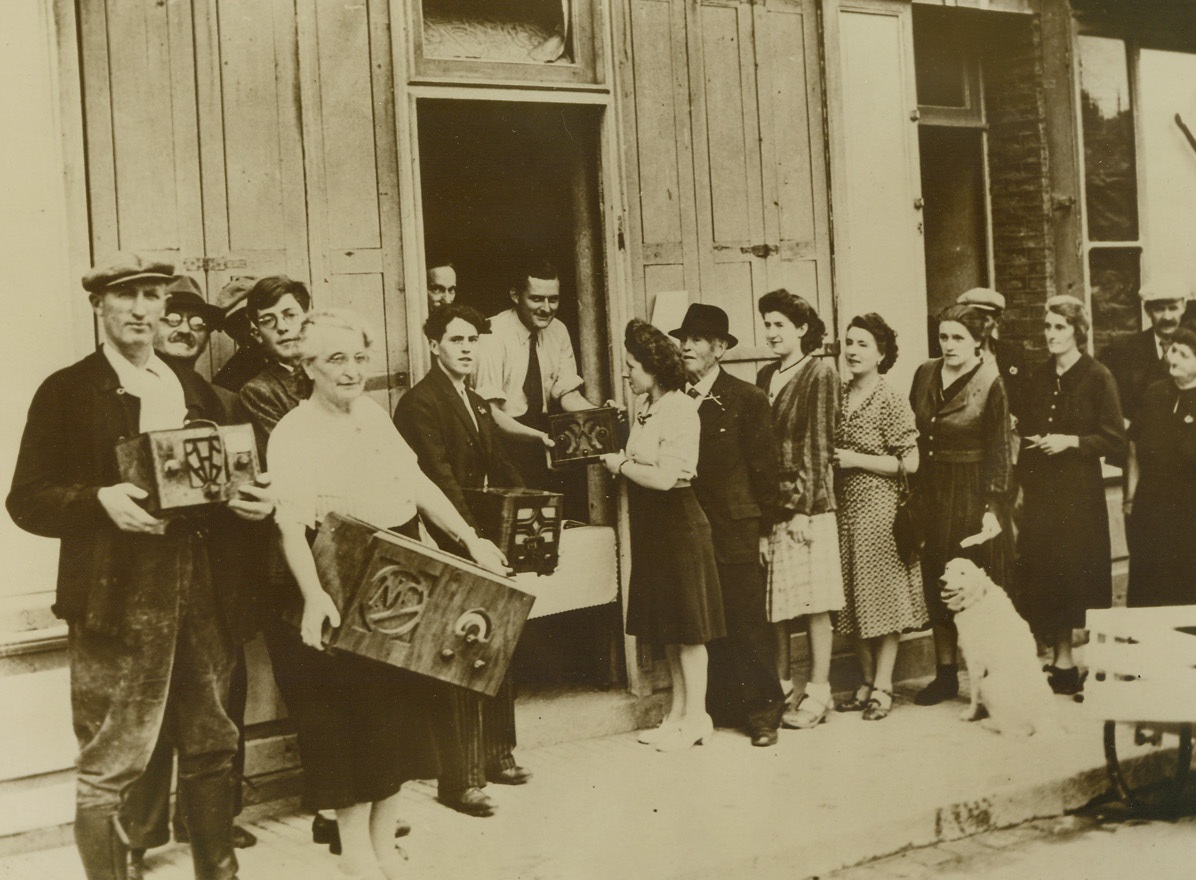
CONFISCATED RADIOS RETURNED, 9/5/1944. FRANCE—When the Germans were in the saddle in France, it was a crime punishable by death to listen to an allied broadcast. Then, too, all radio sets were confiscated by the occupation authorities. Here, at Villier Sur Mer, near the mouth of the Seine, residents reclaim their confiscated radios after liberation by the British. Local French authorities broke into the German storehouse and distributed the sets to claimants who could establish proof of ownership.Credit: Acme;
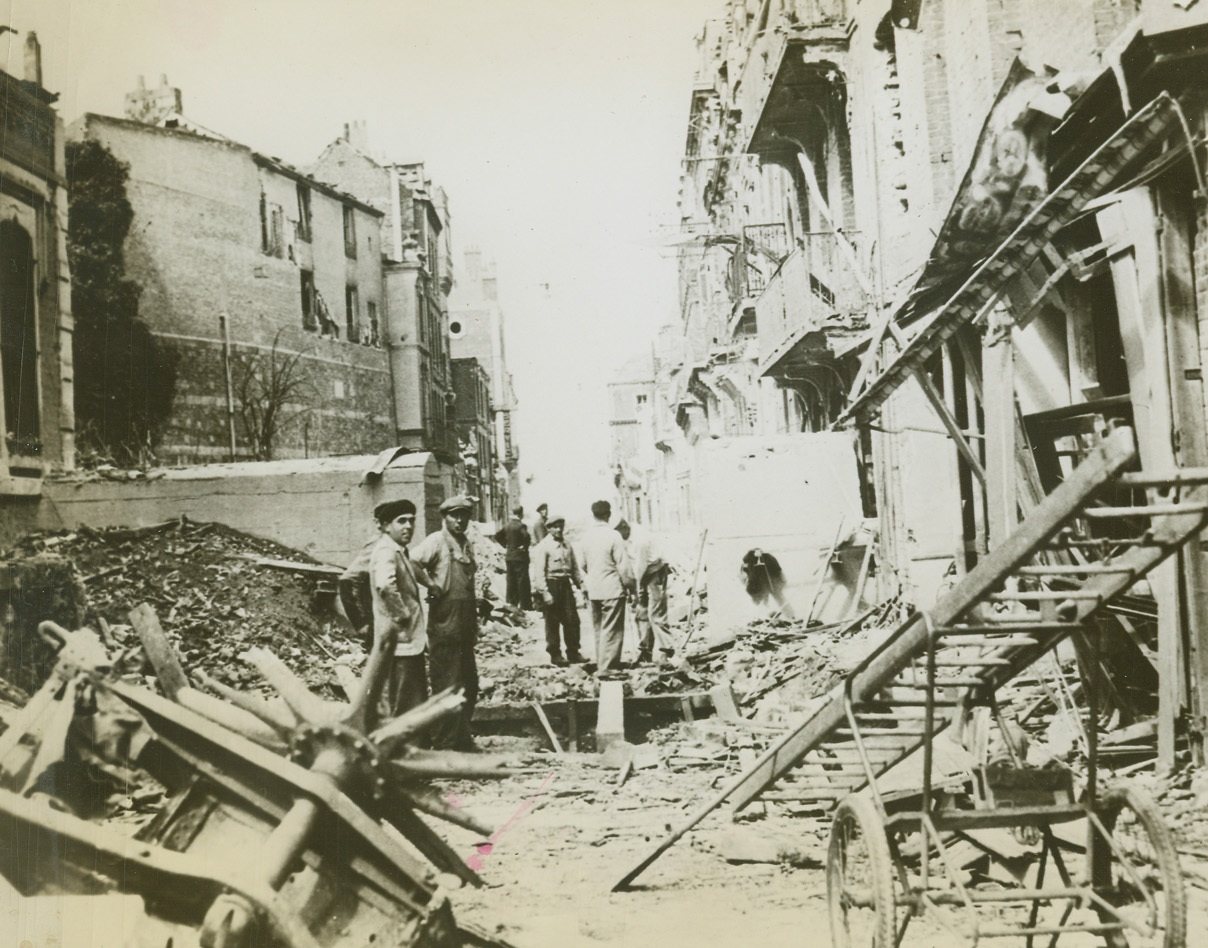
FRENCHMEN OPEN ROAD FOR ALLIES, 9/5/1944. FRANCE – With the Hun beaten and retreating, French citizens of Dieppe clear a road block in the city to open a path for Canadian troops advancing along Northern France.Credit – WP – (Acme);

YANK INFANTRY COLUMN ENEMY TARGET, 9/5/1944. FRANCE – An American soldier dashes for cover as vehicles of U.S. column become target for Nazi guns in Brest, France. Smoke from near or direct hits on the column fills the area.Credit: Signal Corps photo from Acme;
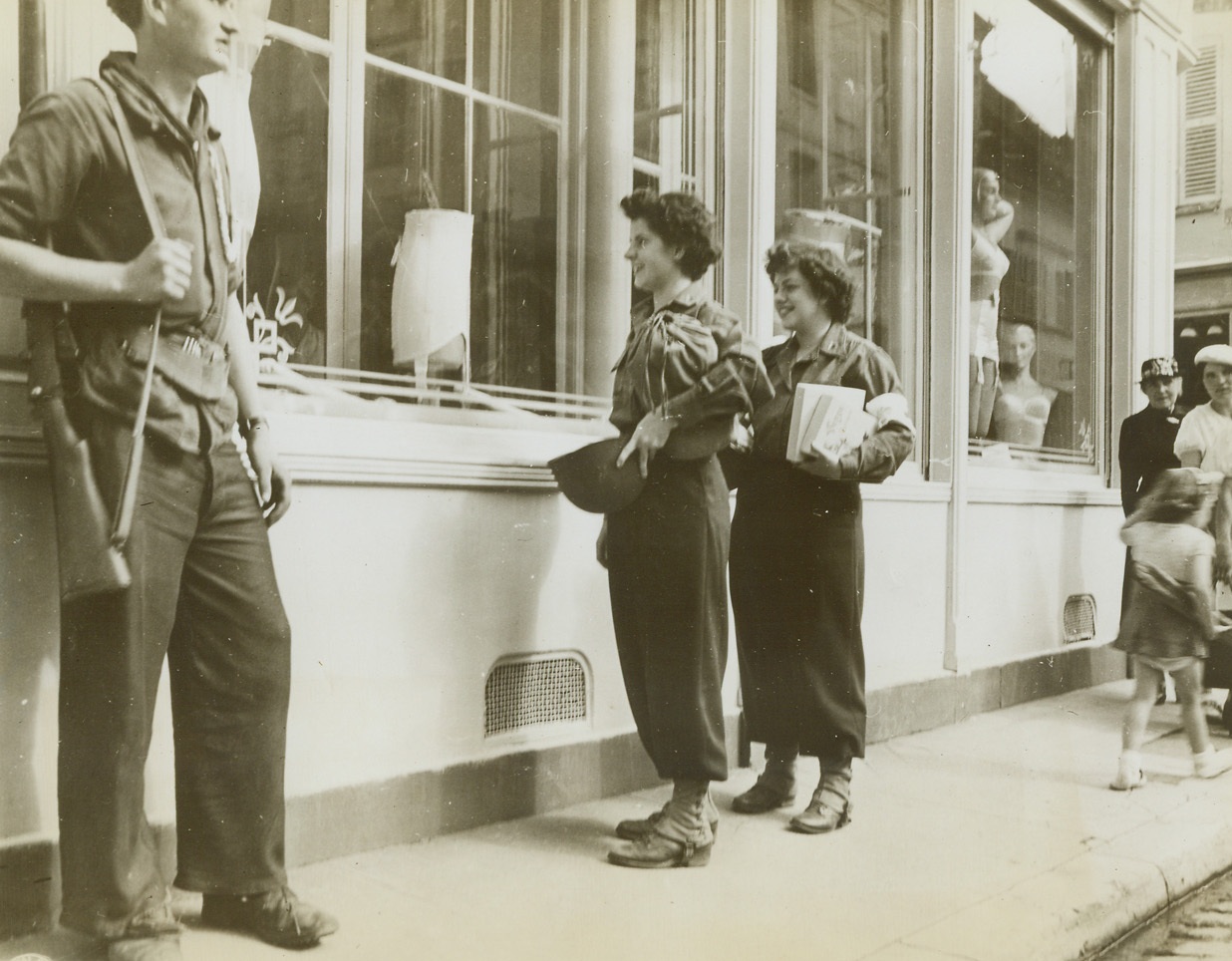
AND PRE-WAR RUBBER, TOO, 9/5/1944. FRANCE – Lt. Margaret Weston, Steubenville, O., and Lt. Patricia Sheridan, Cleveland, O., 80th Army nurses, do a bit of window shopping in Sens, France. And that’s not a bad looking number, either.Credit: Signal Corps photo from Acme;
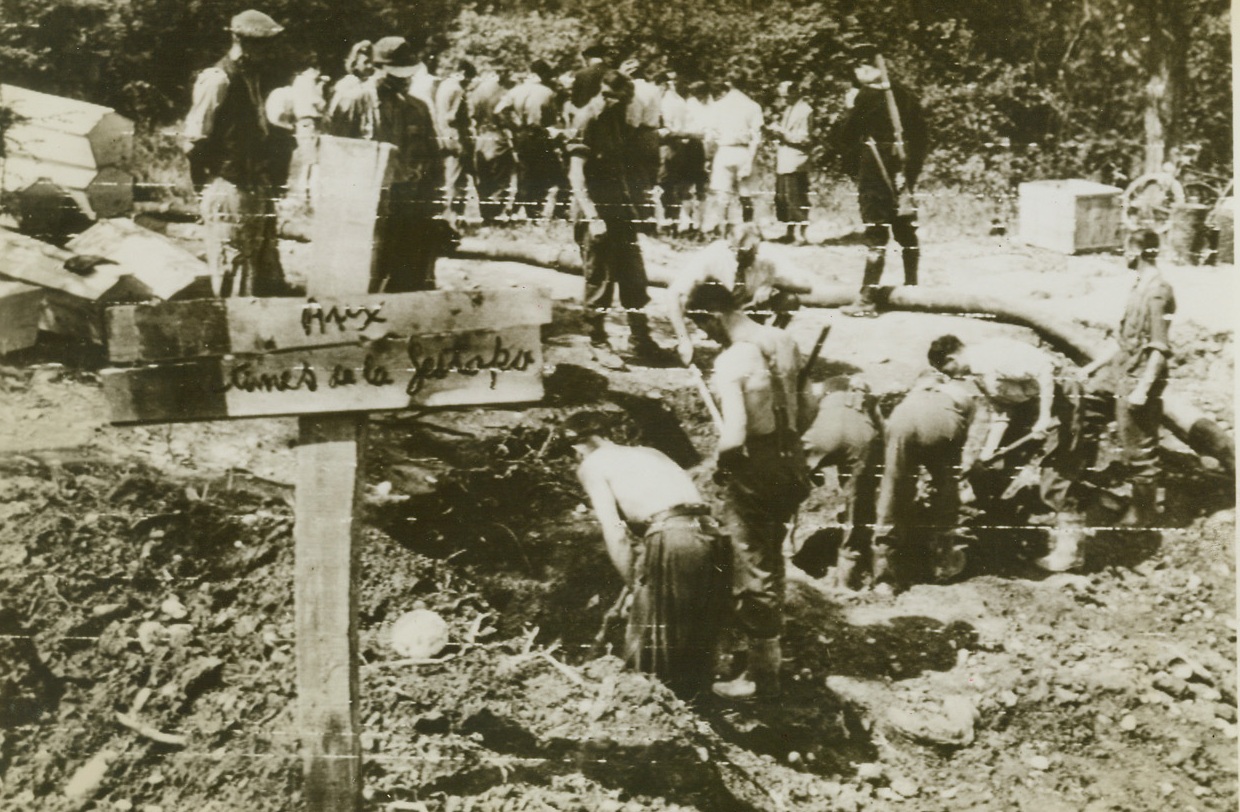
PRISONERS DIG FOR GESTAPO VICTIMS, 9/4/1944. GRENOBLE, FRANCE – German prisoners dig in old bomb craters, hunting for the bodies of 72 Frenchmen who were killed by the Gestapo in Grenoble during the city’s occupation. A crude cross inscribed “to the victims of the Gestapo” marks the grave of the murdered.Credit: Signal Corps Radio Telephoto – Acme;
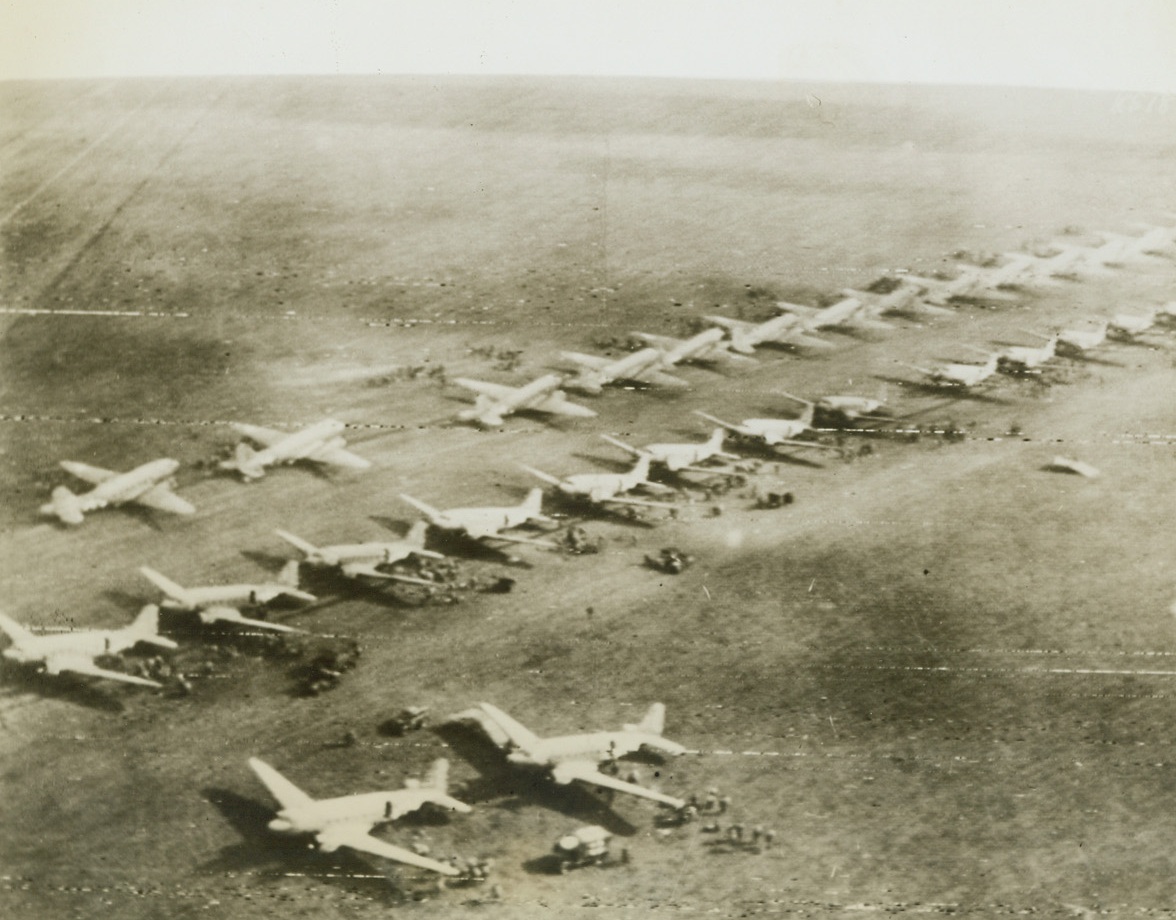
INVASION LINEUP, 9/18/1944. ENGLAND – Part of the mighty air armada that carried invading Yanks to Holland, these C-47 transports sit in orderly rows, awaiting their signal to soar. Like tiny black dots on the airfield in England, paratroopers and ground crewmen scurry about the big warbirds as last-minute details are attended to.Credit: Signal Corps radio telephoto from Acme;

YANK AND FRENCH FORCES CAPTURE LYON, 9/3/1944. This is a general view of Lyon, the third city of France, which was reported captured by American and French forces yesterday (Sept. 2). Street fighting is still reported in progress in the city which the Germans, by blowing up nine of the ten bridges across the Rhone and Saone rivers, had divided into three sections. The virtual capture of Lyon meant that in the past 12 days the Allied armies and the Maquis had liberated the first five cities of France – Paris, Marseille, Lyon, Bordeaux, and Nice.Credit: Acme;

SCUTTLED WARSHIPS, 9/3/1944. TOULON, FRANCE – Only the bridges and masts of this pair of French destroyers are visible as the scuttled ships lay side-by-side in Toulon harbor. The vessels were sent to the bottom by French patriots to prevent their seizure by the Nazis. Credit: Army radio telephoto from Acme;
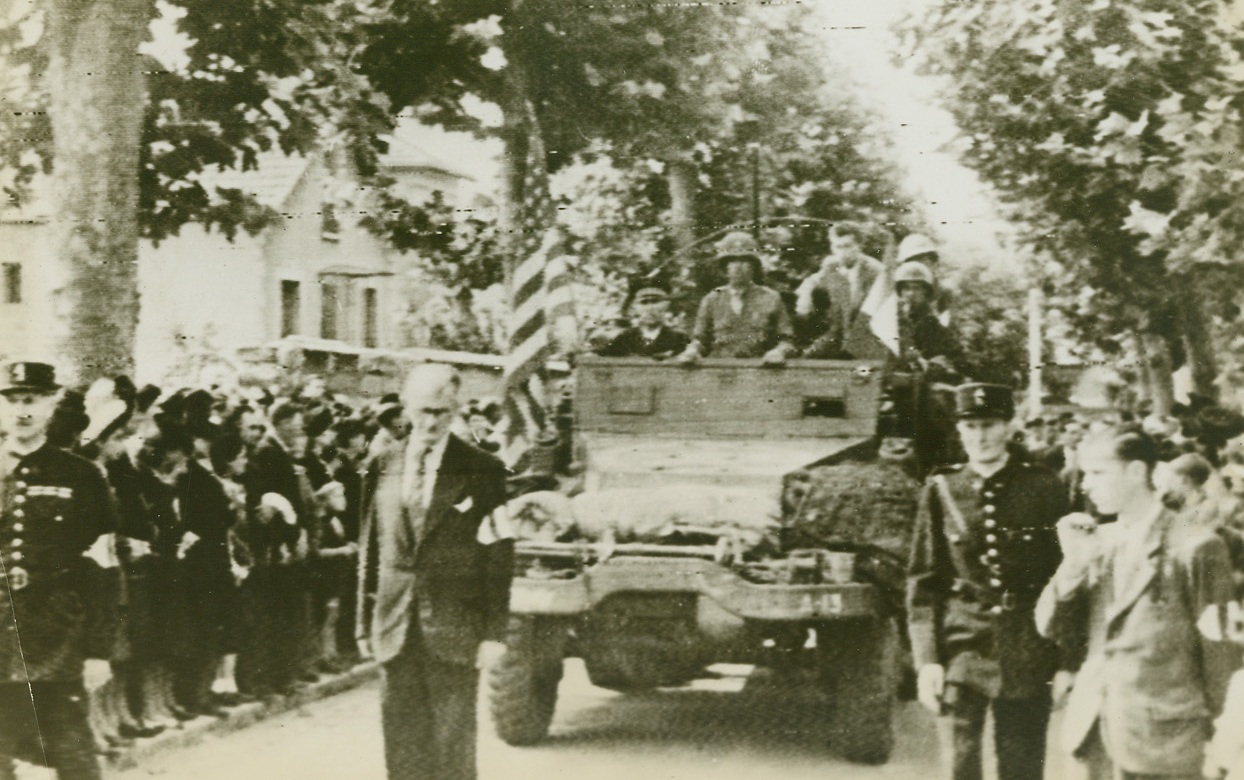
FUNERAL FOR FRENCH PATRIOTS, 9/1/1944. FRANCE – An American armored vehicle leads the funeral procession for twenty-seven French Maquis who were executed en masse by the Germans in St. Pol De Leon. The victims’ eagerness to free their beloved homeland led them to attack the German garrison prematurely, and thus meet their death.Credit: Signal Corps radio telephoto from Acme);
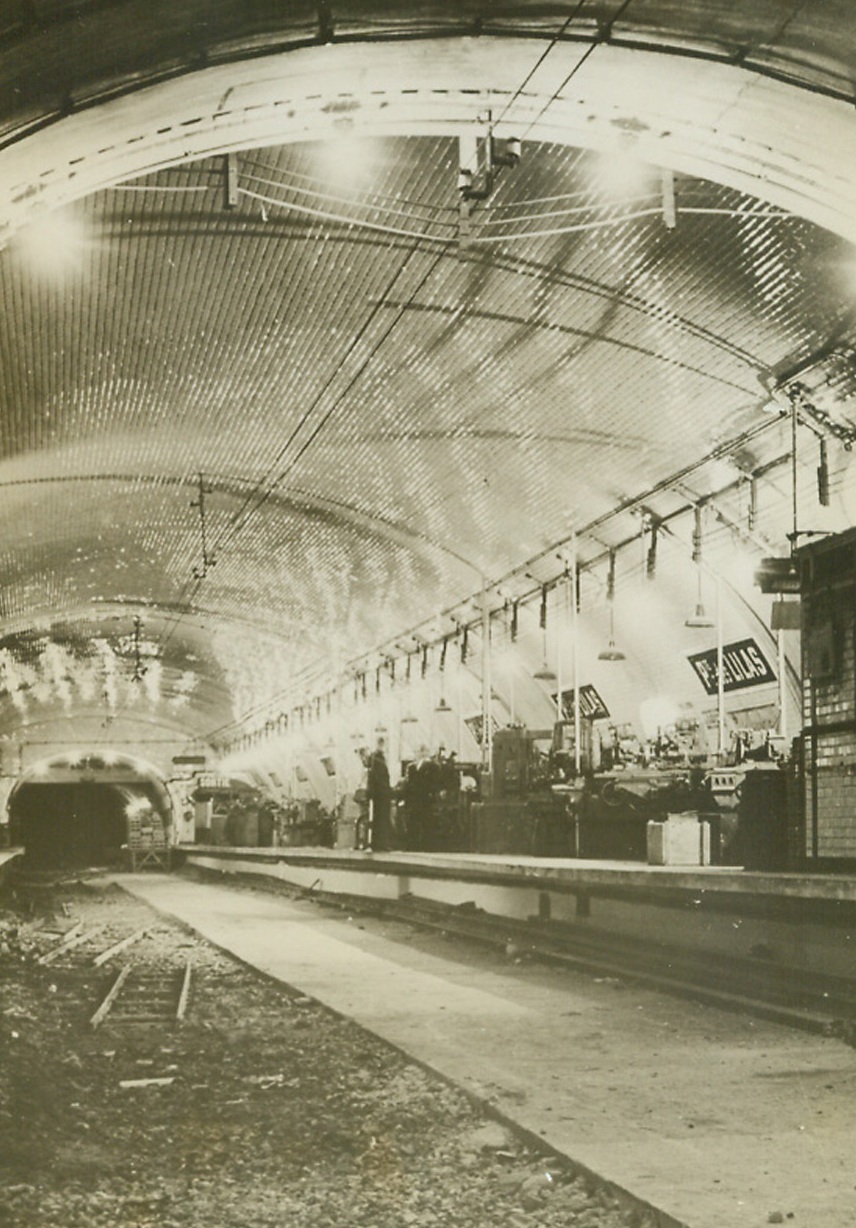
PARIS FACTORY SERVED AS NAZI FACTORY, 9/23/1944.FRANCE – During aerial attacks on the French capital, German officials sealed off the two and one-half miles of the Paris subway system and moved the remnants of the German aircraft industry in that area into this shelter deep underground. With the taking of Paris officials discovered $15,000,000 worth of machines to make propeller crankshafts in the Porte of Lillas station. This is a view of the subway with the vital machines on a platform at right and concrete laid along one-half of the area formerly occupied by tracks.Credit: Acme;
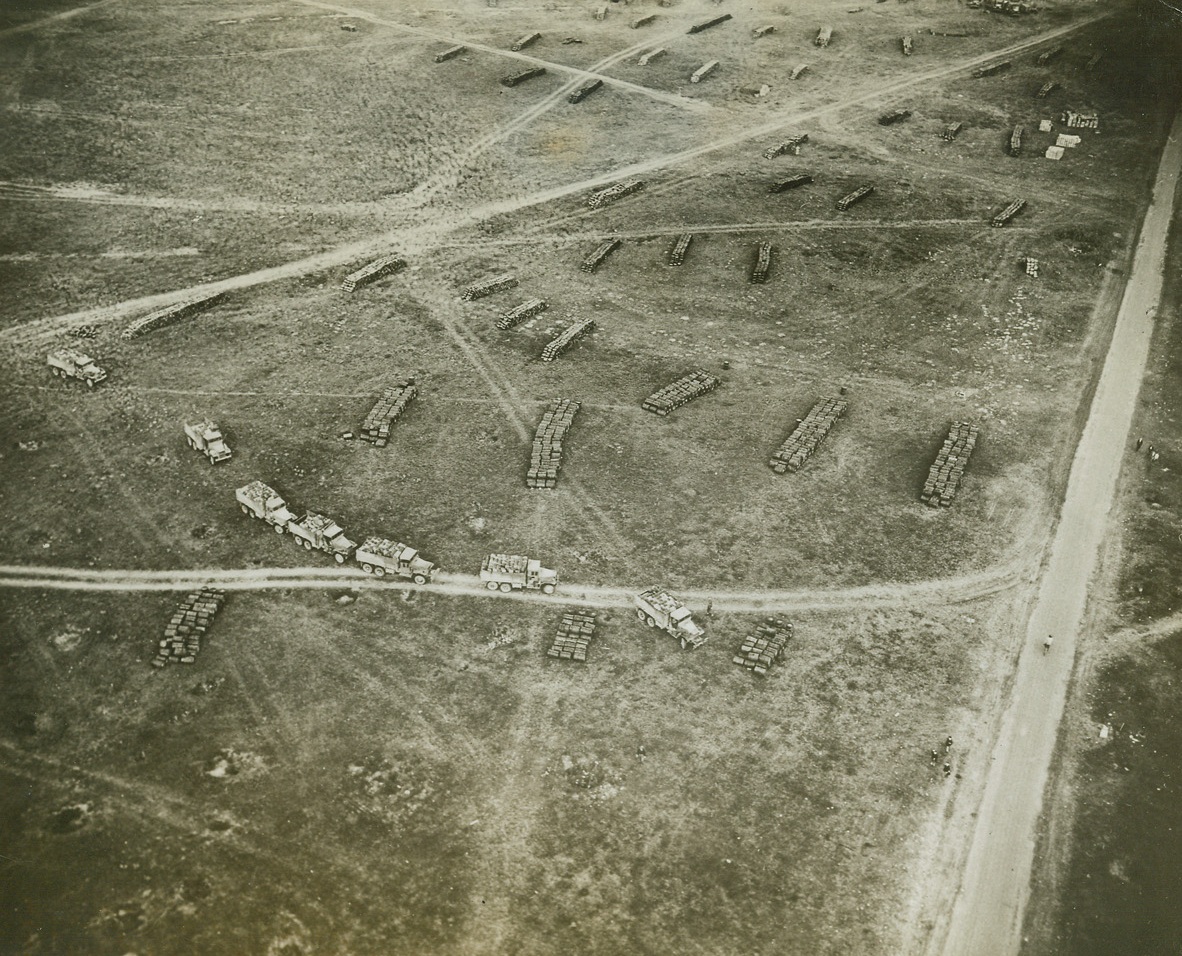
ALLIES ON THE MOVE, 9/23/1944. FRANCE – This air view of an ammunition dump in France gives a bird’s-eye view of the allied armies on the move. A line of trucks are collecting supplies to be transported to the front lines to keep pace with the rapidly-moving armor. Scattered over the ground are stacks of ammunition and supply crates waiting to be picked up. Credit: Acme;
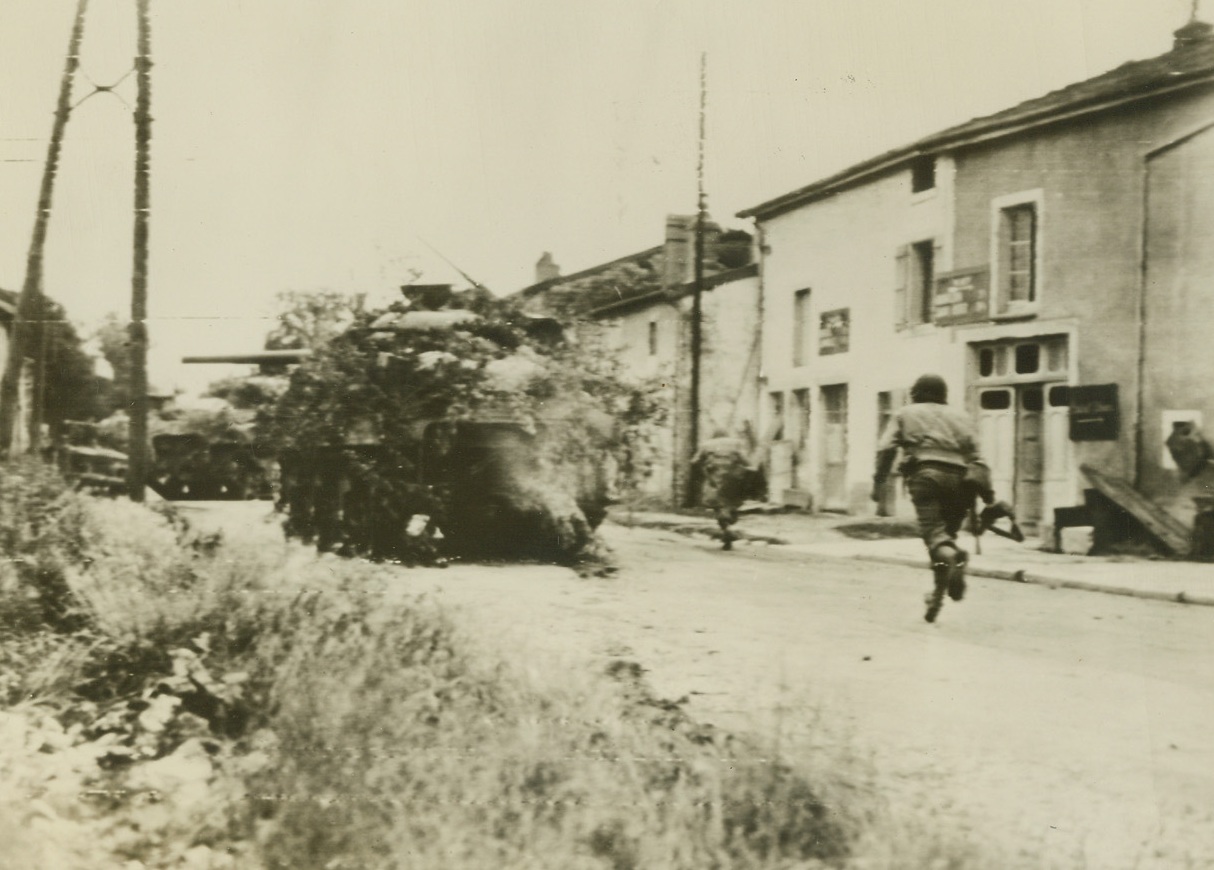
DUCK SNIPER FIRE, 9/7/1944. FRANCE—Infantrymen run for cover as German sniper fire breaks out from across the River Marne at Rachecourt. The camouflaged tank moves into position to protect bridge the Nazis tried to destroy. Credit (Army Radiotelephoto from ACME);
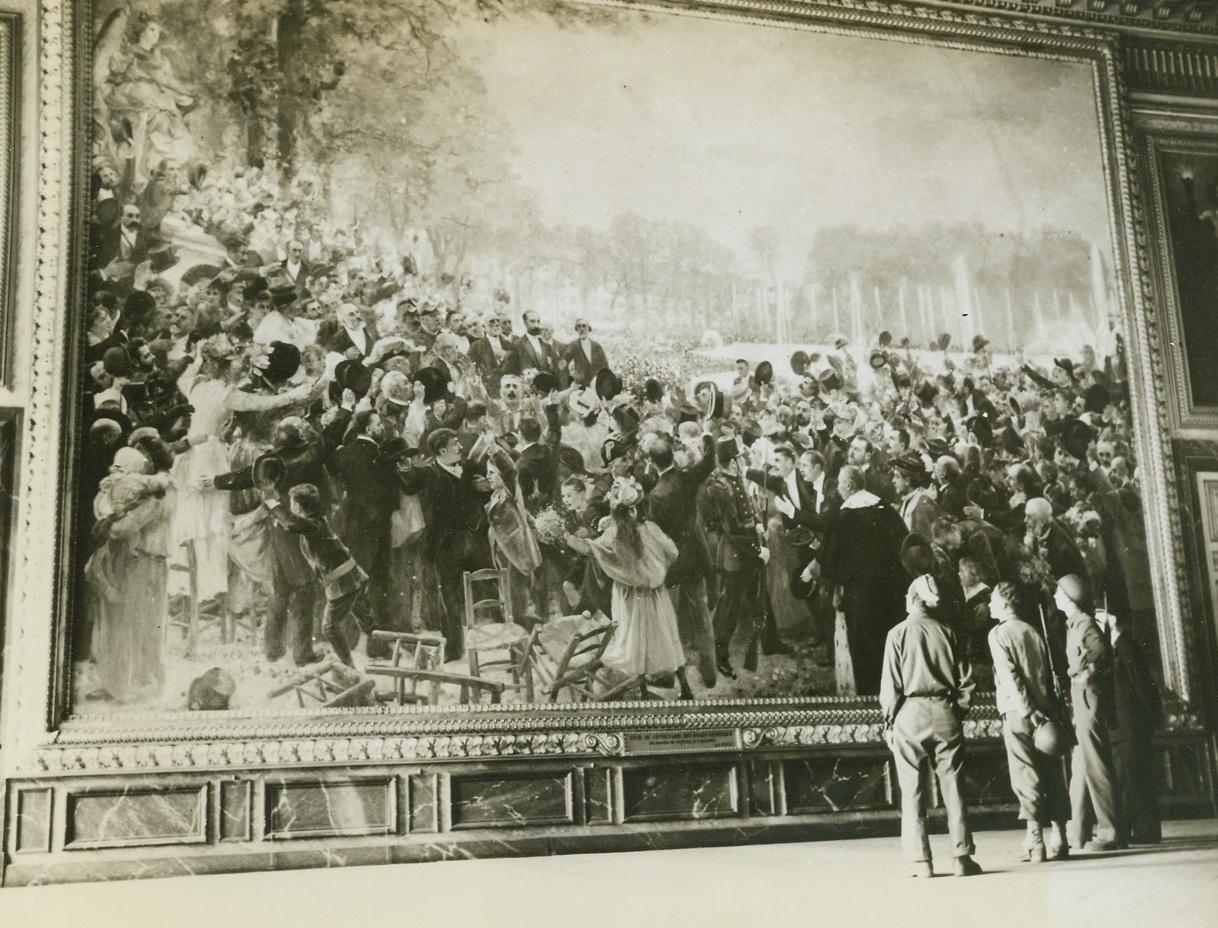
YANKS VIEW FRENCH ART, 9/1/1944. FRANCE—While a guard stands by, three American soldiers gaze with awe at the wall-size paining of the celebrations for the first president of the Republic of France in 1889 as they tour the Chateau de Versailles, Very similar to this painting were the scenes in Paris streets as the American forces entered the city to complete its liberation.;

NO TRIUMPH FOR THESE SNIPERS, 9/1/1944. PARIS—In the upper photo smoke clouds the top of the Arc de Triomphe in Paris, as German snipers opened fire on crowds assembled below for the parade of liberation. American soldiers (lower photo) below the Arch took shelter behind their vehicles, opened fire on the snipers until all were liquidated. Credit (ACME) (WP);

SNIPER BATTLE IN LYON, FRANCE, 9/6/1944. FRANCE—Crouched behind a wall along the Rhone River, Allied soldiers shoot it out with die-hard German snipers and Nazi sympathizers firing from a civilian hospital across the river. Battle began when snipers, hidden in the building after the city fell, opened fire on American engineers constructing a Bailey bridge to ford the waterway. Credit (Army Radiotelephoto from ACME);
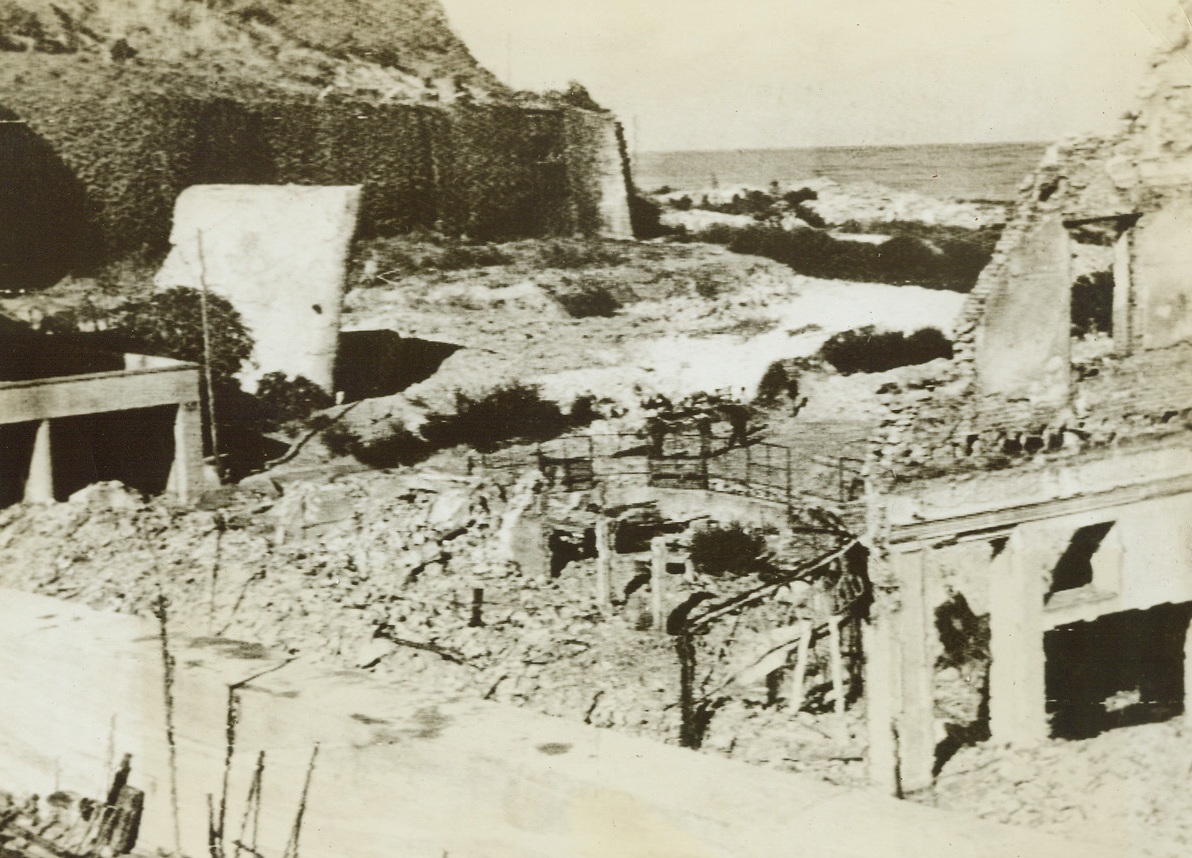
RIDING HIGH INTO THE DIEPPE, 9/5/1944. DIEPPE, FRANCE—This time the Canadian forces made their entry into Dieppe “stick” and as they returned victoriously to the city from which they had once been driven, they were able to see the west wall from the “business” side. This picture was taken from a rooftop facing the sea. Credit (Signal Corps Radiotelephoto from ACME);

TAKE NAZI PRISONERS AND ESCAPE VEHICLES, 9/13/1944. FRANCE—A German soldier emerges slowly from his hiding place under the pistol point guard of 1st Lt. John W. Upchurch of Chicago, Ill. Nazi had taken refuge in the cellar of a house in Oisulay, France. Bicycles were those stolen by Germans in futile effort to flee the advancing Allies. Credit (Army Radiotelephoto from ACME);
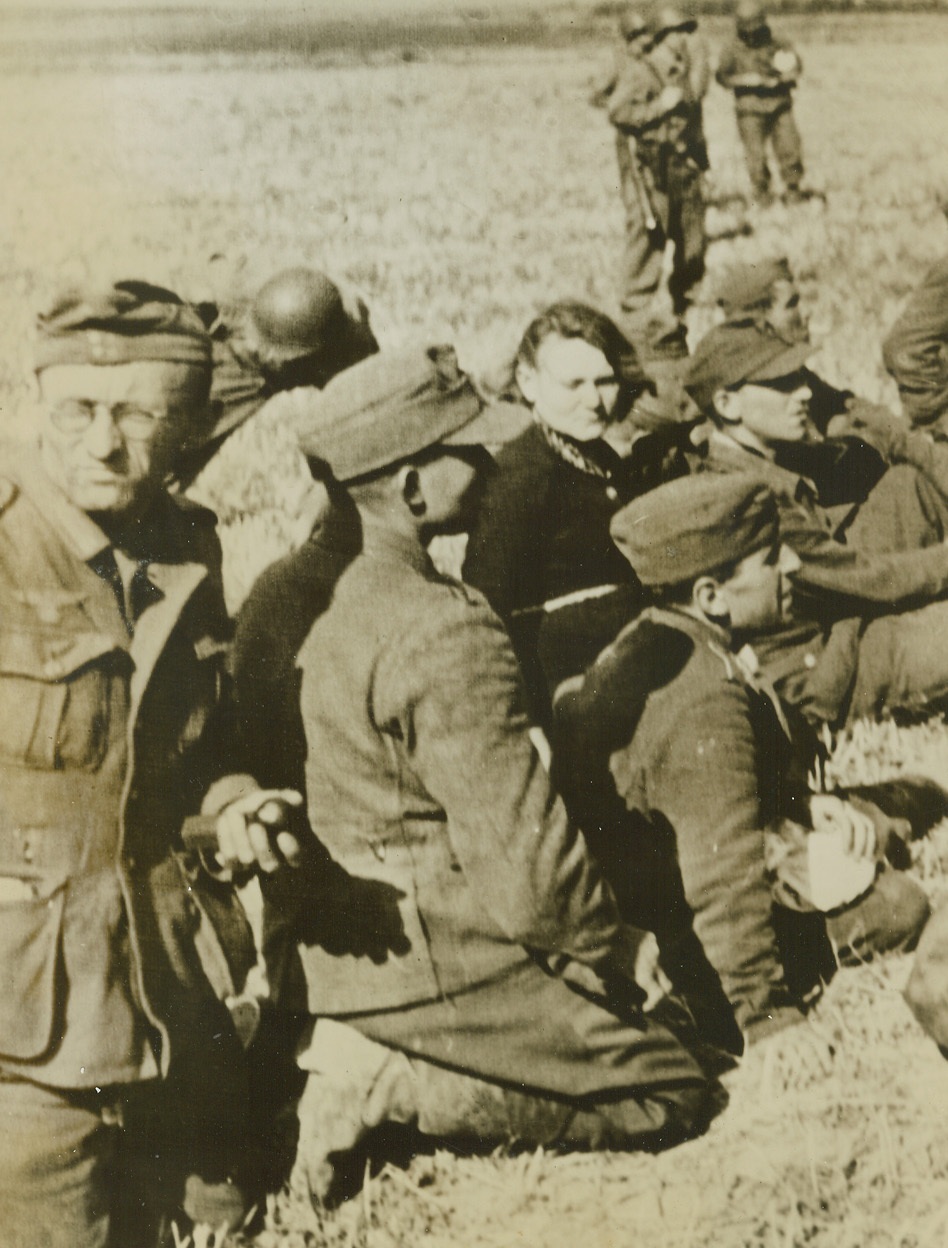
NAZIS AND GIRL FRIENDS PRISONERS, 9/8/1944. FRANCE—Taken prisoner by the small American force which captured the French city of Mons, Nazis and the women found with them are herded into a prison compound. Credit (Army Radiotelephoto from ACME);
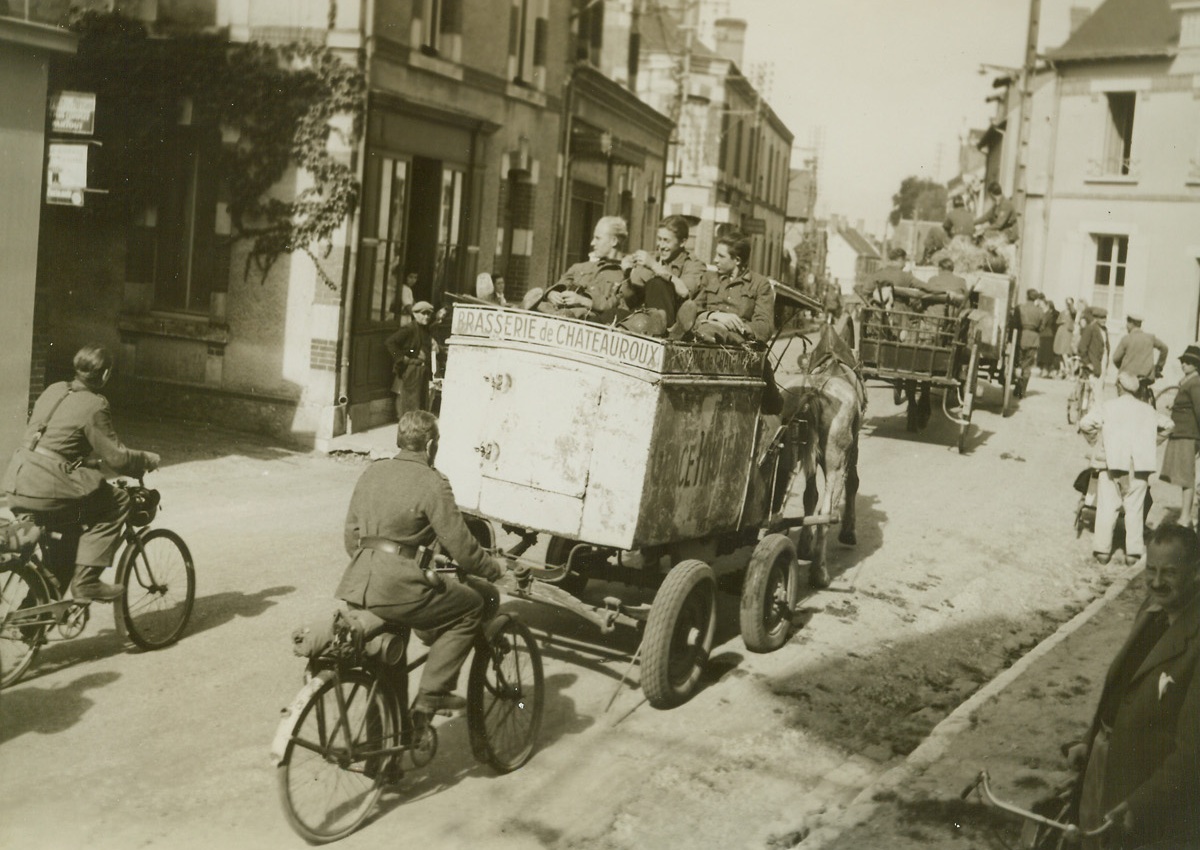
TAKE A RIDE TO PRISON, 9/23/1944. FRANCE—German soldiers ride on ice cream carts, bicycles and wagons as they head for Beaugency to give themselves up after surrender which led to the capture of 20,000 Nazis without the loss of a single American soldier. Photo by Acme photographer, Charles Haacker, for the War Picture Pool. Credit-WP-(ACME);

Allied Armies Meet in France, 9/16/1944. Army, leans out of his tank to greet Cpl. Carl Newman of Gen. Patton’s 3rd Army as the two Allied Forces meet somewhere in France. Newman is a Brooklyn boy. Credit: Army Radiotelephoto;
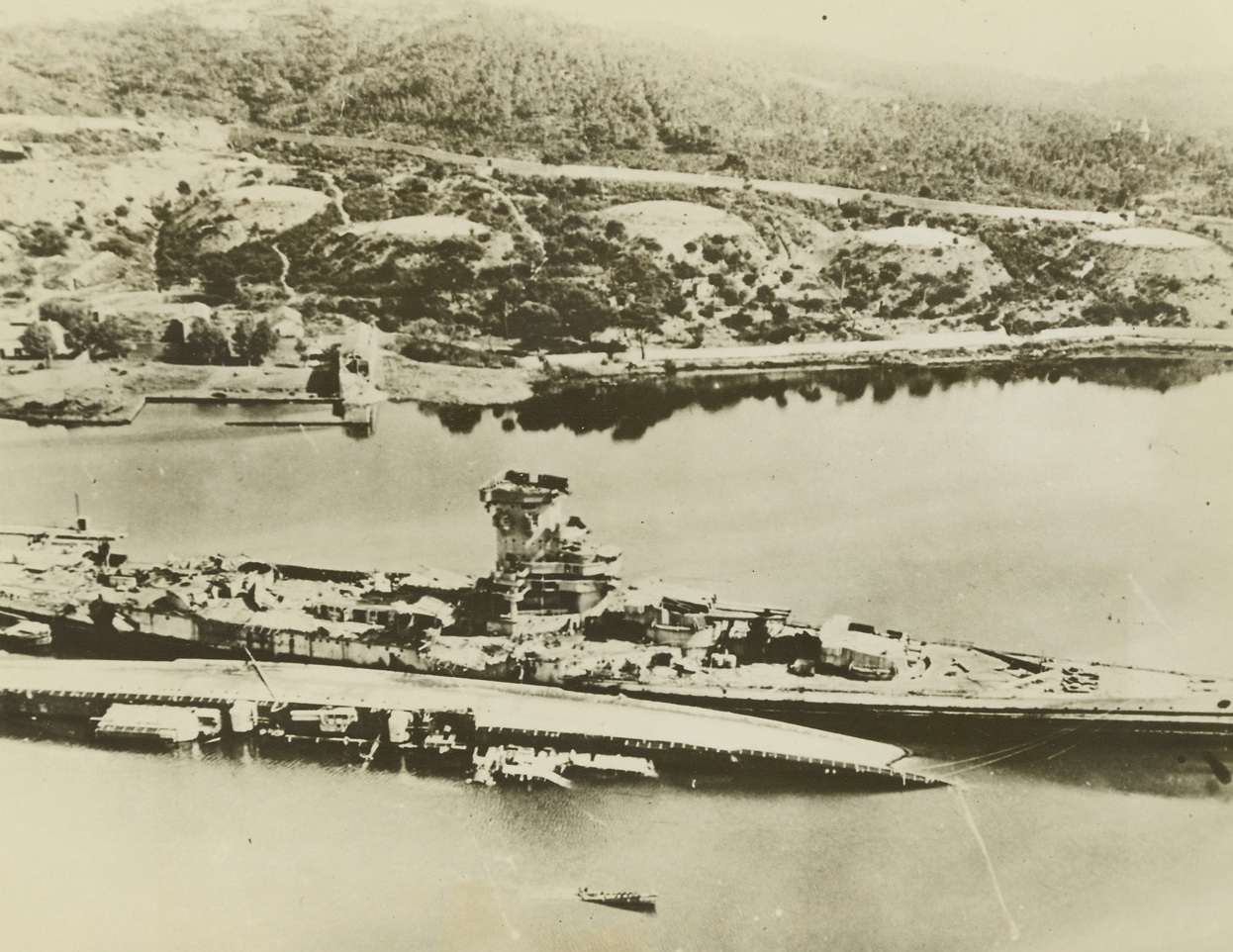
Battleship Strasbourg Silenced, 9/15/1944. France -- To silence the big guns of the former French battleship Strasbourg, which had been shelling forward elements from the invasion of southern France, bombers of the Mediterranean Allied Air Forces dropped a devastating concentration of bombs on the 702-foot vessel in the harbor of Toulon, causing many fires and explosions. The wrecked hulk of the ship is shown in the harbor near shore. In the foreground lies a capsized cruiser. Credit: USAAF photo from ACME;
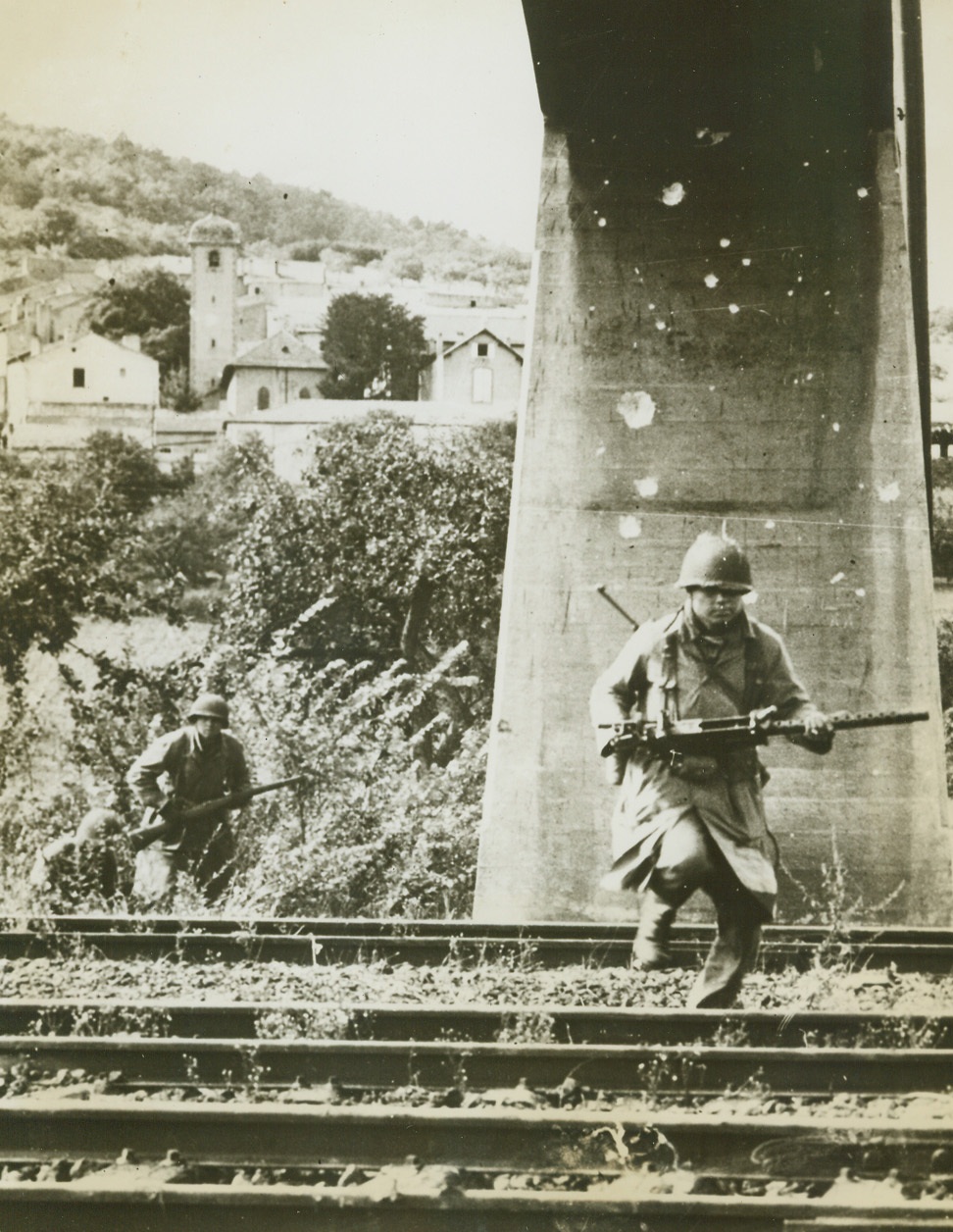
Enemy Fire No Obstacle, 9/13/1944. France -- American infantrymen dash across a railway near Metz, France, close to the German border. They crouch low to escape Nazi fire. Note the bullet-pocked pylon behind the foremost Yank. Credit: Signal Corps photo from ACME;
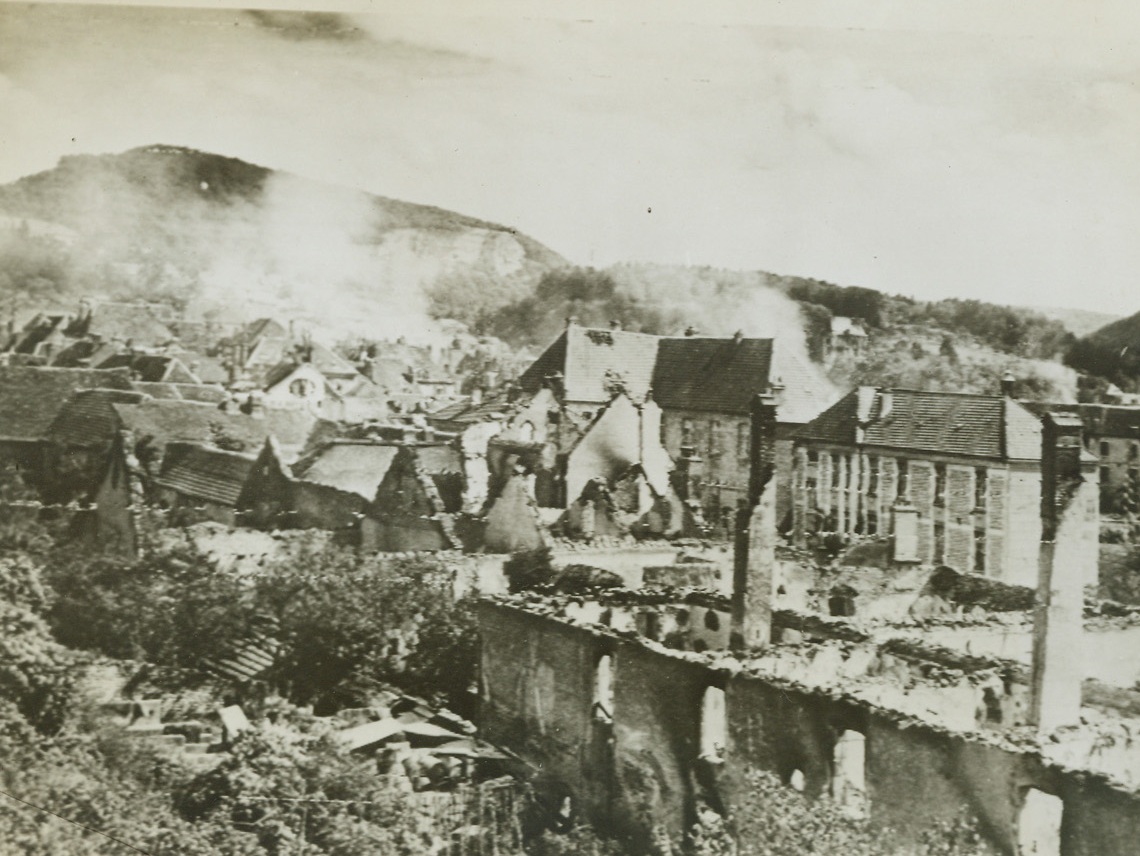
Now It’s the Nazis’ Turn, 9/13/1944. France -- Withdrawing in the face of relentlessly advancing Allied forces, German troops are reverting to the scorched earth policy in many sections of France. Buildings were gutted and still burning in the town of Baume les Dames as American troops entered hot on the heels of the retreating Nazis. Credit: Army photo from ACME;

Jewish Services in Paris Again, 9/13/1944. France -- French Jews pack a synagogue in Paris to worship at the first openly conducted Hebrew services in the liberated French capital since the Nazis closed the synagogue four and one-half years ago. Credit: Army photo from ACME;
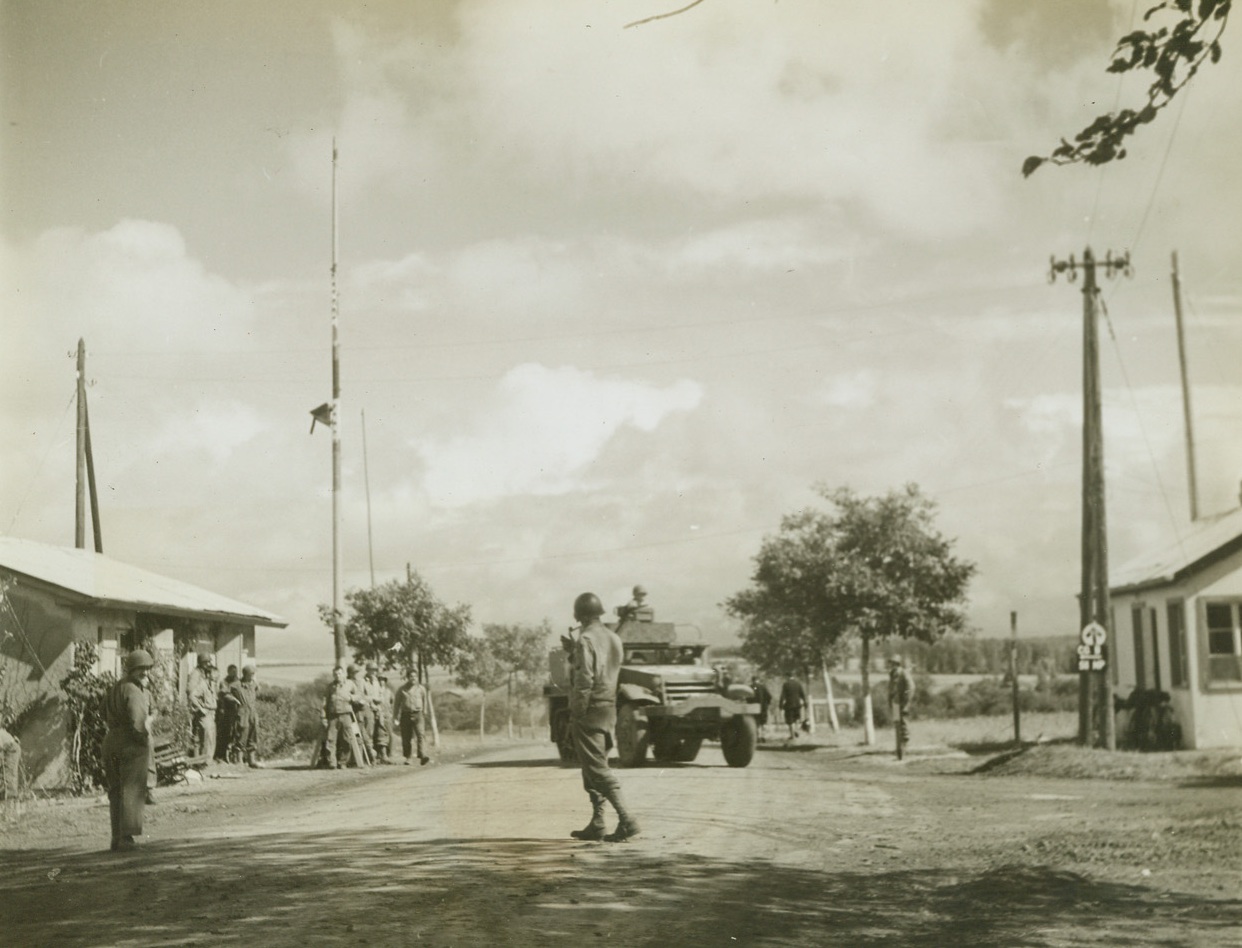
Americans Cross Frontier into Lorraine, 9/15/1944. Lorraine -- Yank soldiers have lifted the border-barriers from France into Lorraine and an American half-track moves across into the province. Until 1918 Lorraine was a part of France. It was then seized by the Germans in World War I. In 1940 Hitler’s forces marched into the French province and reestablished the frontier barriers between France and Lorraine. Credit: ACME photo by Bert Brandt, War Pool Correspondent;

Allied Planes Stripped by Germans for Parts, 9/15/1944. Paris, France -- In this bombed hangar near Paris, the Germans kept downed Allied planes so that parts could be salvaged for their own aircraft. Spitfires and a P-47 Thunderbolt can be seen, partially stripped. Credit: ACME photo by Charles Haacker, War Pool Correspondent;
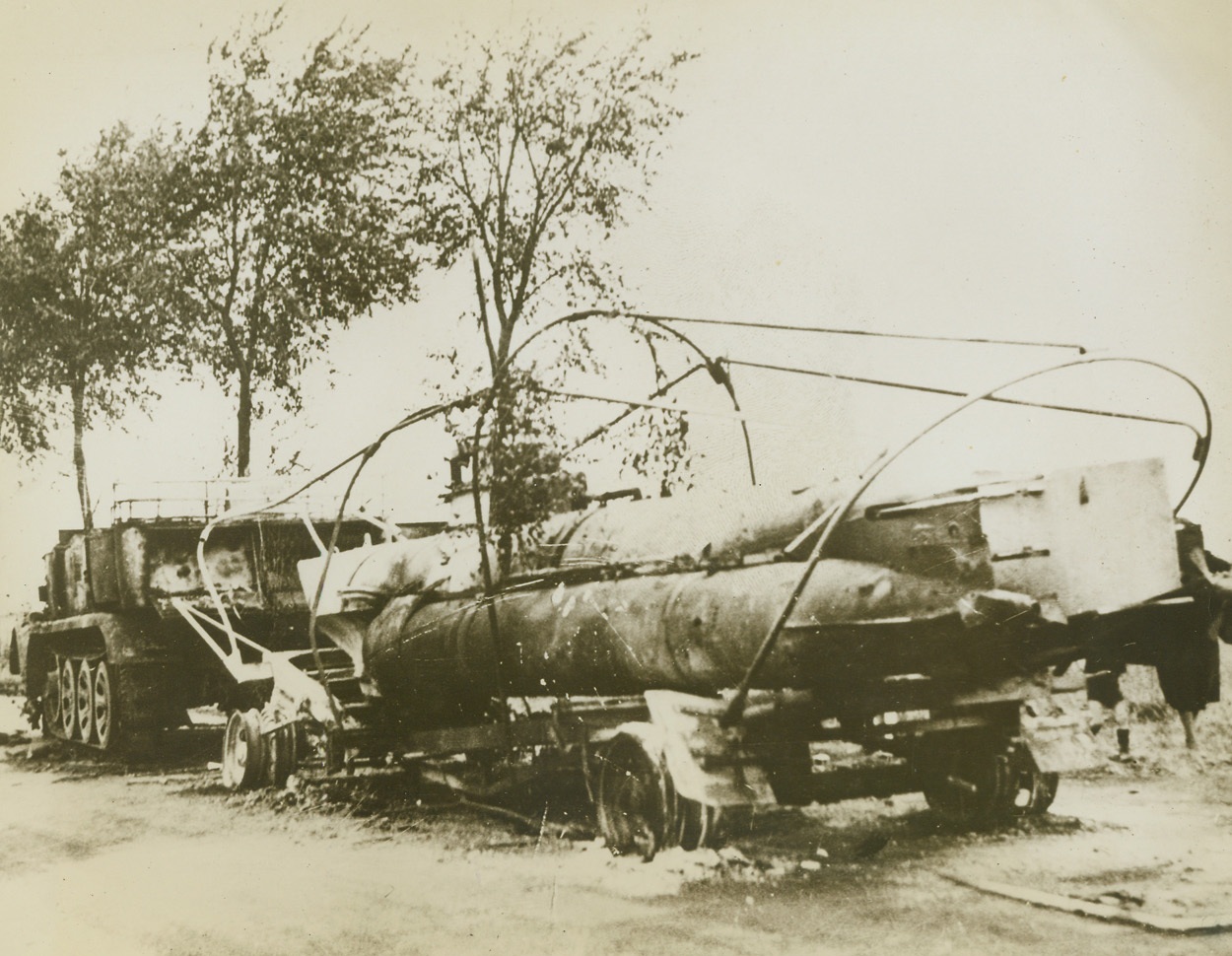
Safer on Land, 9/13/1944. Arras, France -- Apparently convinced that their subs are more safe on land than at the mercy of accurate Navy guns, the Nazis were carrying this midget submarine in overland flight when the British stopped them. Abandoned on a bombed-up road leading to Arras, the vessel still carries two unexploded torpedoes. This is a British official photo and has been passed by the British censor. Credit: ACME;
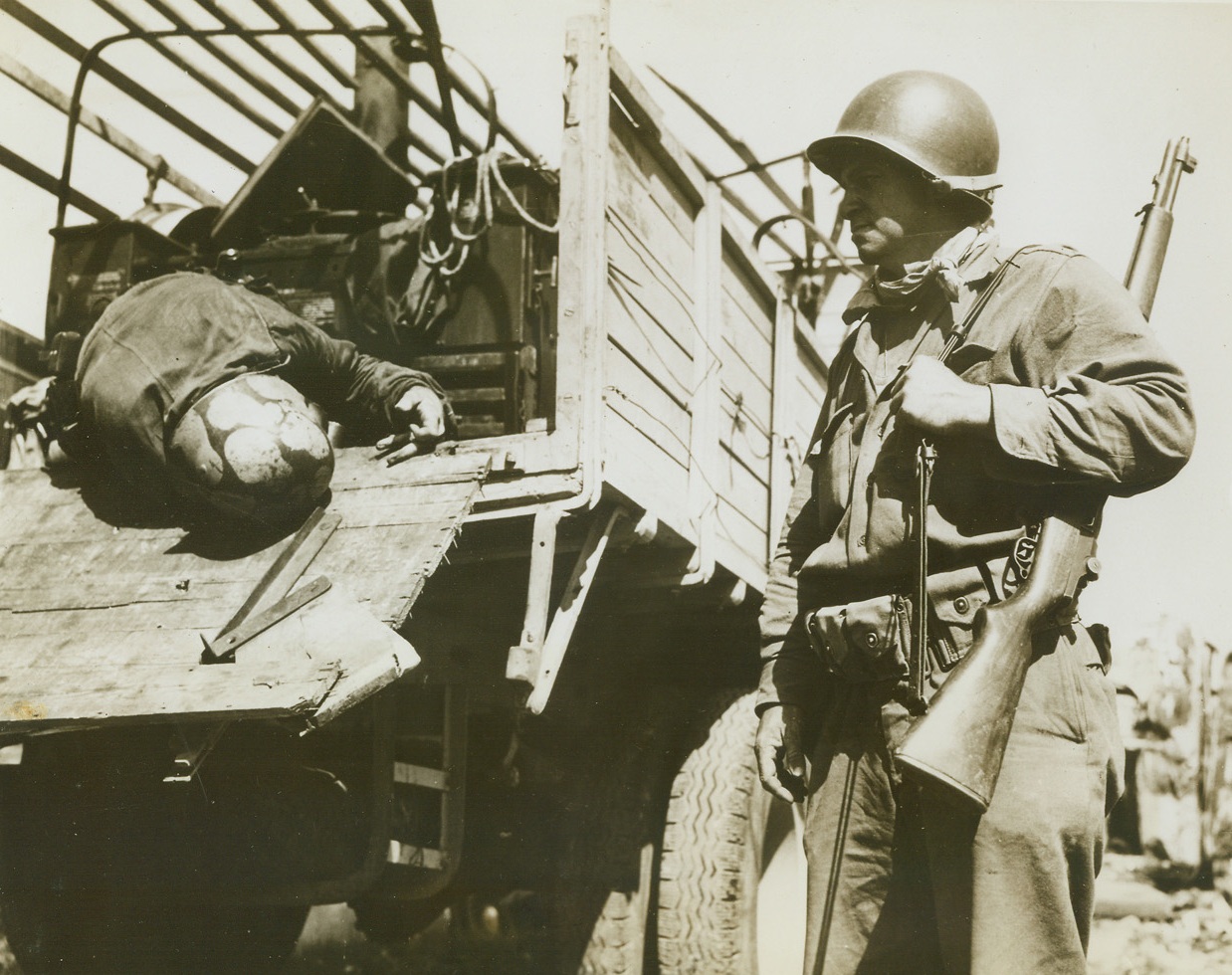
His Cargo--A Dead German, 9/12/1944. France -- Showing no emotion, Cpl. Charles S. Hoff, Cohoes, New York, looks at a dead German hanging on the lip of a truck outside of Loriol, France. Town was the site of Nazi debacle as American artillery and Air Force destroyed an entire convoy. Credit: Signal Corps photo from ACME;
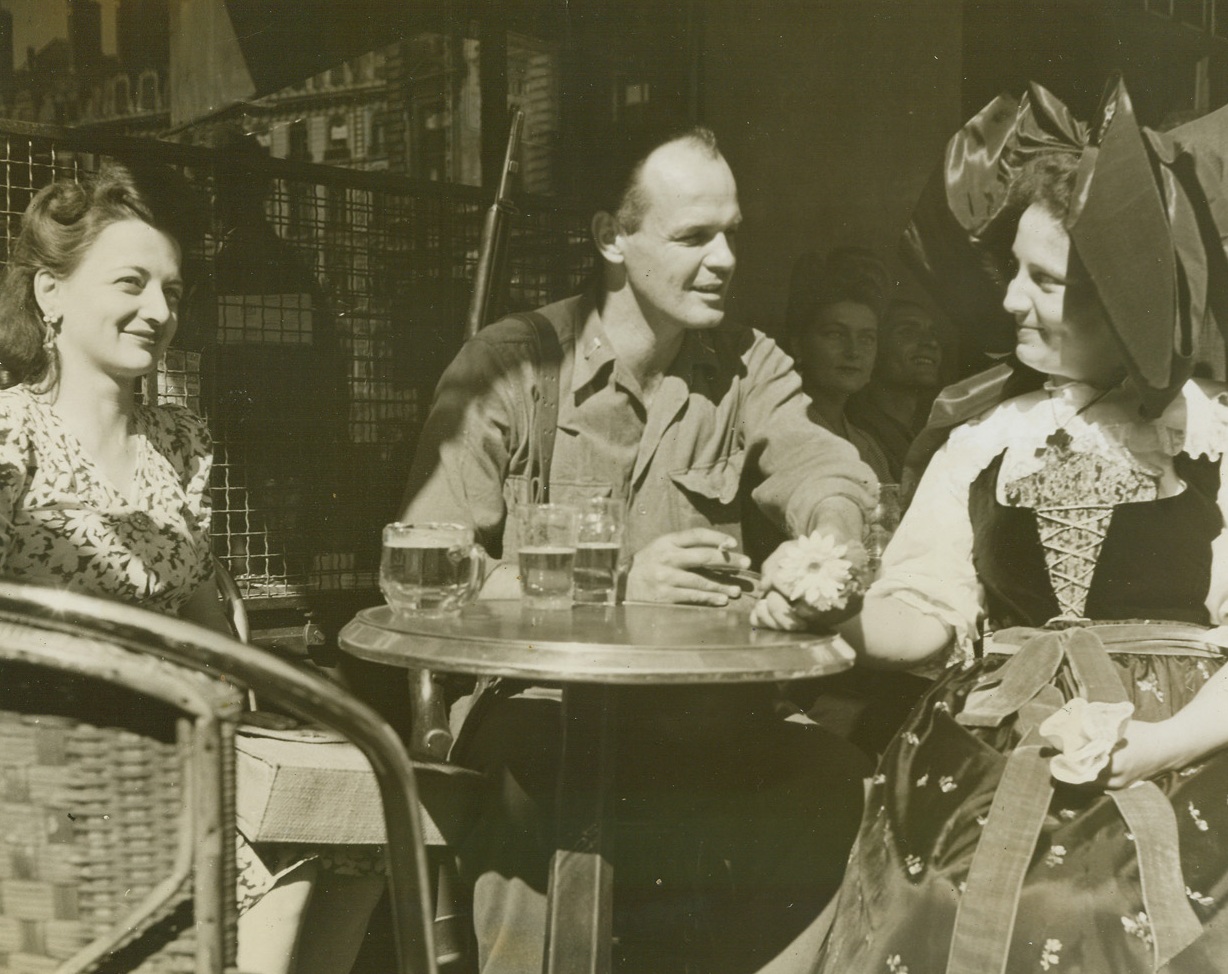
”Business as Usual”, 9/12/1944. Lyon, France -- After snipers had been driven from the rooftops in Lyon, and the city had been completely liberated, civilians once more returned to their normal lives, which included tete-a-tetes in their numerous sidewalk cafes. Lt. John Whelden, Newton, Massachusetts, chats over a glass of ale with a buxom French girl, who is attired in traditional peasant costume. Credit: ACME photo by Sherman Montrose, War Pool Correspondent`;
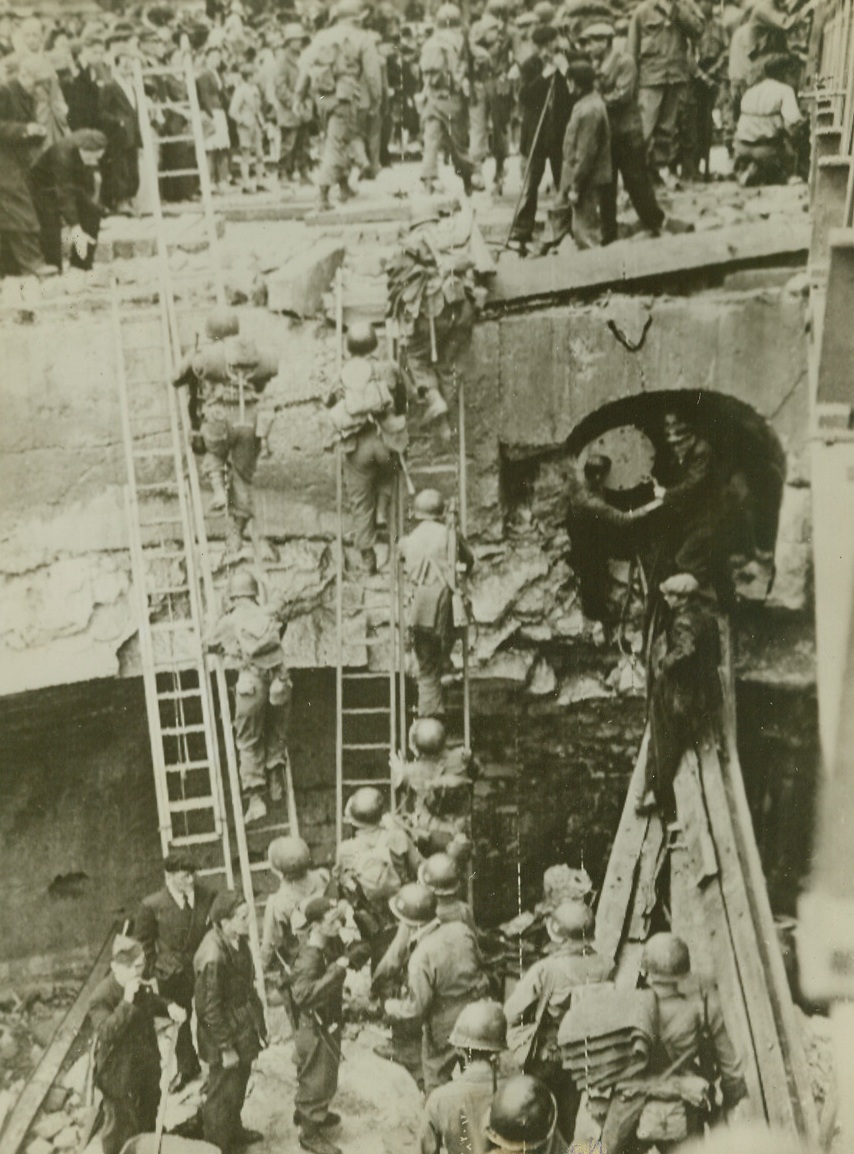
Yank Troops Move Up, 9/11/1944. Southern France -- Yankee ingenuity found a relatively simple solution to the problem of getting to the other side when a destroyed bridge threatened to hold our troops up in southern France. The boys merely placed ladders across the river and climbed across. French civilians line the sidewalk to watch the infantrymen advance. Credit: Army photo from ACME;
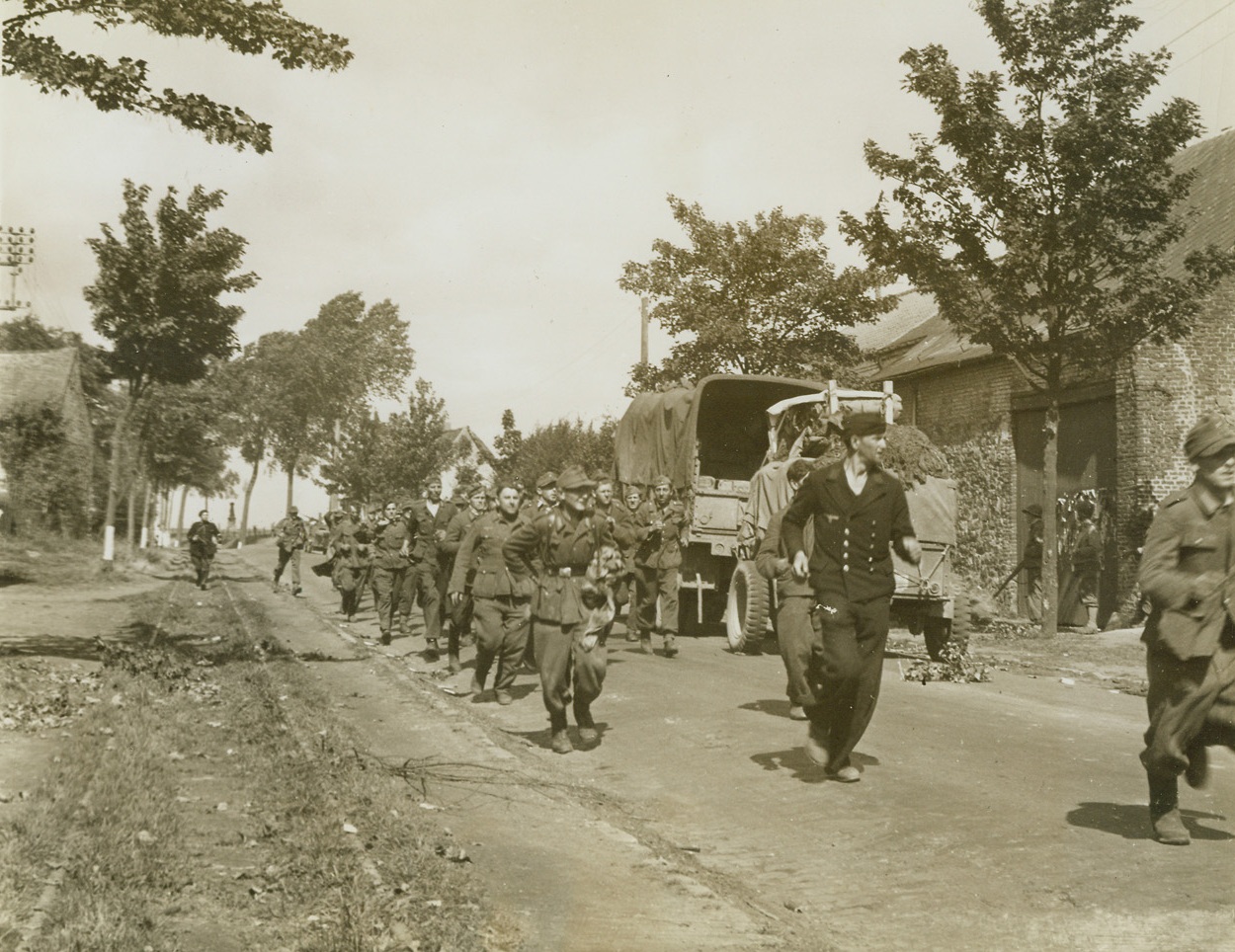
Nazis in a Hurry, 9/10/1944. Maubeuge, France -- Told to beat it on the double to the nearby prisoner of war cage, these Nazi captives obediently run down a road in liberated Maubeuge, on the Franco-Belgian border. All the fight knocked out of them, the Germans took flight at the command of their captors. Photo by Andy Lopez, photographer for the War Picture Pool. Credit: ACME;

History Repeats, 9/9/1944. France -- Almost 25 years to the day, the first copy of the Stars and Stripes of World War II appears in Paris as did its predecessor, the Stars and Stripes of World War I, service paper for the U.S. forces on the continent. Sgt. Robert J. Collins, Quincy, Massachusetts, displays the paper in the publication’s office as a group of helmeted American soldiers, French officers, gendarmes and civilians looks on. Credit: Signal Corp photo from ACME;
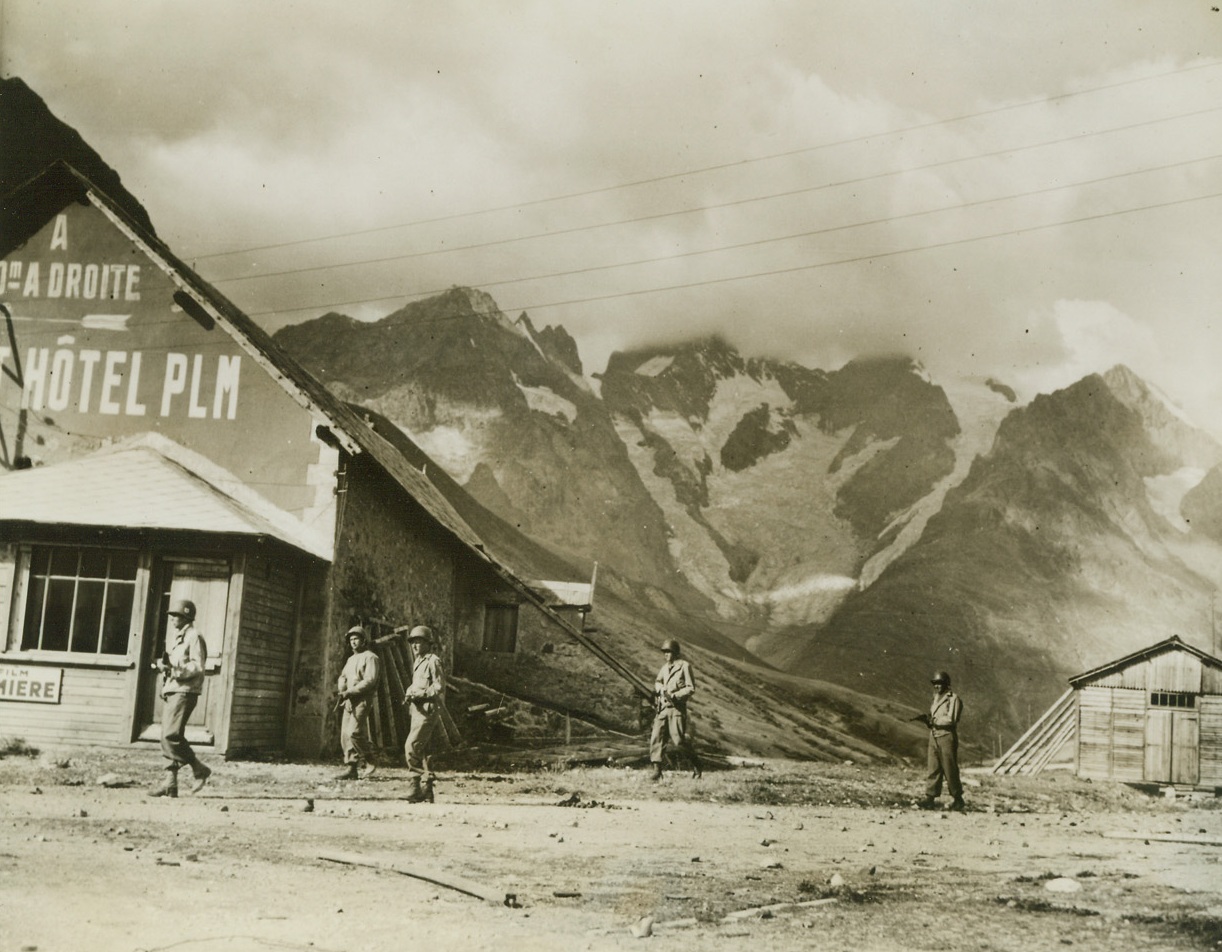
Returning After Skirmish, 9/10/1944. Briancon, France -- With the snow-covered mountains of the Italian Alps rising to meet the clouds in the background, a five-man American patrol wends its way back to American lines after an encounter with the Germans near Briancon, France, which is near the Italian border. Credit: ACME;
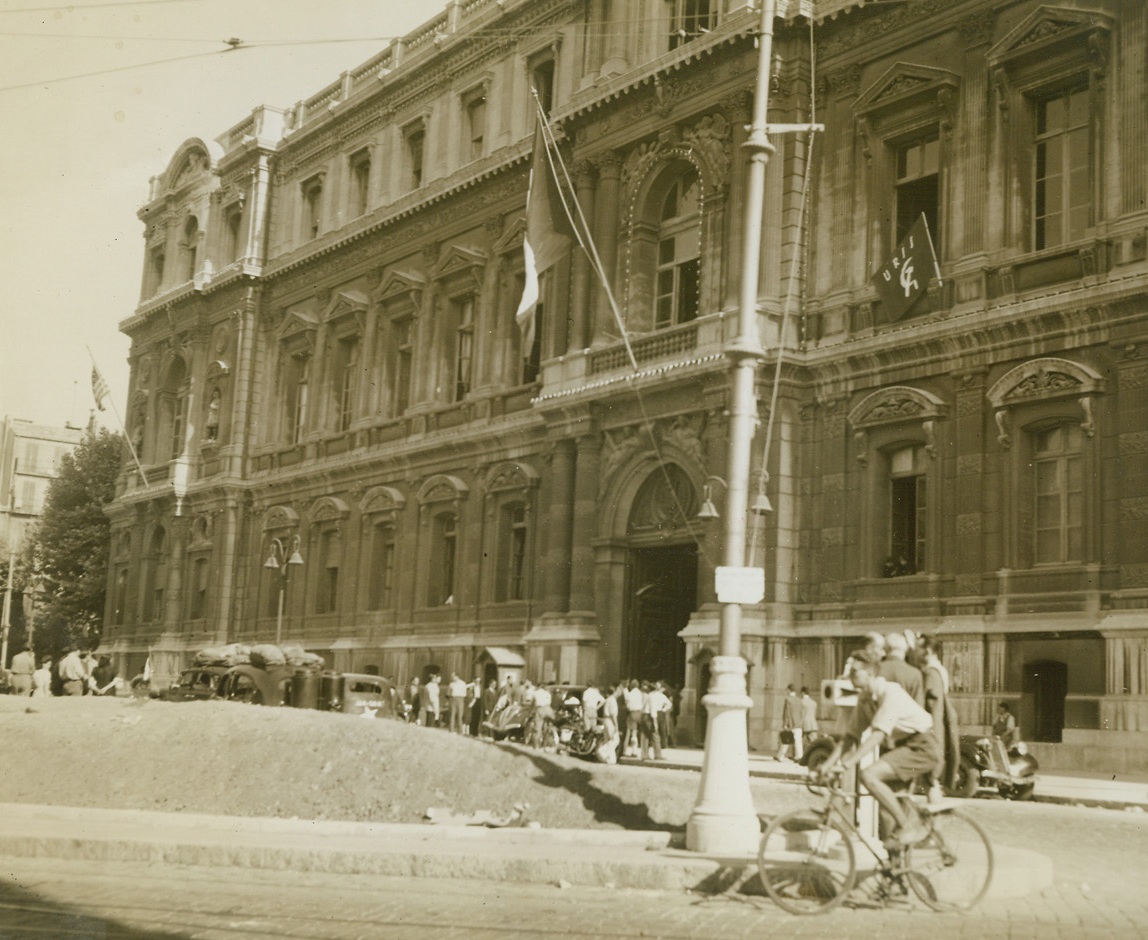
Flags of Victory Fly in Marseille, 9/6/1944. France - After four century-long years under the Nazi heel and the puppet government of Vichy, the flags of free countries and men once more fly over the prefecture in Marseille after its liberation by Allied Forces. In the center is the tricolor of France raised in glory again. At far left is the stars and stripes of the United States and at right is the red flag of Russia. Credit: ACME photo by Sherman Montrose, War Pool Correspondent;
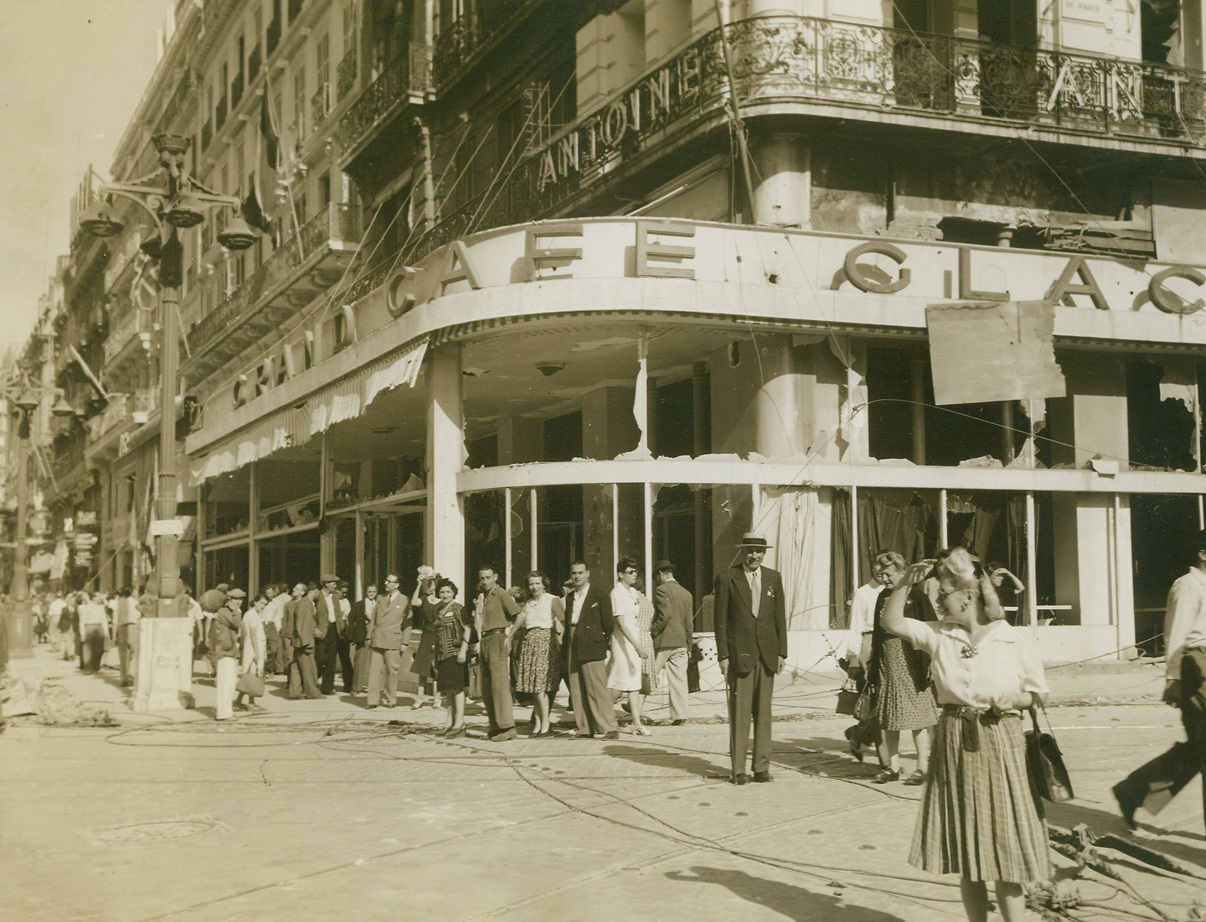
War-Torn Marseille, 9/6/1944. France - Residents of the French city of Marseille walk down famous Canebiere beneath a building that shows the signs of warfare and the results of German artillery fire after the 14 day siege that led to the city’s liberation. The charming blonde French girl in foreground, however, wears what seem to be latest fashions and cuts a mean figure in this war-torn street. Credit: ACME photo by Sherman Montrose, War Pool Correspondent;
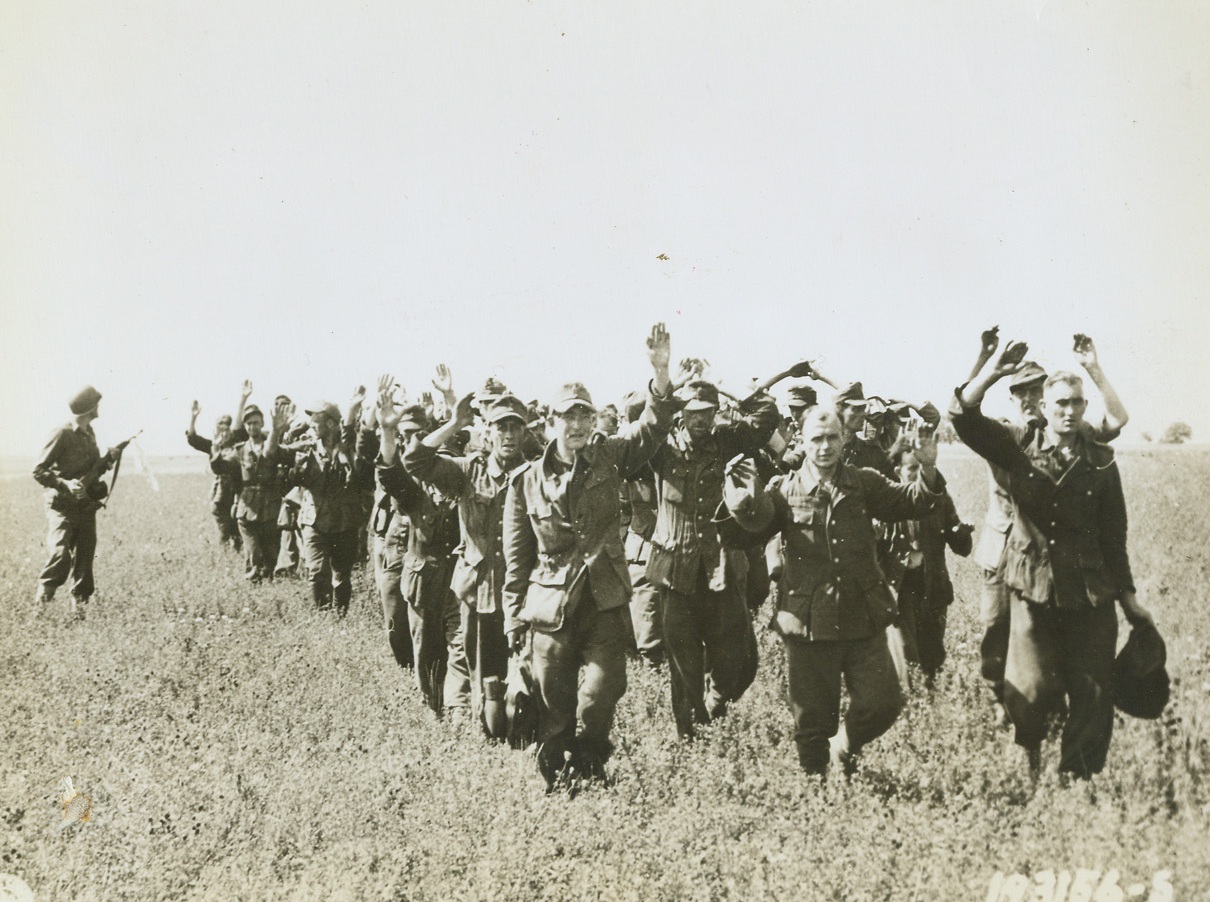
Talked Into Surrendering, 9/2/1944. France - Some raise one arm, the more cautious get both high in the air, as Sgt. Olin Dows, Rhinelander, N.Y., brings in his catch of 56 Nazis at Joigny, France. His fluent knowledge of German enabled him to talk them into quitting. Credit: Signal Corps photo from ACME;
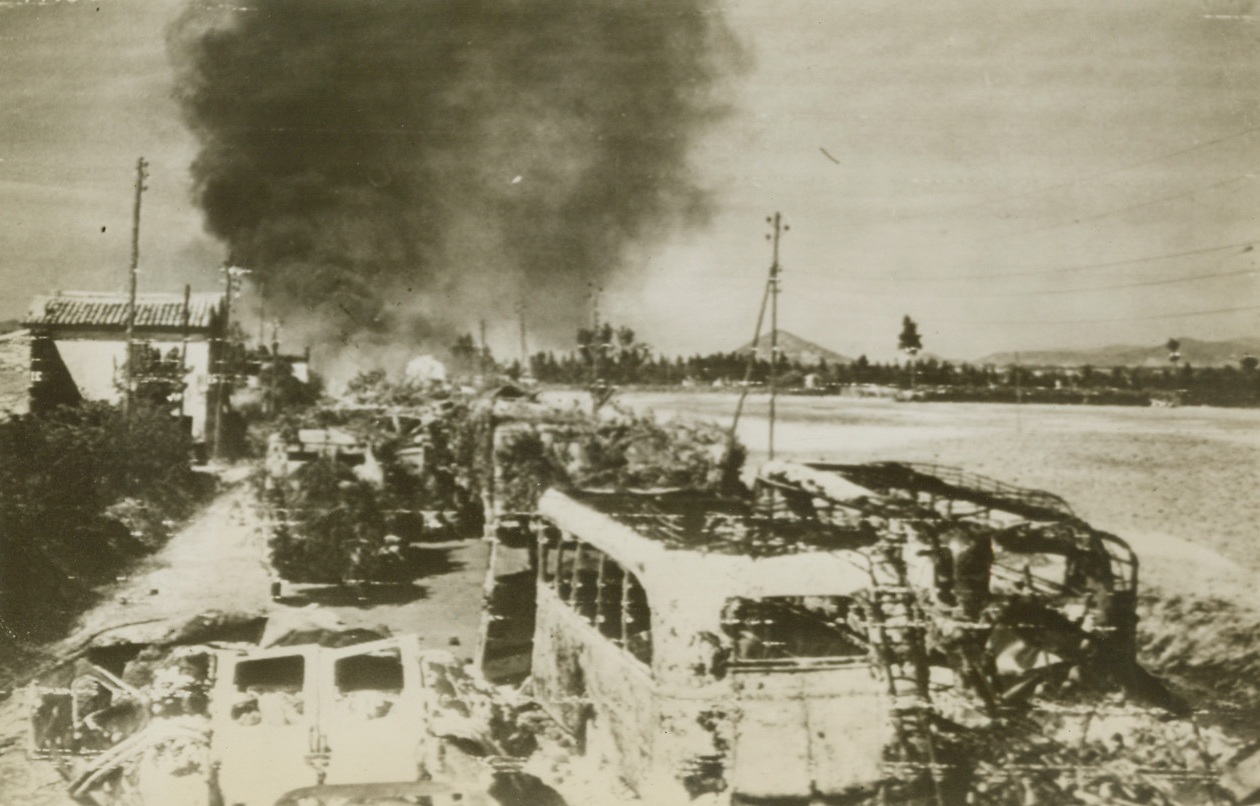
Nazi Convoy Joins The Fishes, 9/2/1944. France - A few of the 400 camouflaged Nazi vehicles are shown, wrecked and burning, after the enemy convoy was trapped and destroyed near Montelimar, France, by small arms and mortar fire, from the U.S. 7th Army. Credit: Army Radiotelephoto from ACME;
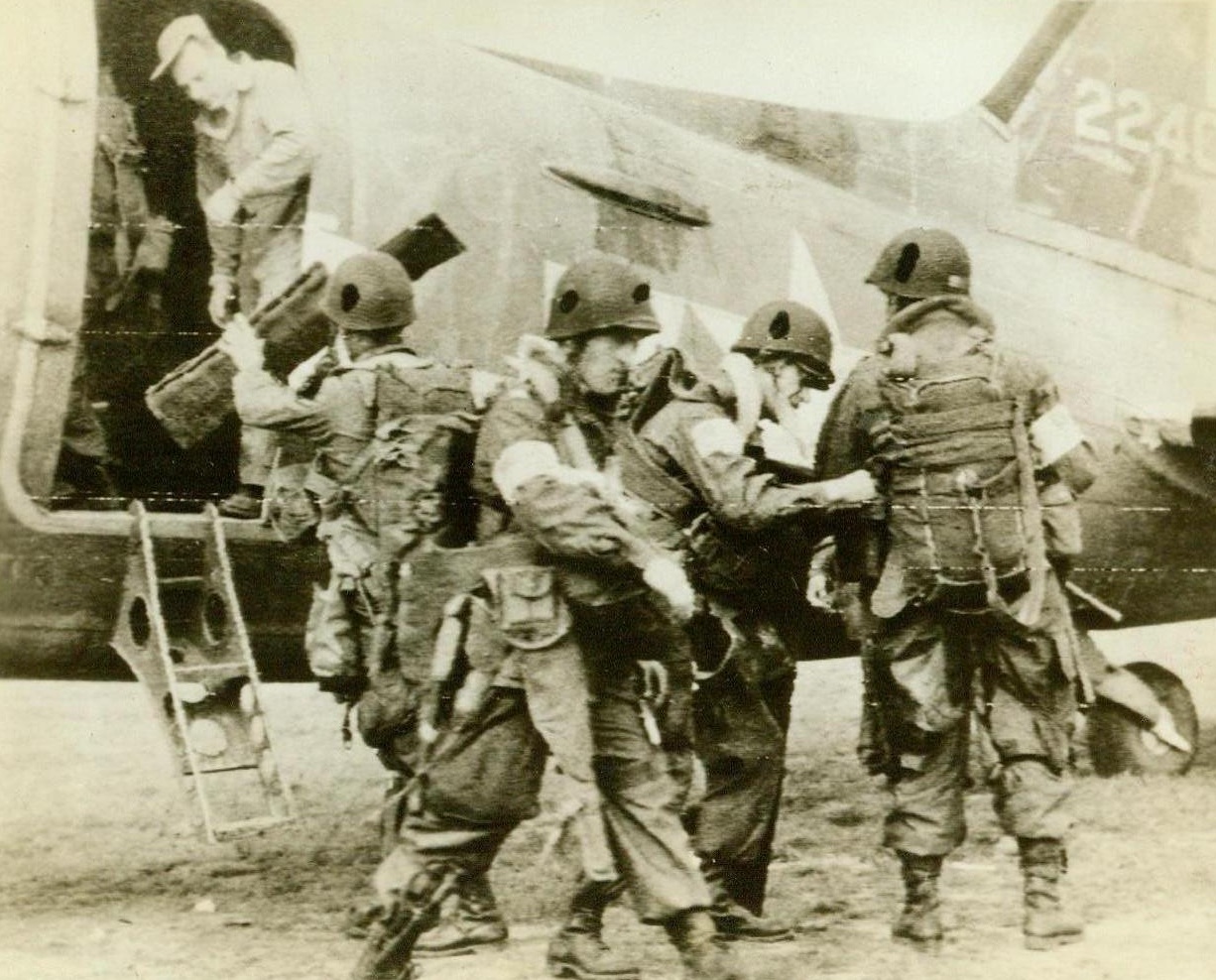
Holland Bound, 9/17/1944. England - Bustling about a giant C-47 Transport, American Airborne Troops prepare to take off on the heavy sky invasion of Holland. The First Allied Airborne Army sent more than 1000 Transports and Gliders to the Netherlands, to settle behind enemy lines and outflank the vaunted Westwall. Credit: Signal Corps Radiotelephoto from ACME;
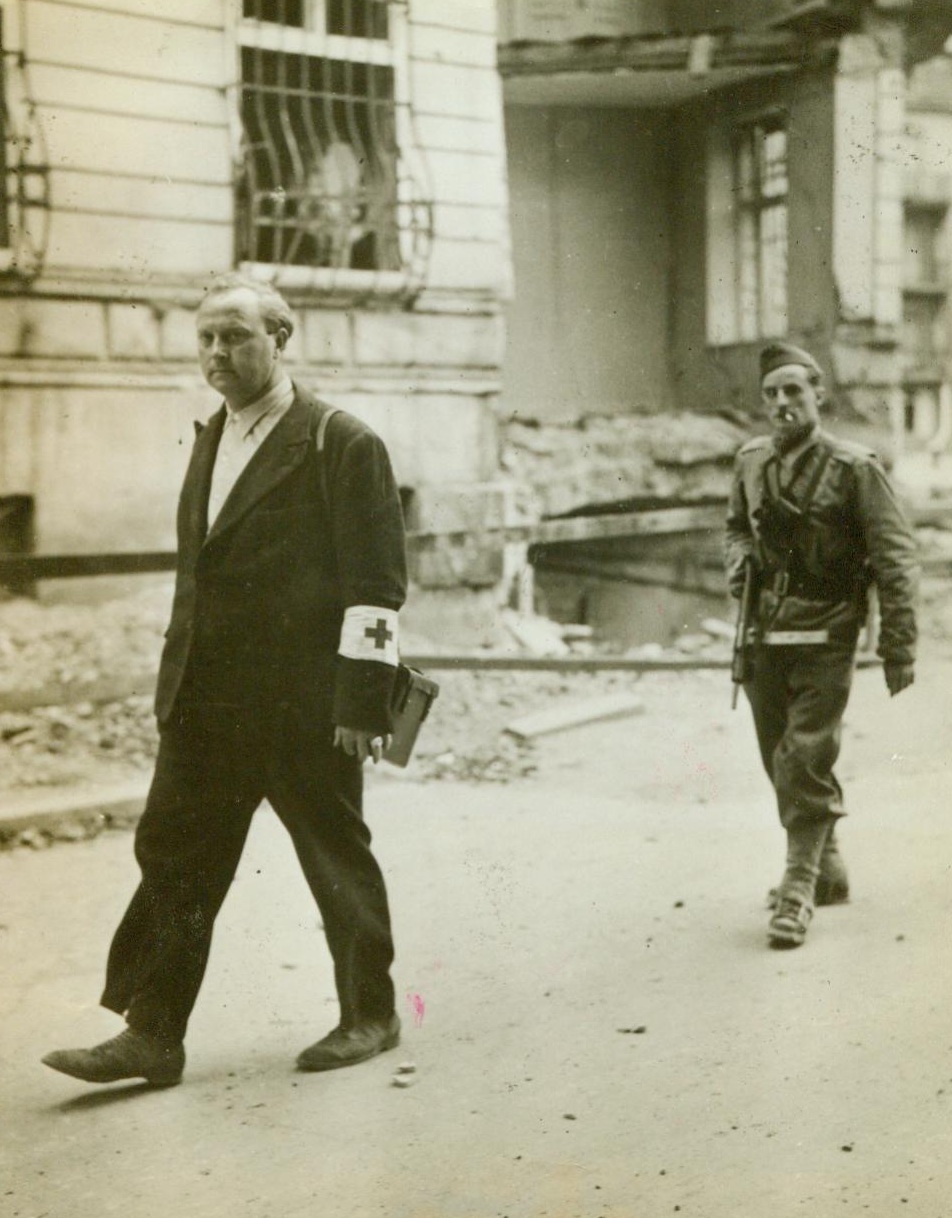
Brother, You’ll Be Sorry, 9/23/1944. Thionville, France - It’s a sad day for this German prisoner, being marched at the gun point of an American soldier down the Adolph Hitler Platz in Thionville. Donning civilian clothes with a Red Cross armband attached to his sleeve, the German went about his sniping until he was finally caught. Under the rules of war, any soldier who is captured wearing any dress other than his uniform, may be condemned to death. Credit: ACME;
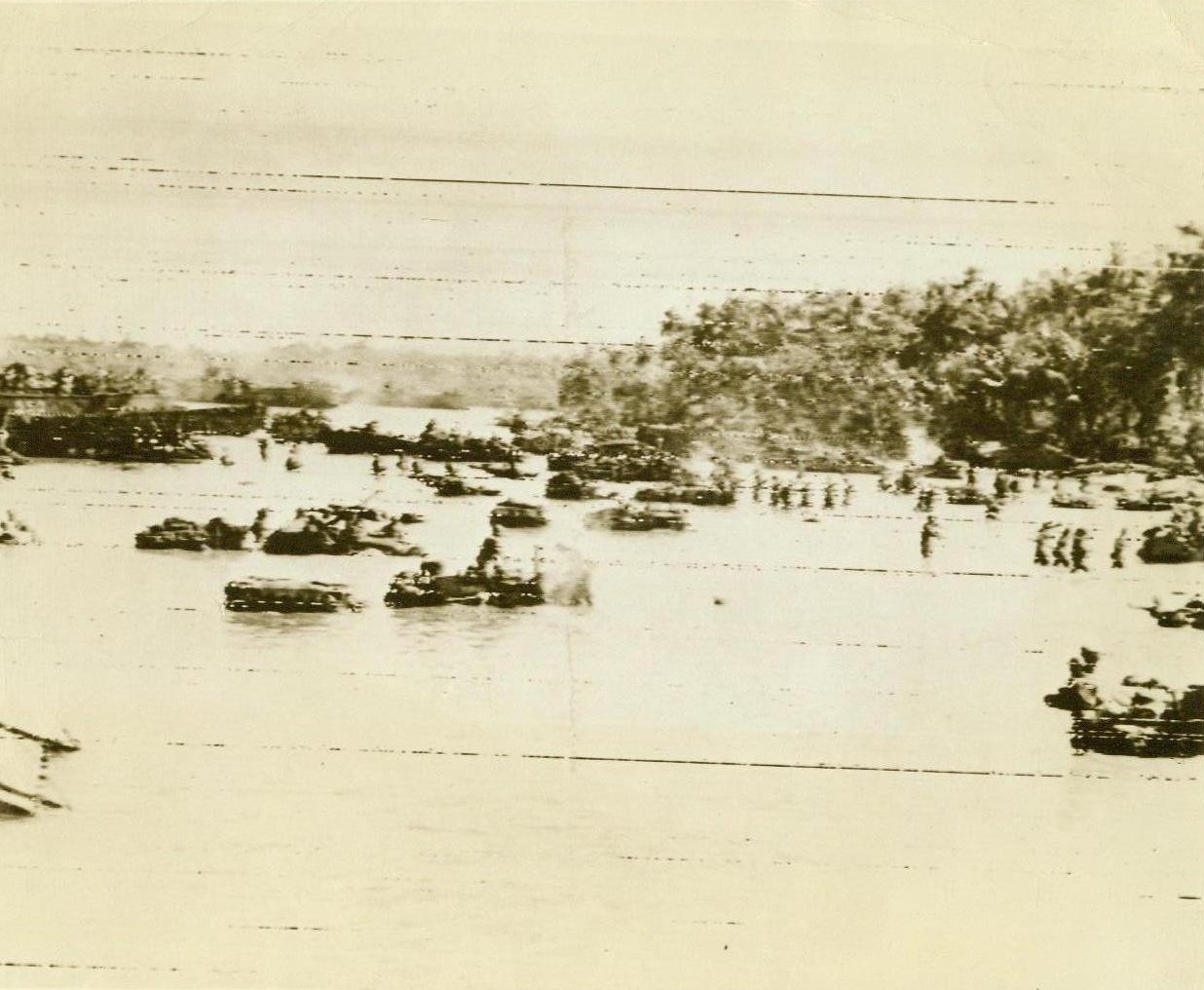
Allies land on Morotai, 9/17/1944. Morotai Island- Wading, chin-deep, in the waters off the shore of Morotai Island, in the Halmahera group, allied infantrymen splash toward the well-pounded beach. Although the island is only 250 miles south of the Philippines, the invaders ran into no organized Jap resistance. Engineers began construction work at Pitu airfield almost immediately.;
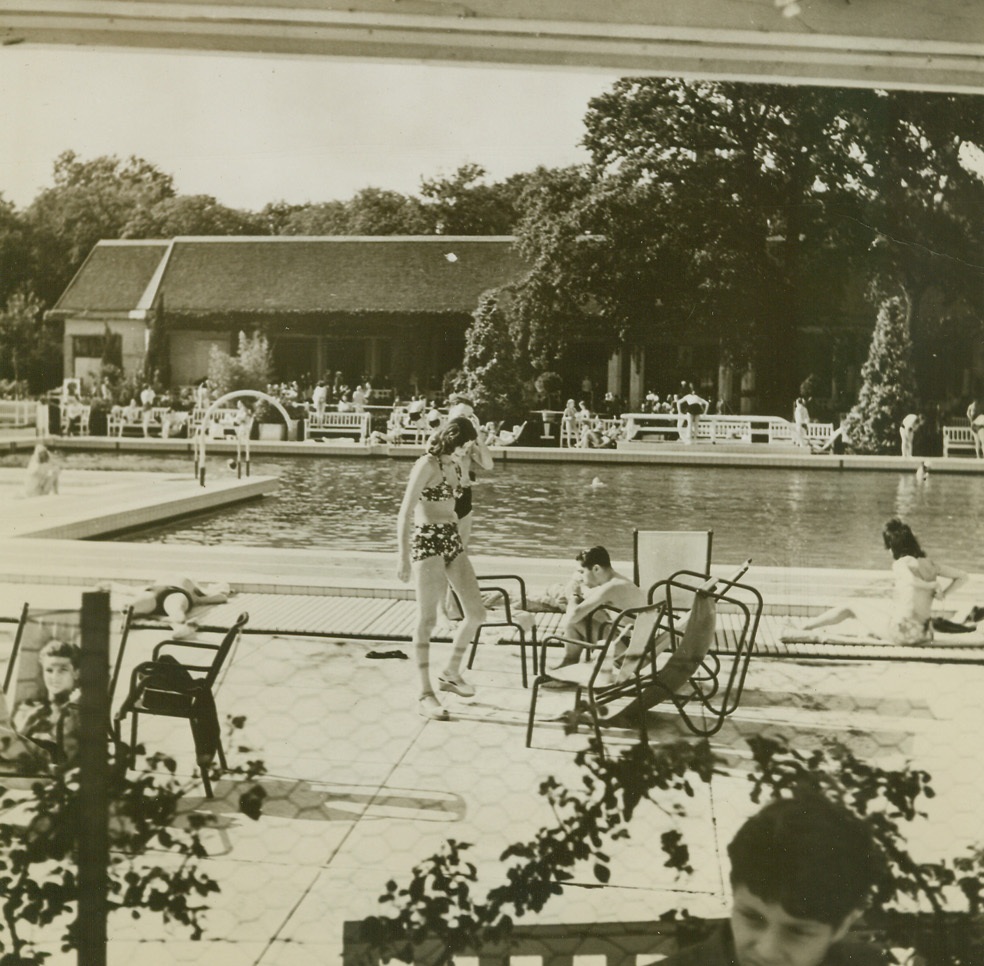
Paris Plays Once More, 9/23/1944. Paris – So untouched by the war is this scene that it may well be a gathering around one of Hollywood’s pools. But it’s Paris—Paris as it was four years ago, before the inroads of the Nazis stamped out all gaiety and play. Once more Parisians are taking up the thread of their lives as they frolic in the pool of the Racing Club in the Bois du Bologne. Credit: ACME;
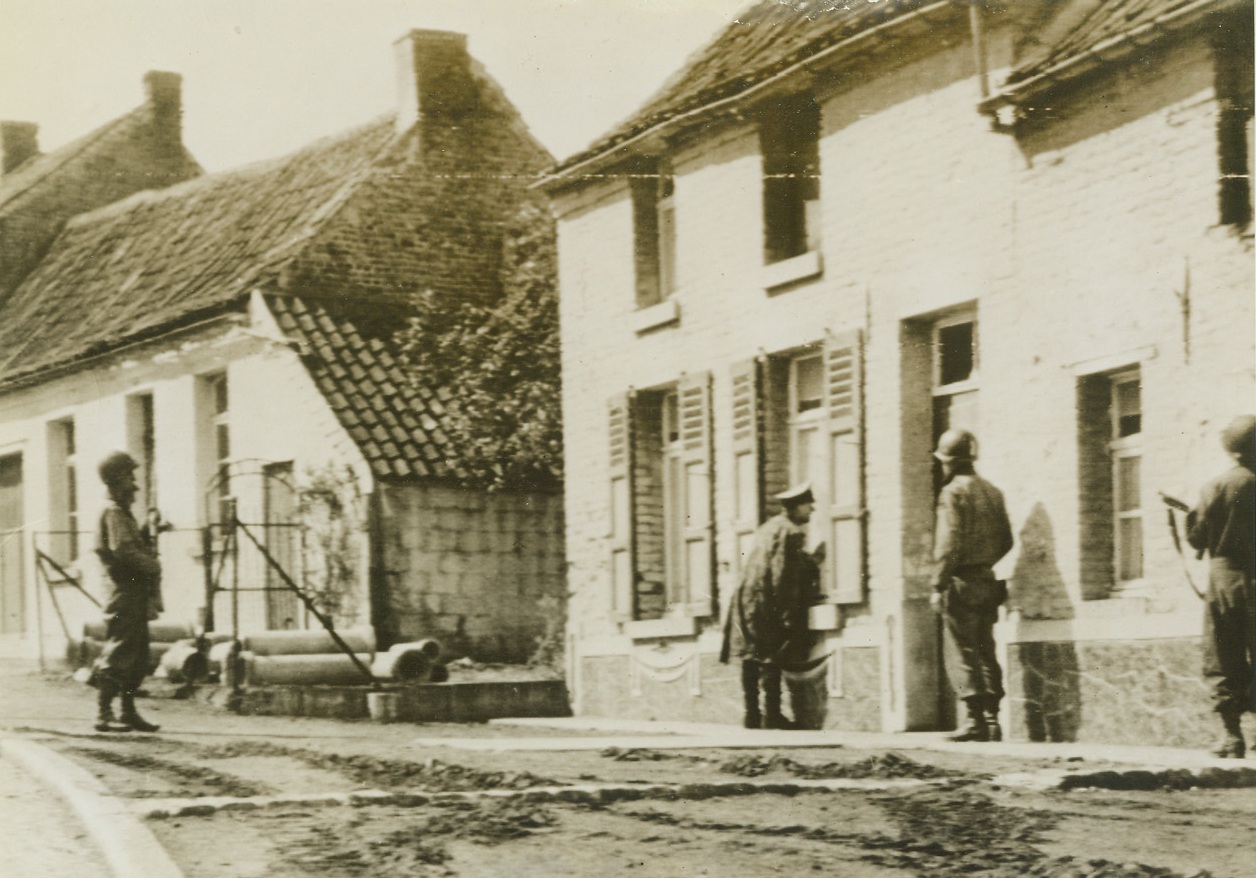
Red Rover, Red Rover, Nazis Come Over, 9/8/1944. France – While American troops with guns at the ready keep guard, a Nazi Captain (center), taken prisoner by the small Yank force which captured the French city of Mons, calls through the doorway of a house telling his men in hiding there to surrender. Credit: Army Radiotelephoto from ACME;
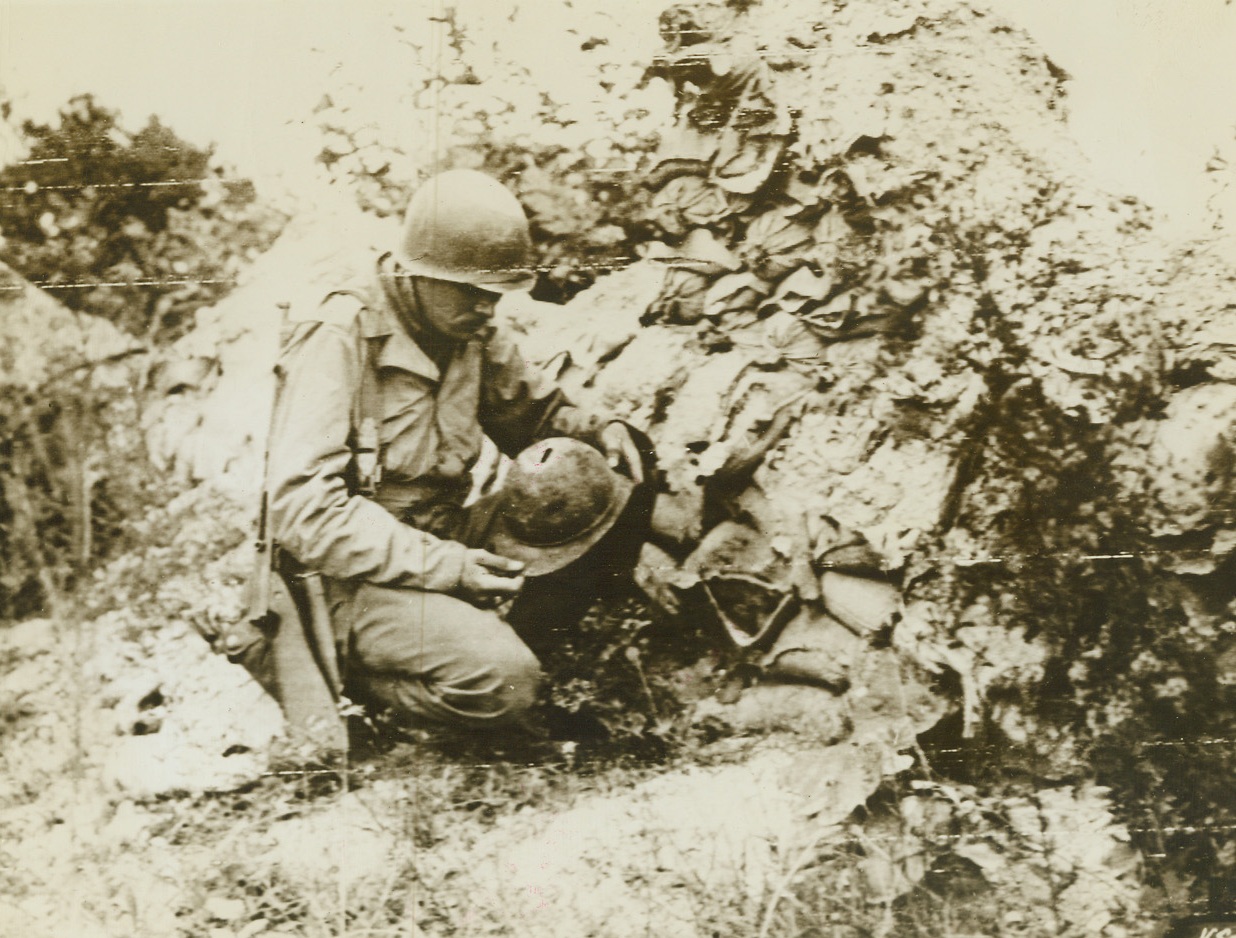
Mute Reminders of Another War, 9/7/1944. Argonne, France – As Americans fought on battlefields which still bore marks of another war, Sgt. Fred Owens, Los Angeles, Calif., examines a battered old French helmet from World War I which he found beside a pile of rotting sandbags in the Argonne Forest. Credit: Signal Corps Radiotelephoto from ACME;

MARAUDER COMES DOWN, 9/11/1944. TOULON, FRANCE—Target for a direct hit by an 88mm flak shell, this B-26 Marauder is about to follow its sheared-off engine down to Toulon Harbor. The flaming plane was lost in a U.S. 12th Air Force attack on enemy coastal guns at Toulon. Credit Line (U.S. A.A.F. Photo from ACME);
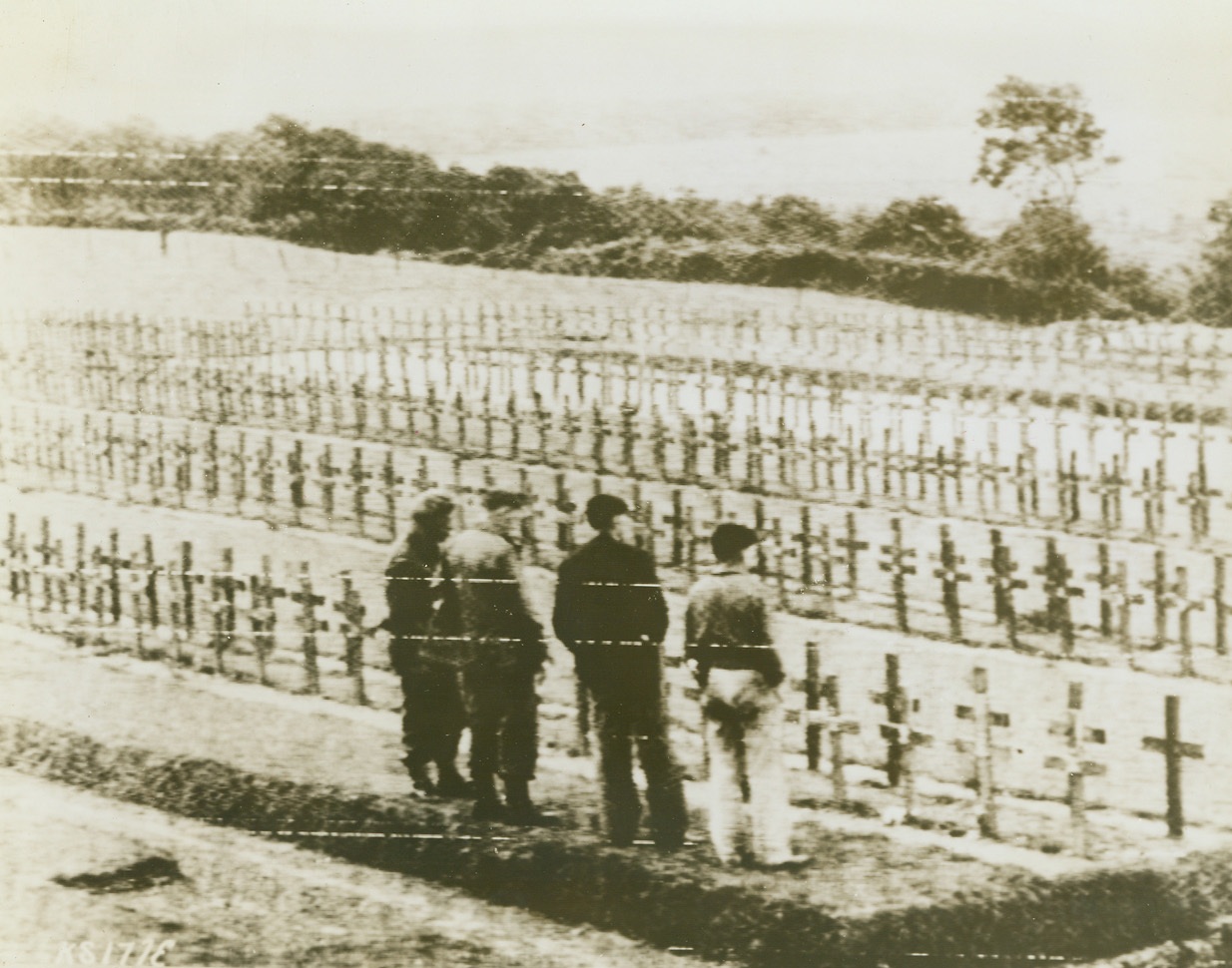
Tribute to Dieppe Raiders, 9/3/1944. Dieppe – Two Canadian soldiers and two Frenchmen visit this crowded cemetery at Dieppe to pay their respects to fallen British and Canadian heroes who died in the famous Commando raid of August, 1942. Credit: Army Radiotelephoto from ACME;
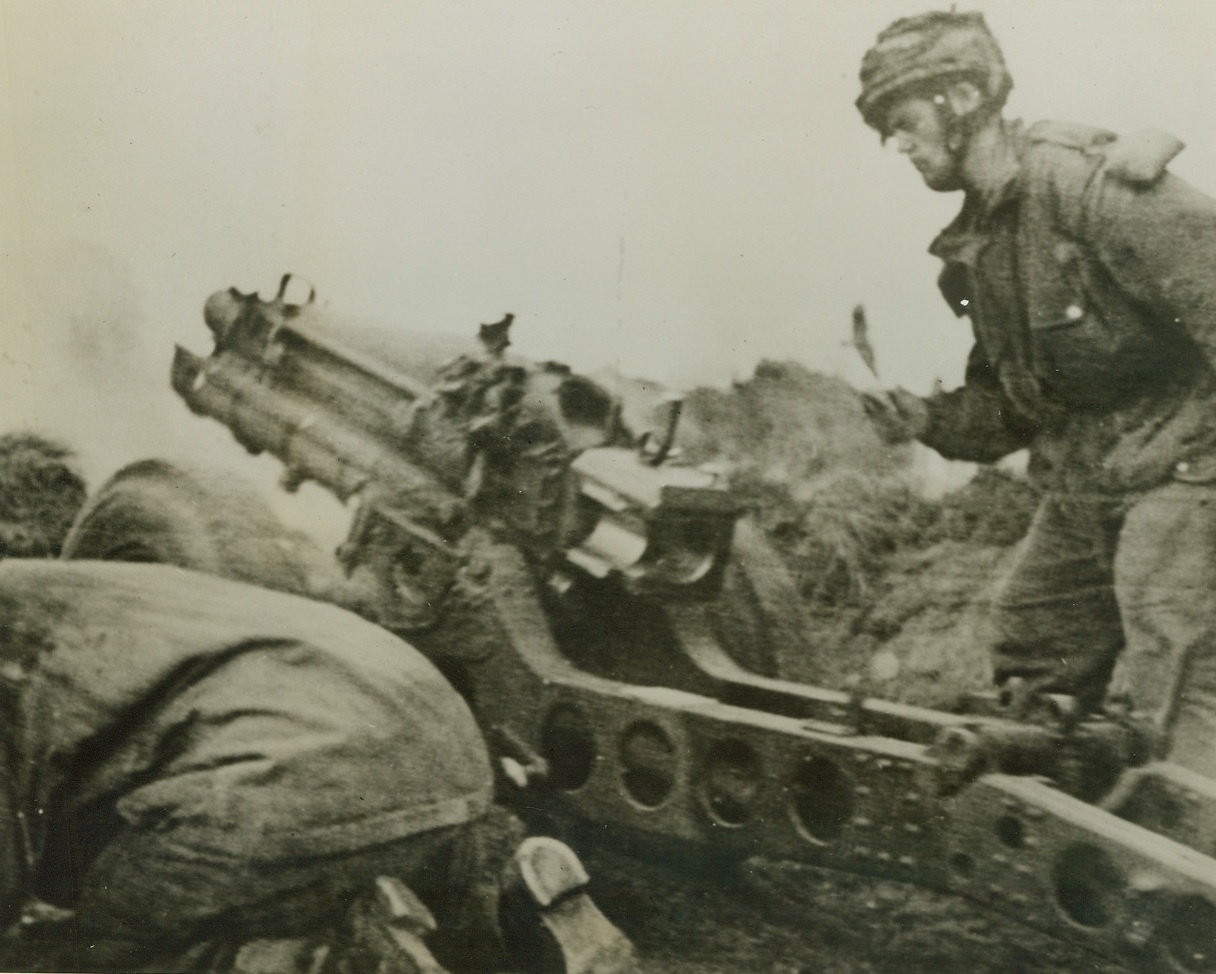
While They Fought the Gallant Fight, 9/28/1944. While the deathless heroes of Arnhem—that group of British paratroopers of the First Allied Airborne Army which resisted “like lions” in the face of overwhelming German pressure for nine days—were still holding their “little corner of hell,” this photo of several of the group firing a 75mm. howitzer, was taken. It reached the U.S. by Radiotelephoto, today. Credit: British War Office photo via U.S. by Radiotelephoto from ACME;
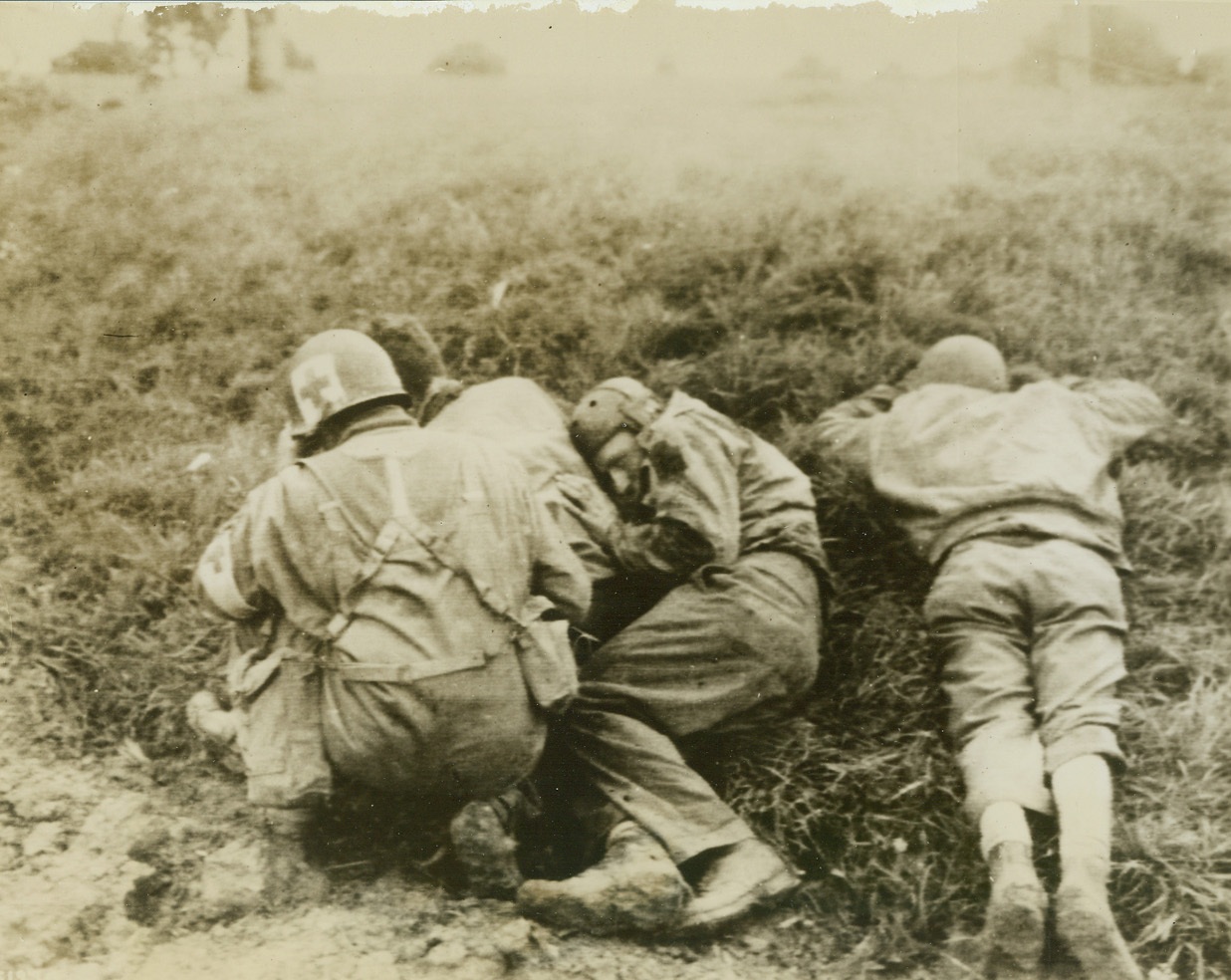
Keep ‘em Low, 9/29/1944. Moncel, France – Members of a tank crew hug the ground as a German artillery barrage comes over this field near Moncel. The medic at left squats as he treats a wounded man. Credit: Army Radiotelephoto from ACME;
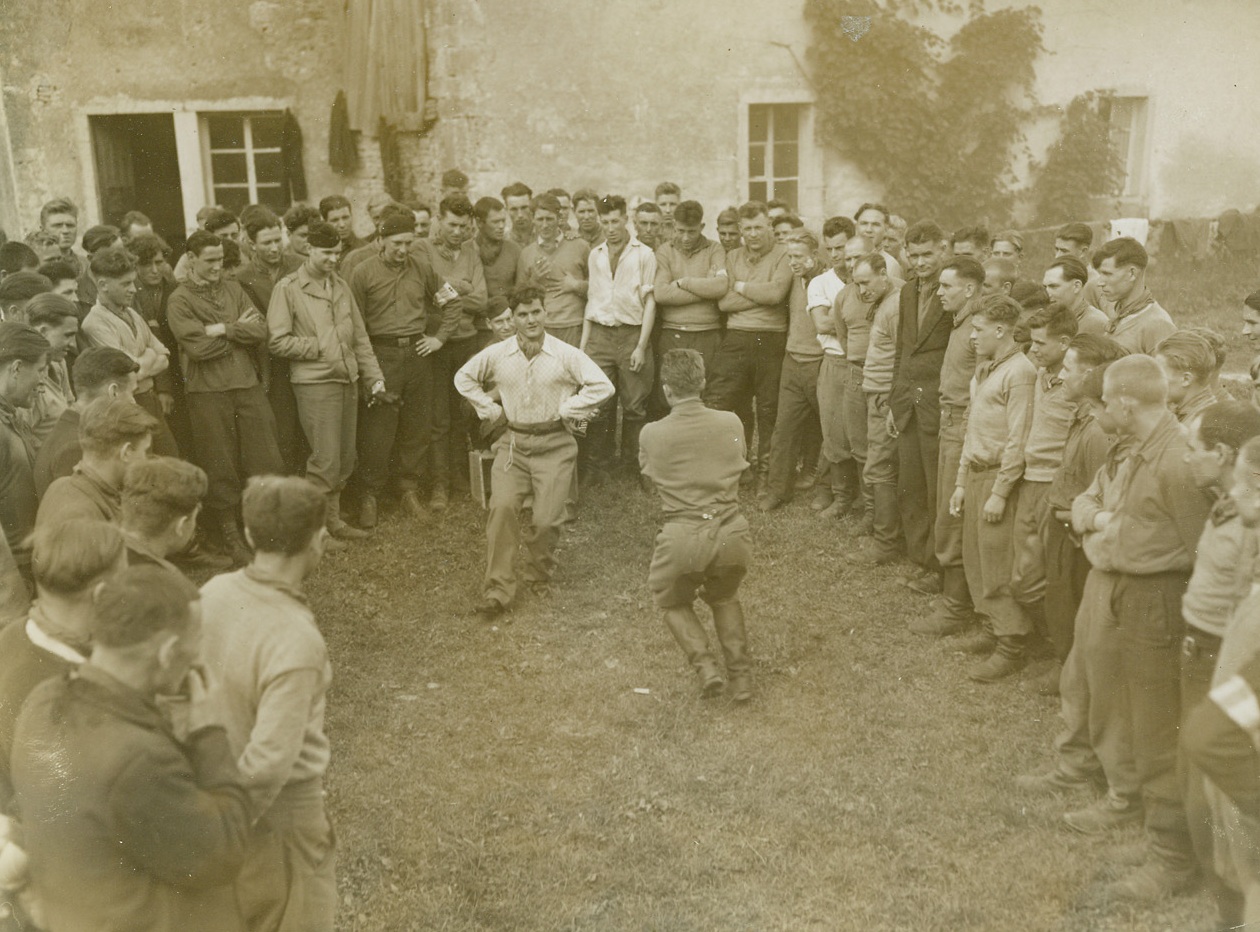
Russians Dance for FFI Group, 9/30/1944. Belfort, France – In the vicinity of Belfort, Russian soldiers who were captured by the Germans at Stalingrad and were made to fight with them, entertain members of the FFI with a Russian dance after their escape from the Germans. They killed 40 Nazi officers and senior non-coms of their outfit and joined the FFI in their fight to drive the Germans from France. Credit: ACME photo by Thomas Shafer, War Pool Correspondent;
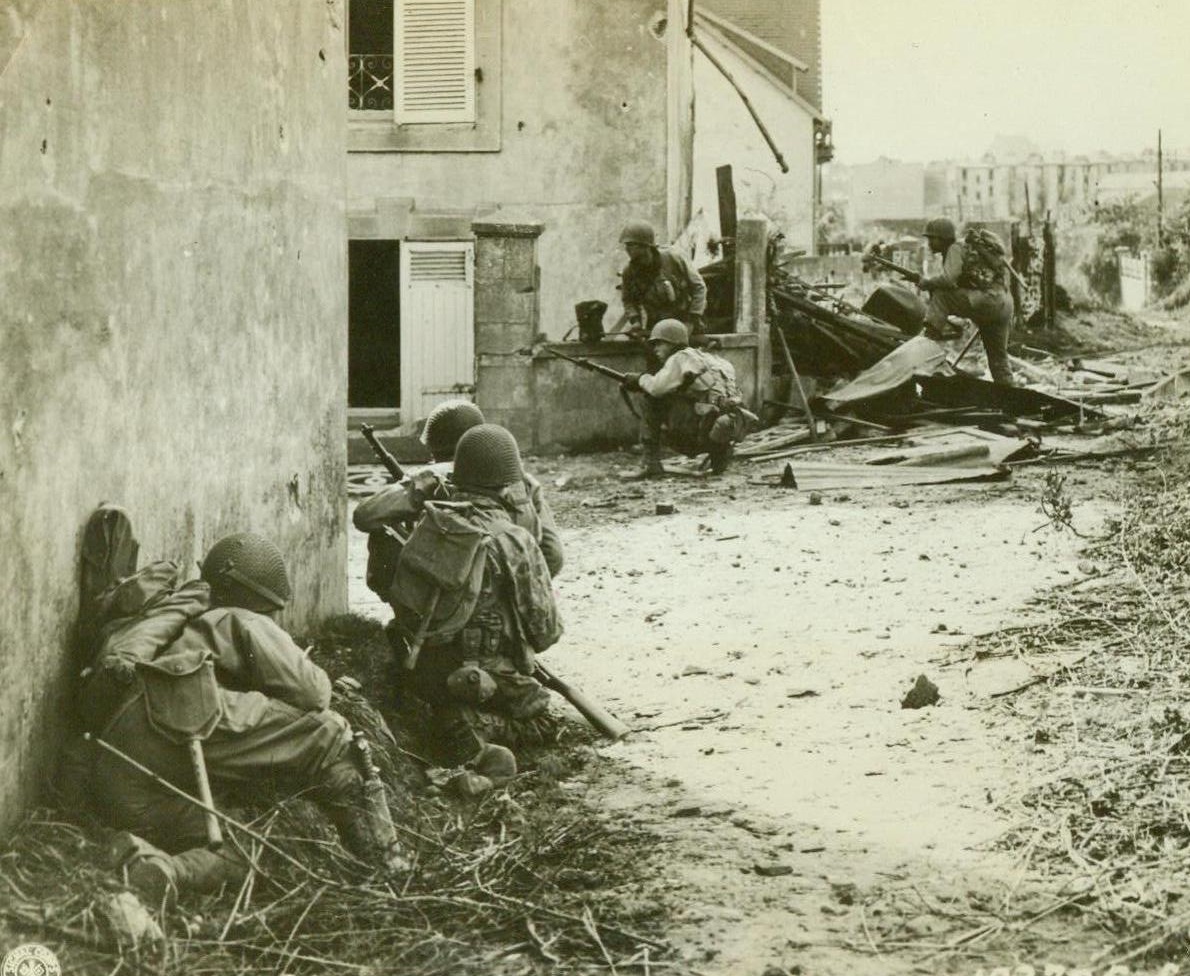
Yanks Hunt Snipers, 9/14/1944. France— In the outskirts of Brest, Yank infantrymen creep up on the enemy. The soldiers hug the walls of buildings and take whatever cover they can to keep out of the hail of machine gun fire Nazis are shooting their way. Enemy has desperately defended the vital submarine base. 9/14/44 (ACME);
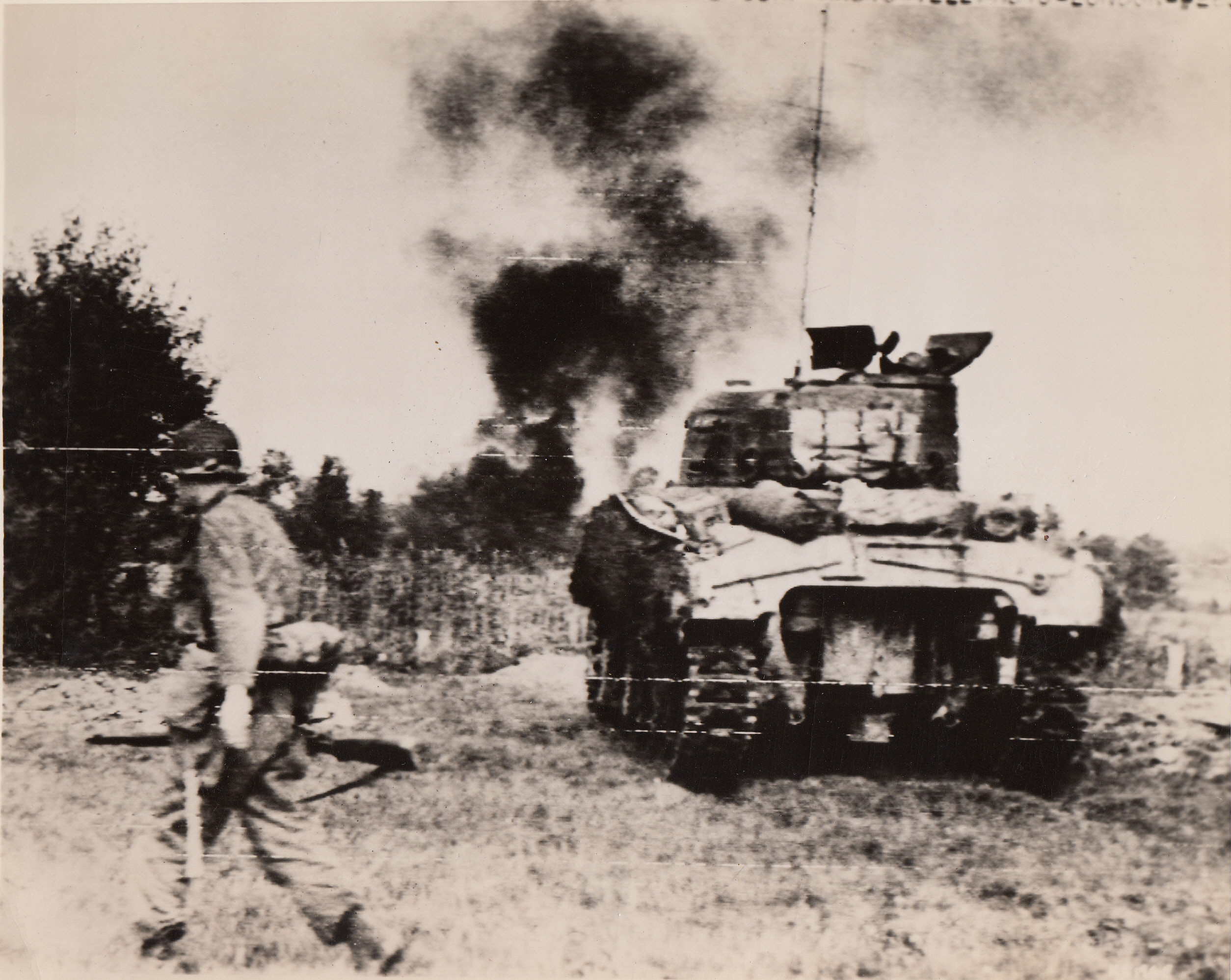
Yanks Advance in France, 9/25/1944. Americans forces with tank support, advance toward the bank of the Meurth River in France.;

Brest U-Boat Pens Finished, 9/26/1944. Brest, France – Two Allied soldiers stand in one of the Nazi U-boat pens at Brest and look at the gaping 40 foot hole made in the roof. Dirt and grass which formed the camouflage cascades down the hole. Although built of thick reinforced concrete, several direct hits blew in the roofs of three pens. Credit: British official photo from ACME;

First Down, 9/11/1944. England – The first flying bomb brought down by a barrage balloon landed in this area, tearing a huge crater in the ground. The demolished barn in foreground is the only bit of destruction accomplished by the vengeance weapon, which was heading for a crowded urban area before it was intercepted by the balloon. Credit: British Official Photo from ACME;
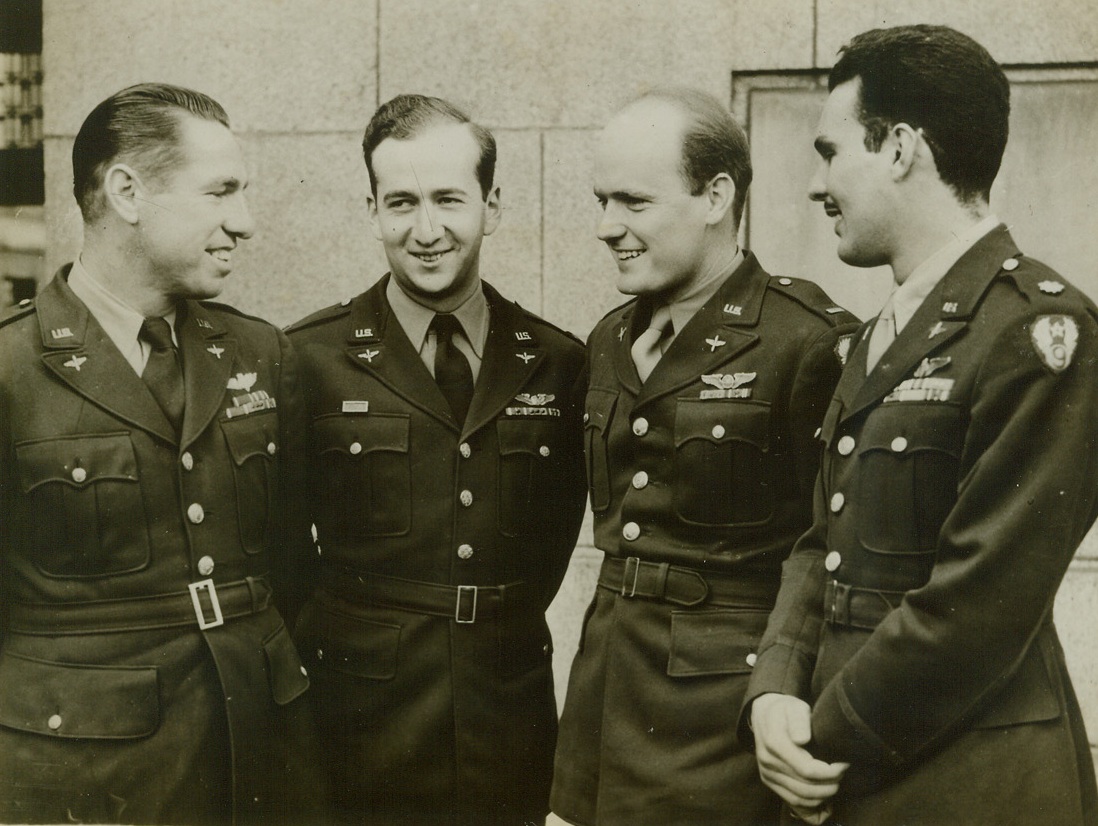
Yank Fliers Who Attacked Flying Bomb Sites, 9/12/1944. London, England – Multi-ribboned American pilots who attacked the German flying bomb sites on the French coast met with other service personnel who were engaged in fighting against the flying bomb menace and held a press interview at the Ministry of Information recently. Left to right: Maj. Charles S. Hudson, Bakersfield, California; Capt. Richard Nickelhoff, Mamoraneck, New York; Lt. B.A. Carroll, Dallas, Texas; and Maj. Albert E. Hill, Wichita Falls, Texas. Credit: ACME;
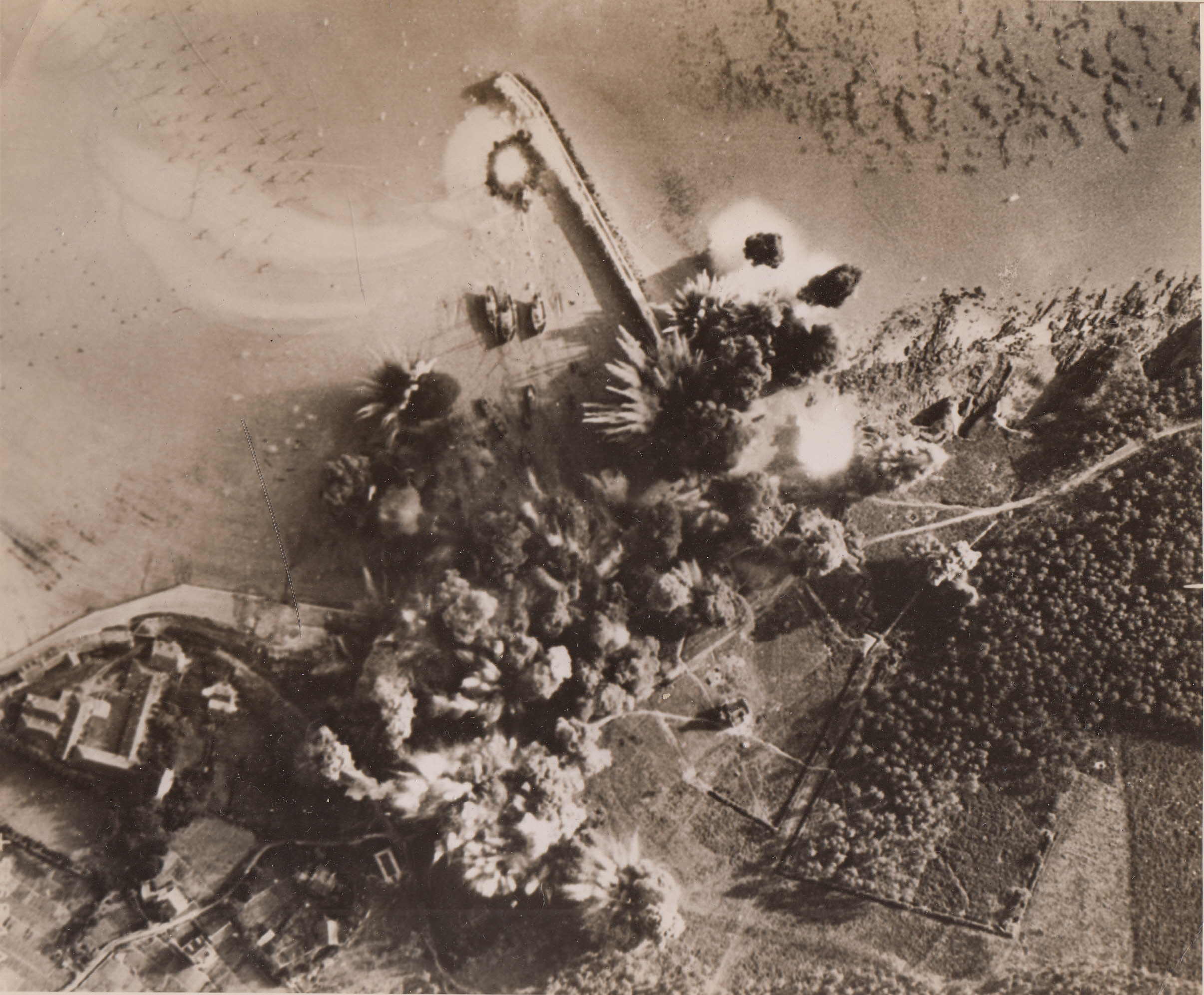
Allies Hit Mighty Air Blows at Brest, 9/15/1944. Brest Peninsula – Target for bombers of the U.S. 8th Air Force, this gun emplacement on a small quay on the Brest Peninsula goes up in a series of explosions as Allied planes hit at Nazi fortifications on the Peninsula.;
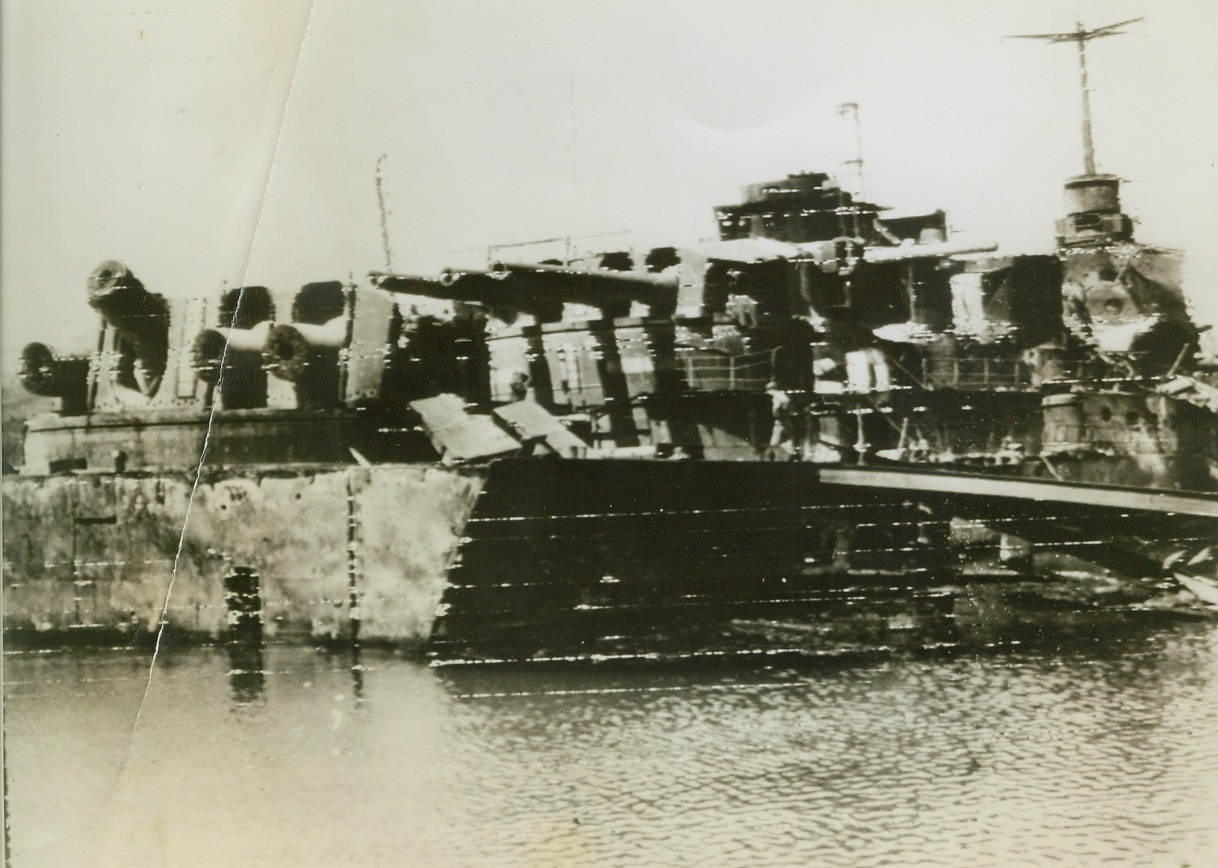
Punished by Both Sides, 9/3/1944. Toulon, France – The French battleship “Dunkerque,” which took punishment from both the Allies and the Germans, lays partly sunken in Toulon Harbor. The ship was a target for Allied bombardiers when she was in German hands, and a victim of retreating Nazis who cut off her big guns. Credit: U.S. Army Radiotelephoto from ACME;
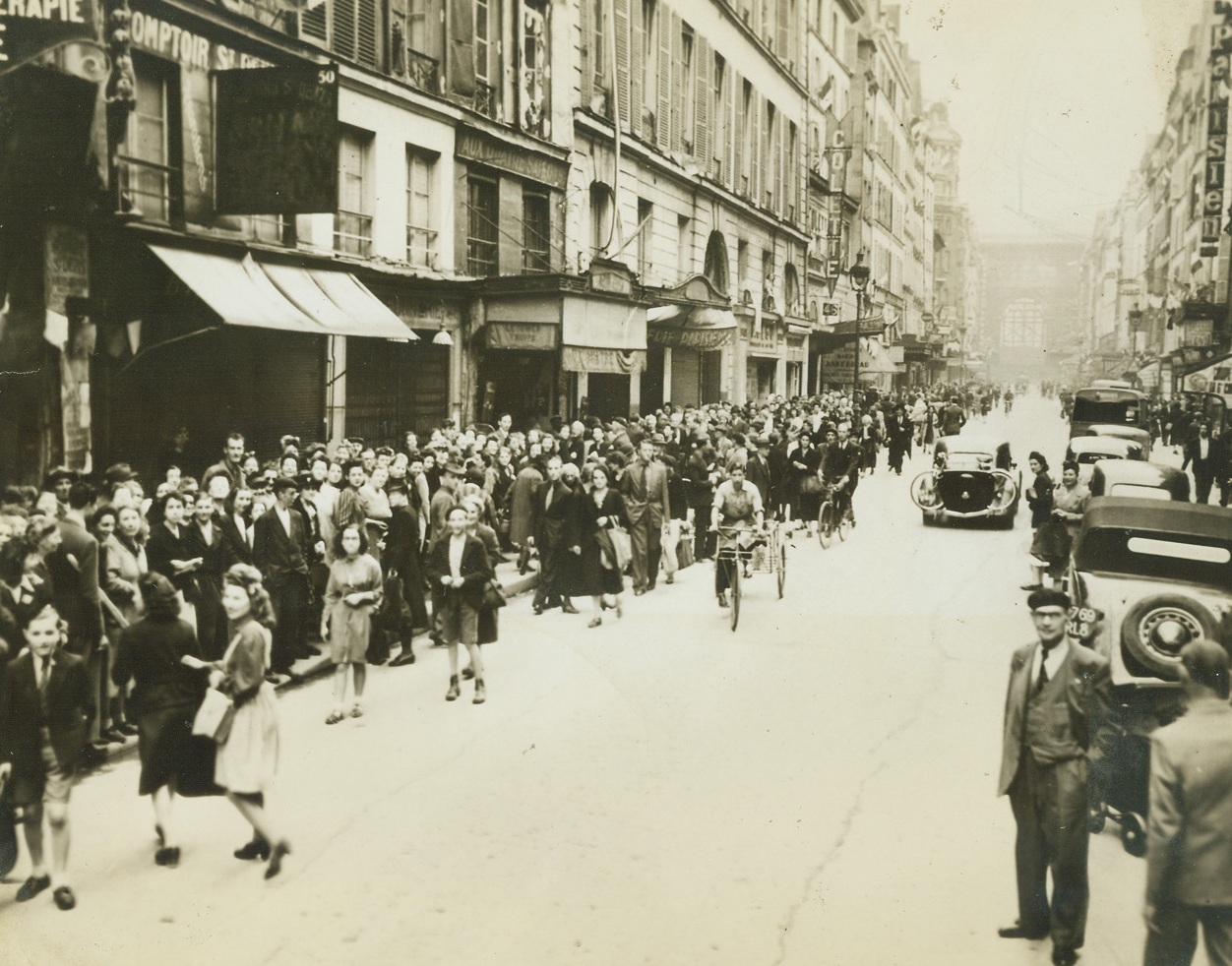
Hungry Paris Gets Food, 9/3/1944. Paris – Citizens of Paris line up on the sidewalk to receive their share of the food and flour brought into the capital by British Army trucks. The guerrilla fighting which preceded the liberation of Paris resulted in a supply breakdown and the food situation was acute when the Allies entered the city, Credit: ACME;
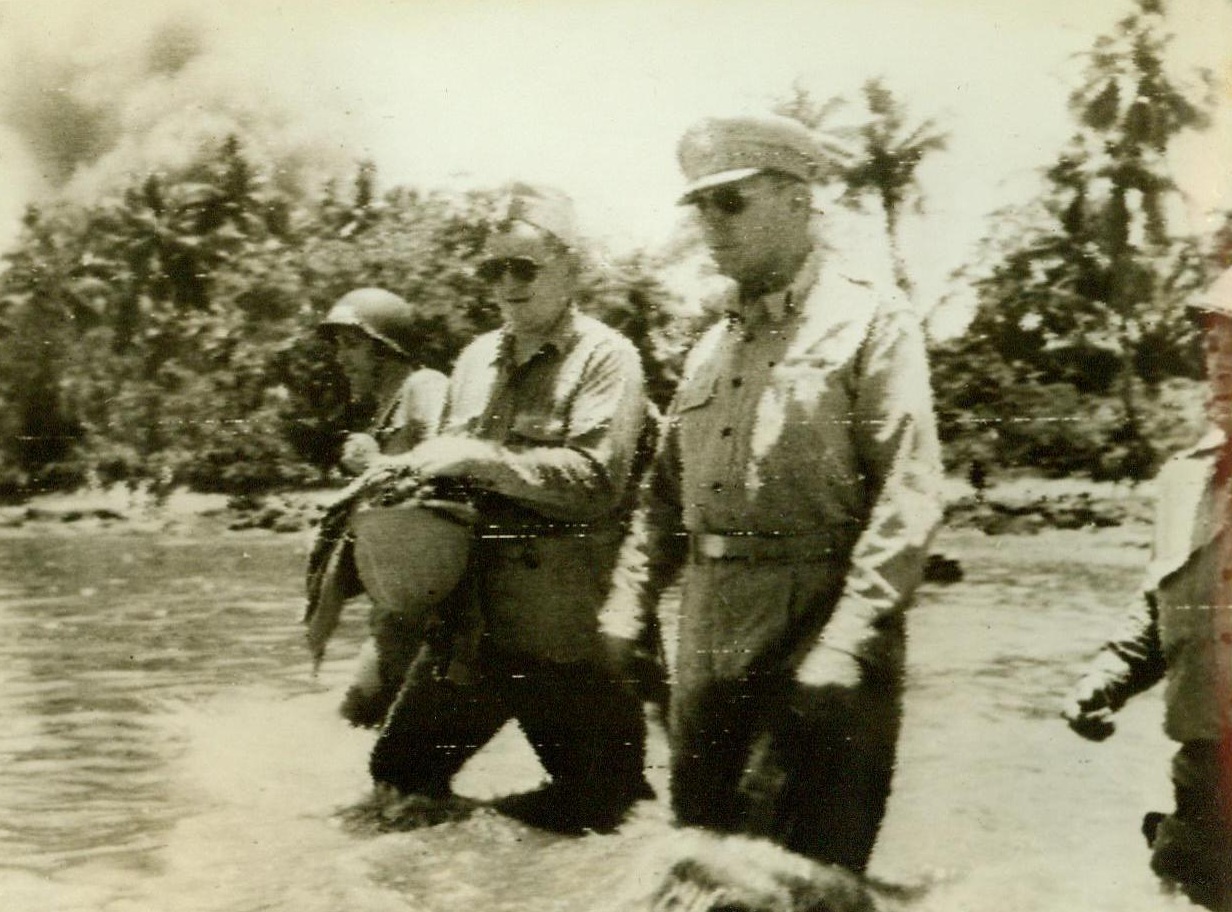
The General on the Scene, 9/19/1944. Morotai, Halmahera Is.—Wading through water knee-deep, Gen. Douglas MacArthur (right) heads for a landing barge as he returns to his ship after inspecting American troops on Morotai. The man on the left is an American Naval Doctor. In the background (Left) Smoke rises from a burning Jap oil dump. 9/14/44 (Acme);
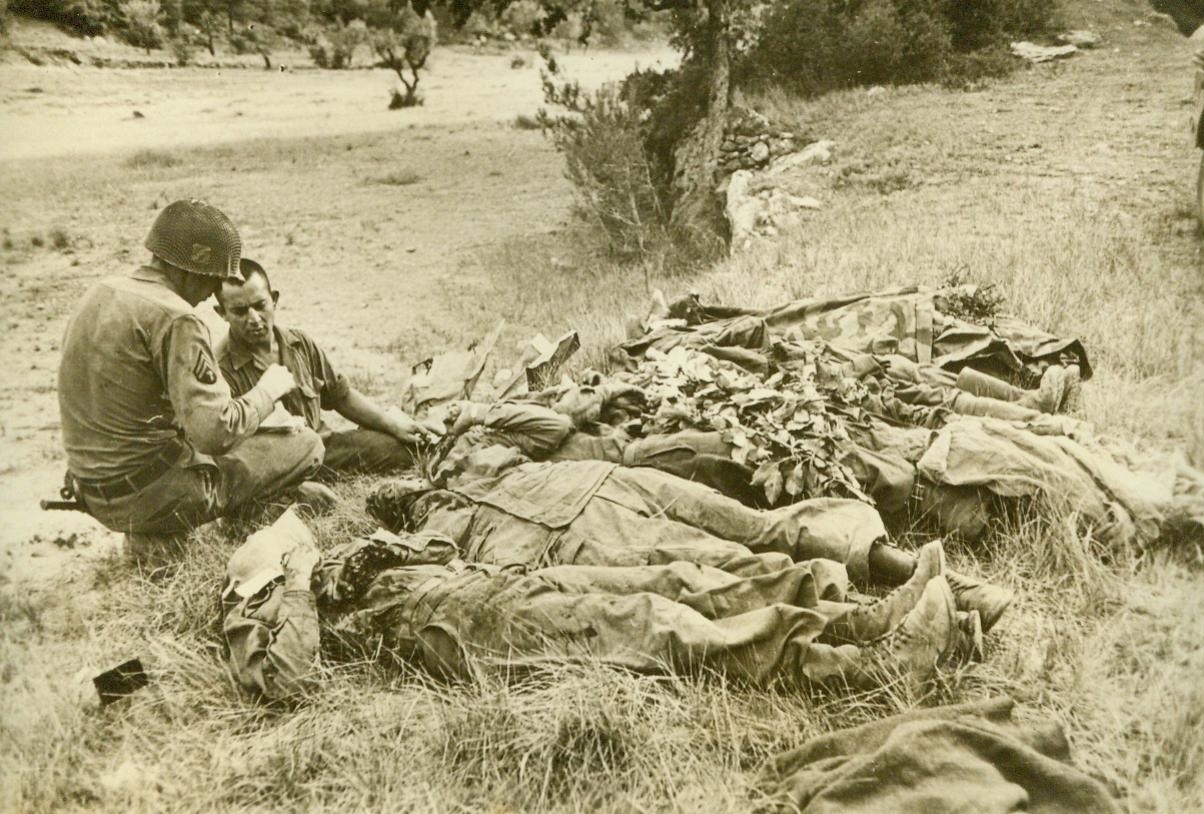
Death Knows No Discrimination, 9/9/1944. Southern France—Two American soldiers go about the grim job of identifying their dead, who lie on the slop of a mountainside in the south of France together with Germans who were killed in the battle for Aix-En-Provence 9/9/44 (ACME);
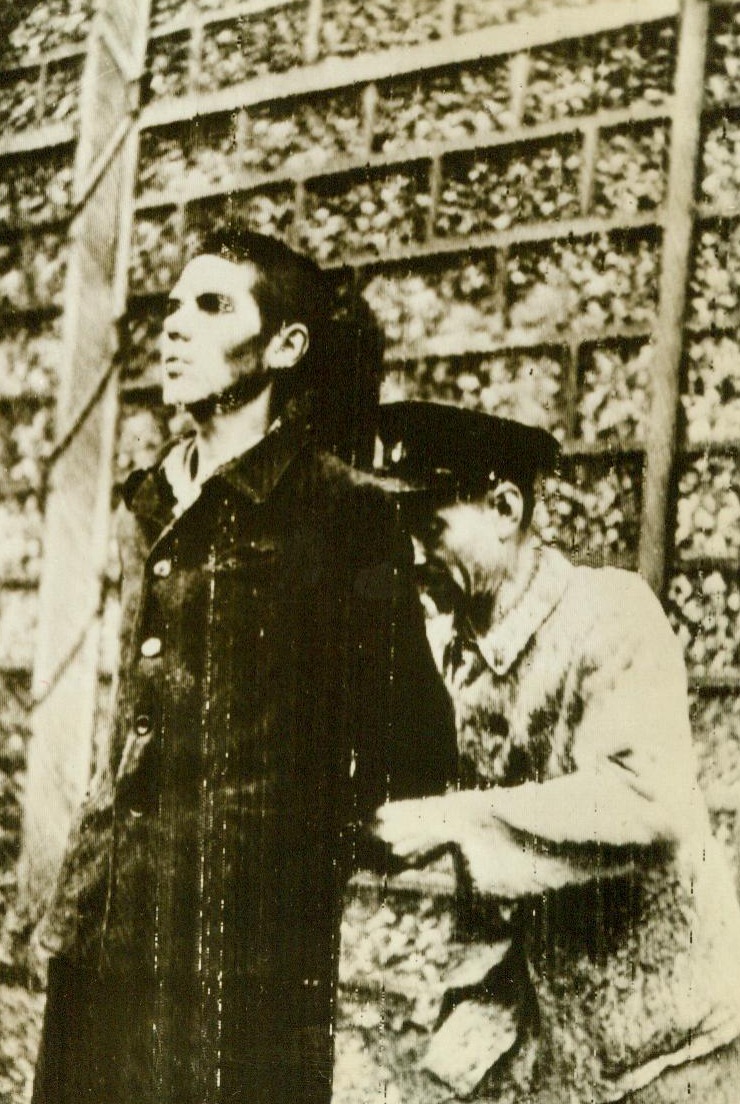
Collaborationist's End, 9/4/1944. Grenoble, France—Found guilty of collaborating with the Germans, this young Frenchman stares straight ahead as he is fastened to the stake for execution by the FFI. He was one of six former members of the French Militia who were condemned to death by a military court 9/4/44 Acme RadioPhoto;

Judgment Day, 9/13/1944. Belgium—The day of reckoning is at hand for this mean-looking trio of disloyal Belgians. Rounded up by the F.I.N. (Front Independent of Namur), Belgian resistance group, they await trial for treason and other charges. Kneeling in foreground is the Mayor of Olloy, who worked with the Gestapo. The sorry little man in background wears a Nazi cap and overcoat sizes too big for him 9/13/44 Acme;
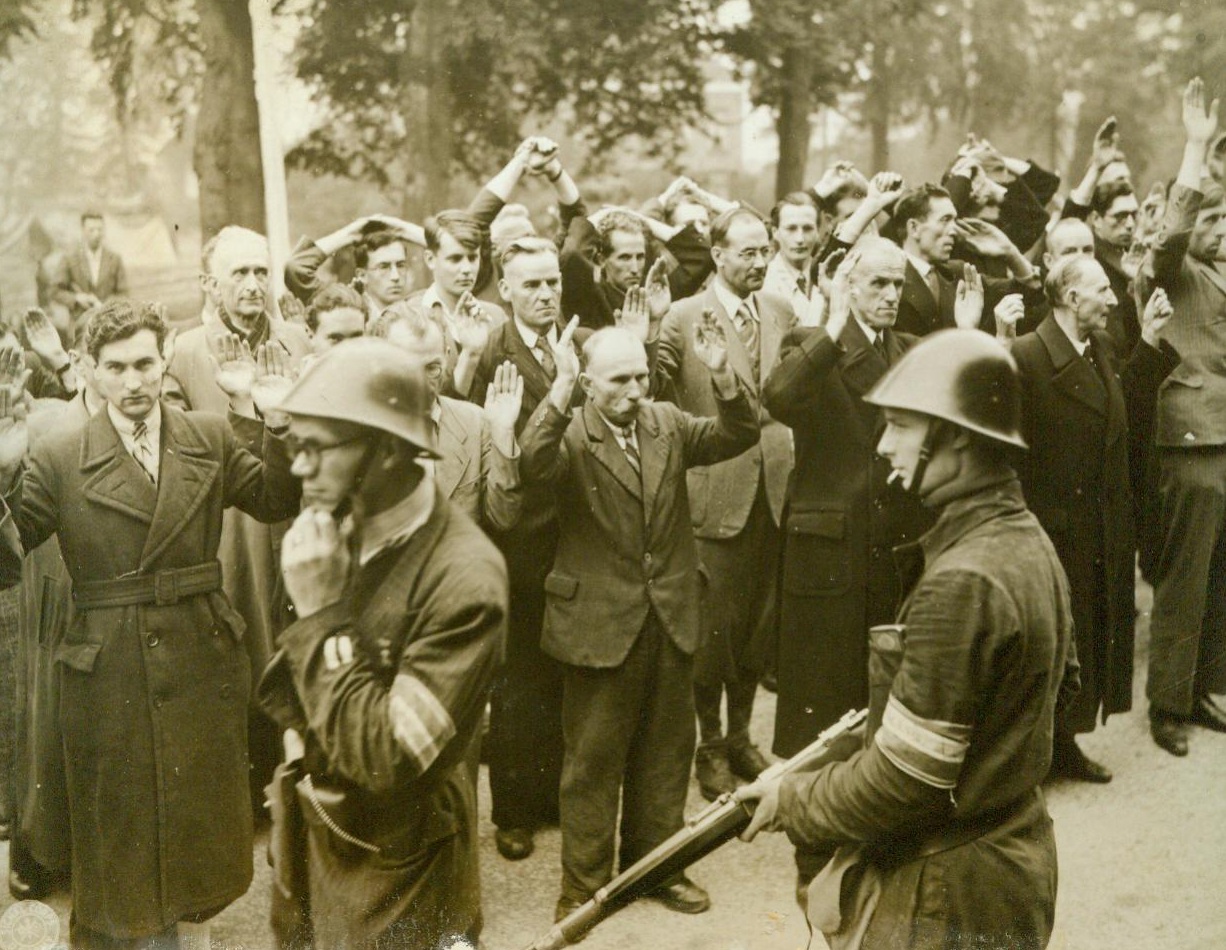
Their Day Has Passed!, 9/27/1944. Citizens of Nijmegen, Holland, accused of collaborating with the Nazis, are rounded up by fellow townsmen, carrying weapons and wearing Dutch Army Helmets. Note the varying shades of fear on the faces of the prisoners 9/27/44 ACME;
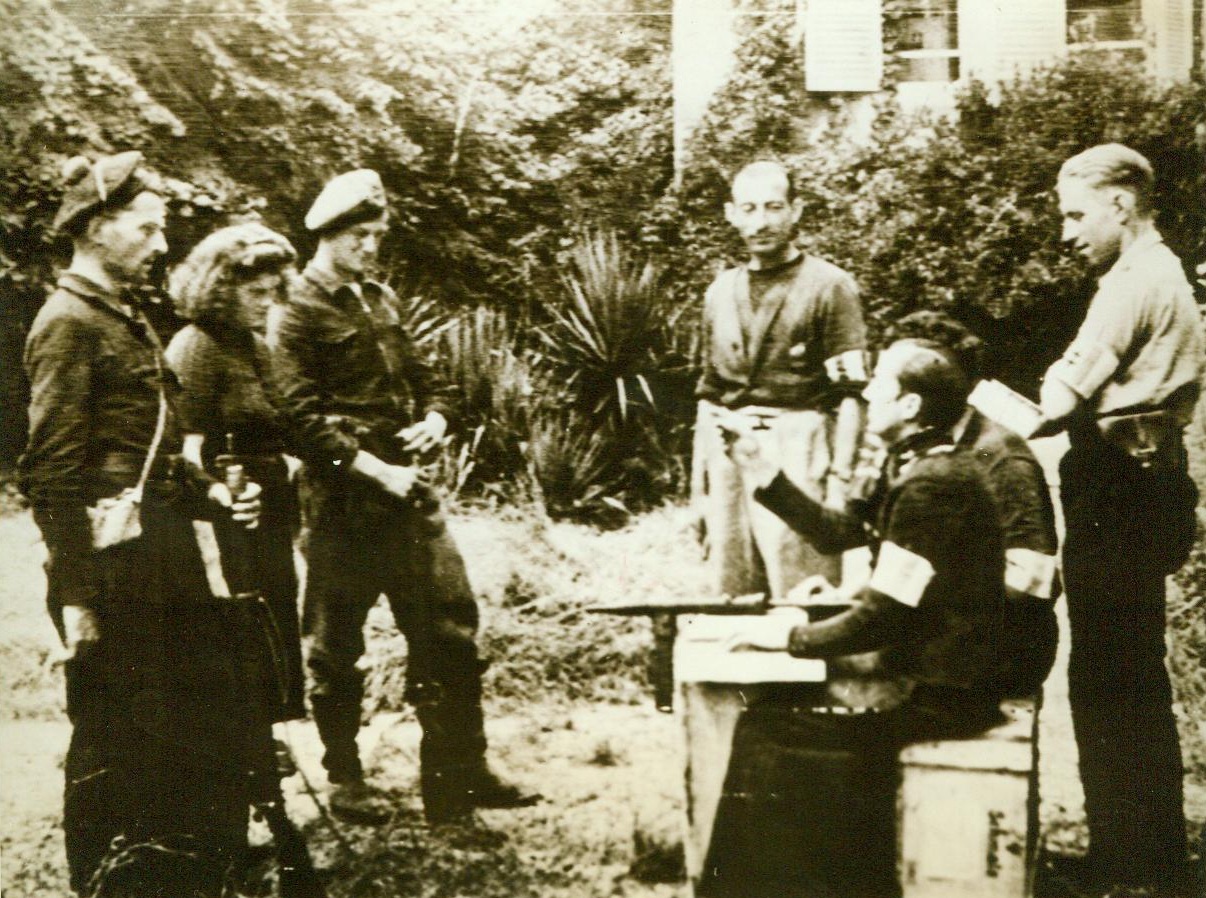
Their Day Has Passed!, 9/27/1944. Citizens of Nijmegen, Holland, accused of collaborating with the Nazis, are rounded up by fellow townsmen, carrying weapons and wearing Dutch Army Helmets. Note the varying shades of fear on the faces of the prisoners 9/27/44 ACME;
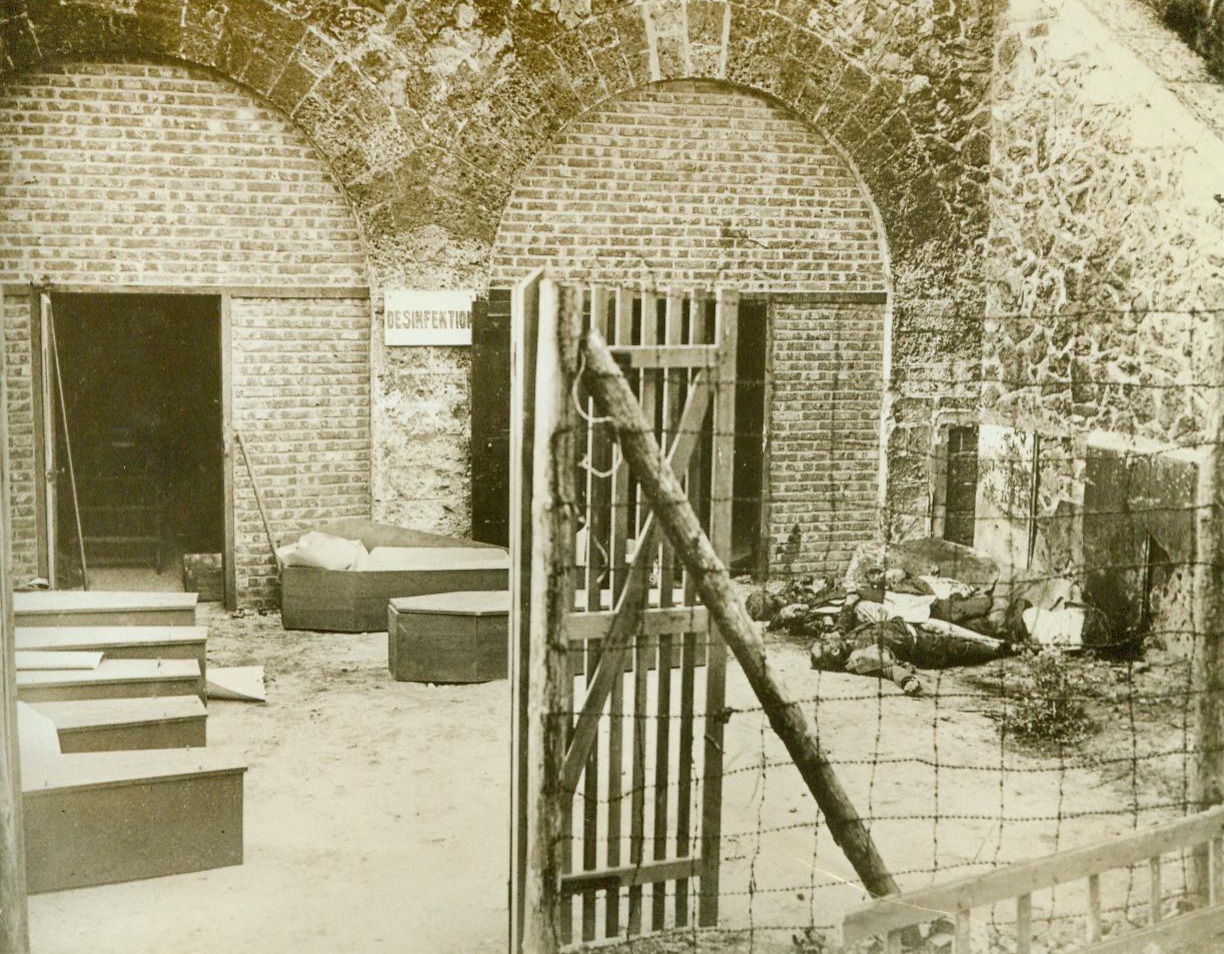
The French Don't Forget, 9/8/1944. Paris -- Memories of this - The burying place at Fort Du Romainville for French civilians who were cruelly mutilated by the Germans and other Nazi atrocities brought the work of the French underground in Paris to a head, and they rose as a body to wrest their city from the enemy, without thought of outside aid. Note the unburied bodies still lying in the rear of the courtyard in this picture, made by an FFI photographer during the week before Paris fell, when the French Forces of the Interior were fighting without any Allied assistance to wrest their Capital from the Germans. 9/8/44 (ACME);
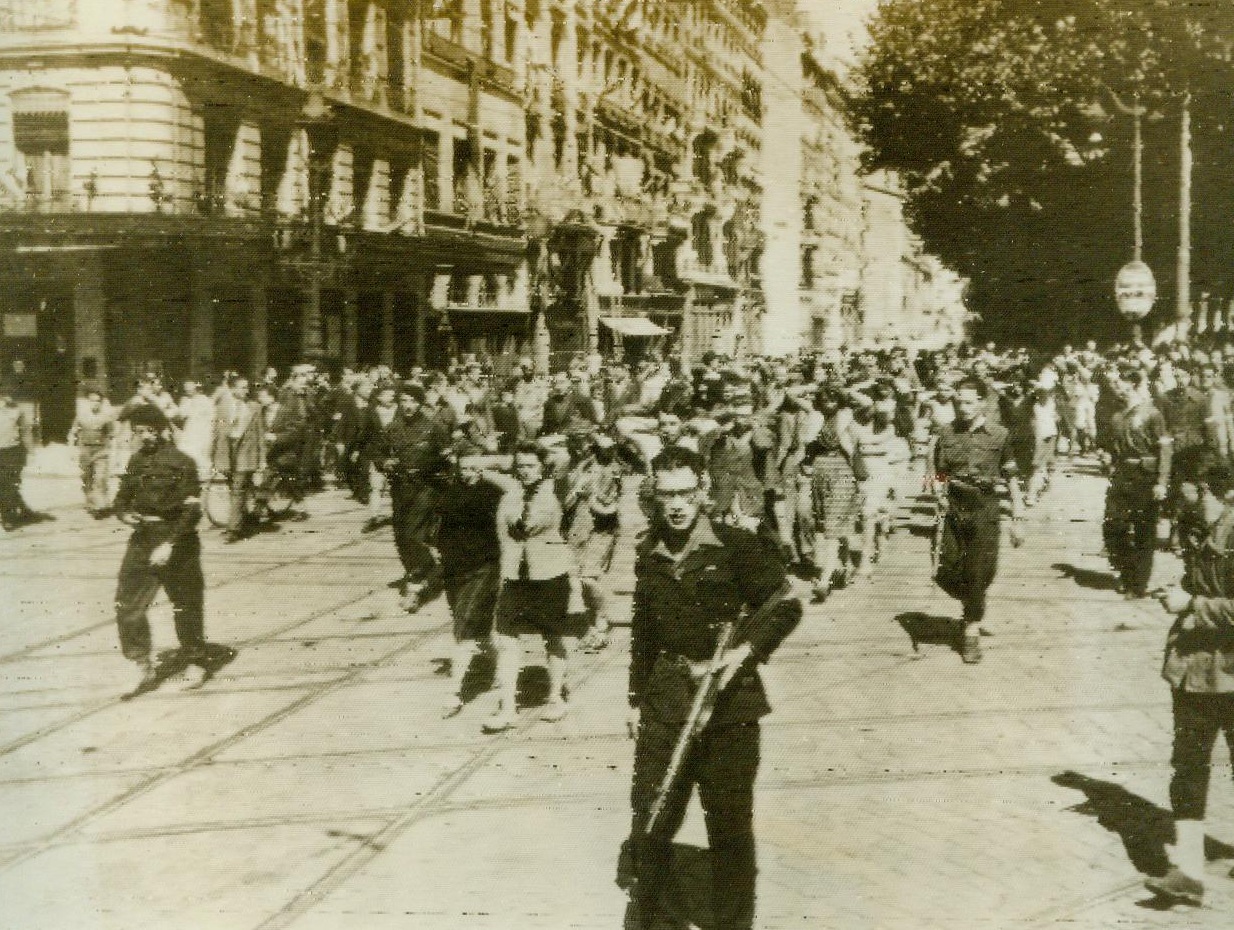
Mopping Up Enemy Symmpathizers, 9/7/1944. Lyon, France -- Under the guard of The French Forces of the Interior, Nazi collaborators, most of them women, are marched through a street in Lyon after the liberation of France's third largest city. 9/7/44 (ACME);
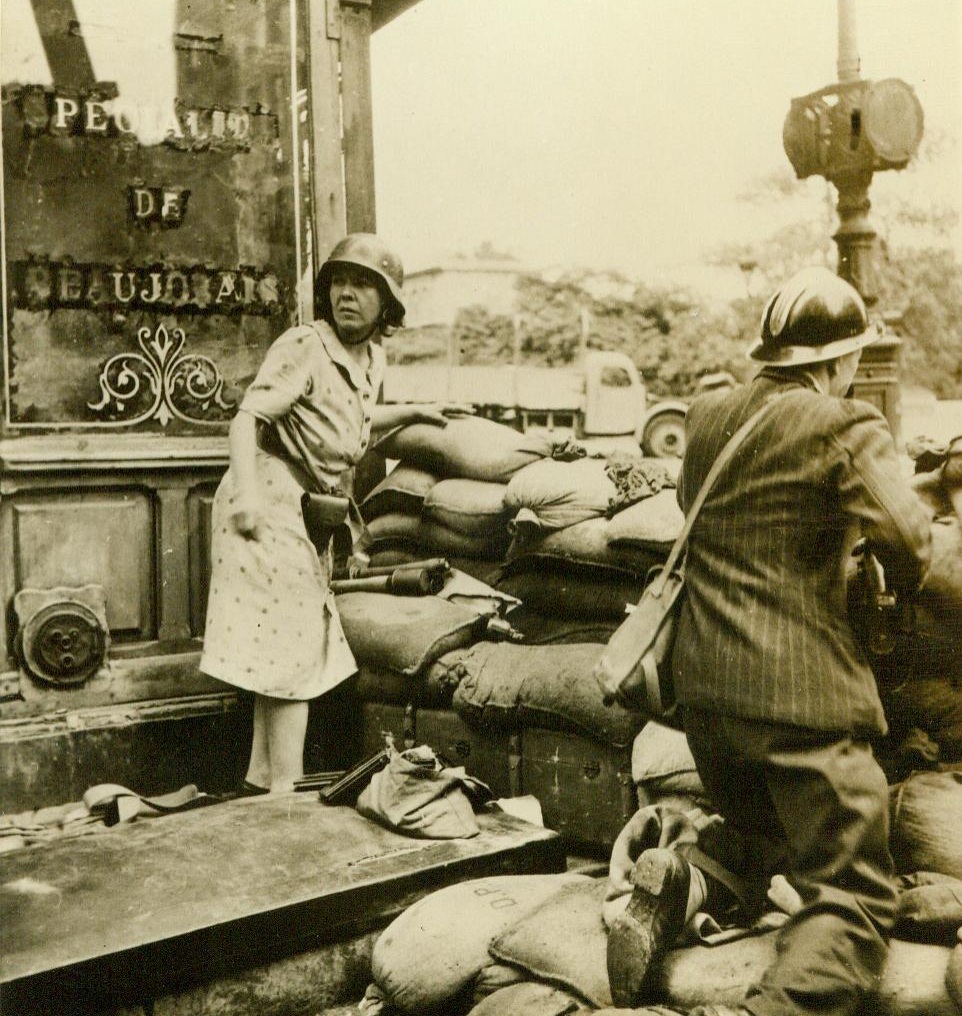
French Men And Women Fight For Beloved City, 9/8/1944. Paris -- After years of planning, members of the French Forces of the Interior rose as one to fight for Paris. Behind a sandbag barricade a helmeted French woman and man, both armed with weapons taken from the Germans, fight the hated Nazis in the streets of Paris. This picture, taken by an FFI photographer, was made during the week before Paris fell, when the French people were fighting to wrest their capital from the Germans without aid from Allied troops 9/8/44 (ACME);
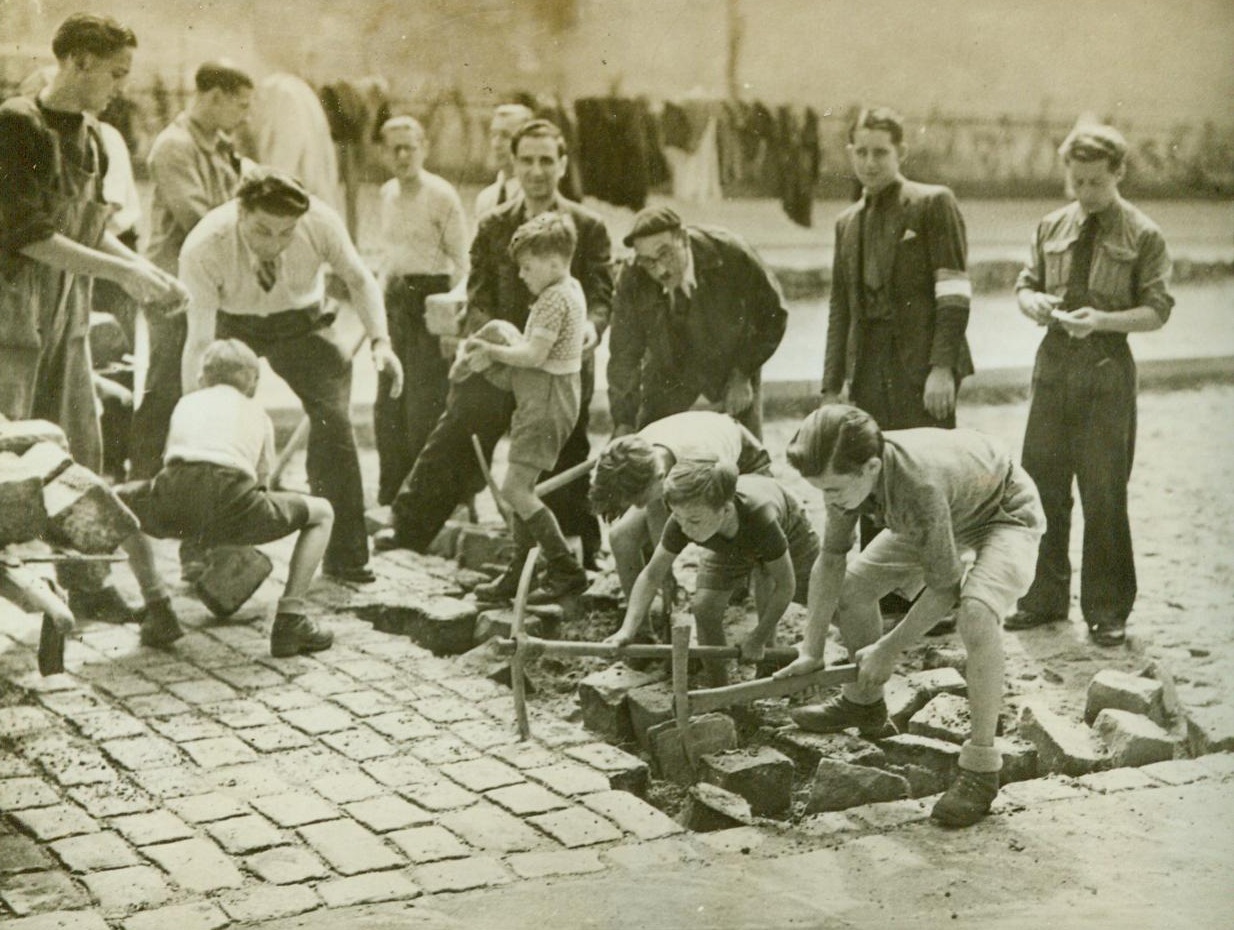
Echoes Of A Bygone Dau, 9/8/1944. Paris -- Reminiscent of the French Revolution days is this picture, made as another Revolution was in progress - When the French people again rose against tyranny, just as they did in the first. Here French people, young and old, work feverishly to tear up the paving stones in the street to make barricades against the Germans, as the French Forces of the Interior rose against the Nazis. This picture was made by an FFI photographer in the week before Paris fell, when the French people were fighting to wrest their capital from the Germans before any Allied troops had entered the city. 9/8/44 (ACME);
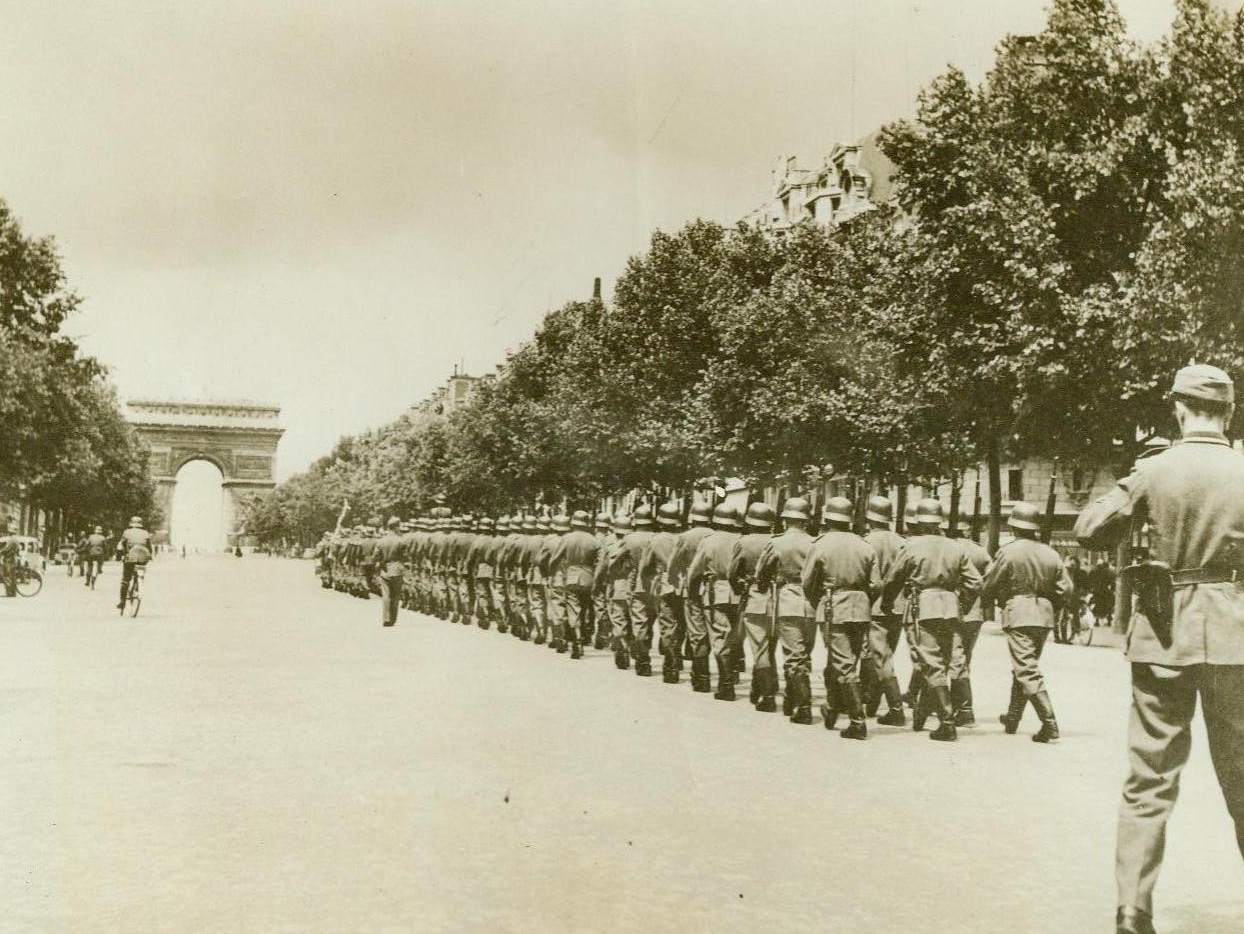
Footsteps That Now Are Only An Echo, 9/8/1944. Paris -- Unaware that they were treading this route for the last time, German soldiers goose-step down the Champs Elysees toward the Arc De Triomphe, in the last parade of their might before the liberation of Paris. This picture, made by a member of the FFI, was taken during the week before Paris fell, as the first stirrings of the underground began to take form in street fighting and assaults on the Nazis, to be climaxed by the wresting of the French capital from the hated Germans. 9/8/44 (ACME);

Farewell To Arms, 9/2/1944. Paris -- In a final gesture of surrender, German prisoners throw down their arms while a French Gendarme stands by watchfully. Scenes like this were enacted throughout the capital, as Germans began giving up the struggle platoon by platoon.;
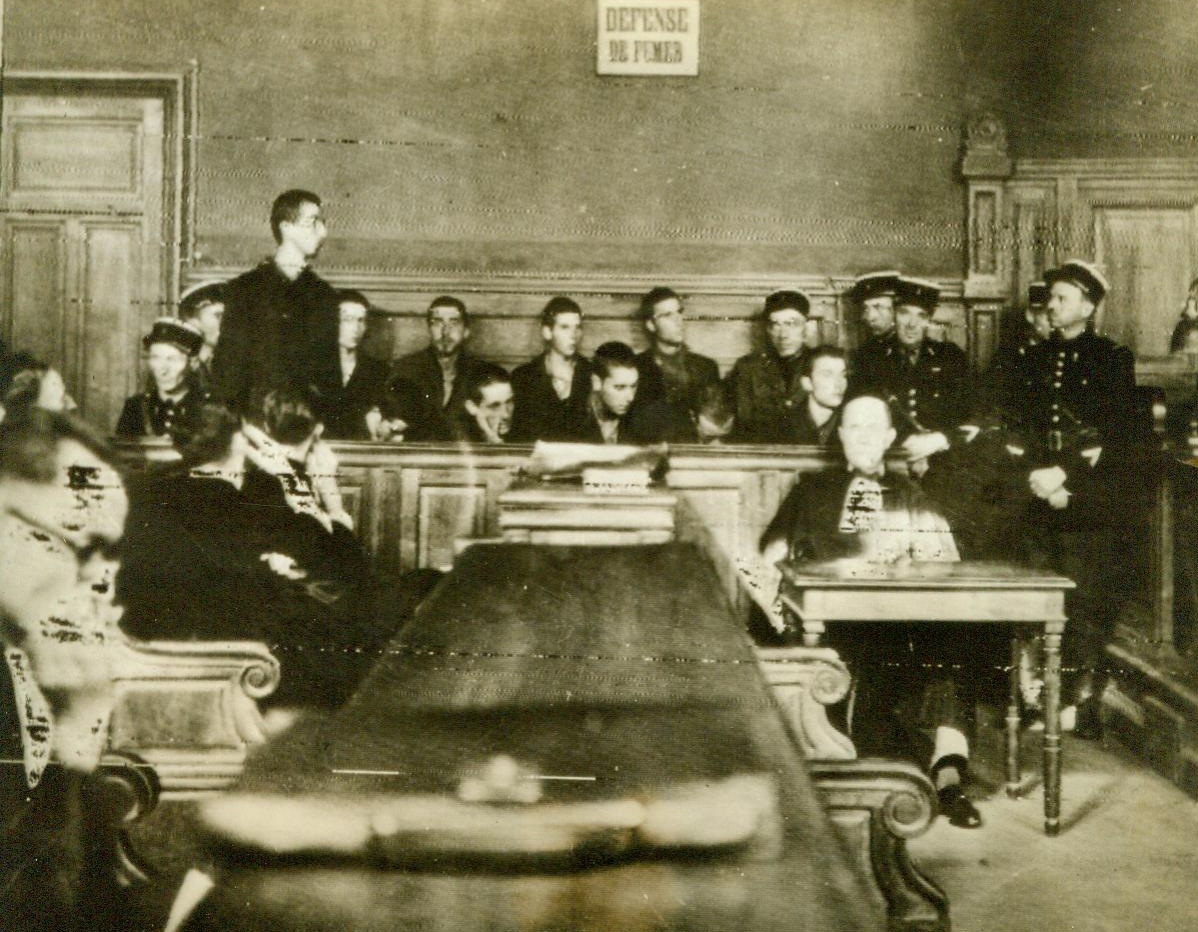
Brought To Trial For Their Crimes, 9/4/1944. Grenoble, France -- Ten youthful Frenchmen- former members of the Militia at Grenoble -- Stand trial on charges of collaborating with the Nazis. A military court condemned six of the accused to death, two to hard labor for life, and two to five years imprisonment. 9/4/44 (ACME);
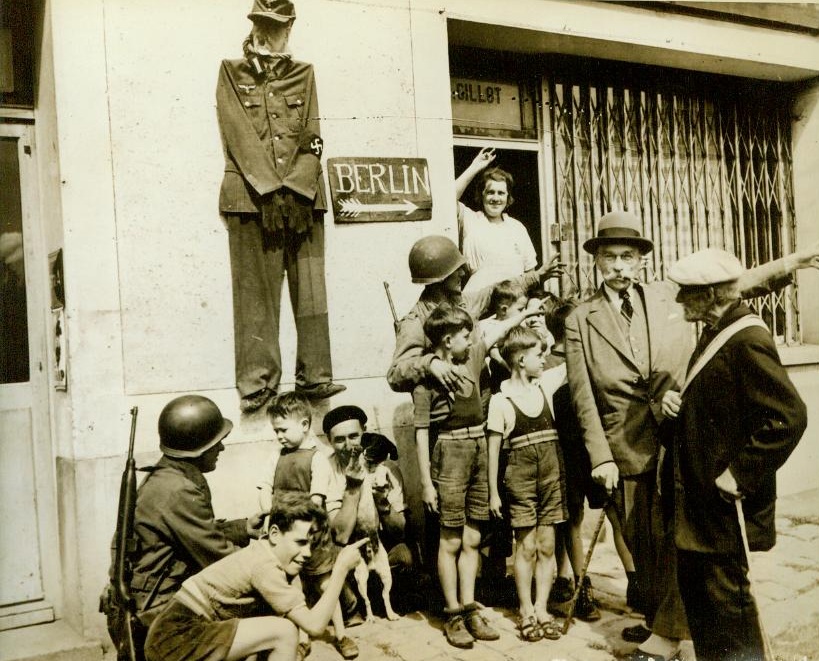
Hitler In Effigy And Road To Berlin, 9/7/1944. France -- Residents of Chateau-Thierry, France, stand under a dummy of Hitler hanging on a wall and point out the road to Berlin to two U.S. soldiers. Yanks are Pvt. Gordon Conroy (left), of Milford, N.H., and Pvt. William Rosenberg (under Berlin sign), of 10 Franklin Place, Woodmere, L.I., N.Y. 9/7/44 (ACME);
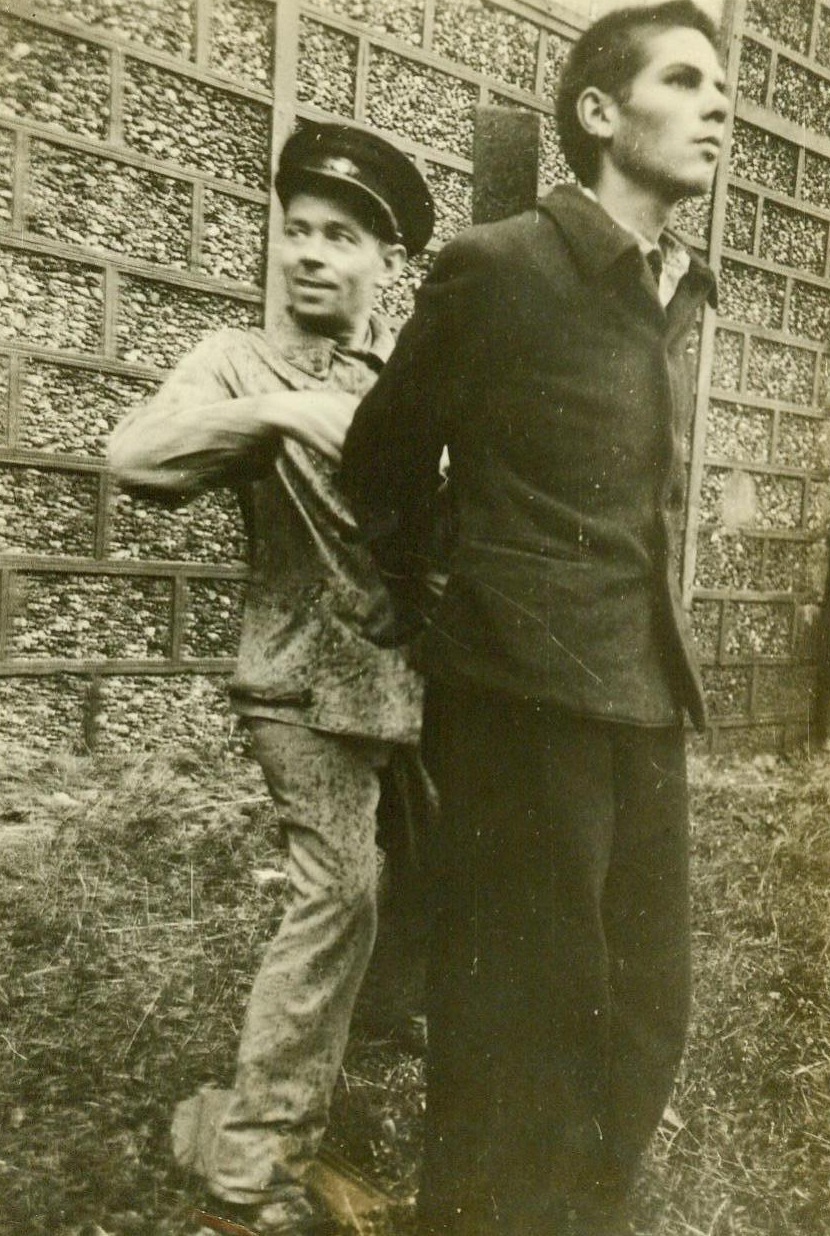
Payment For Treason, 9/20/1944. Grenoble, France -- In the early evening of September 2, the French citizens of Grenoble gathered en masse about the wall of a factory to witness the execution of six French youths, found guilty of treason by the FFI in a trial conducted according to the strictest legal rules. The crowds surged forward in the driving rain, fighting for grandstand seats to watch the execution of the youthful traitors. They climbed telephone poles, hung onto windows, and several times charged the police in an attempt to get their hands on the six boys, who each admitted their part in the treason against their country. A member of the FFI, as he ties one of the six condemned youths to the stake, reflects in his face the feeling of satisfaction he feels because he is helping to avenge the wrongs suffered by his beloved country during the years of Nazidom. 9/20/44 (ACME);
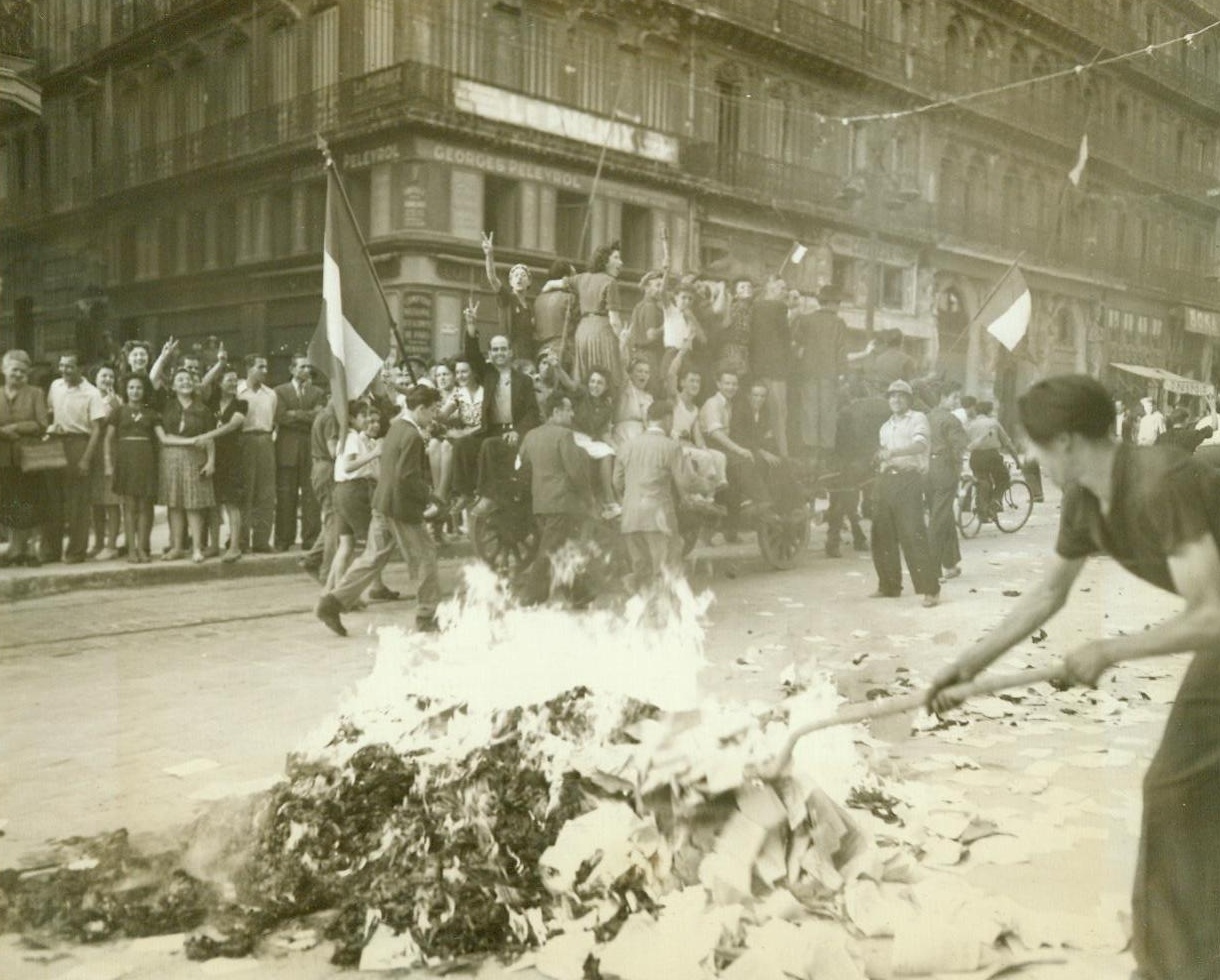
Victory Parade In Marseille, 9/9/1944. France -- While one Frenchman at right sets fire to torn German propaganda pamphlets, other residents of Marseille stage an impromptu victory parade down famous Canebiere riding a wagon, waving the Tricolor and wildly cheering the liberation of the great Southern French port from the Hun. The V-for-victory symbol is once again displayed by the jubilant Frenchmen -- This time as free men. 9/9/44 (ACME);
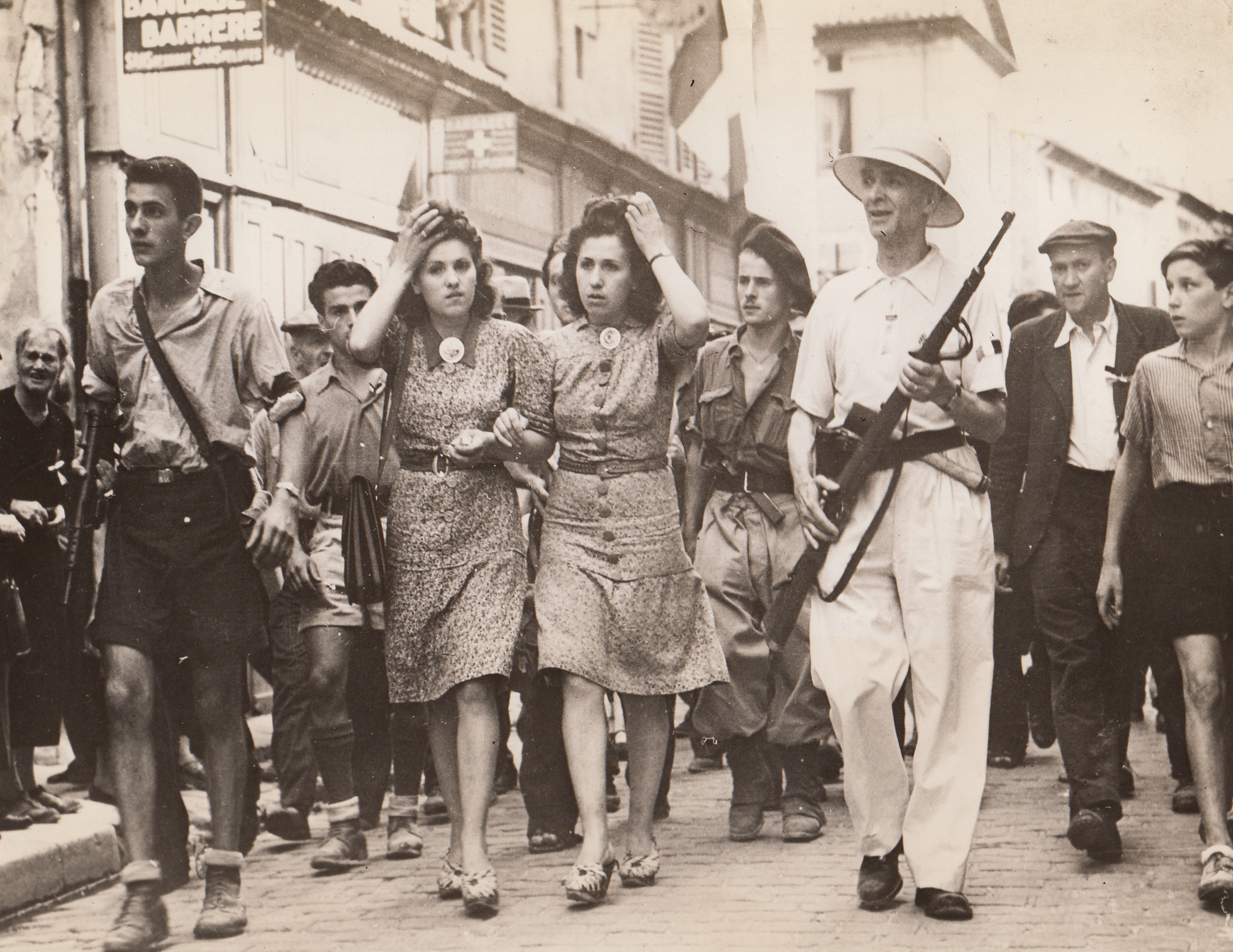
Fix Hair For Last Time, 9/14/1944. France – Two French collaborationists, being marched to prison in Montelimar, France, adjust their hair for the last time before paying the price for befriending the Nazis. Girls will have their locks shorn from their heads 9/14/44 Credit (Signal Corps Photo From ACME);
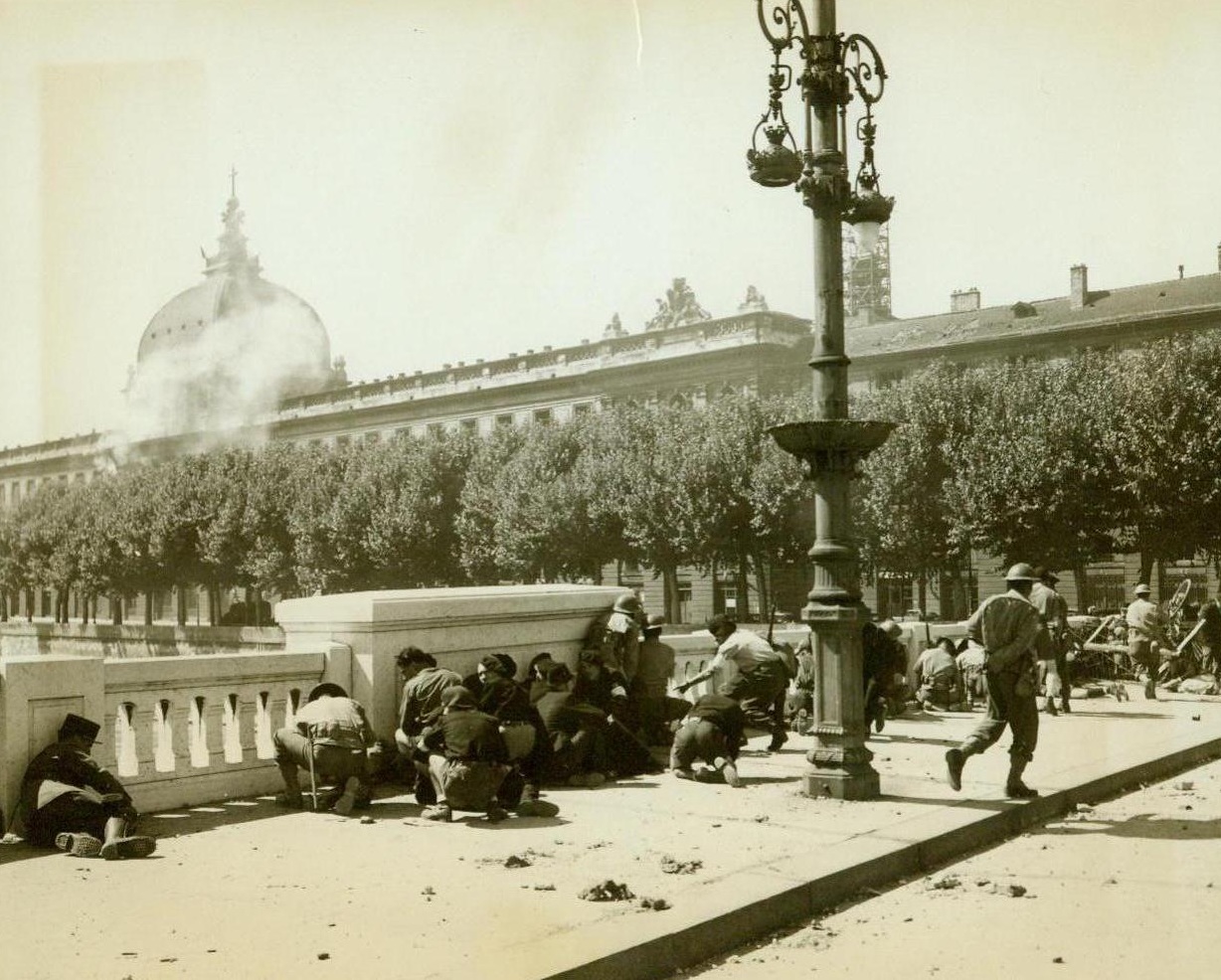
French Civilians Retaliate Sniper Fire, 9/12/1944. Lyon, France -- Before the liberation of Lyon was complete, the Maquis and French civilians had to do away with enemy snipers stationed throughout the city. Here Maquis, French troops, and civilians take cover behind a concrete wall as German sympathizers, manning two machine guns, fire on them from their stand in the Lyon hospital (background), on the south bank of The Rhone River. 9/12/44 (ACME);
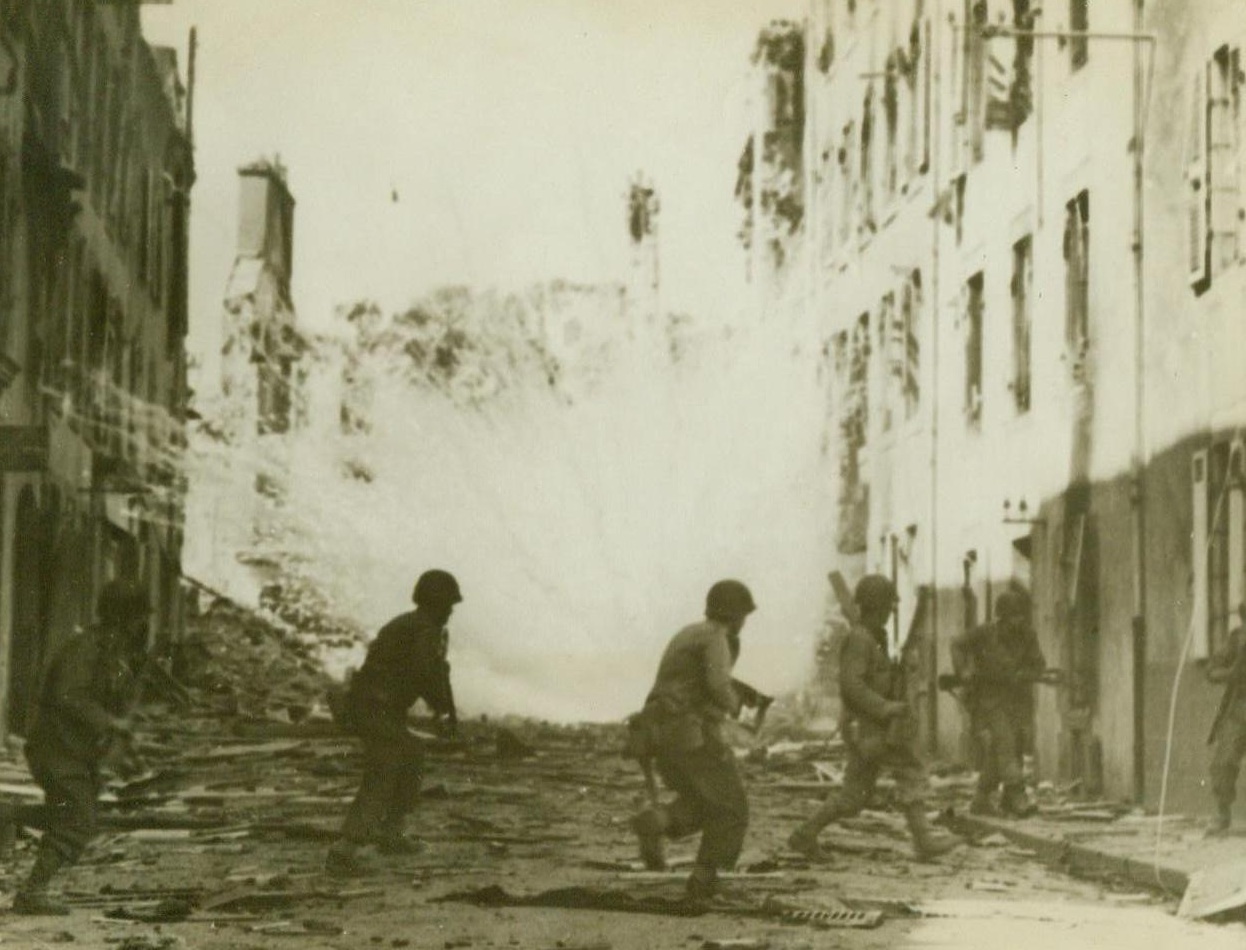
Yanks Fight In Face Of Fire, 9/23/1944. France -- American soldiers in the French port of Brest, now captured, dash across a street as a white phosphorus shell explodes almost in their midst. Bitter street fighting marked the final taking of this strategic city by American forces. 9/23/44 (ACME);
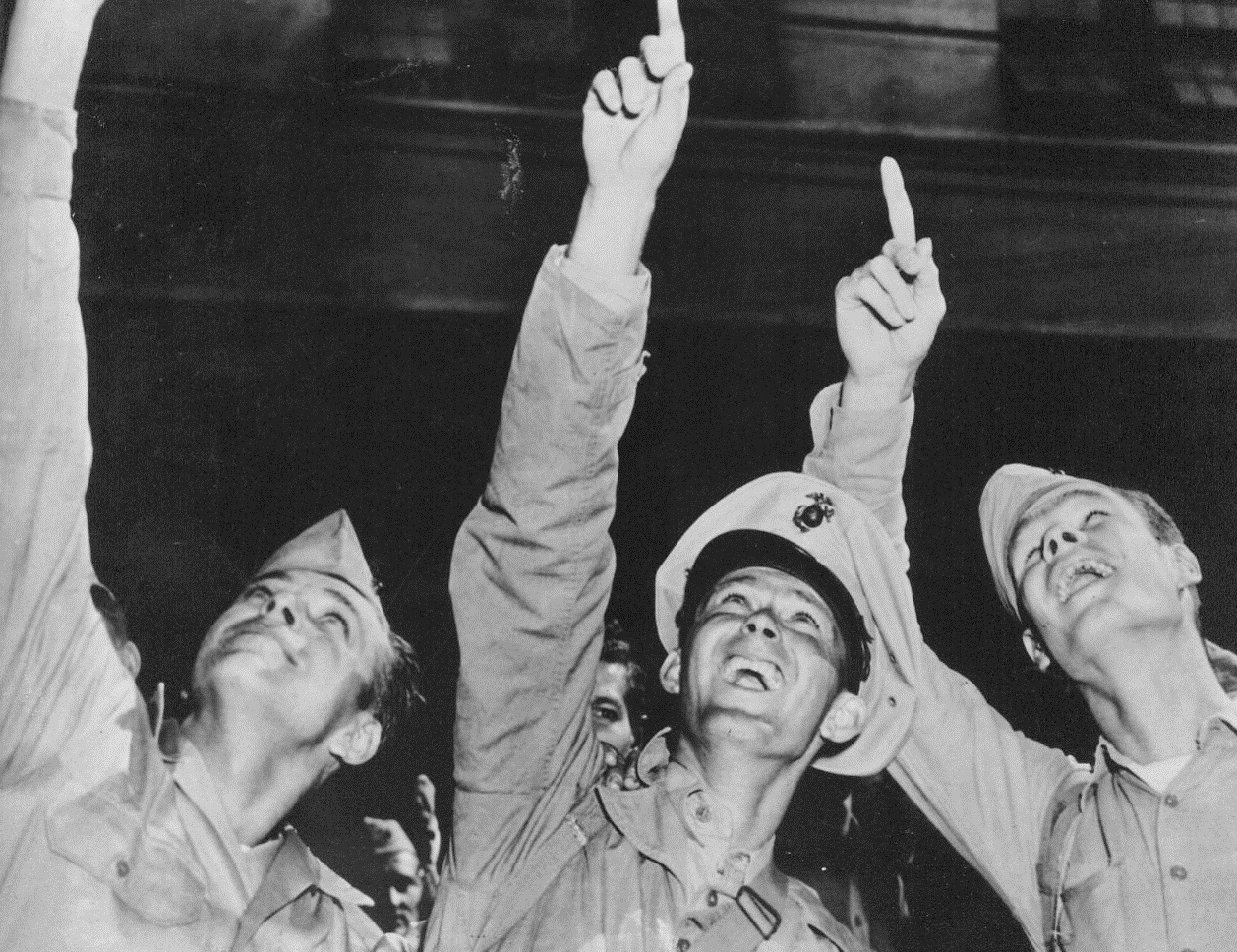
Hey, Look! Lady Marines!, 9/12/1944. San Francisco -- Thrilled with their first glimpse of office buildings, street cars, and lady Marines, these three veterans of famed Second Marine Division, who returned to San Francisco after more than two years of fighting in Central and South Pacific, really enjoy sightseeing. Left to right: PFC Boyd R. Magnuson, Riverside, Calif.; Pvt. Walter C. Tash, Fort Smith, Ark.; and PFC Charles Robinett, Cleveland, Tex. 9/12/44 (ACME);
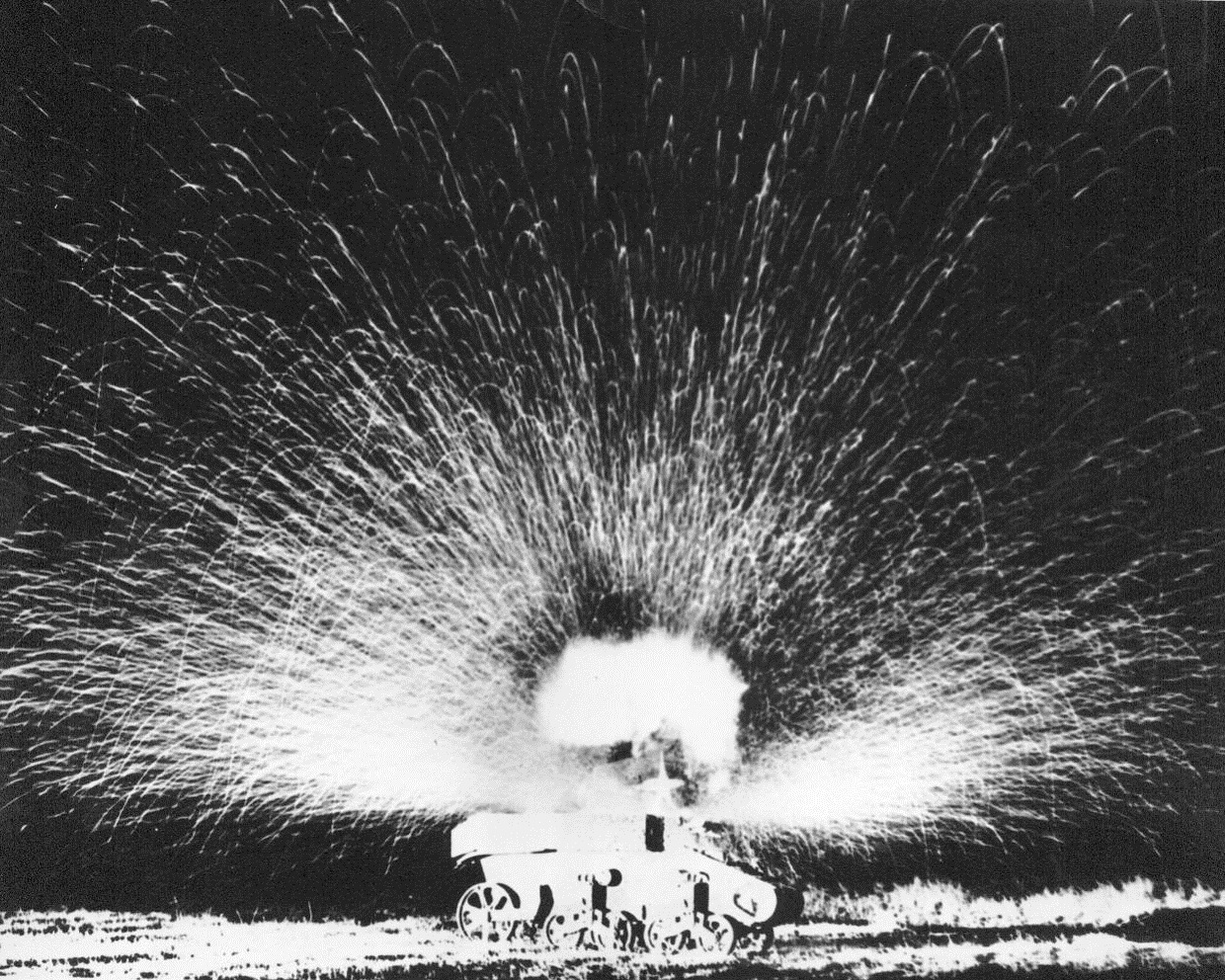
Bazooka Plays a Deadly Tune, 9/12/1944. Sparks fly in all directions in a display of pyrotechnics caused by the deadly power of the "Bazooka." A single high explosive rocket sends a shower of moltenmetal into the night and leaves a three-inch hole in the armor planting of the tank during exhibition at Camp Roberts, Calif.;
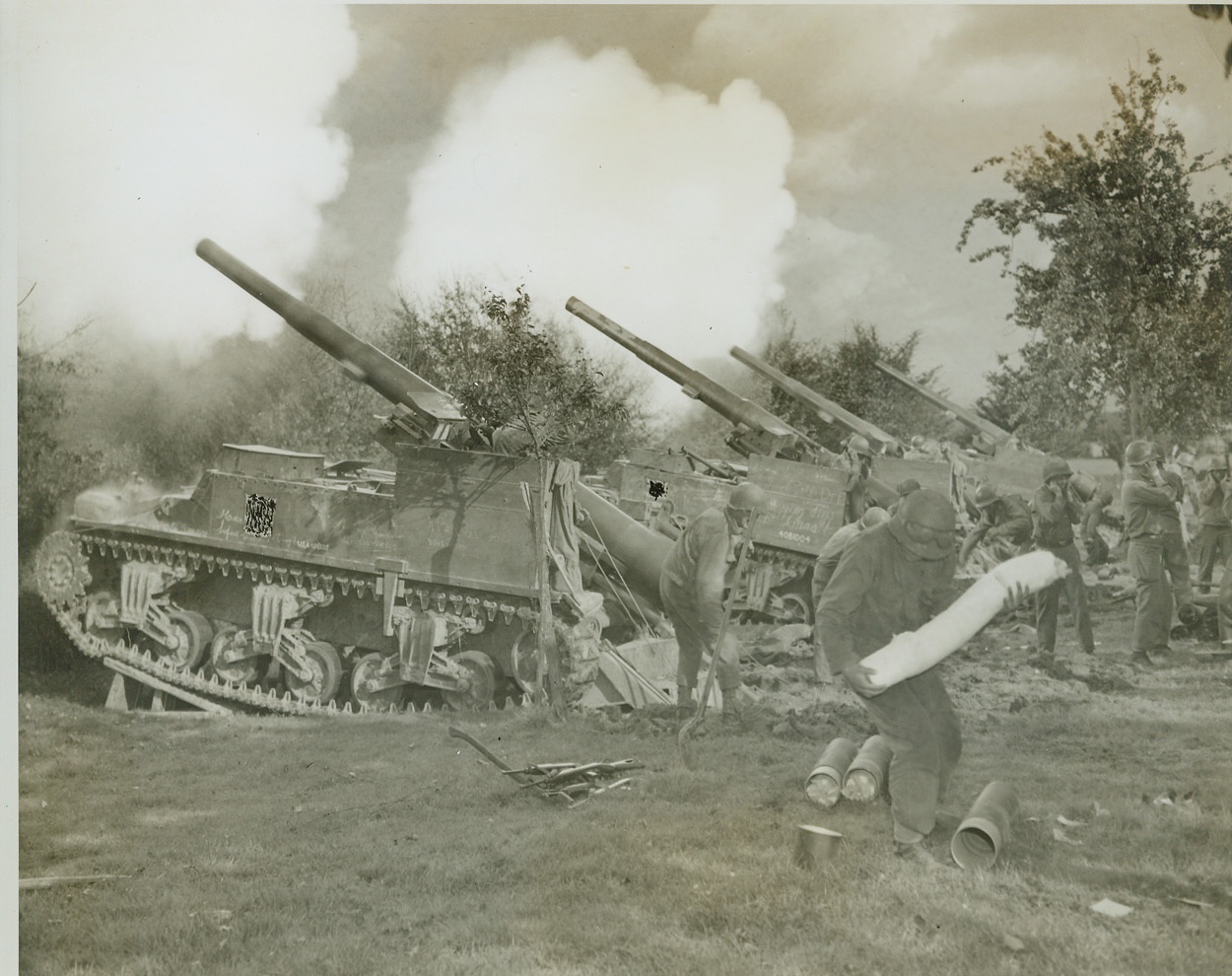
First American Heavy Guns to Fire into Germany, 9/16/1944. Here is a battery of American 155mm. self-propelled guns, mounted on Sherman tank chassis as they fired into the village of Bildehen, Germany, which is located six kilometers southwest of Aachen on the Liege-Aachen road. They opened the barrage with 21 rounds of high explosive shells each weighing 100–pounds. Credit: (Acme Photo by Andrew Lopez for the War Picture Pool);

Shoe On The Other Foot, 9/24/1944. Germany – German housewives ruefully inspect the ruins of their shell-wrecked homes as American troops bring the war to the “impregnable” Fatherland. 9/24/44 (ACME);

British Watch Over Rhine, 9/24/1944. Germany – With gun on his shoulder, a British soldier stands in his command post over looking the captured bridge across Waal, the Rhine’s main outlet to the sea. Note the Hitler photo on the inside of the sentry box 9/24/44 (ACME);
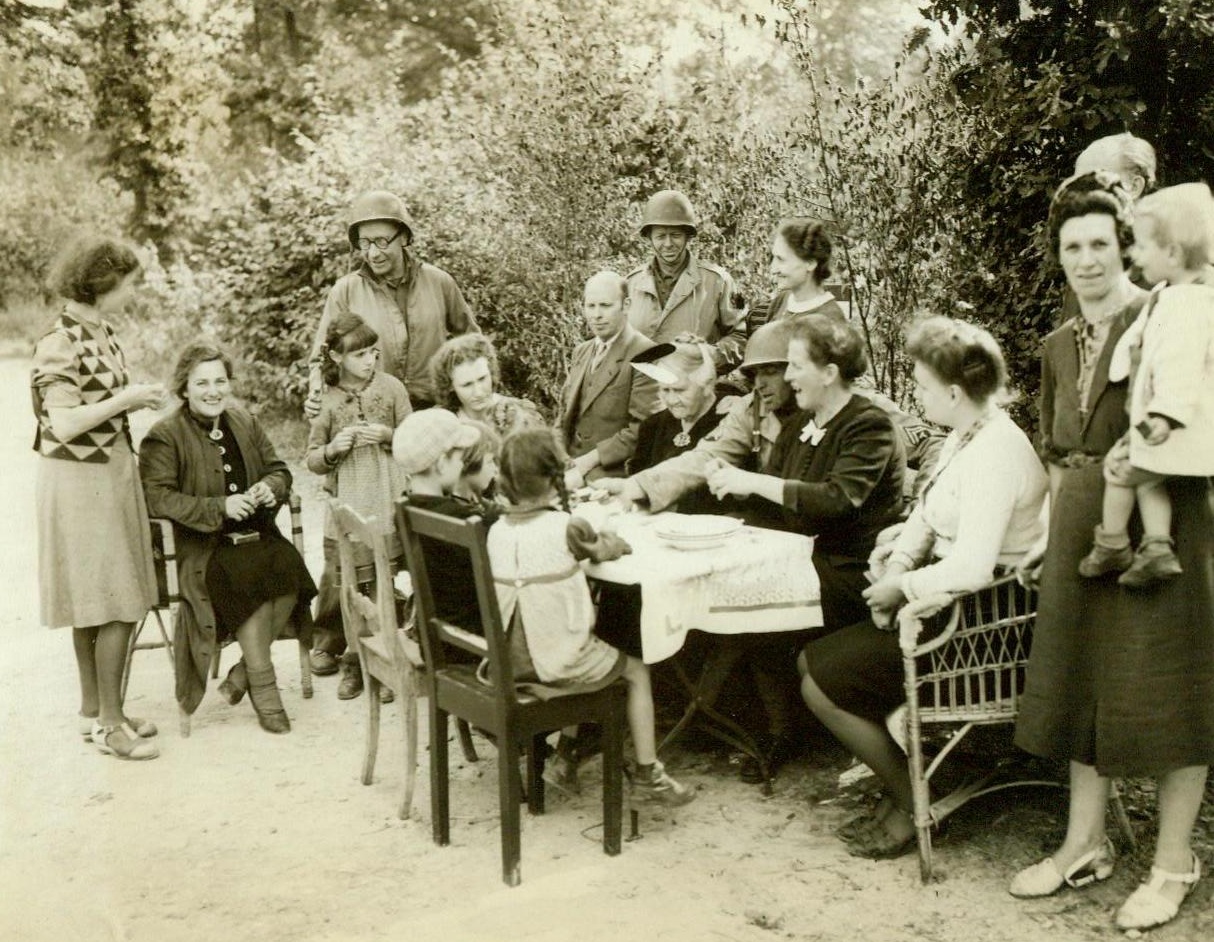
Food For The Downtrodden, 9/18/1944. Germany – Residents of a small German village, who had the courage to greet Allied warriors as liberators, look happy as they sit down to a meal of American rations. Cpl Mel White, of Harlan, Iowa, distributes the food to the hungry members of a large German family. 9/18/44 (ACME);
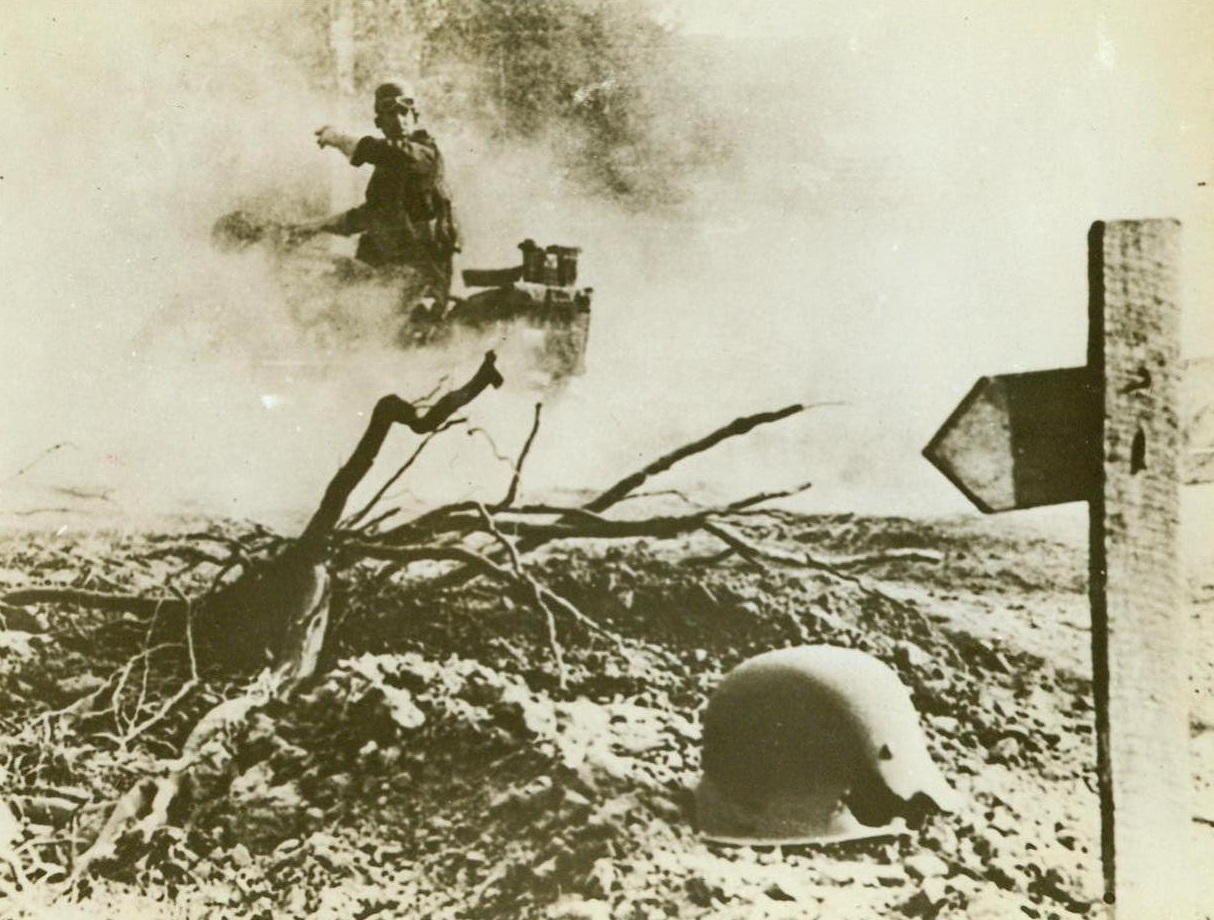
Vignette Of War, 9/17/1944. France – All but obscured by rising dust, this British dispatch rider moves with the British Army in pursuit of the Germans. All along the roadside is evidence of the enemy defeat, graves, unburied dead, scattered helmets and other equipment. 9/17/44 (ACME);
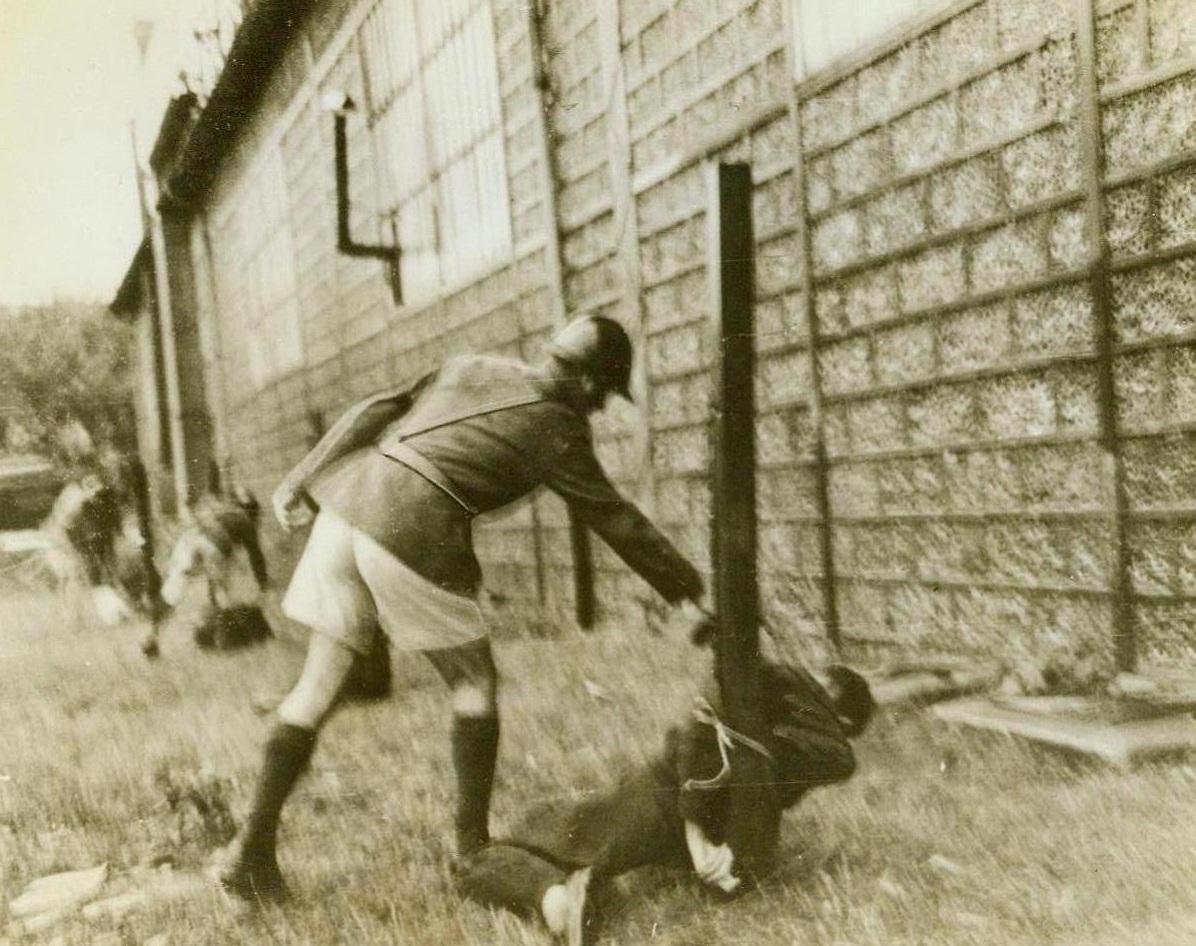
Coup De Grace, 9/20/1944. Grenoble, France—In the early evening of September, 2 the French citizens of Grenoble gathered en masse about the wall of a factory to witness the execution of six French youths, found guilty of treason by the FFI in a trial conducted according to the strictest legal rules. The crowds surged forward in the driving rain, fighting for grandstand seats to watch the execution of the youthful traitors. They climbed telephone poles, hung onto windows, and several times charged the police in an attempt to get their hands on the six boys, who each admitted their part in the treason against their country. According to the tradition of French executions, members of the firing squad administer the Coup De Grace to six youths, who die a quick death as the guns are fired through their heads 9/20/44 (ACME);
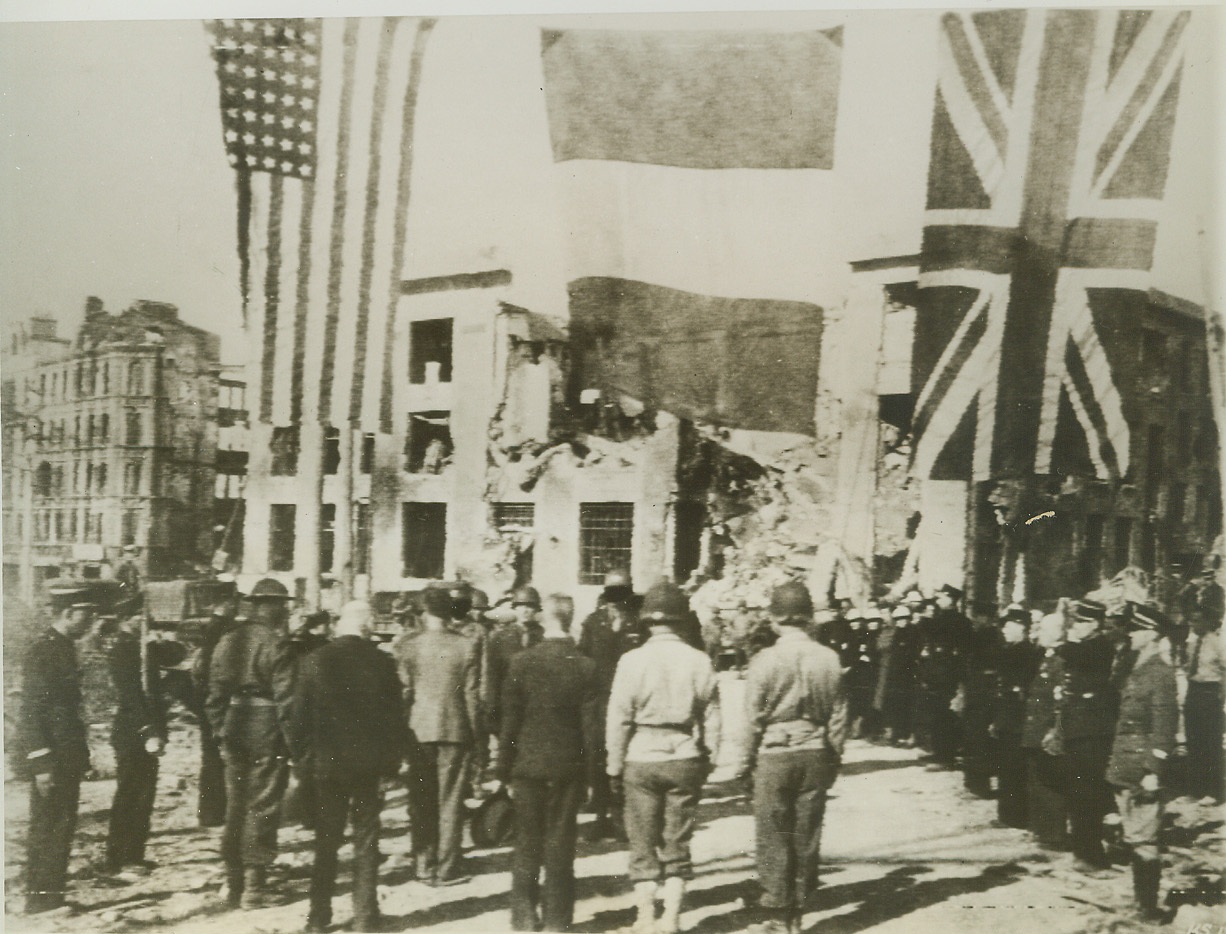
Another French City Liberated, 9/26/1944. Under huge American, French and British flags, Maj. Gen. Troy H. Middleton turns control of the City of Brest over to Mayor Jules Lullien. The ceremonies took place on the same spot where the city was surrendered to the Nazis four years ago. Gen. Middleton is commanding general of the 8th Corps. Credit: (Army Radiotelephoto from ACME);

American Jeeps See Paris, 9/3/1944. PARIS -- Spaced out across the wide Paris street, American Jeeps with trailers participate in the grand parade of US troops and mechanized units on August 29. Civilians line the streets, eager to view their liberators. Credit (ACME) (WP);
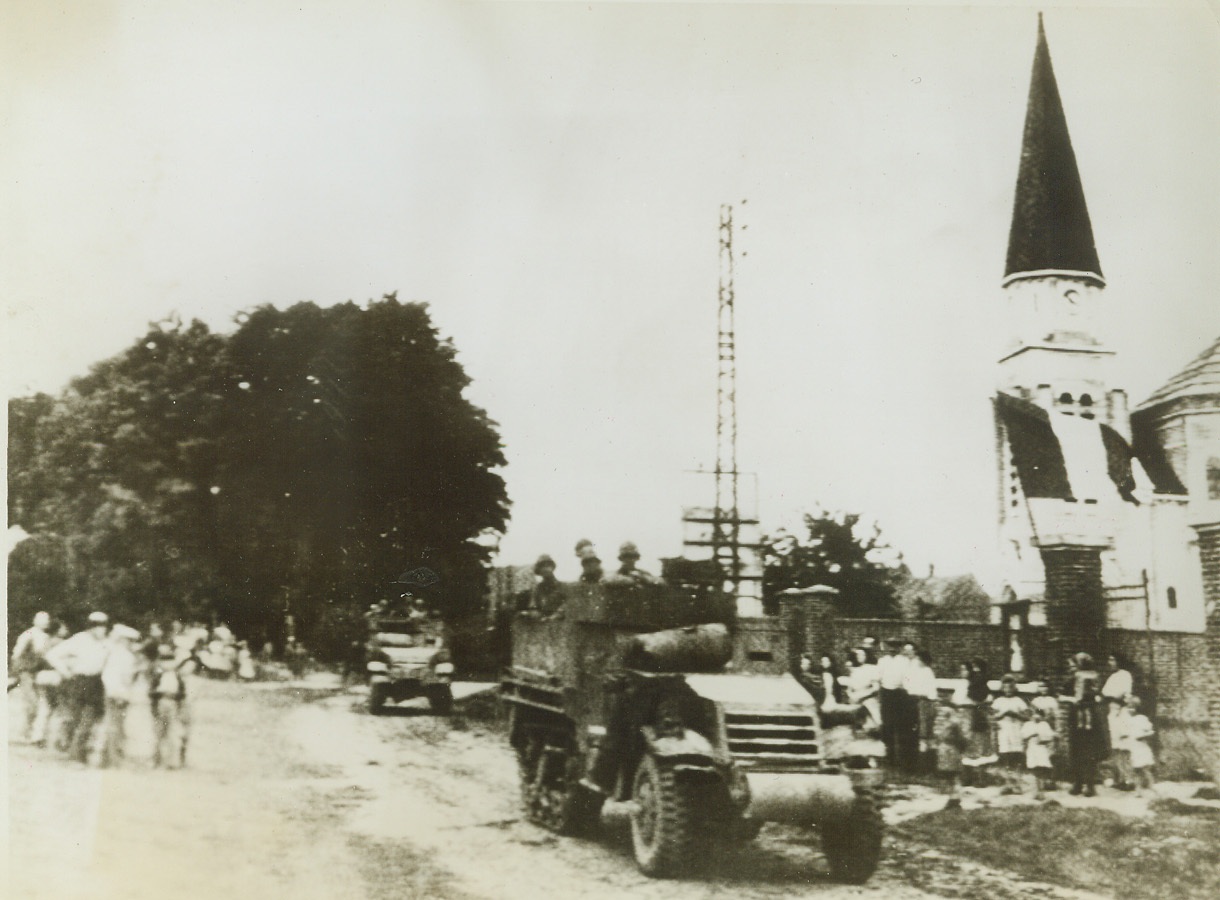
Yanks Reach Former Battleground, 9/4/1944. CANTIGNY, FRANCE -- Yank troops roll through the town of Cantigny, where their fathers fought one of the greatest battles of World War I twenty-six years ago. Civilians come out to cheer the liberators as they roll by. Credit: (Army Radiotelephoto from ACME);
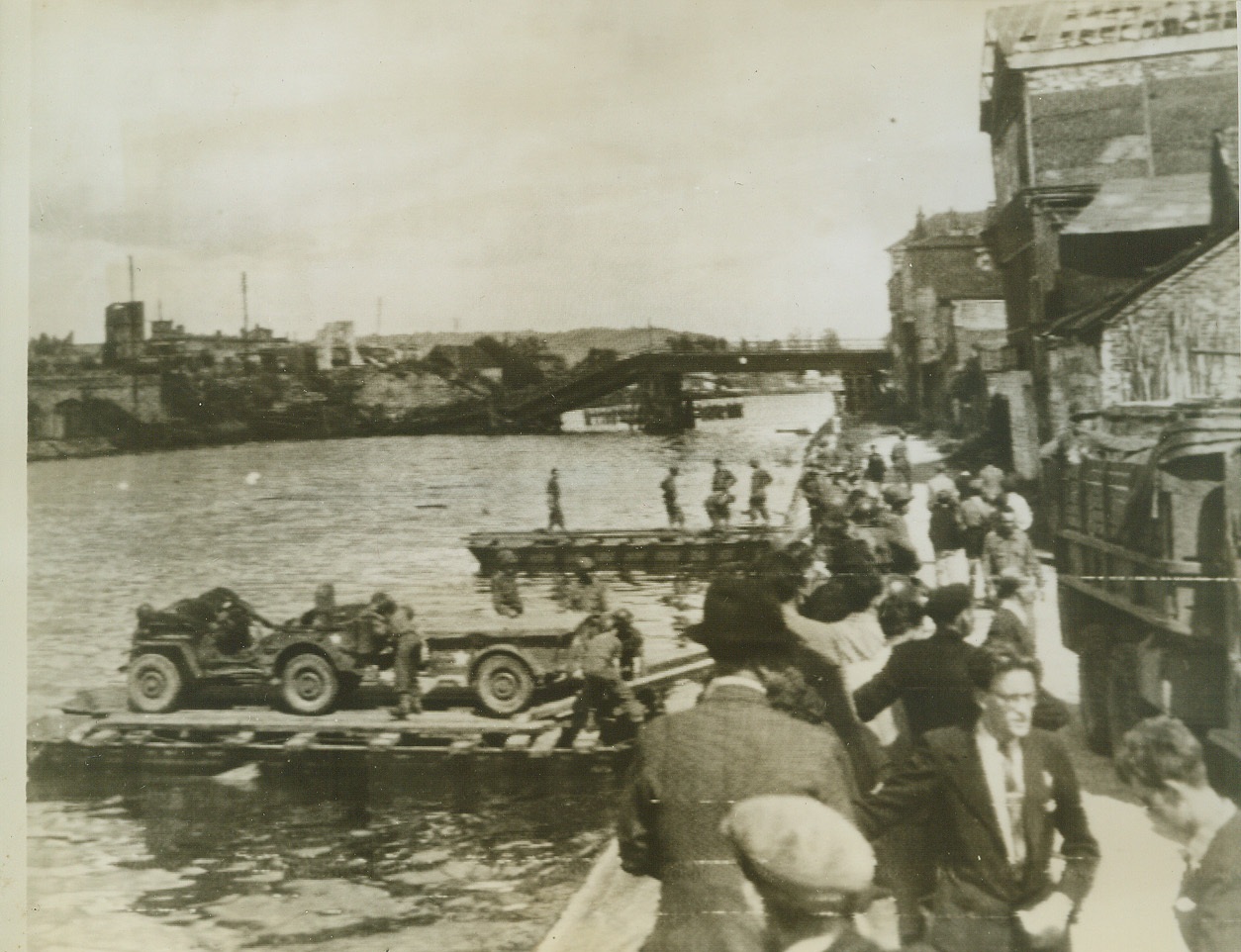
Jeeps Cross the Oise, 9/4/1944. COMPEIGNE, FRANCE -- Traveling on rafts, propelled by ropes from the opposite shore, American Jeeps cross the Oise River near Compeigne. In the background is the wreckage of the main bridge, which was destroyed by fleeing Nazis. Credit: (Army Radiotelephoto from ACME);
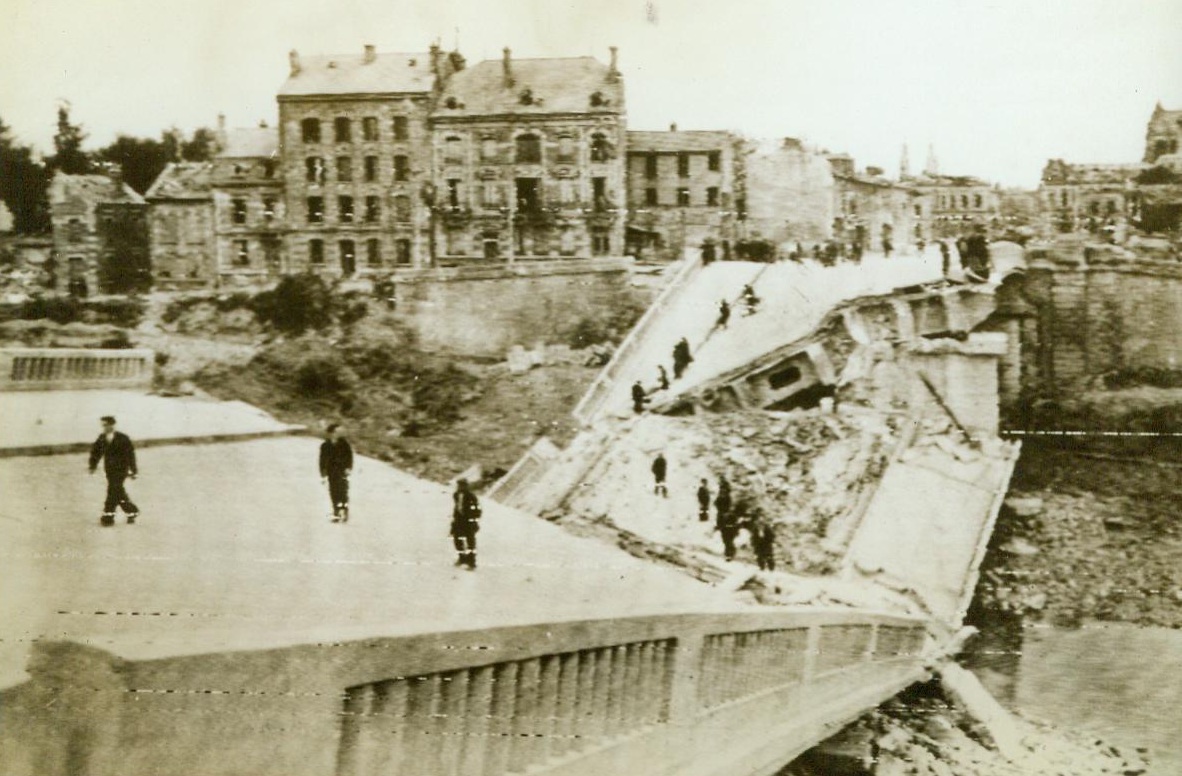
Perilous Crossing, 9/4/1944. Chalons, France—Retreating Germans blew up this bridge, spanning the Marne River at Chalons, but that didn’t stop the French. It’s a perilous crossing, but civilians manage to pick their way over the wreckage to get to the other side 9/4/44 (Army Radiotelephoto From ACME);
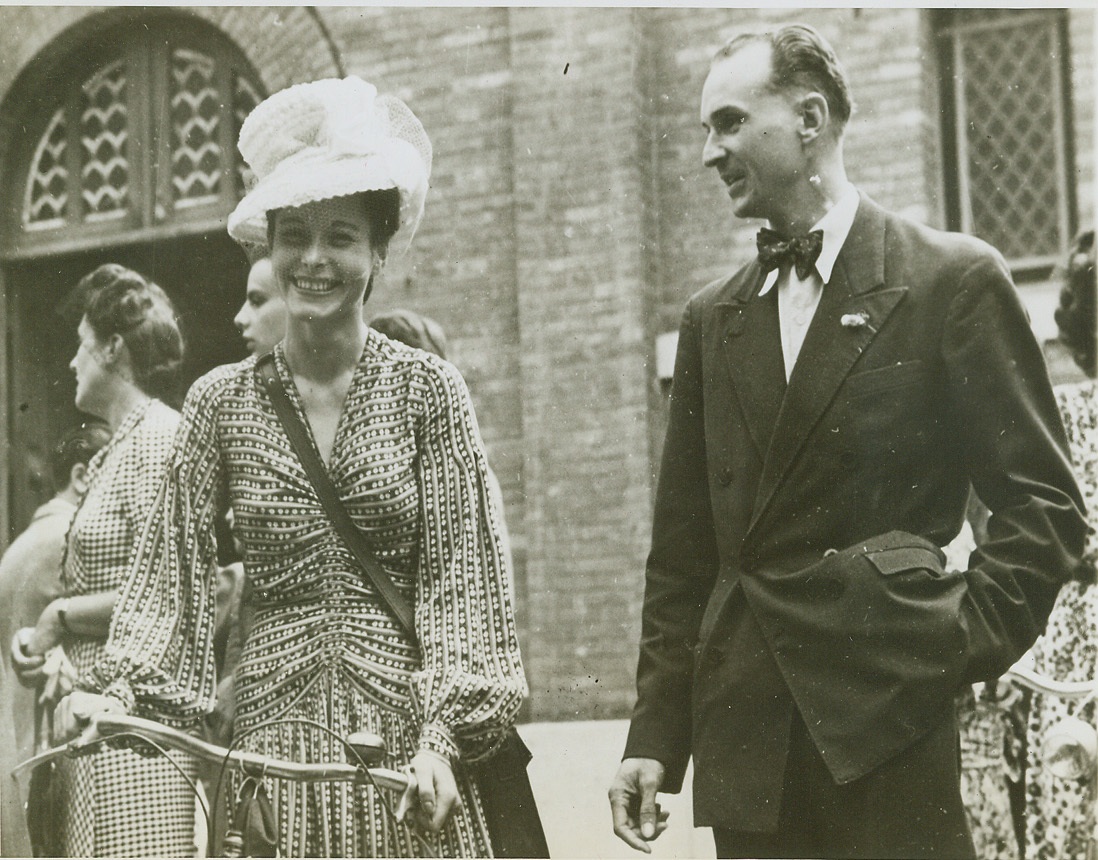
Fashionable Frou-Frou, 9/1/1944. Paris—This fashionable young Parisienne turned out in the full glory of a new chapeau to welcome the liberators to her city. The chic bit of feminine frou-frou, created on an adaptation of the English “beefeater” hat frame, it is made of rows and rows of datingy lace, decorated with a ribbon bow and veiling. One thing foretold the hardships which gay Paris has undergone—the young lady arrived via bicycle instead of car. Credit: Official US Army photo from ACME;
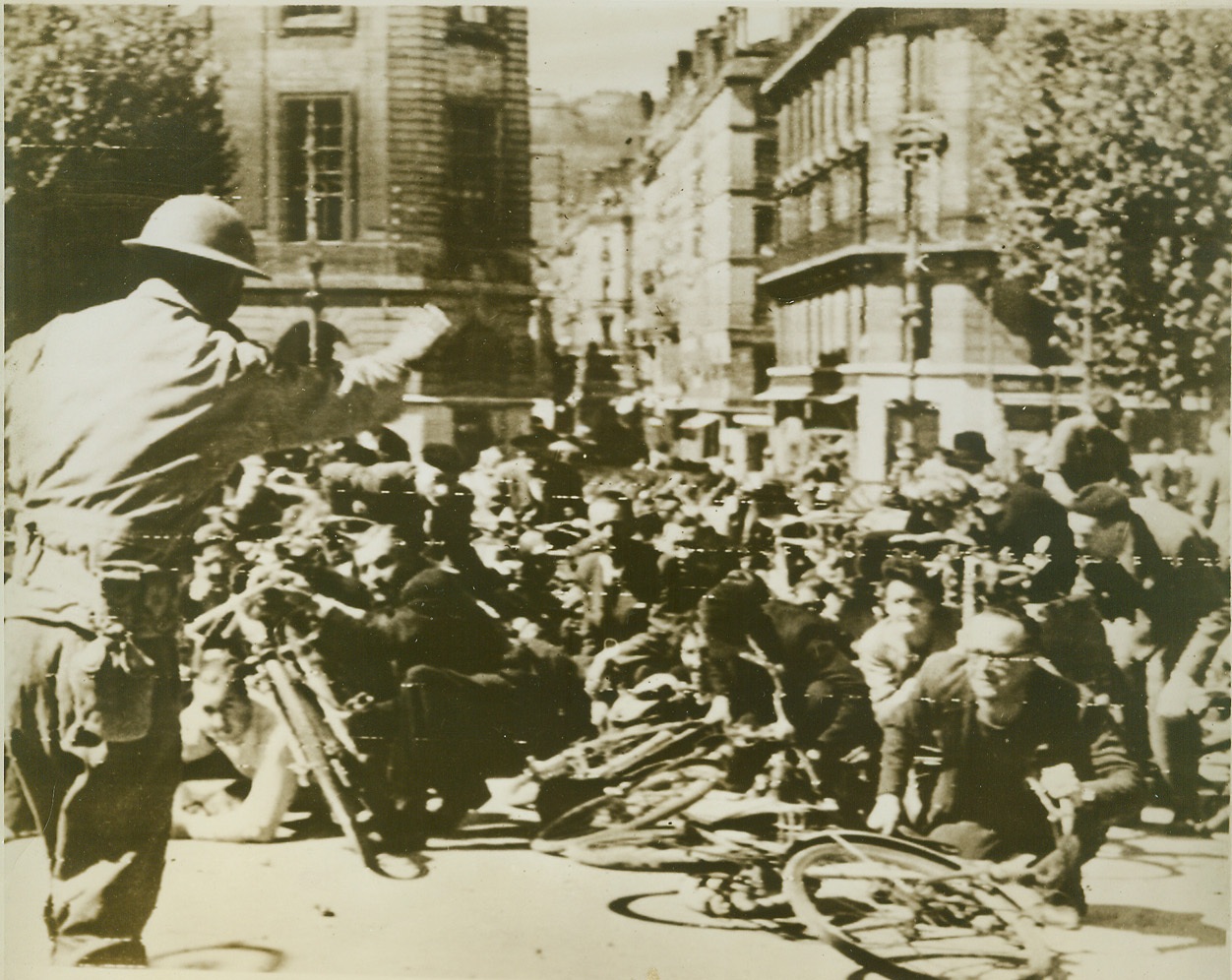
Crowds in Lyon Dodge Nazi Bullets, 9/6/1944. France—An Allied soldier urges panic-stricken crowd to hug the ground as 7th Army soldiers and members of the marquis battle armed Nazi sympathizers barricaded in the tower of the Lyon General Hospital after the city fell. This scene is on the bridge crossing the Rhome River. Credit: ACME photo via army radiotelephoto;
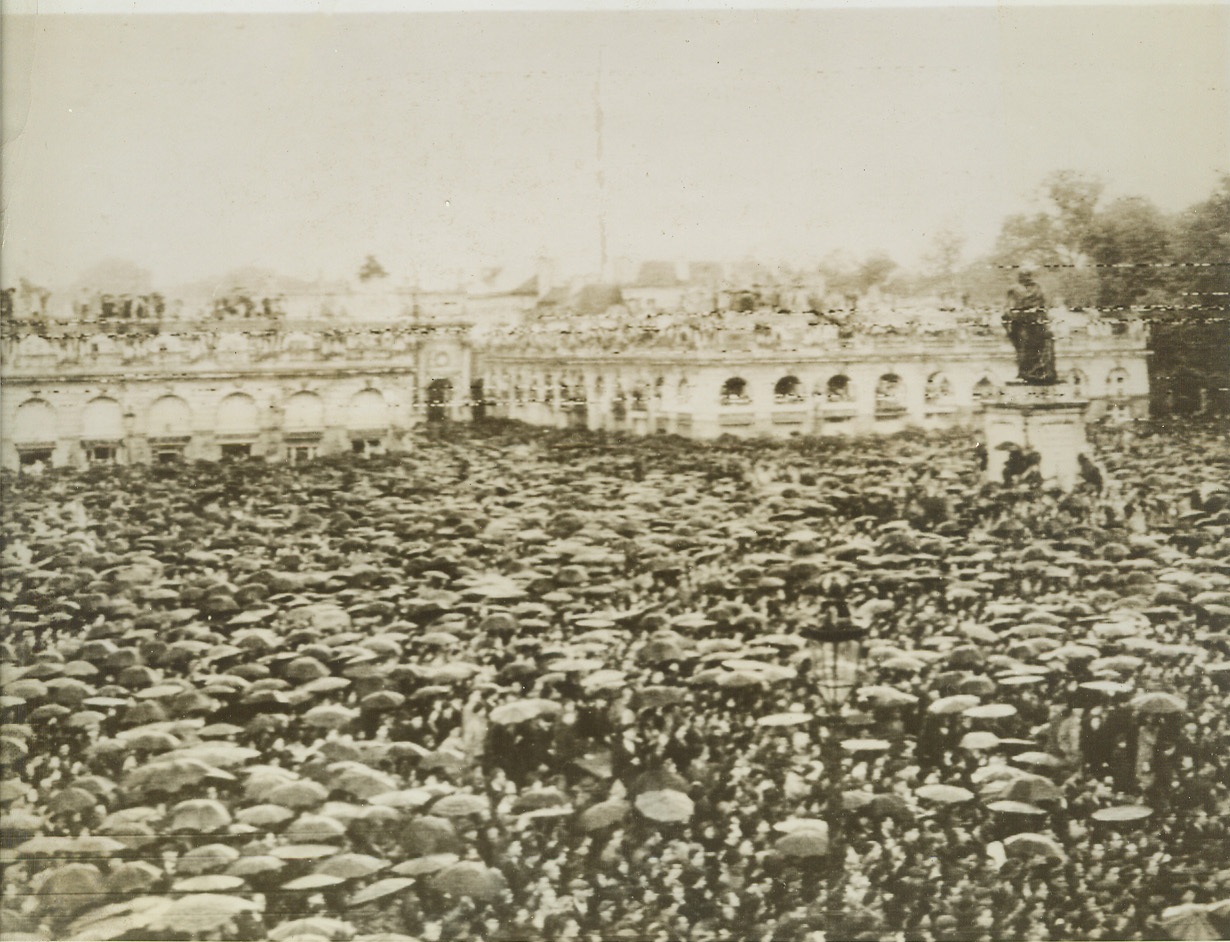
No Dampening Their Spirits, 9/29/1944. Nancy, France—This huge mass of umbrellas and heads is only a small part of the crowd that jammed the Place Stanislas in Nancy, awaiting the arrival of Gen. de Gaulle. The leader of the French forces of liberation addressed members of the French armed forces and civilians here. Credit: Signal Corps radiotelephoto from ACME;
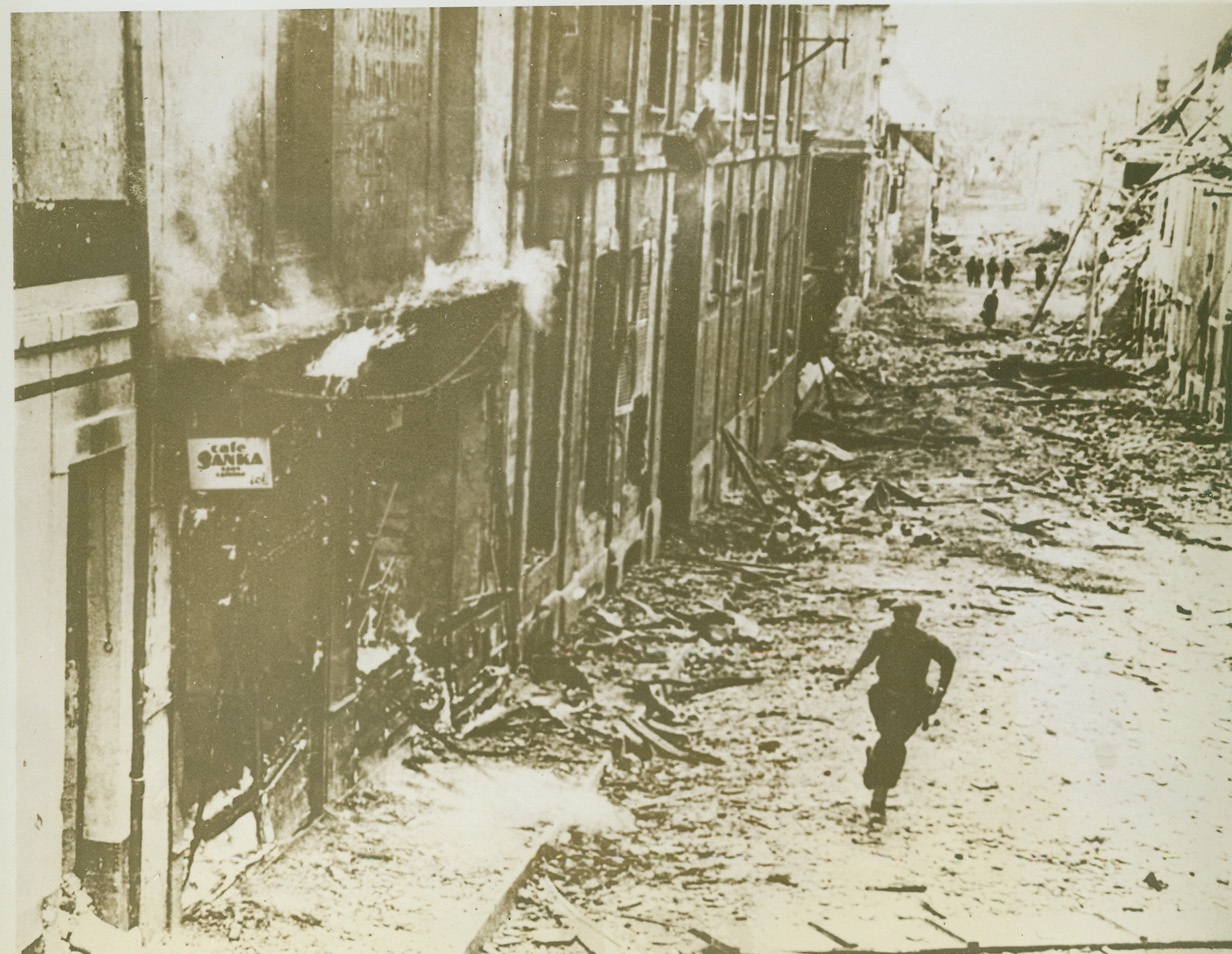
After Them On The Run, 9/17/1944. France—Disregarding possible enemy snipers, this member of a British patrol rages down the middle of the street in this French town in pursuit of the hastily retreating Germans. Debris-littered streets and shell-blasted buildings give mute evidence of the fierce battle which preceded the Allied entry into the town. Credit: ACME;
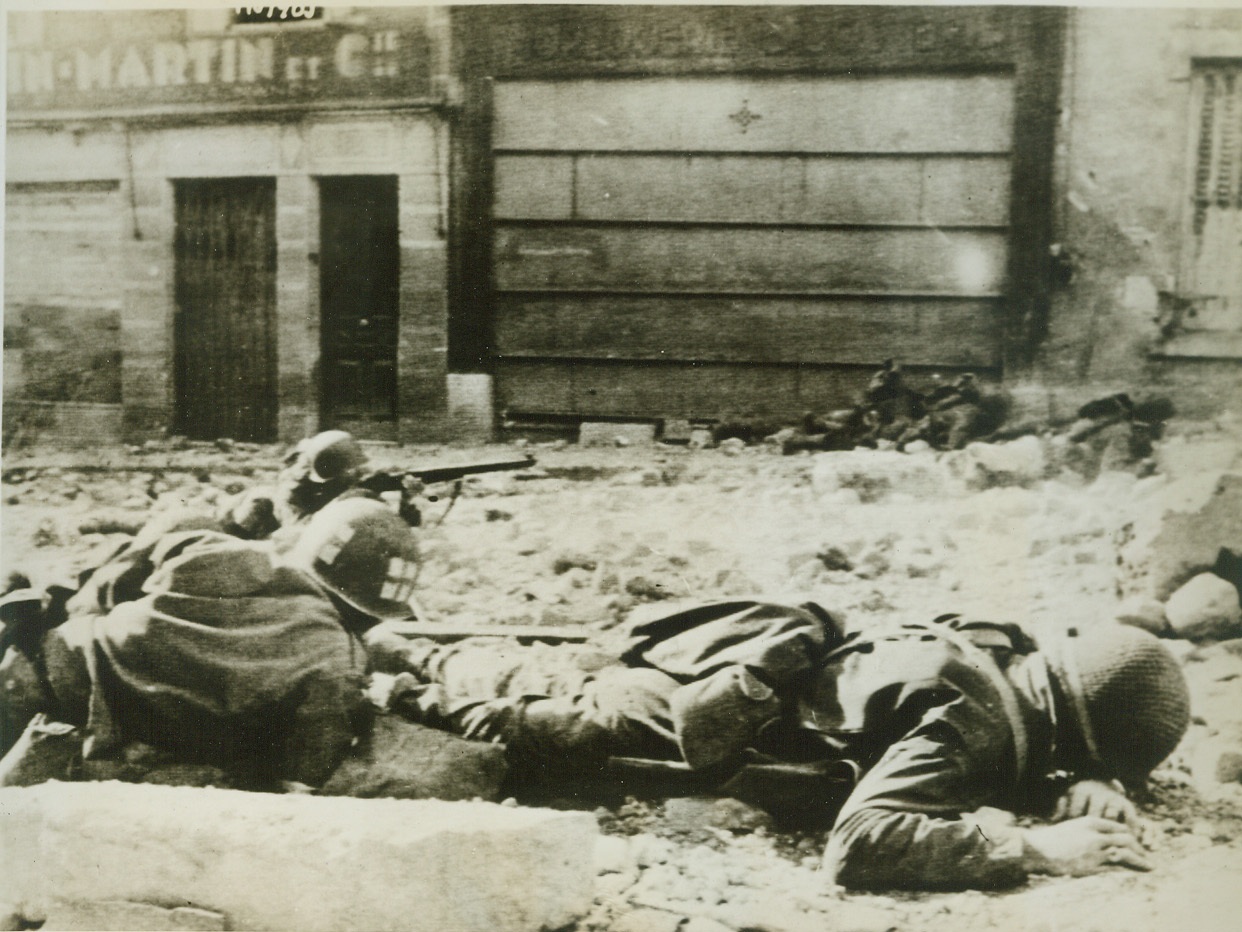
Rescue Under Fire, 9/20/1944. Madiers, France—While his buddy covers his movements, an American soldier (left) crawls into the line of fire to rescue his captain (right) who lies prone on the ground after being hit by a Nazi machine gun bullet during street fighting in Madiers, France. Bullets whizzed overhead but the Yank effected the rescue. Credit: Signal Corps radiotelephoto from ACME;
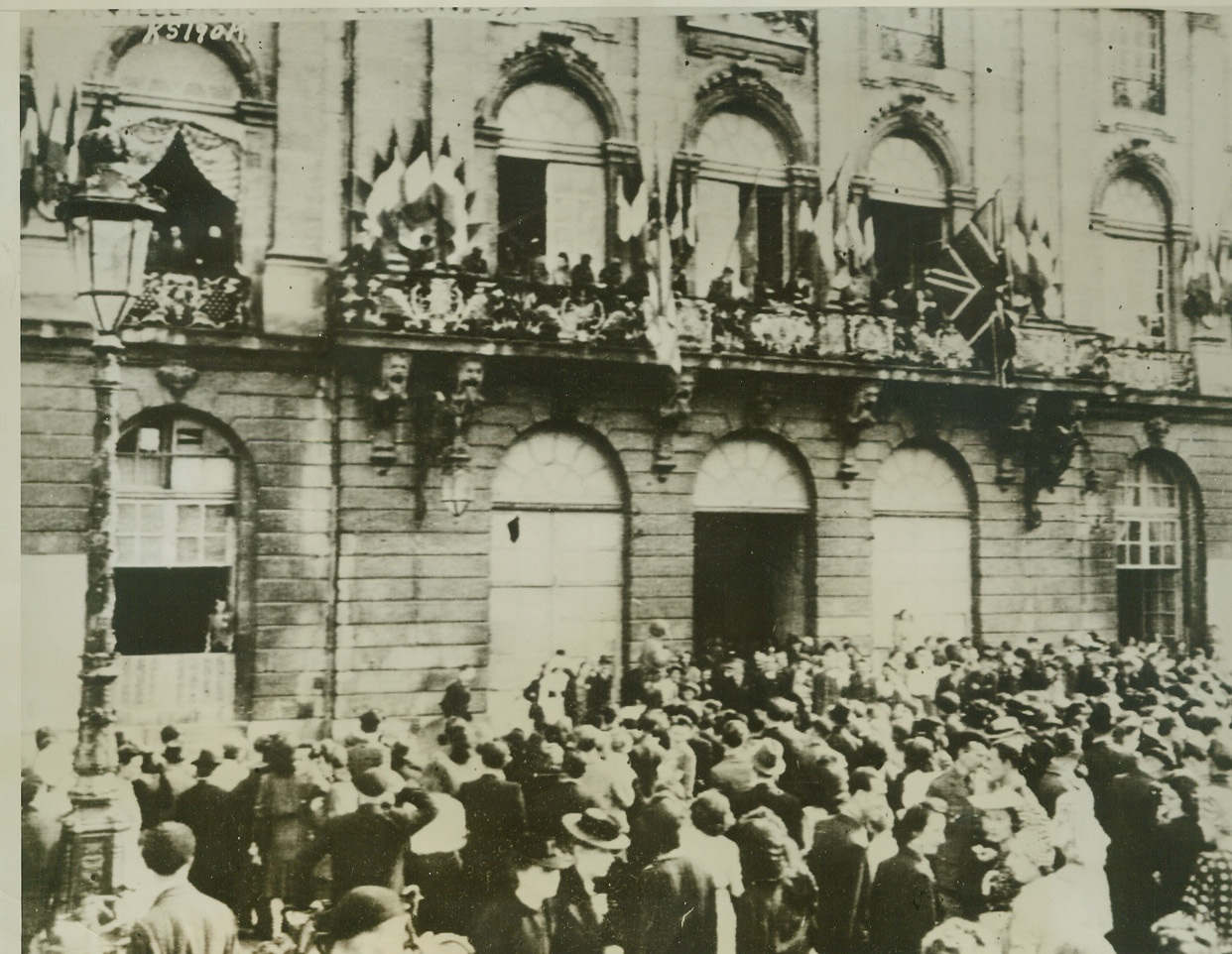
Nancy is Free!, 9/20/1944. Nancy, France—Allied flags wave aloft as citizens of Nancy crowd onto balconies and into the street in the public square to join in the celebration of Nancy’s liberation by the Allies. Credit: Signal Corps radiotelephoto from ACME;
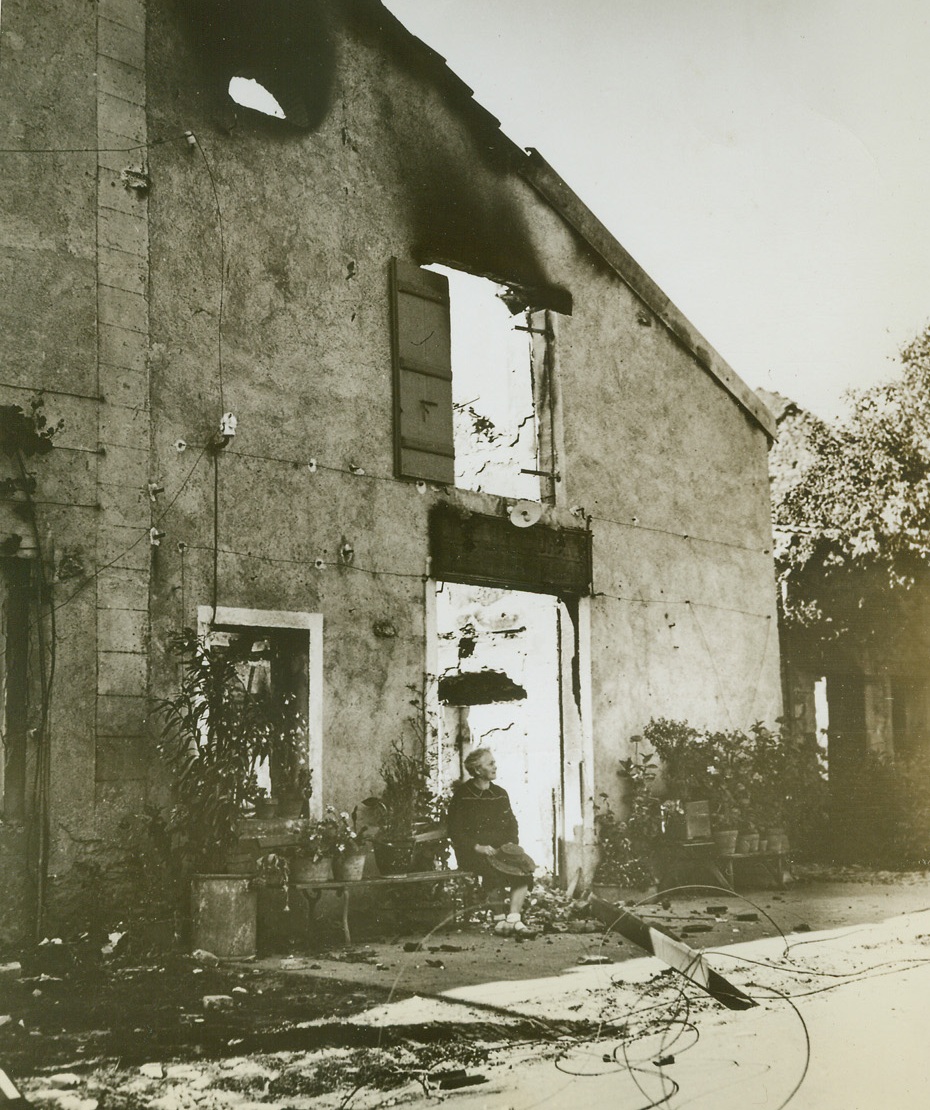
Burned Out But Unbeaten, 9/30/1944. Angirey, France – Quietly resting in the shade, an old woman of Angirey sits outside the remains of her ruined café. Retreating Germans burned out the entire town before the Allied Seventh Army entered. 9/30/44 (Signal Corps Photo From ACME);
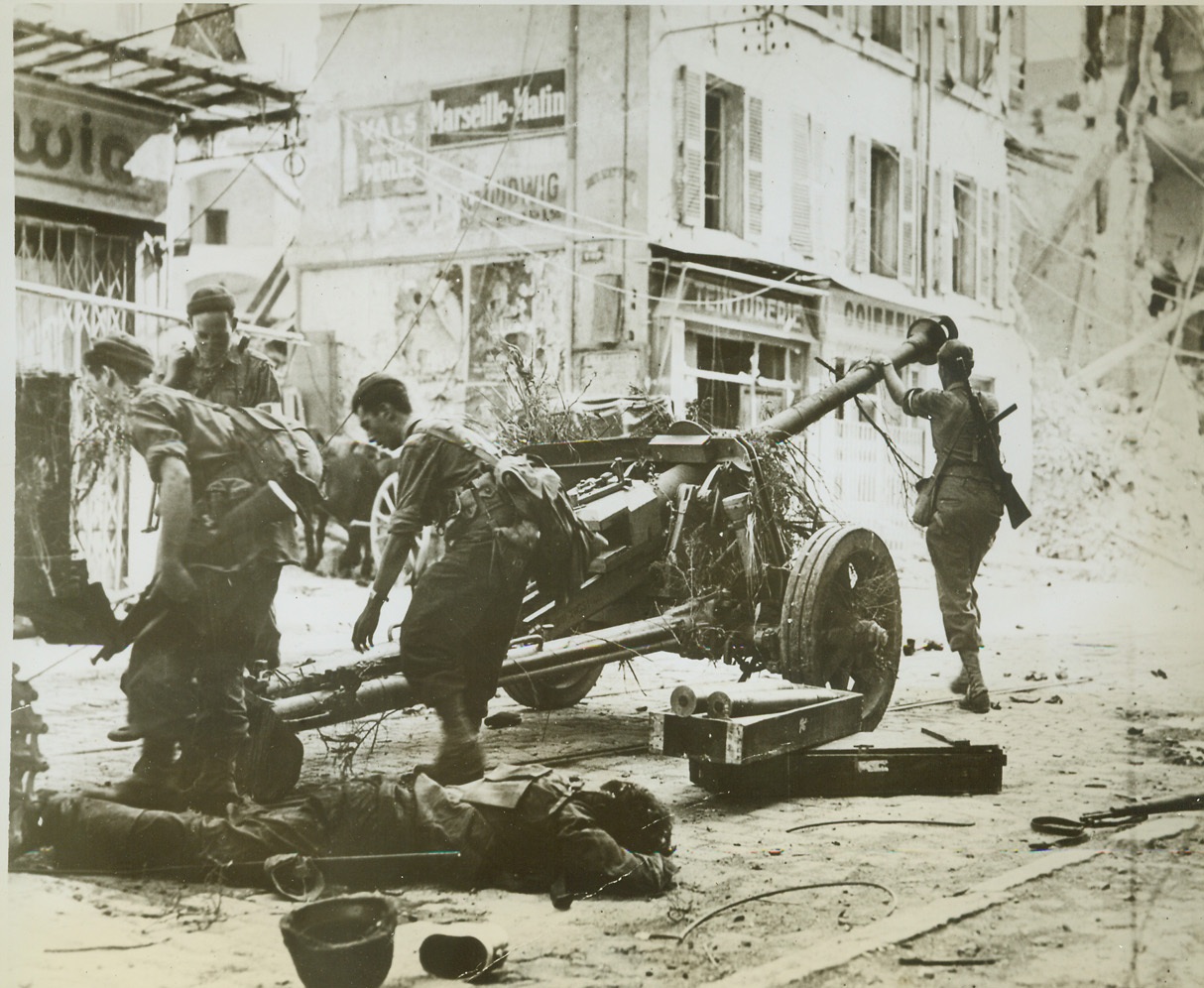
Nazi Gun Put to Use by Allies, 9/9/1944. France—A captured Nazi gun is wheeled about to face remnants of German forces which had been holding out against French troops in Toulon. In foreground is the body of a dead Nazi gunner. Credit: U.S. Navy photo from ACME;

Going Down With Paratroops, 9/27/1944. This photo, taken by a Signal Corps cameraman as he dropped to earth with First Allied Airborne Army troops in the invasion of Holland, shows how paratroopers look in the air. Credit: Army radiotelephoto from ACME;

Superfortress Armament Revealed, 9/10/1944. Seattle, Wash.—Touched out of previous photographs of the B-29 Superfortress, the plane’s gun turrets are now revealed. The numbers identify the five turrets-(1) and (2) are the front upper and lower turrets; (3) and (4), the rear upper and lower; and (5) is the tail turret, which is equipped with a 20 mm cannon as well as the two .50 caliber machine guns which are found in all the turrets. All armament is fired by remote control. Credit: ACME;
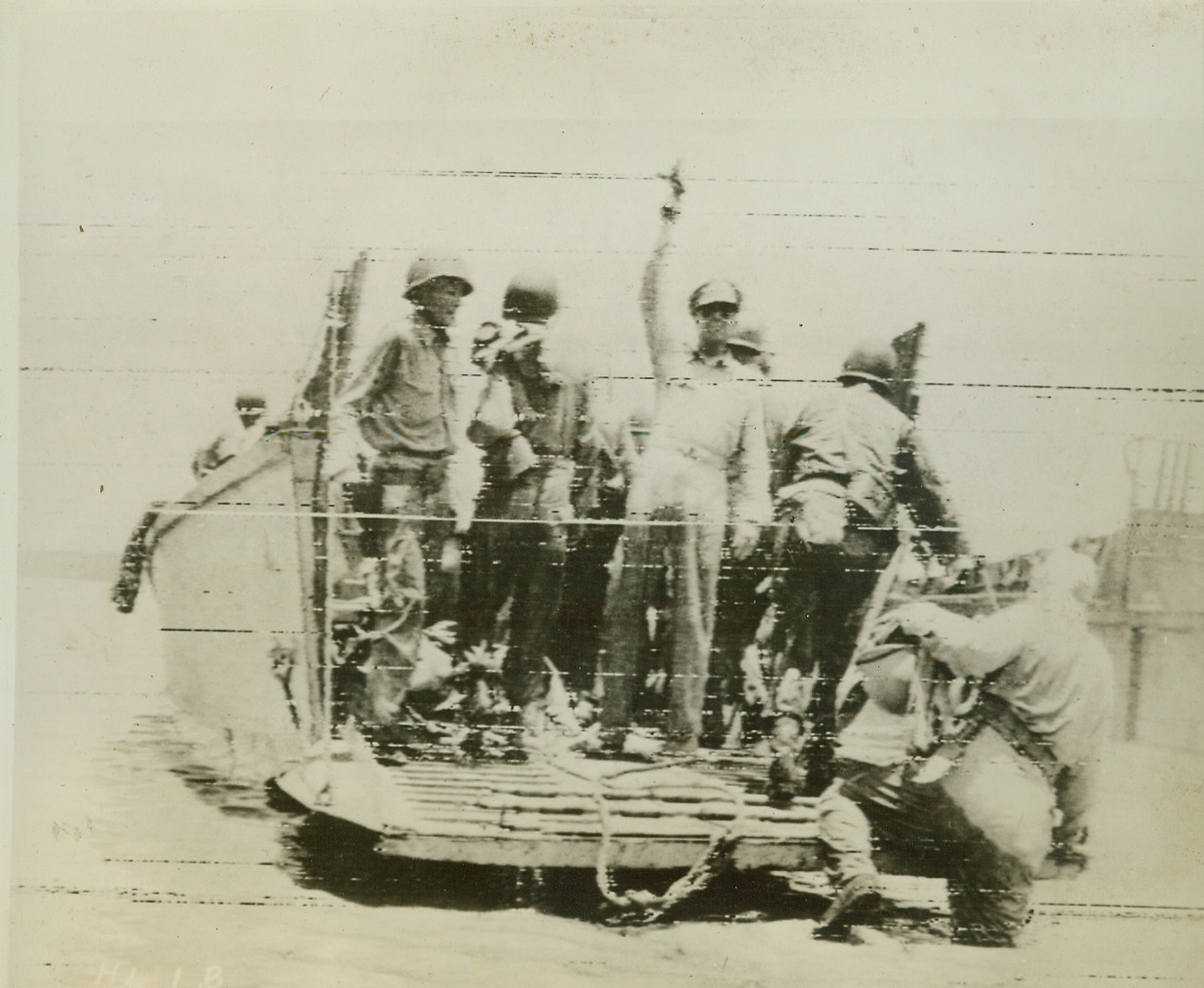
Four-Star Farewell, 9/17/1944. Moratoi Island—Waving his hand in farewell, General Douglas Macarthur leaves Moratoi Island after the successful Allied invasion of the Halmahera Group. A landing barge takes him away from the shore after his tour of the newly-established beachhead. Photo by ACME photographer Frank Prist, Jr. Credit: ACME photo via Signal Corps radiotelephoto.;
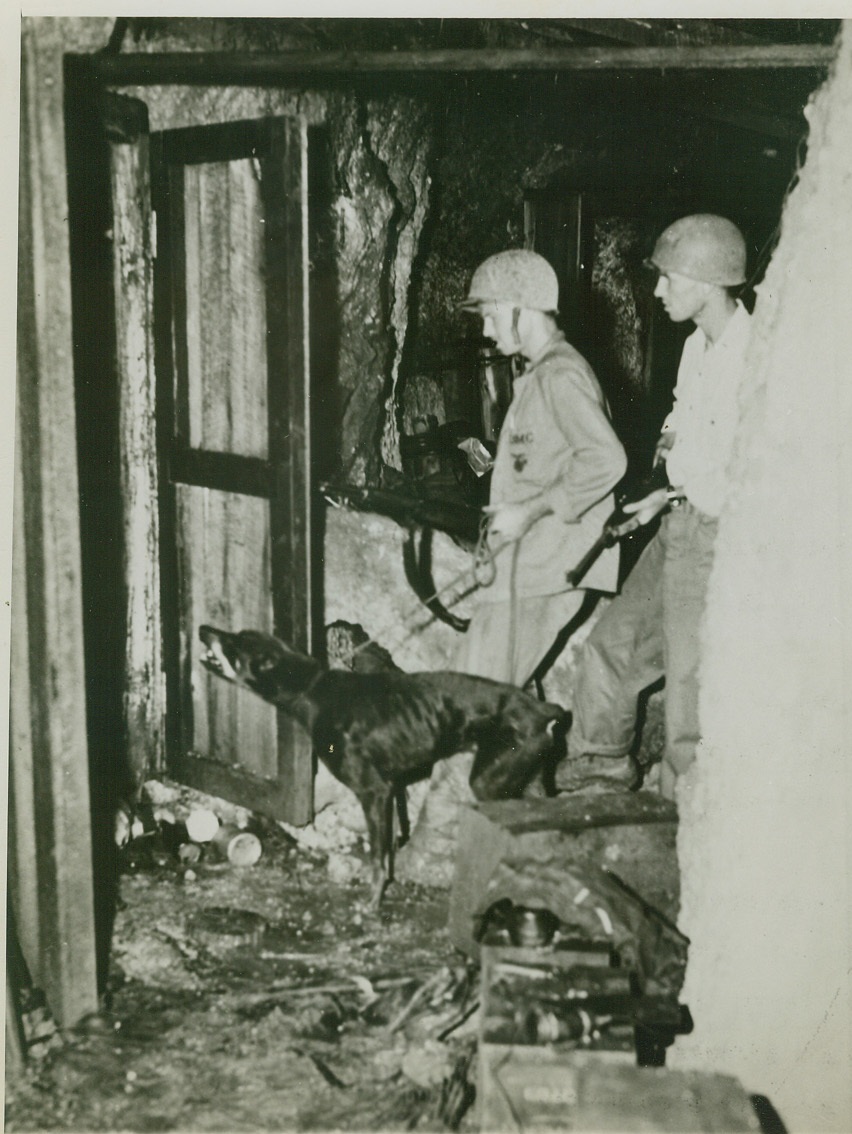
“Butch” Ferrets the Japs on Guam, 9/14/1944. Tumon Bay, Guam—(delayed)—“Butch,” a vicious leatherneck Doberman Pinscher belonging to Walter Dippling, Chicago, is specifically credited with bringing 10 Japs to their death and in aiding in the capture of many more. On Guam, accompanied by his handler Marine PFC Keith F. Schaible, Detroit, Mich., and Marine First Lt. William T. Taylor, (with rifle) Union, LA., commander of the war dog unit, “Butch” is seen going into the elaborately maintained Japanese command post cave on the outskirts of Agana. Some of these caves, connected by passageways, extended into the ground for 100 yards or more. Credit: Marine Corps photo from ACME.;
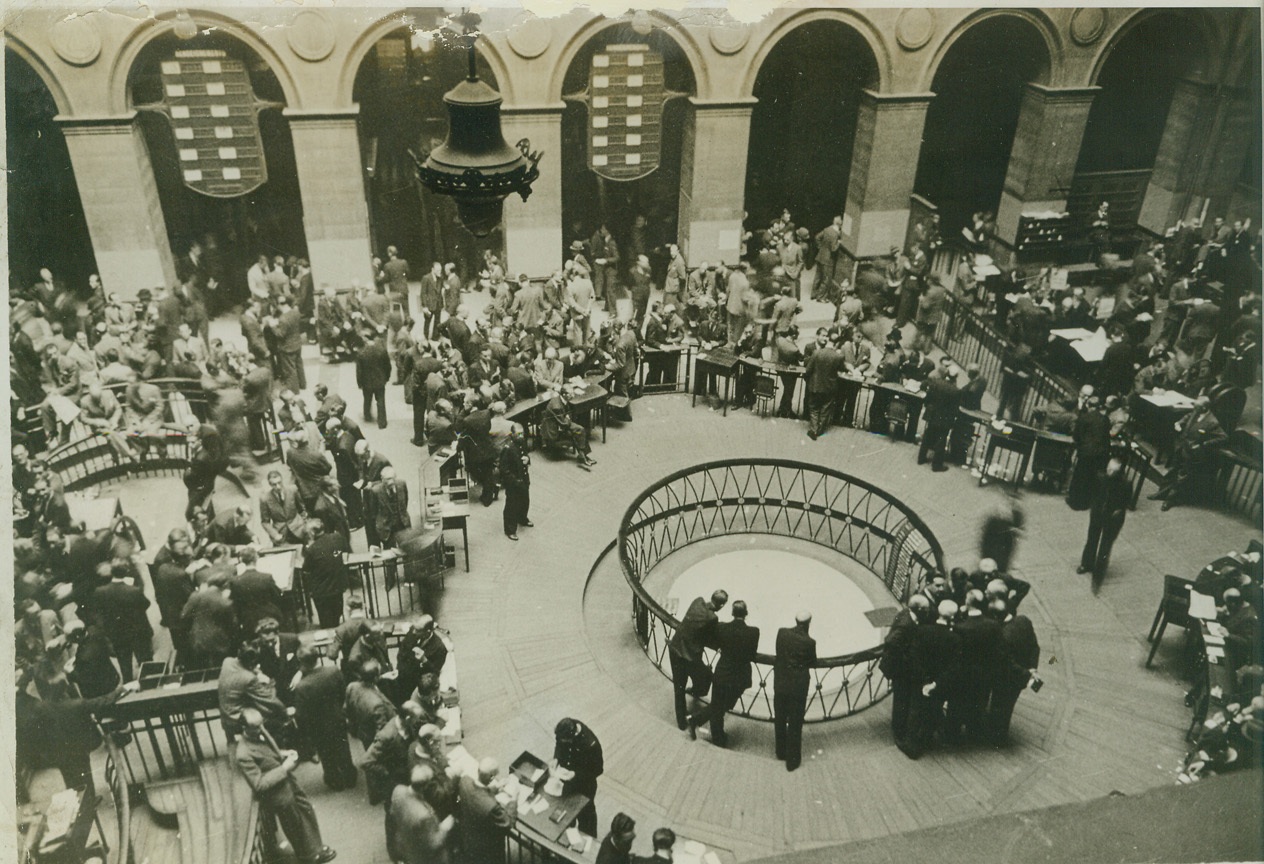
“BUSINESS AS USUAL” IN PARIS, 9/23/1944. PARIS – As soon as the first thrill of the coming of the Allied troops was over, liberated Paris undertook the job of re-organizing its business. This is the ring in the Bourse where all the business deals are made. The Bourse is the French equivalent to our Stock Market. Credit: OWI Radiophoto from ACME;





 Trash & Recycling
Trash & Recycling
 Online Payments
Online Payments
 City Documents
City Documents
 Parks
Parks
 Traffic Court
Traffic Court
 CITY PARKS
CITY PARKS
 Outdoor Recreation
Outdoor Recreation
 Volunteer
Volunteer
 Home
Home TRANSLATE
TRANSLATE
